National Laboratory Surveillance of Invasive Streptococcal Disease in Canada – Annual Summary 2014
Table of Contents

Figures and tables
- Figure 1. Incidence of IPD, 2000 – 2014
- Figure 2, Table 1. Annual incidence of IPD cases in Canada, by age group, 2009 – 2014
- Table 2. Number of invasive S. pneumoniae isolates from each province, 2014
- Figure 3a,b Clinical isolation sites of S. pneumoniae, 2014
- Figures 4 - 7. Distribution of invasive S. pneumoniae by clinical source, 2014
- Figure 8. Regional distribution of invasive S. pneumoniae serotypes, 2014
- Figure 9a,b. Age group distribution of invasive S. pneumoniae serotypes, 2014
- Figures 10 – 16. Invasive S. pneumoniae serotypes by age group, 2010 - 2014
- Table 3. Pneumococcal vaccine serotypes, 2014
- Figure 17, Table 4. PCV7 serotypes by age group, 2010 – 2014
- Figure 18, Table 5. PCV13 serotypes by age group, 2010 – 2014
- Figure 19, Table 6. PPV23 serotypes by age group, 2010 – 2014
- Figure 20, Table 7. Non-vaccine serotypes by age group, 2010 – 2014
- Figure 21. Antimicrobial resistance of S. pneumoniae isolates, 2011 – 2014
- Table 8. Antimicrobial resistant S. pneumoniae isolates, 2011 – 2014
- Table 9. Antimicrobial resistance of S. pneumoniae serotypes, 2014
- Figures 22 – 29. Resistance of S. pneumoniae serotypes by antibiotic, 2011 – 2014
- Figure 30. Multi-drug resistance of S. pneumoniae serotypes, 2014
- Figure 31. Multi-drug resistance of S. pneumoniae, 2011 – 2014
- Table 10. Antimicrobial resistance profiles of S. pneumoniae serotypes, 2014
- Figure 32. Annual incidence of invasive S. pyogenes cases in Canada, by age group, 2009 – 2014
- Table 11. Annual incidence rates of invasive S. pyogenes cases per 100,000 in Canada, 2009 – 2014
- Table 12. Number of invasive S. pyogenes isolates from each province, 2014
- Figure 33a,b. Clinical isolation sites of S. pyogenes from children and from adults
- Figures 34a,b,c. Invasive S. pyogenes emm types from clinical isolation sources, 2014
- Figure 35. Regional distribution of S. pyogenes emm types, 2014
- Figure 36. Invasive S. pyogenes emm types in all combined age groups, 2010 - 2014
- Figures 37a,b. Invasive S. pyogenes emm types in children and adults, 2010 – 2014
- Figure 38, Table 13. Antimicrobial resistance of invasive S. pyogenes (GAS), 2010 - 2014
- Figure 39. Macrolide resistance of S. pyogenes emm types, 2014
- Table 14. Invasive S. agalactiae serotypes by age group, 2014
- Figure 40, Table 15. Invasive S. agalactiae serotypes, 2010 – 2014
- Figure 41, Table 16. Invasive S. agalactiae serotypes by clinical isolation site, 2014
- Figure 42, Table 17. Antimicrobial resistance of invasive S. agalactiae, 2010 – 2014
- Figure 43. Macrolide resistance of S. agalactiae serotypes, 2014
Appendix
Authorship
Streptococcus and STI Unit
Bacteriology and Enteric Diseases Program
National Microbiology Laboratory
Public Health Agency of Canada
Walter H.B. Demczuk, Averil Griffith, Ravinder Singh, Karla Montes, Pam Sawatzky, Irene Martin (Unit Head), Dr. Michael Mulvey (Chief, Antimicrobial Resistance and Nosocomial Infections)
Other Contributors:
Vaccine Preventable Diseases Section
Surveillance and Outbreak Response Division
Centre for Immunization and Respiratory Infectious Diseases (CIRID)
Public Health Agency of Canada
Dr. Anita Li, Susan Squires
Laboratoire de santé publique du Québec (LSPQ)
Dr. Brigitte Lefebvre, Dr. Marc-Christian Domingo, Dr. Jean Longtin
Toronto Invasive Bacterial Diseases Network (TIBDN)
Department of Microbiology, Mount Sinai Hospital
Dr. Allison McGeer, Agron Plevneshi, Sylvia Pong-Porter, Karen Green, Kenny Wong and site investigators and staff
The Alberta Provincial Laboratory for Public Health (ProvLab Alberta)
Dr. Gregory J. Tyrrell, Dr. Graham Tipples
Department of Medical Microbiology and Infectious Diseases, Faculty of Medicine, University of Manitoba
Dr. Heather Adam, Melanie Baxter, Kim Nichol, Barbara Weshnoweski, Ravi Vashisht, Dr. George Zhanel
This report has been reviewed by Canadian Public Health Laboratory Network (CPHLN) Provincial and Territorial laboratory Directors.
Acknowledgements
The results presented in this report represent streptococcal isolates kindly submitted to the NML from the following hospitals or provincial public health laboratories: British Columbia Centre for Disease Control, Vancouver, British Columbia – Dr. Mel Krajden, Dr. Linda Hoang, Ana Paccagnella, Loretta Janz, Robert Azana et Vincent Tang; Saskatchewan Disease Control Laboratory, Regina, Saskatchewan - Dr. Greg Horsman, Rosanne Kitzul; Cadham Provincial Laboratory, Winnipeg, Manitoba - Dr. Jared Bullard, Dr. Paul Van Caeseele, Denise Sitter; Public Health Ontario, Toronto, Ontario – Dr. Frances Jamieson, Dr. Jonathan Gubbay, Deirdre Soares, Dr. Julianne Kus; Queen Elizabeth II Health Science Centre, Halifax, Nova Scotia - Dr. David Haldane; New Brunswick Regional Hospitals - Dr. Alexander Doroshenko, Maryse Thibeault, Eric Brisson, Francine Plourde, Dr. L. Thibault, Dr. Lewis Abbott, Melanie Stace, Peter Delaney, Linda Turgeon, Tammy Mahaney; Queen Elizabeth Hospital, Charlottetown, Prince Edward Island – Dr. G. German; Newfoundland Public Health Laboratory, St. John's, Newfoundland - Dr. S. Ratnam; Stanton Territorial Hospital Laboratory, Yellowknife, Northwest Territories - Cheryl Case; Whitehorse General Hospital, Whitehorse, Yukon - Rosalyn Robertson, Becky Nash, Chris Cash.
Executive Summary
- Streptococcus pneumoniae: 2,473 isolates causing invasive pneumococcal disease (IPD) were characterized in 2014
- The crude incidence rate for IPD cases meeting the national case definition has remained relatively stable between 2009-2014, averaging 9.6 cases per 100,000 population per year (range 8.9-9.8). The incidence of IPD has declined in children under 5 years of age; however rates in the older age groups have remained relatively unchanged.
- In 2014, the highest incidence rates were observed in adults aged 60 years and older (21.5 cases per 100 000 population); infants aged less than 1 year of age (16.9 cases per 100 000 population); and, children aged 1 to 4 years (11.0 cases per 100,000 population).
- PCV7 serotypes have declined from 9.5% to 4.9% of all IPD isolates from 2010 to 2014 (p<0.001).
- PCV13 serotypes have declined in all ages, with an overall decline from 45.6% in 2010 to 26.0% in 2014 (p<0.001).
- PPV23 serotypes have increased in all age groups, with an overall increase from 24.7% to 38.0% between 2010 and 2014 (p<0.001).
- Serotype 22F was the most prevalent serotype in 2014, declining slightly from 12.1% to 11.4% between 2013 and 2014 in all combined age groups (p=0.443).
- Serotype 19A has continued to decline from 11.6% in 2013 to 8.9% in 2014 (p=0.001). Reductions from 2013 levels have been observed in all age groups except in the 2-4 year olds where an increase from 17.6% to 25.0% (p=0.253).
- Serotype 7F has similarly decreased from 8.8% in 2013 to 7.5% in 2014 (p=0.088), and only 1 isolate was reported in each of the <2, and 2-4 year old age groups during 2014.
- Serotype 3 has remained relatively unchanged overall at 8.9% of isolates from all ages combined. Decreases were seen in <2 year olds from 8.6% to 2.3% since 2013 (p=0.353), and in the 5-14 year old age group from 5.2% to 2.9% from 2013 to 2014 (p=0.788).
- Antimicrobial susceptibility: Testing of 1,125 isolates indicated levels of resistance were relatively stable or declining in 2014 with the following resistance rates: clarithromycin (22.1%), penicillin (8.6%), doxycycline (7.9%), clindamycin (4.4%), trimethoprim/sulfamethoxazole (5.8%), meropenem (1.5%), and imipenem (1.2%). Multi-drug resistance to 3 or more classes of antimicrobials was observed in 4.9% of the isolates tested in 2014, down from 7.5% in 2013. The highest rates of multi-drug resistance were seen in serotypes 15A (53.8%) and 19A (17.6%).
- S. pyogenes (Group A Streptococcus): of the 1,457 invasive tested during 2014, emm1 continues to be most predominant accounting for 27.5% of isolates from all age groups combined, and emm89 was the next most prevalent with 9.7% of all isolates.
- Antimicrobial susceptibility: erythromycin resistance (6.9%), clindamycin resistance (2.8%), two chloramphenicol non-susceptible isolates.
- S. agalactiae (Group B Streptococcus): 249 invasive were submitted to NML during 2014, with serotypes V (23.3%), III (21.1%) and IV (17.5%) being most predominant;
- Antimicrobial susceptibility: erythromycin and clindamycin resistance (49.4% and 27.3%, respectively) were relatively unchanged in 2014 compared to 2013.
Introduction
As of April 1, 2010, the National Microbiology Laboratory (NML), Winnipeg began offering surveillance, reference diagnostics and outbreak support on invasive Streptococcus pneumoniae (pneumococcus), Streptococcus pyogenes (Group A Streptococcus), and Streptococcus agalactiae (Group B Streptococcus). The Streptococcus and STI Unit also participates in a number of international, national and regional surveillance programs.
This report is intended to present the current distribution of serotypes of S. pneumoniae, emm types of S. pyogenes, and serotypes of S. agalactiae isolated from sterile sites that are forwarded from Canadian provincial and territorial public health laboratories, regional health units and reference centres to the NML. To broaden the representativeness of the data presented, the aggregated counts also include data submitted by Laboratoire de santé publique du Québec (LSPQ), Toronto Invasive Bacterial Diseases Network (TIBDN), and the Alberta Provincial Laboratory for Public Health (ProvLab Alberta), organizations that perform their own serotyping.
Invasive pneumococcal disease (IPD, S. pneumoniae) IPD causes severe infections such as meningitis and bacteraemia [Marchessault, 2002; Schuchat, 1997] with children and the elderly being at greatest risk for infection [Robinson, 2001; Scott, 1996]. Of the 92 distinct pneumococcal serotypes currently recognized, the majority of disease worldwide is caused by only a few serotypes.
A 7-valent pneumococcal conjugate vaccine (PCV7), consisting of serotypes 4, 6B, 9V, 14, 18C, 19F, and 23F, was introduced in all provincial and territorial vaccination programs between 2002 and 2006 [Bettinger, 2010]. This led to a dramatic decrease in incidence of disease and in the constituent serotypes in children [Bettinger, 2010; Bjornson, 2007; Bruce, 2008; Demczuk, 2012; Deng, 2013; DeWals, 2012; Kellner, 2008; Kellner, 2009; Lim, 2013; Lovgren, 1998; McIntosh, 2011; NACI, 2010; Shahidi, 2008; Tyrrell, 2009; Weinberger, 2011;] (Figure 1). After the introduction of vaccination programs, paediatric IPD increased due to serotype replacement among pneumococcal infections with increases in non-PCV7 serotype infections, such as serotypes 7F and 19A [Kellner, 2009; Tyrrell, 2009]. In 2009, a 10-valent Pneumococcal, Haemophilus influenzae, and Diptheria vaccine (PHiD10); consisting of all the PCV7 serotypes plus serotypes 1, 5 and 7F; was used in Québec, Ontario and Newfoundland and Labrador. The 13-valent pneumococcal conjugate vaccine (PCV13); consisting of all PHiD10 serotypes plus serotypes 3, 6A and 19A; was recommended for use in Canada in 2010 [National Advisory Committee on Immunization (NACI), 2010] and introduced by all provinces and territories between mid-2010 and mid-2011. Immunization schedules vary by jurisdiction, however National Advisory Committee on Immunization (NACI) / Public Health Agency of Canada (PHAC) recommendations have been published [NACI , 2010; Public Health Agency of Canada (PHAC), 2013]. The 23-valent pneumococcal polysaccharide vaccine (PPV23) is available for adults; however it is not effective in children due to a poor T-cell-independent antibody response in immature immune systems [Merck & Co. Inc.]. Surveillance of the distribution of S. pneumoniae serotypes is important to inform vaccine composition and monitor for possible serotype replacement [Demczuk, 2010; Demczuk, 2013].
Figure 1. Annual incidence of IPD in Canada, 2000-2014
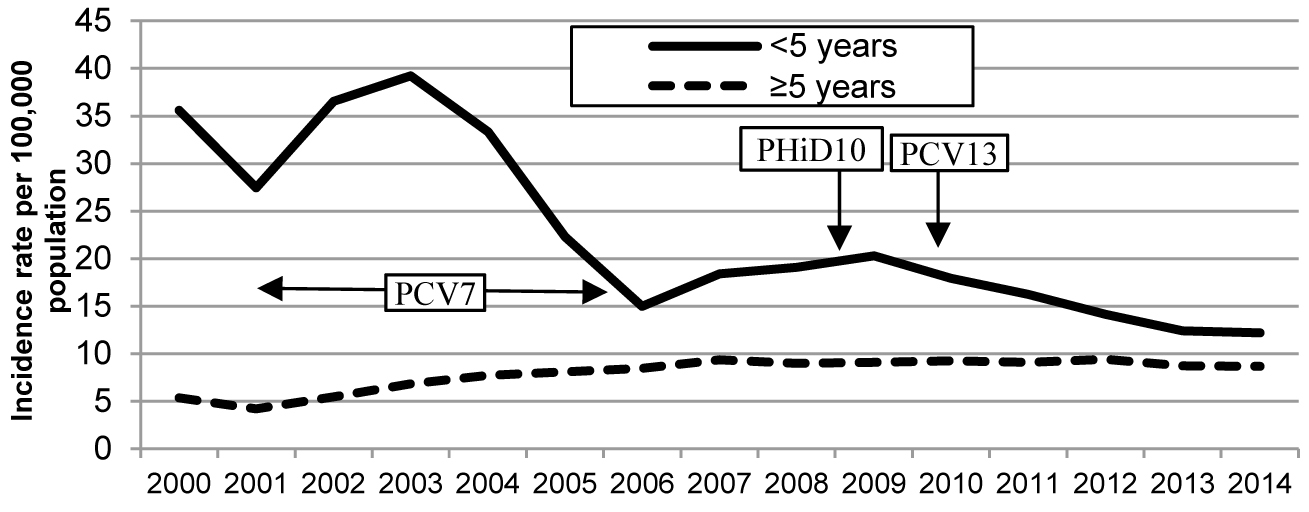
Text Equivalent
| Year | Number of Cases per 100,000 | |
|---|---|---|
| <5 years | ≥5 years | |
| 2000 | 35.59 | 5.36 |
| 2001 | 27.47 | 4.25 |
| 2002 | 36.54 | 5.46 |
| 2003 | 39.22 | 6.85 |
| 2004 | 33.33 | 7.74 |
| 2005 | 22.28 | 8.11 |
| 2006 | 14.99 | 8.48 |
| 2007 | 18.41 | 9.36 |
| 2008 | 19.10 | 9.03 |
| 2009 | 20.33 | 9.14 |
| 2010 | 17.95 | 9.28 |
| 2011 | 16.27 | 9.11 |
| 2012 | 14.15 | 9.44 |
| 2013 | 12.44 | 8.76 |
| 2014 | 12.20 | 8.70 |
Invasive Group A Streptococcus (GAS, S. pyogenes) is responsible for a wide range of disease including bacteraemia, toxic shock syndrome and skin and soft tissue infections of which necrotizing fasciitis is most notorious [Cunningham, 2000]. Surveillance of strains is important to monitor increasing virulence patterns associated with this organism [Schwartz, 1990; Siljander, 2010]. The M protein, encoded by the emm gene, is an important virulence factor and an epidemiological marker used to characterize S. pyogenes isolates.
Group B Streptococcus (GBS, S. agalactiae) GBS is commonly associated with neo-natal disease where the highest infection risk is during childbirth, and often treated prophylactically with antibiotics. Group B Streptococcal disease of the newborn is nationally notifiable, however isolates submitted to NML include those that meet the case definition as well as sterile site isolates from all age groups since GBS is an increasing health concern among adults causing septicemia, meningitis, pneumonia, bone, joint and tissue infections. At risk adults groups include those with underlying medical conditions, pregnant women and those residing in extended health care facilities [Lamangni, 2013].
Methods
A total of 2,473 invasive S. pneumoniae, 1,457 invasive S. pyogenes and 249 S. agalactiae isolates are included in this report for 2014. Data for 2014 include test results for isolates submitted to the NML by provincial and territorial public health laboratories and data provided by jurisdictions including 397 IPD isolates serotyped by Laboratoire de santé publique du Québec, 320 IPD by the Alberta Provincial Laboratory for Public Health and 371 IPD by the Toronto Invasive Bacterial Diseases Network.
Data submitted with bacterial isolates included patient age, gender, clinical source and date of collection. Multiple isolates with the same serotype and collected from the same patient within 14 days were only counted once with the most invasive isolation site assigned. Meningitis related isolates were regarded as most invasive, followed by blood and then other sterile sites. The data were aggregated by age (<2 year, 2-14 year, 15-49 year, 50-64 year and ≥65 year age groups) and regionally into Western (British Columbia, Alberta, Saskatchewan, Manitoba, Yukon Territories, Northwest Territories and Nunavut); Central (Ontario and Québec) and Eastern (New Brunswick, Nova Scotia, Prince Edward Island, Newfoundland and Labrador) regions of Canada. Caution should be exercised when interpreting the data presented in this report as the overall interpretation of the results is difficult due to the limitations related to the isolates available for testing. Only a subset of laboratory isolates within each province may be submitted for testing and therefore this report does not reflect true incidence or rates of disease in Canada. Submission of isolates to the NML is voluntary and not standardized across the country. Accordingly, aggregated national and regional summaries are presented in this report.
Validated surveillance data for 2009 to 2014 were obtained through the Canadian Notifiable Disease Surveillance System (CNDSS) [PHAC, 2014]. Population data were obtained from Statistics Canada July 1st annual population estimates, 2009 to 2014. The population of provinces and territories for whom case data were not available were excluded from the denominator. CNDSS epidemiologic data and NML laboratory data were not linked. Because not all provinces and territories report line list data to CNDSS, only aggregated data are available at the national level. Therefore, CNDSS data and NML laboratory data were presented differently in terms of age grouping. The age grouping for NML data is consistent with that in NACI statements.
All IPD isolates were screened by bile solubility and optochin (Oxoid) analyses and GAS/GBS isolates were confirmed using PYR (Pyrrolidonyl-α-naphthylamide) reaction and susceptibility to bacitracin (Oxoid) and trimethoprim/sulfamethoxazole susceptibility discs (BBL; 1.25/23.75 µg/ml) [Spellerberg, 2007]. Sterile clinical isolation sites include blood, cerebrospinal fluid or other nervous tissue (CSF), peritoneal fluid, pericardial fluid, joint fluid, internal body sites and muscle including surgical or biopsy samples and aspirates. Although pleural fluid (empyema) does not currently meet the national case definition for invasive disease, these isolates are included in this report as they are widely considered as invasive in other jurisdictions. Additionally for S. pyogenes, any isolation site was tested if a case of toxic shock syndrome or necrotizing fasciitis was associated with the infection [Canadian Communicable Disease Report, 2009; Minnesota Department of Health].
National case definitions for IPD, GAS and GBS can be found at the following:
- IPD: http://www.phac-aspc.gc.ca/publicat/ccdr-rmtc/09vol35/35s2/Pneumoco-eng.php
- GAS: http://www.phac-aspc.gc.ca/publicat/ccdr-rmtc/09vol35/35s2/Strep_A-eng.php
- GBS: http://www.phac-aspc.gc.ca/publicat/ccdr-rmtc/09vol35/35s2/Strep_B-eng.php
Serotyping of IPD at NML is performed by observing the Quellung reaction using pool, group, type and factor commercial antisera (SSI Diagnostica; Statens Serum Institute, Copenhagen, Denmark) [Austrian, 1976; Lovgren, 1998]. Isolates for which a Quellung reaction is not observed are confirmed by rpoB gene sequencing [Drancourt, 2004; Clinical Laboratory Standards Institute (CLSI), 2008] as well as PCR serotyping as outlined at: http://www.cdc.gov/streplab/pcr.html.
In 2011, the NML began a collaboration with the University of Manitoba – Health Sciences Centre - Canadian Antimicrobial Resistance Alliance (CARA) to provide antimicrobial susceptibility testing (AST) for S. pneumoniae isolates submitted to the NML called SAVE (S. pneumoniae Serotyping and Antimicrobial Susceptibility: Assessment for Vaccine Efficacy in Canada After the Introduction of PCV-13). All sterile-site isolates (2014, n=1,125) from any age group causing invasive pneumococcal disease submitted by 8 participating jurisdictions (Saskatchewan, Manitoba, Ontario, Quebec, Nova Scotia, Prince Edward Island, New Brunswick, Newfoundland and Labrador) are included in the study. A panel of 18 antimicrobials are tested, including: penicillin, amoxicillin/clavulanate, cefuroxime, ceftriaxone, clarithromycin, ertapenem, meropenem, clindamycin, vancomycin, ciprofloxacin, levofloxacin, moxifloxacin, linezolid, tigecycline, trimethoprim/sulfamethoxazole and doxycycline. MICs of these antimicrobials are determined by the CLSI broth microdilution method using 96-well custom designed microtitre plates [CLSI, 2015]. MIC interpretive standards were defined according to CLSI breakpoints (CLSI, 2015) for all antibiotics except ciprofloxacin for which EUCAST interpretative breakpoints were used [EUCAST, 2015].
The emm types were determined for all invasive Group A Streptococcus isolates submitted to the NML. Isolates were characterized using the emm sequencing CDC protocol available at: http://www.cdc.gov/streplab/M-ProteinGene-typing.html. The emm sequences obtained are compared with the CDC (Atlanta) data bank and results reported to the type level, not the subtype level (emm4.4is reported as emm4). Antimicrobial susceptibilities were determined (2014 GAS n=1,443; GBS n=249) by Kirby-Bauer Disc diffusion for chloramphenicol (CHL, 30 µg), erythromycin (ERY, 15 µg), clindamycin (CLI, 2 µg), penicillin (PEN, 10 µg) and vancomycin (VAN, 30, µg) according to CLSI guidelines [CLSI, 2015].
Serotypes of Group B Streptococcus were determined using commercial latex agglutinating antisera (SSI Diagnostica; Statens Serum Institute, Copenhagen, Denmark).
Poisson regression was used to estimate the incidence difference using SAS EG5.1. Other statistical analyses were performed using chi square or Fisher exact test using OpenEpi version 2.3.1. Differences of p<0.05 were considered statistically significant.
Results and Discussion
Streptococcus pneumoniae
Between 2009 and 2014, the overall incidence of IPD in Canada has decreased from 9.8 to 8.9 cases per 100,000 population (p<0.001). In 2014, the overall incidence rate of IPD was 8.9 cases per 100,000 population, with higher rates of disease still seen in infants <1 year of age (16.9 cases per 100,000 population), children 1-4 years of age (11.0 cases per 100,000 population) and in the 60+ age group (21.5 cases per 100,000 population) (Figure 2, Table 1). Over the study period, the significant decline of IPD incidence rates have been shown in the <1 year old age group (p<0.001), 1-4 year olds age group (p<0.001), 5-9 year olds age group, 30-39 year olds age group (p=0.005) and 60 and above age group (p=0.02) (Table 1).
Figure 2. Annual incidence of IPD cases in Canada, by age group, 2009 – 2014
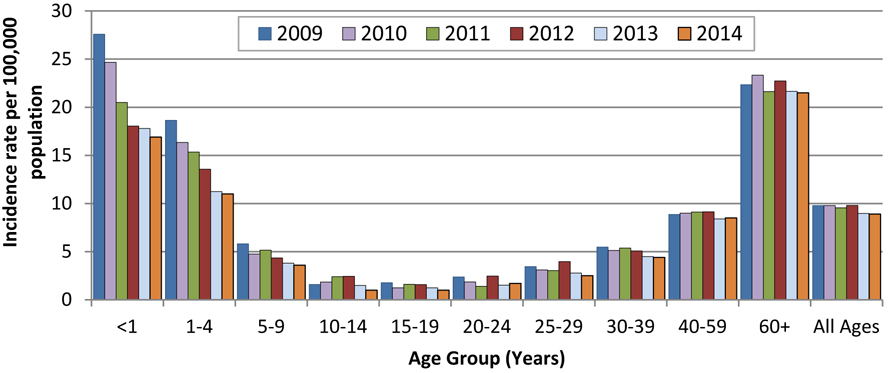
Text Equivalent
| Age Group | Incidence rate per 100,000 population by year | |||||
|---|---|---|---|---|---|---|
| 2009 | 2010 | 2011 | 2012 | 2013 | 2014 | |
| <1 | 27.6 | 24.7 | 20.5 | 18.1 | 17.8 | 16.9 |
| 1-4 | 18.7 | 16.4 | 15.3 | 13.6 | 11.2 | 11.0 |
| 5 to 9 | 5.8 | 4.8 | 5.2 | 4.4 | 3.8 | 3.6 |
| 10-14 | 1.6 | 1.8 | 2.4 | 2.4 | 1.5 | 1.0 |
| 15-19 | 1.8 | 1.3 | 1.6 | 1.6 | 1.2 | 1.0 |
| 20-24 | 2.4 | 1.9 | 1.4 | 2.5 | 1.5 | 1.7 |
| 25-29 | 3.5 | 3.1 | 3.0 | 4.0 | 2.8 | 2.5 |
| 30-39 | 5.5 | 5.1 | 5.4 | 5.1 | 4.5 | 4.4 |
| 40-59 | 8.9 | 9.0 | 9.1 | 9.1 | 8.4 | 8.5 |
| 60+ | 22.3 | 23.3 | 21.6 | 22.7 | 21.7 | 21.5 |
| All Ages | 9.8 | 9.8 | 9.6 | 9.8 | 9.0 | 8.9 |
| Year | Age Group (Years) | ||||||||||
|---|---|---|---|---|---|---|---|---|---|---|---|
| <1 | 1-4 | 5-9 | 10-14 | 15-19 | 20-24 | 25-29 | 30-39 | 40-59 | 60+ | All Ages | |
| 2009 | 27.6 | 18.7 | 5.8 | 1.6 | 1.8 | 2.4 | 3.5 | 5.5 | 8.9 | 22.3 | 9.8 |
| 2010 | 24.7 | 16.4 | 4.8 | 1.8 | 1.3 | 1.9 | 3.1 | 5.1 | 9 | 23.3 | 9.8 |
| 2011 | 20.5 | 15.3 | 5.2 | 2.4 | 1.6 | 1.4 | 3 | 5.4 | 9.1 | 21.6 | 9.6 |
| 2012 | 18.1 | 13.6 | 4.4 | 2.4 | 1.6 | 2.5 | 4 | 5.1 | 9.1 | 22.7 | 9.8 |
| 2013 | 17.8 | 11.2 | 3.8 | 1.5 | 1.2 | 1.5 | 2.8 | 4.5 | 8.4 | 21.7 | 9.0 |
| 2014 | 16.9 | 11.0 | 3.6 | 1.0 | 1.0 | 1.7 | 2.5 | 4.4 | 8.5 | 21.5 | 8.9 |
Population data were obtained from Statistics Canada July 1st annual population estimates, 2009 to 2014. The population of provinces and territories for whom case data were not available were excluded from the denominator.
Distribution of Streptococcus pneumoniae Serotypes
Of the 2473 IPD isolates serotyped in 2014, children <2 years of age accounted for 5.2% (n=128), children aged 2-4 years for 3.6% (n=88), children aged 5-14 years for 2.8% (n=69), adults aged 15-49 years for 20.5% (n=508), adults aged 50-64 years for 28.3% (n=700) and seniors aged ≥65 years for 39.1% (n=967) (Table 2). Of the 2,439 isolates with gender information specified, 55% (n=1345) were from male patients.
Blood was the most frequent clinical isolation site accounting for 92.3% (n=2,283) of all isolates (Figures 3a, 3b). Serotype 22F was prevalent in all sources (Figures 4-7) representing 11.5% (n=262) of all blood, 8.3% (n=6) of CSF, 14.3% (n=5) of pleural fluid and 16.7% (n=3) of synovial fluid isolates. Serotypes 23B, 11A and 12F represented a higher proportion of CSF isolates (11.1%, n=8; 9.7%, n=7; and 9.7%, n=7; respectively) compared to other clinical isolation sites (p<0.001). Similarly, serotype 3 was predominant in blood and pleural fluid (p<0.001) representing 8.9% (n=202) and 17.1% (n=6) of the isolates, respectively.
Regionally, serotypes 4 (4.5%, n=43), 12F (6.7%, n=64) and 20 (5.5%, n=53) were associated with Western regions (p<0.001); 15A (5.5%, n=75) with Central (p=0.04); and 9N (8.1%, n=13) and 6C (6.2%, n=10) with Eastern regions (p<0.001) (Figure 8).
The overall most predominant serotypes in 2014 were 22F (11.4%, n=282), 19A (8.9%, n=220), 3 (8.9%, n=220), 7F (7.5%, n=185) and 15A (4.5%, n=112), together representing 41.2% (n=1,019) of all IPD in Canada (Figure 10). After a steady increase since 2010 serotype 22F has declined slightly from 12.1% (n=312) to 11.4% (n=282, p=0.443) in 2014. Since 2010, serotypes 19A and 7F have declined by 57% and 52%, respectively, Serotype 19A decreased from 19.1% (n=517) in 2010 to 8.9% (n=220) in 2014 (p<0.001); and 7F decreased from 14.3% (n=388) to 7.5% (n=185) (p<0.001). From 2010 to 2014 overall prevalence of serotype 3 has remained relatively constant, increasing slightly from 8.3% (n=225) to 8.9% (n=220) (p=0.48) (Figures 9-16).
Serotype 22F: The largest increase in the relative proportion of 22F isolates between 2013 and 2014 was seen in the 5-14 year old age group increasing from 10.4% (n=8) to 14.5% (n=10) (p=0.62). Levels in other age groups have remained relatively constant at 12.5% (n=16) in the <2, 10.2% (n=9) in 2-4, 8.7% (n=44) in 15-49, 10.7% (n=75) in 50-64, and 13.2% (n=128) in ≥65 year old age groups.
Serotype 19A: Continued declines of 19A have been observed in all age groups, except in the 2-4 year olds where proportions have increased from 2013 to 2014 from 17.6% (n=13) to 25.0% (n=22) (p=0.25). Dramatic reductions over the 5 year period from 2010 to 2014 have been seen in <2 year olds from 40.0% (n=68) to 3.9% (n=5) (p<0.001); the 50-64 year olds from 17.2% (n=118) to 8.1% (n=57)(p<0.001); and in the ≥65 year olds from 17.8% (n=172) to 7.9% (n=76)(p<0.001). In the 5-14 year olds, after increasing from 2010 to 2013 from 12.7% (n=14) to 28.6% (n=22) (p=0.007), levels have declined in 2014 to 11.6% (n=8) (p=0.01). More modest declines were seen from 2010 to 2014 in the 15-49 year olds from 12.2% (n=71) to 9.6% (n=49) (p=0.19).
Serotype 7F: Only 1 isolate of serotype 7F was reported among each of the <2 and 2-4 year old age groups during 2014, which is considerably reduced from 2010 levels where there were 21 (p<0.001) and 14 isolates (p=0.01) in these age groups, respectively. Decreases from 2010 continue in other age groups with 2014 levels of 7F in 15-49 year olds at 12.8% (n=65, p<0.001), 50-64 year olds at 8.0% (n=56, p=0.007) and in the ≥65 year olds at 5.5% (n=53, p=0.003). After a large decrease from 30.5% (n=39) to 9.1% (n=7) from 2011 to 2013 (p=0.004) in the 5-14 year olds, levels have not changed dramatically in 2014 accounting for 11.6% (n=8, p=0.62) of the isolates in this age group.
Serotype 3: After increasing in the <2 year olds from 6.5% (n=12) to 8.6% (n=10) of the isolates from 2010 to 2012 (p=0.35), levels of serotype 3 decreased in 2013 and now represents 2.3% (n=3) of the isolates in 2014 (p=0.017). Another decrease was seen in the 5-14 year old age group where levels of serotype 3 have declined from 2010 to 2014 from 7.3% (n=8) to 2.9% (n=2, p=0.22). Levels of serotype 3 have remained relatively unchanged over the 5 year period from 2010 to 2014 in the 2-4, 15-49, 50-64 and ≥65 year old groups accounting for 9.1% (n=8), 7.5% (n=38), 11.1% (n=78) and 9.2% (n=89) of the 2014 isolates, respectively.
Other Serotypes: In the <2 year old age group, levels of PPV23 serotypes 10A, 11A, 15B and 33F have increased over the previous 5 years, accounting for 7.8% (n=10, p=0.07), 8.6% (n=11, p=0.009), 9.4% (n=12, p=0.002), 7.8% (n=10, p=0.018) of 2014 isolates. Although still present in relatively low numbers, serotype 15A has increased over previous years in all age groups (p=0.014), ranging from 3.0% to 5.8% of the isolates in each age group. Similarly serotype 23B has increased in all groups and in 2014 (p=0.001) ranging from 2.6% to 8.7% of various age group isolates. Increases of 16F and 23A have also been observed in the older 15-49, 50-64, and ≥65 age groups (p=0.005 and p<0.001, respectively).
| Province | Age Groups (Years) | Not Given | Total | |||||
|---|---|---|---|---|---|---|---|---|
| < 2 | 2 – 4 | 5 – 14 | 15 – 49 | 50 – 64 | ≥ 65 | |||
| British Columbia | 7 | 9 | 16 | 85 | 98 | 155 | - | 370 |
| Alberta | 13 | 11 | 8 | 110 | 92 | 86 | - | 320 |
| Saskatchewan | 5 | 1 | 8 | 37 | 32 | 40 | - | 123 |
| Manitoba | 6 | 5 | 1 | 38 | 45 | 33 | 1 | 129 |
| Ontario | 28 | 40 | 22 | 155 | 282 | 421 | 9 | 957 |
| Québec | 61 | 20 | 11 | 52 | 91 | 162 | - | 397 |
| New Brunswick | 2 | - | 1 | 8 | 18 | 22 | 2 | 53 |
| Nova Scotia | 1 | 1 | - | 14 | 25 | 21 | - | 62 |
| Prince Edward Island | 2 | 1 | - | 2 | 4 | 6 | 1 | 16 |
| Newfoundland and Labrador | - | - | - | 4 | 8 | 18 | - | 30 |
| Yukon Territories | - | - | - | 1 | 1 | 1 | - | 3 |
| Northwest Territories | 2 | - | 1 | 2 | 4 | 2 | - | 11 |
| Nunavut | 1 | - | 1 | - | - | - | - | 2 |
| Canada | 128 | 88 | 69 | 508 | 700 | 967 | 13 | 2,473 |
Figure 3a. 2014 Clinical Isolates from <5 years of age (N=216)
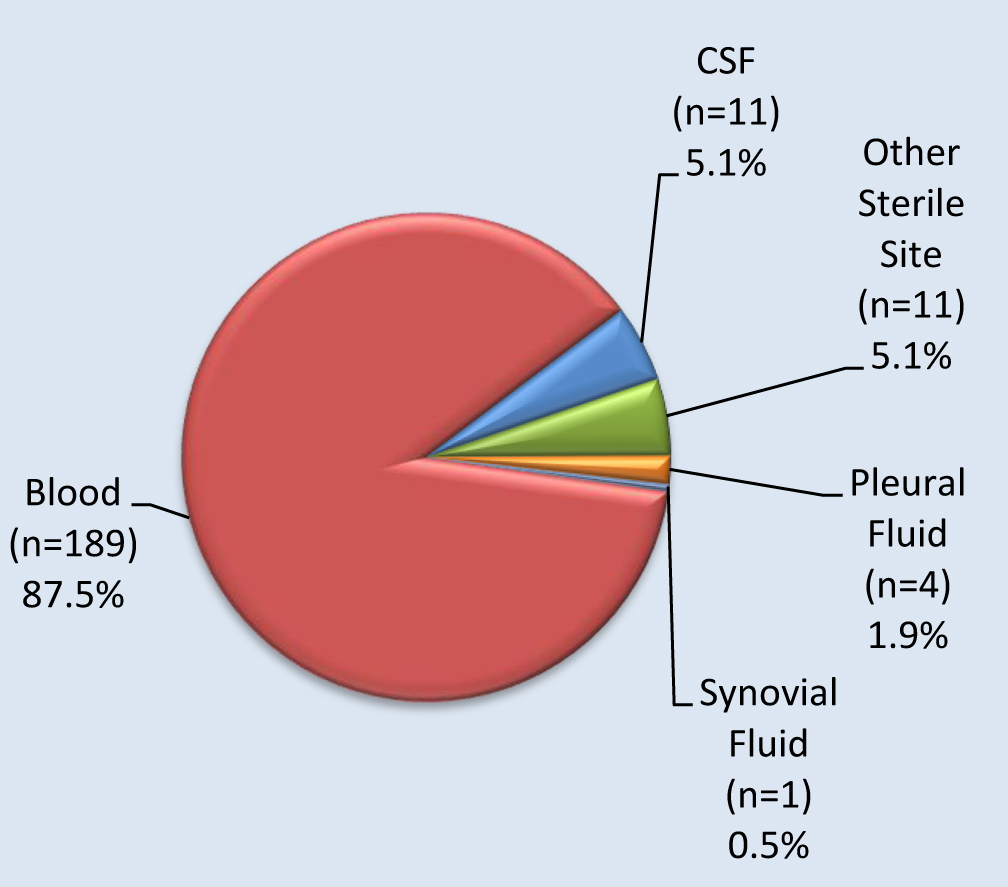
Text Equivalent
| Source | Percentage of Isolates |
|---|---|
| Blood (n=189) | 87.5% |
| CSF (n=11) | 5.1% |
| Other Sterile Site (n=11) | 5.1% |
| Pleural Fluid (n=4) | 1.9% |
| Synovial Fluid (n=1) | 0.5% |
Figure 3b. 2014 Clinical Isolates from ≥5 years of age (N=2,257)*
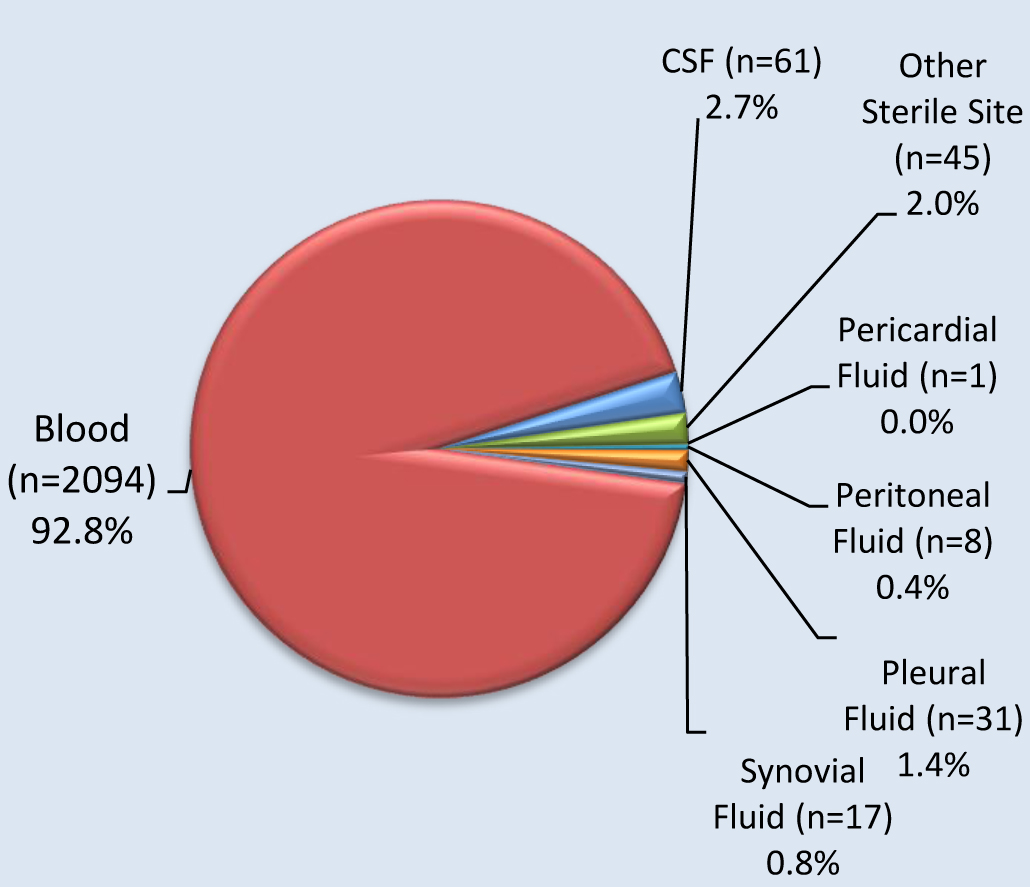
*NOTE: Includes 13 isolates with age not available
Text Equivalent
| Source | Percentage of Isolates |
|---|---|
| Blood (n=2094) | 92.8% |
| CSF (n=61) | 2.7% |
| Other Sterile Site (n=45) | 2.0% |
| Pericardial Fluid (n=1) | 0.0% |
| Peritoneal Fluid (n=8) | 0.4% |
| Pleural Fluid (n=31) | 1.4% |
| Synovial Fluid (n=17) | 0.8% |
Figure 4. Distribution of invasive S. pneumoniae serotypes from blood, 2014
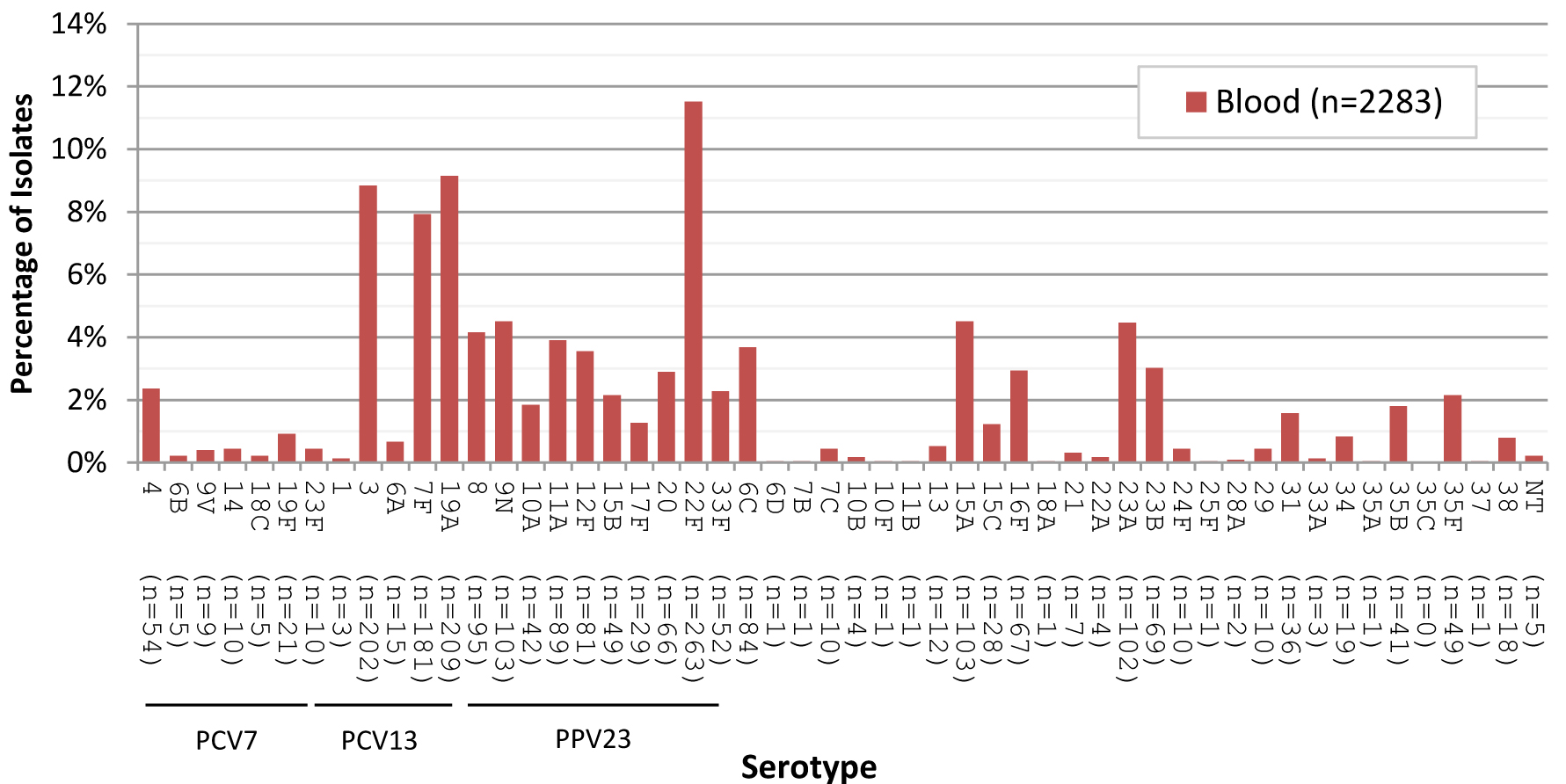
Text Equivalent
| Vaccine | Serotype | Percentage of Blood Isolates (n=2,283) |
|---|---|---|
| PCV7 | 4 (n=54) | 2.4% |
| 6B (n=5) | 0.2% | |
| 9V (n=9) | 0.4% | |
| 14 (n=10) | 0.4% | |
| 18C (n=5) | 0.2% | |
| 19F (n=21) | 0.9% | |
| 23F (n=10) | 0.4% | |
| PCV13 | 1 (n=3) | 0.1% |
| 3 (n=202) | 8.8% | |
| 6A (n=15) | 0.7% | |
| 7F (n=181) | 7.9% | |
| 19A (n=209) | 9.2% | |
| PPV23 | 8 (n=95) | 4.2% |
| 9N (n=103) | 4.5% | |
| 10A (n=42) | 1.8% | |
| 11A (n=89) | 3.9% | |
| 12F (n=81) | 3.5% | |
| 15B (n=49) | 2.1% | |
| 17F (n=29) | 1.3% | |
| 20 (n=66) | 2.9% | |
| 22F (n=263) | 11.5% | |
| 33F (n=52) | 2.3% | |
| 6C (n=84) | 3.7% | |
| 6D (n=1) | 0.0% | |
| 7B (n=1) | 0.0% | |
| 7C (n=10) | 0.4% | |
| 10B (n=4) | 0.2% | |
| 10F (n=1) | 0.0% | |
| 11B (n=1) | 0.0% | |
| 13 (n=12) | 0.5% | |
| 15A (n=103) | 4.5% | |
| 15C (n=28) | 1.2% | |
| 16F (n=67) | 2.9% | |
| 18A (n=1) | 0.0% | |
| 21 (n=7) | 0.3% | |
| 22A (n=4) | 0.2% | |
| 23A (n=102) | 4.5% | |
| 23B (n=69) | 3.0% | |
| 24F (n=10) | 0.4% | |
| 25F (n=1) | 0.0% | |
| 28A (n=2) | 0.1% | |
| 29 (n=10) | 0.4% | |
| 31 (n=36) | 1.6% | |
| 33A (n=3) | 0.1% | |
| 34 (n=19) | 0.8% | |
| 35A (n=1) | 0.0% | |
| 35B (n=41) | 1.8% | |
| 35C (n=0) | 0.0% | |
| 35F (n=49) | 2.1% | |
| 37 (n=1) | 0.0% | |
| 38 (n=18) | 0.8% | |
| NT (n=5) | 0.2% |
Figure 5. Distribution of invasive S. pneumoniae serotypes from CSF, 2014
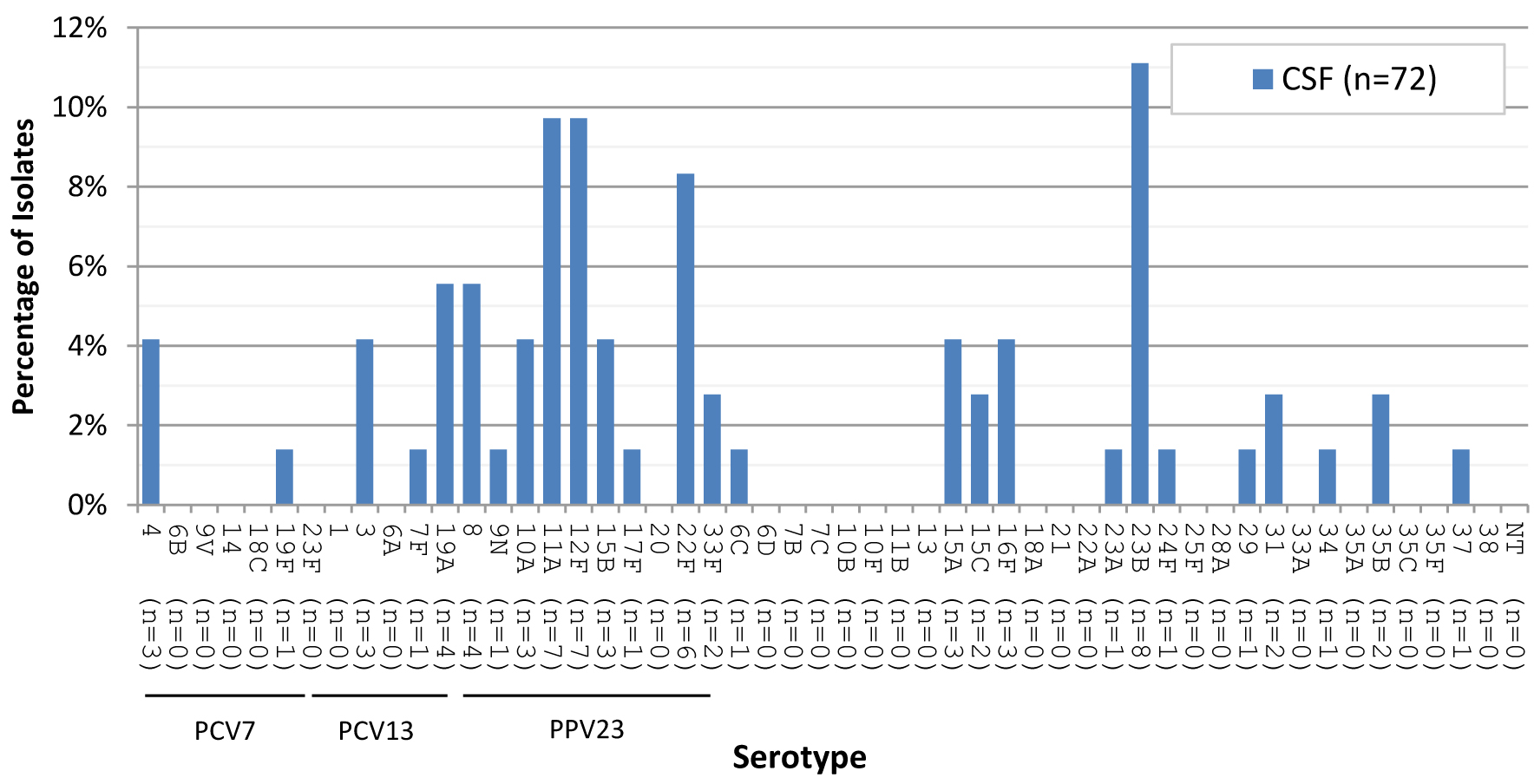
Text Equivalent
| Vaccine | Serotype | Percentage of CSF Isolates (n=72) |
|---|---|---|
| PCV7 | 4 (n=3) | 4.17% |
| 6B (n=0) | 0.00% | |
| 9V (n=0) | 0.00% | |
| 14 (n=0) | 0.00% | |
| 18C (n=0) | 0.00% | |
| 19F (n=1) | 1.39% | |
| 23F (n=0) | 0.00% | |
| PCV13 | 1 (n=0) | 0.00% |
| 3 (n=3) | 4.17% | |
| 6A (n=0) | 0.00% | |
| 7F (n=1) | 1.39% | |
| 19A (n=4) | 5.56% | |
| PPV23 | 8 (n=4) | 5.56% |
| 9N (n=1) | 1.39% | |
| 10A (n=3) | 4.17% | |
| 11A (n=7) | 9.72% | |
| 12F (n=7) | 9.72% | |
| 15B (n=3) | 4.17% | |
| 17F (n=1) | 1.39% | |
| 20 (n=0) | 0.00% | |
| 22F (n=6) | 8.33% | |
| 33F (n=2) | 2.78% | |
| 6C (n=1) | 1.39% | |
| 6D (n=0) | 0.00% | |
| 7B (n=0) | 0.00% | |
| 7C (n=0) | 0.00% | |
| 10B (n=0) | 0.00% | |
| 10F (n=0) | 0.00% | |
| 11B (n=0) | 0.00% | |
| 13 (n=0) | 0.00% | |
| 15A (n=3) | 4.17% | |
| 15C (n=2) | 2.78% | |
| 16F (n=3) | 4.17% | |
| 18A (n=0) | 0.00% | |
| 21 (n=0) | 0.00% | |
| 22A (n=0) | 0.00% | |
| 23A (n=1) | 1.39% | |
| 23B (n=8) | 11.11% | |
| 24F (n=1) | 1.39% | |
| 25F (n=0) | 0.00% | |
| 28A (n=0) | 0.00% | |
| 29 (n=1) | 1.39% | |
| 31 (n=2) | 2.78% | |
| 33A (n=0) | 0.00% | |
| 34 (n=1) | 1.39% | |
| 35A (n=0) | 0.00% | |
| 35B (n=2) | 2.78% | |
| 35C (n=0) | 0.00% | |
| 35F (n=0) | 0.00% | |
| 37 (n=1) | 1.39% | |
| 38 (n=0) | 0.00% | |
| NT (n=0) | 0.00% |
Figure 6. Distribution of invasive S. pneumoniae serotypes from pleural fluid, 2014
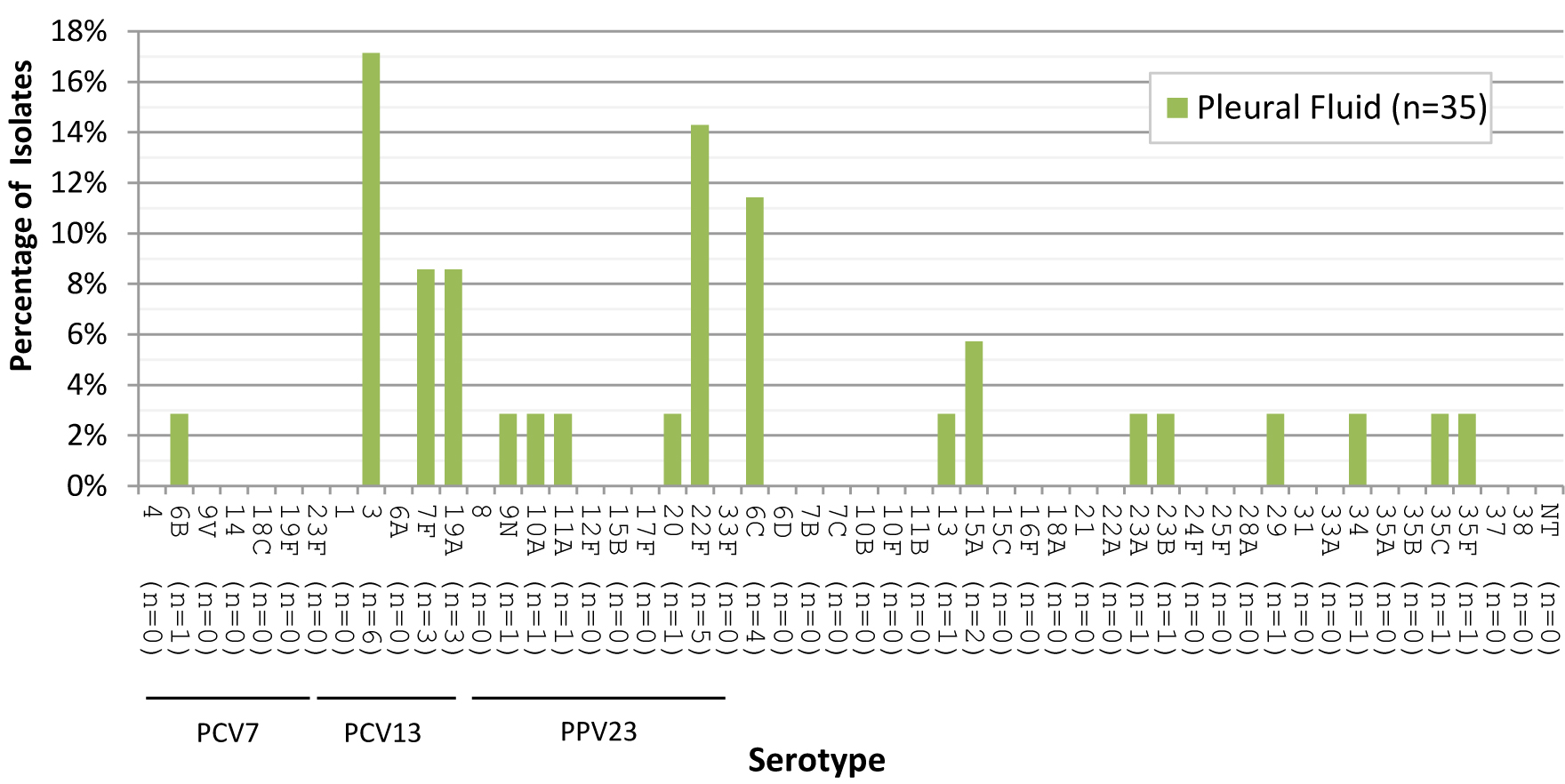
Text Equivalent
| Vaccine | Serotype | Percentage of Pleural Fluid Isolates (n=35) |
|---|---|---|
| PCV7 | 4 (n=0) | 0.0% |
| 6B (n=1) | 2.9% | |
| 9V (n=0) | 0.0% | |
| 14 (n=0) | 0.0% | |
| 18C (n=0) | 0.0% | |
| 19F (n=0) | 0.0% | |
| 23F (n=0) | 0.0% | |
| PCV13 | 1 (n=0) | 0.0% |
| 3 (n=6) | 17.1% | |
| 6A (n=0) | 0.0% | |
| 7F (n=3) | 8.6% | |
| 19A (n=3) | 8.6% | |
| PPV23 | 8 (n=0) | 0.0% |
| 9N (n=1) | 2.9% | |
| 10A (n=1) | 2.9% | |
| 11A (n=1) | 2.9% | |
| 12F (n=0) | 0.0% | |
| 15B (n=0) | 0.0% | |
| 17F (n=0) | 0.0% | |
| 20 (n=1) | 2.9% | |
| 22F (n=5) | 14.3% | |
| 33F (n=0) | 0.0% | |
| 6C (n=4) | 11.4% | |
| 6D (n=0) | 0.0% | |
| 7B (n=0) | 0.0% | |
| 7C (n=0) | 0.0% | |
| 10B (n=0) | 0.0% | |
| 10F (n=0) | 0.0% | |
| 11B (n=0) | 0.0% | |
| 13 (n=1) | 2.9% | |
| 15A (n=2) | 5.7% | |
| 15C (n=0) | 0.0% | |
| 16F (n=0) | 0.0% | |
| 18A (n=0) | 0.0% | |
| 21 (n=0) | 0.0% | |
| 22A (n=0) | 0.0% | |
| 23A (n=1) | 2.9% | |
| 23B (n=1) | 2.9% | |
| 24F (n=0) | 0.0% | |
| 25F (n=0) | 0.0% | |
| 28A (n=0) | 0.0% | |
| 29 (n=1) | 2.9% | |
| 31 (n=0) | 0.0% | |
| 33A (n=0) | 0.0% | |
| 34 (n=1) | 2.9% | |
| 35A (n=0) | 0.0% | |
| 35B (n=0) | 0.0% | |
| 35C (n=1) | 2.9% | |
| 35F (n=1) | 2.9% | |
| 37 (n=0) | 0.0% | |
| 38 (n=0) | 0.0% | |
| NT (n=0) | 0.0% |
Figure 7. Distribution of invasive S. pneumoniae serotypes from other sterile sites, 2014
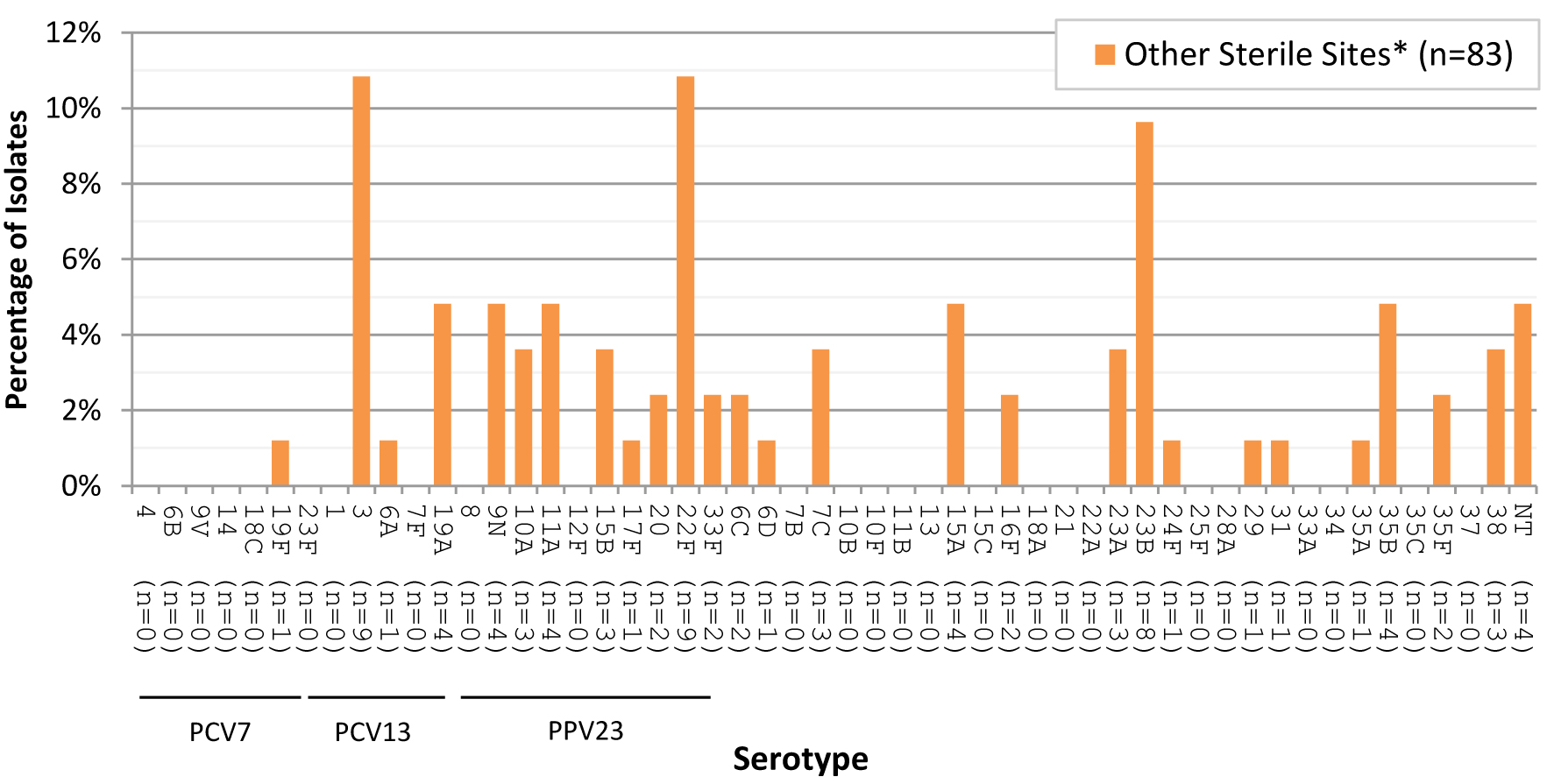
*Other Sterile Sites include: 1 pericardial fluid, 8 peritoneal fluid, 18 synovial fluid and 56 from sites such as deep tissue, biopsy and surgical samples.
Text Equivalent
| Vaccine | Serotype | Percentage of Isolates from Other Sterile SitesTable Figure 7 Footnote 1 (n=83) |
|---|---|---|
Table Figure 7 Footnotes
|
||
| PCV7 | 4 (n=0) | 0.0% |
| 6B (n=1) | 2.9% | |
| 9V (n=0) | 0.0% | |
| 14 (n=0) | 0.0% | |
| 18C (n=0) | 0.0% | |
| 19F (n=0) | 0.0% | |
| 23F (n=0) | 0.0% | |
| PCV13 | 1 (n=0) | 0.0% |
| 3 (n=6) | 17.1% | |
| 6A (n=0) | 0.0% | |
| 7F (n=3) | 8.6% | |
| 19A (n=3) | 8.6% | |
| PPV23 | 8 (n=0) | 0.0% |
| 9N (n=1) | 2.9% | |
| 10A (n=1) | 2.9% | |
| 11A (n=1) | 2.9% | |
| 12F (n=0) | 0.0% | |
| 15B (n=0) | 0.0% | |
| 17F (n=0) | 0.0% | |
| 20 (n=1) | 2.9% | |
| 22F (n=5) | 14.3% | |
| 33F (n=0) | 0.0% | |
| 6C (n=4) | 11.4% | |
| 6D (n=0) | 0.0% | |
| 7B (n=0) | 0.0% | |
| 7C (n=0) | 0.0% | |
| 10B (n=0) | 0.0% | |
| 10F (n=0) | 0.0% | |
| 11B (n=0) | 0.0% | |
| 13 (n=1) | 2.9% | |
| 15A (n=2) | 5.7% | |
| 15C (n=0) | 0.0% | |
| 16F (n=0) | 0.0% | |
| 18A (n=0) | 0.0% | |
| 21 (n=0) | 0.0% | |
| 22A (n=0) | 0.0% | |
| 23A (n=1) | 2.9% | |
| 23B (n=1) | 2.9% | |
| 24F (n=0) | 0.0% | |
| 25F (n=0) | 0.0% | |
| 28A (n=0) | 0.0% | |
| 29 (n=1) | 2.9% | |
| 31 (n=0) | 0.0% | |
| 33A (n=0) | 0.0% | |
| 34 (n=1) | 2.9% | |
| 35A (n=0) | 0.0% | |
| 35B (n=0) | 0.0% | |
| 35C (n=1) | 2.9% | |
| 35F (n=1) | 2.9% | |
| 37 (n=0) | 0.0% | |
| 38 (n=0) | 0.0% | |
| NT (n=0) | 0.0% | |
Figure 8. Regional Distribution of Invasive S. pneumoniae serotypes, 2014
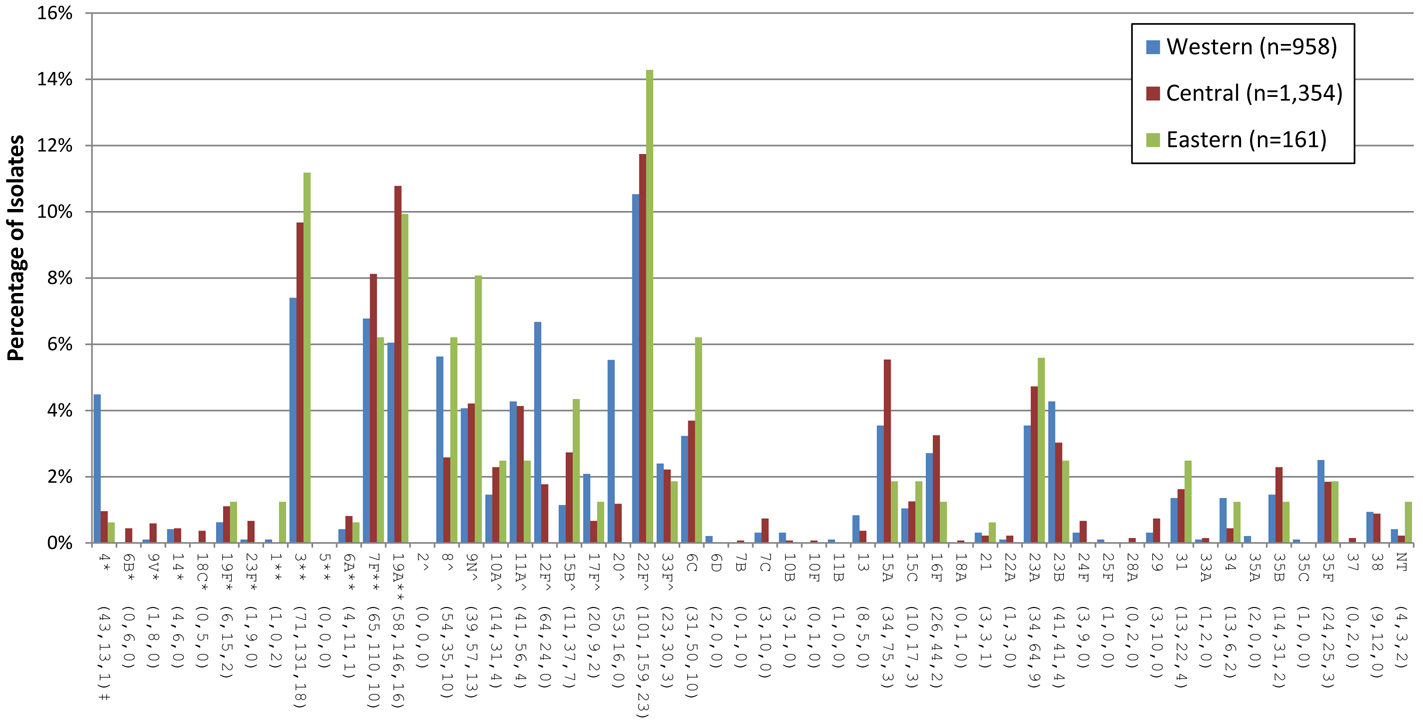
*Component of PCV7; ** Component of PCV13; ^ Component of PPV23; ‡ Number of isolates for Western, Central and Eastern Canada, respectively.
Text Equivalent
| Serotype | Western (n=958) | Central (n=1,354) | Eastern (n=161) |
|---|---|---|---|
Table Figure 8 Footnotes
|
|||
| 4Table Figure 8 Footnote 1 (43,13,1)Table Figure 8 Footnote 4 | 4.5% | 1.0% | 0.6% |
| 6BTable Figure 8 Footnote 1 (0,6,0) | 0.0% | 0.4% | 0.0% |
| 9VTable Figure 8 Footnote 1 (1,8,0) | 0.1% | 0.6% | 0.0% |
| 14Table Figure 8 Footnote 1 (4,6,0) | 0.4% | 0.4% | 0.0% |
| 18CTable Figure 8 Footnote 1 (0,5,0) | 0.0% | 0.4% | 0.0% |
| 19FTable Figure 8 Footnote 1 (6,15,2) | 0.6% | 1.1% | 1.2% |
| 23FTable Figure 8 Footnote 1 (1,9,0) | 0.1% | 0.7% | 0.0% |
| 1Table Figure 8 Footnote 2 (1,0,2) | 0.1% | 0.0% | 1.2% |
| 3Table Figure 8 Footnote 2 (71,131,18) | 7.4% | 9.7% | 11.2% |
| 5Table Figure 8 Footnote 2 (0,0,0) | 0.0% | 0.0% | 0.0% |
| 6ATable Figure 8 Footnote 2 (4,11,1) | 0.4% | 0.8% | 0.6% |
| 7FTable Figure 8 Footnote 2 (65,110,10) | 6.8% | 8.1% | 6.2% |
| 19ATable Figure 8 Footnote 2(58,146,16) | 6.0% | 10.8% | 9.9% |
| 2Table Figure 8 Footnote 3 (0,0,0) | 0.0% | 0.0% | 0.0% |
| 8Table Figure 8 Footnote 3 (54,35,10) | 5.6% | 2.6% | 6.2% |
| 9NTable Figure 8 Footnote 3 (39,57,13) | 4.1% | 4.2% | 8.1% |
| 10ATable Figure 8 Footnote 3 (14,31,4) | 1.5% | 2.3% | 2.5% |
| 11ATable Figure 8 Footnote 3 (41,56,4) | 4.3% | 4.1% | 2.5% |
| 12FTable Figure 8 Footnote 3 (64,24,0) | 6.7% | 1.8% | 0.0% |
| 15BTable Figure 8 Footnote 3 (11,37,7) | 1.1% | 2.7% | 4.3% |
| 17FTable Figure 8 Footnote 3 (20,9,2) | 2.1% | 0.7% | 1.2% |
| 20Table Figure 8 Footnote 3 (53,16,0) | 5.5% | 1.2% | 0.0% |
| 22FTable Figure 8 Footnote 3 (101,159,23) | 10.5% | 11.7% | 14.3% |
| 33FTable Figure 8 Footnote 3 (23,30,3) | 2.4% | 2.2% | 1.9% |
| 6C (31,50,10) | 3.2% | 3.7% | 6.2% |
| 6D (2,0,0) | 0.2% | 0.0% | 0.0% |
| 7B (0,1,0) | 0.0% | 0.1% | 0.0% |
| 7C (3,10,0) | 0.3% | 0.7% | 0.0% |
| 10B (3,1,0) | 0.3% | 0.1% | 0.0% |
| 10F (0,1,0) | 0.0% | 0.1% | 0.0% |
| 11B (1,0,0) | 0.1% | 0.0% | 0.0% |
| 13 (8,5,0) | 0.8% | 0.4% | 0.0% |
| 15A (34,75,3) | 3.5% | 5.5% | 1.9% |
| 15C (10,17,3) | 1.0% | 1.3% | 1.9% |
| 16F (26,44,2) | 2.7% | 3.2% | 1.2% |
| 18A (0,1,0) | 0.0% | 0.1% | 0.0% |
| 21 (3,3,1) | 0.3% | 0.2% | 0.6% |
| 22A (1,3,0) | 0.1% | 0.2% | 0.0% |
| 23A (34,64,9) | 3.5% | 4.7% | 5.6% |
| 23B (41,41,4) | 4.3% | 3.0% | 2.5% |
| 24F (3,9,0) | 0.3% | 0.7% | 0.0% |
| 25F (1,0,0) | 0.1% | 0.0% | 0.0% |
| 28A (0,2,0) | 0.0% | 0.1% | 0.0% |
| 29 (3,10,0) | 0.3% | 0.7% | 0.0% |
| 31 (13,22,4) | 1.4% | 1.6% | 2.5% |
| 33A (1,2,0) | 0.1% | 0.1% | 0.0% |
| 34 (13,6,2) | 1.4% | 0.4% | 1.2% |
| 35A (2,0,0) | 0.2% | 0.0% | 0.0% |
| 35B (14,31,2) | 1.5% | 2.3% | 1.2% |
| 35C (1,0,0) | 0.1% | 0.0% | 0.0% |
| 35F (24,25,3) | 2.5% | 1.8% | 1.9% |
| 37 (0,2,0) | 0.0% | 0.1% | 0.0% |
| 38 (9,12,0) | 0.9% | 0.9% | 0.0% |
| NT (4,3,2) | 0.4% | 0.2% | 1.2% |
Figure 9a. Age Group Distribution of Invasive S. pneumoniae serotypes isolated in 2014: <2, 2-4 and 5-14 year old age groups
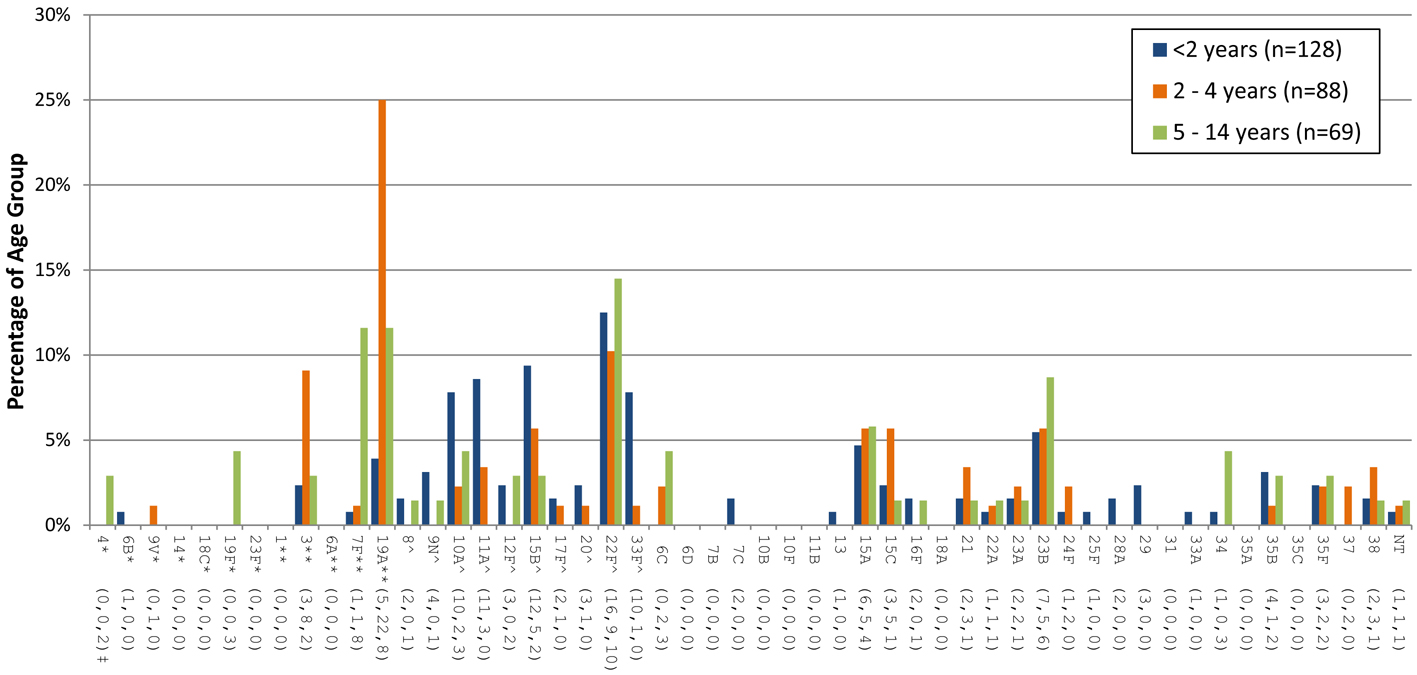
*Component of PCV7; ** Component of PCV13; ^ Component of PPV23; ‡ Number of isolates for <2, 2-4 and 5-14 year old age groups, respectively.
Text Equivalent
| Serotype | < 2 years (n=128) | 2 - 4 years (n=88) | 5 - 14 years (n=69) |
|---|---|---|---|
Table Figure 9a Footnotes
|
|||
| 4Table Figure 9a Footnote 1 (0,0,2)Table Figure 9a Footnote 4 | 0.0% | 0.0% | 2.9% |
| 6BTable Figure 9a Footnote 1 (1,0,0) | 0.8% | 0.0% | 0.0% |
| 9VTable Figure 9a Footnote 1 (0,1,0) | 0.0% | 1.1% | 0.0% |
| 14Table Figure 9a Footnote 1 (0,0,0) | 0.0% | 0.0% | 0.0% |
| 18CTable Figure 9a Footnote 1 (0,0,0) | 0.0% | 0.0% | 0.0% |
| 19FTable Figure 9a Footnote 1 (0,0,3) | 0.0% | 0.0% | 4.3% |
| 23FTable Figure 9a Footnote 1 (0,0,0) | 0.0% | 0.0% | 0.0% |
| 1Table Figure 9a Footnote 2 (0,0,0) | 0.0% | 0.0% | 0.0% |
| 3Table Figure 9a Footnote 2 (3,8,2) | 2.3% | 9.1% | 2.9% |
| 6ATable Figure 9a Footnote 2 (0,0,0) | 0.0% | 0.0% | 0.0% |
| 7FTable Figure 9a Footnote 2 (1,1,8) | 0.8% | 1.1% | 11.6% |
| 19ATable Figure 9a Footnote 2(5,22,8) | 3.9% | 25.0% | 11.6% |
| 8Table Figure 9a Footnote 3 (2,0,1) | 1.6% | 0.0% | 1.4% |
| 9NTable Figure 9a Footnote 3 (4,0,1) | 3.1% | 0.0% | 1.4% |
| 10ATable Figure 9a Footnote 3 (10,2,3) | 7.8% | 2.3% | 4.3% |
| 11ATable Figure 9a Footnote 3 (11,3,0) | 8.6% | 3.4% | 0.0% |
| 12FTable Figure 9a Footnote 3 (3,0,2) | 2.3% | 0.0% | 2.9% |
| 15BTable Figure 9a Footnote 3 (12,5,2) | 9.4% | 5.7% | 2.9% |
| 17FTable Figure 9a Footnote 3 (2,1,0) | 1.6% | 1.1% | 0.0% |
| 20Table Figure 9a Footnote 3 (3,1,0) | 2.3% | 1.1% | 0.0% |
| 22FTable Figure 9a Footnote 3 (16,9,10) | 12.5% | 10.2% | 14.5% |
| 33FTable Figure 9a Footnote 3 (10,1,0) | 7.8% | 1.1% | 0.0% |
| 6C (0,2,3) | 0.0% | 2.3% | 4.3% |
| 6D (0,0,0) | 0.0% | 0.0% | 0.0% |
| 7B (0,0,0) | 0.0% | 0.0% | 0.0% |
| 7C (2,0,0) | 1.6% | 0.0% | 0.0% |
| 10B (0,0,0) | 0.0% | 0.0% | 0.0% |
| 10F (0,0,0) | 0.0% | 0.0% | 0.0% |
| 11B (0,0,0) | 0.0% | 0.0% | 0.0% |
| 13 (1,0,0) | 0.8% | 0.0% | 0.0% |
| 15A (6,5,4) | 4.7% | 5.7% | 5.8% |
| 15C (3,5,1) | 2.3% | 5.7% | 1.4% |
| 16F (2,0,1) | 1.6% | 0.0% | 1.4% |
| 18A (0,0,0) | 0.0% | 0.0% | 0.0% |
| 21 (2,3,1) | 1.6% | 3.4% | 1.4% |
| 22A (1,1,1) | 0.8% | 1.1% | 1.4% |
| 23A (2,2,1) | 1.6% | 2.3% | 1.4% |
| 23B (7,5,6) | 5.5% | 5.7% | 8.7% |
| 24F (1,2,0) | 0.8% | 2.3% | 0.0% |
| 25F (1,0,0) | 0.8% | 0.0% | 0.0% |
| 28A (2,0,0) | 1.6% | 0.0% | 0.0% |
| 29 (3,0,0) | 2.3% | 0.0% | 0.0% |
| 31 (0,0,0) | 0.0% | 0.0% | 0.0% |
| 33A (1,0,0) | 0.8% | 0.0% | 0.0% |
| 34 (1,0,3) | 0.8% | 0.0% | 4.3% |
| 35A (0,0,0) | 0.0% | 0.0% | 0.0% |
| 35B (4,1,2) | 3.1% | 1.1% | 2.9% |
| 35C (0,0,0) | 0.0% | 0.0% | 0.0% |
| 35F (3,2,2) | 2.3% | 2.3% | 2.9% |
| 37 (0,2,0) | 0.0% | 2.3% | 0.0% |
| 38 (2,3,1) | 1.6% | 3.4% | 1.4% |
| NT (1,1,1) | 0.8% | 1.1% | 1.4% |
Figure 9b. Age Group Distribution of Invasive S. pneumoniae serotypes isolated in 2014: 15-49, 50-64, and ≥65 year old age groups
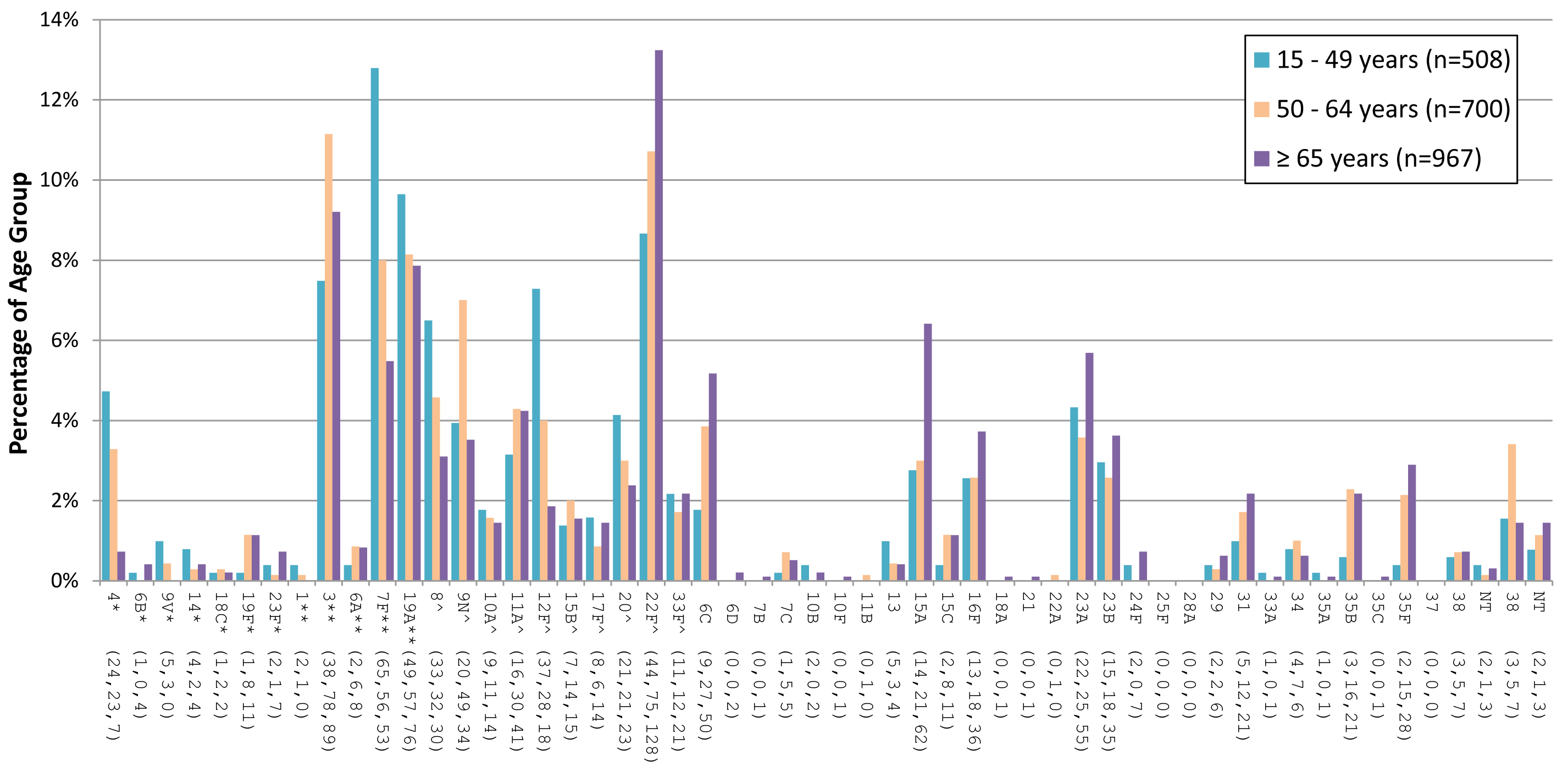
*Component of PCV7; ** Component of PCV13; ^ Component of PPV23; ‡ Number of isolates for 15-49, 50-64 and ≥65 year old age groups respectively.
Text Equivalent
| Serotype | 15 - 49 years (n=508) | 50 - 64 years (n=700) | ≥ 65 years (n=967) |
|---|---|---|---|
Table Figrue 9b Footnotes
|
|||
| 4Table Figure 9b Footnote 1 (24,23,7)Table Figure 9b Footnote 4 | 4.7% | 3.3% | 0.7% |
| 6BTable Figure 9b Footnote 1 (1,0,4) | 0.2% | 0.0% | 0.4% |
| 9VTable Figure 9b Footnote 1 (5,3,0) | 1.0% | 0.4% | 0.0% |
| 14Table Figure 9b Footnote 1 (4,2,4) | 0.8% | 0.3% | 0.4% |
| 18CTable Figure 9b Footnote 1 (1,2,2) | 0.2% | 0.3% | 0.2% |
| 19FTable Figure 9b Footnote 1 (1,8,11) | 0.2% | 1.1% | 1.1% |
| 23FTable Figure 9b Footnote 1 (2,1,7) | 0.4% | 0.1% | 0.7% |
| 1Table Figure 9b Footnote 2 (2,1,0) | 0.4% | 0.1% | 0.0% |
| 3Table Figure 9b Footnote 2 (38,78,89) | 7.5% | 11.1% | 9.2% |
| 6ATable Figure 9b Footnote 2 (2,6,8) | 0.4% | 0.9% | 0.8% |
| 7FTable Figure 9b Footnote 2 (65,56,53) | 12.8% | 8.0% | 5.5% |
| 19ATable Figure 9b Footnote 2(49,57,76) | 9.6% | 8.1% | 7.9% |
| 8Table Figure 9b Footnote 3 (33,32,30) | 6.5% | 4.6% | 3.1% |
| 9NTable Figure 9b Footnote 3 (20,49,34) | 3.9% | 7.0% | 3.5% |
| 10ATable Figure 9b Footnote 3 (9,11,14) | 1.8% | 1.6% | 1.4% |
| 11ATable Figure 9b Footnote 3 (16,30,41) | 3.1% | 4.3% | 4.2% |
| 12FTable Figure 9b Footnote 3 (37,28,18) | 7.3% | 4.0% | 1.9% |
| 15BTable Figure 9b Footnote 3 (7,14,15) | 1.4% | 2.0% | 1.6% |
| 17FTable Figure 9b Footnote 3 (8,6,14) | 1.6% | 0.9% | 1.4% |
| 20Table Figure 9b Footnote 3 (21,21,23) | 4.1% | 3.0% | 2.4% |
| 22FTable Figure 9b Footnote 3 (44,75,128) | 8.7% | 10.7% | 13.2% |
| 33FTable Figure 9b Footnote 3 (11,12,21) | 2.2% | 1.7% | 2.2% |
| 6C (9,27,50) | 1.8% | 3.9% | 5.2% |
| 6D (0,0,2) | 0.0% | 0.0% | 0.2% |
| 7B (0,0,1) | 0.0% | 0.0% | 0.1% |
| 7C (1,5,5) | 0.2% | 0.7% | 0.5% |
| 10B (2,0,2) | 0.4% | 0.0% | 0.2% |
| 10F (0,0,1) | 0.0% | 0.0% | 0.1% |
| 11B (0,1,0) | 0.0% | 0.1% | 0.0% |
| 13 (5,3,4) | 1.0% | 0.4% | 0.4% |
| 15A (14,21,62) | 2.8% | 3.0% | 6.4% |
| 15C (2,8,11) | 0.4% | 1.1% | 1.1% |
| 16F (13,18,36) | 2.6% | 2.6% | 3.7% |
| 18A (0,0,1) | 0.0% | 0.0% | 0.1% |
| 21 (0,0,1) | 0.0% | 0.0% | 0.1% |
| 22A (0,1,0) | 0.0% | 0.1% | 0.0% |
| 23A (22,25,55) | 4.3% | 3.6% | 5.7% |
| 23B (15,18,35) | 3.0% | 2.6% | 3.6% |
| 24F (2,0,7) | 0.4% | 0.0% | 0.7% |
| 25F (0,0,0) | 0.0% | 0.0% | 0.0% |
| 28A (0,0,0) | 0.0% | 0.0% | 0.0% |
| 29 (2,2,6) | 0.4% | 0.3% | 0.6% |
| 31 (5,12,21) | 1.0% | 1.7% | 2.2% |
| 33A (1,0,1) | 0.2% | 0.0% | 0.1% |
| 34 (4,7,6) | 0.8% | 1.0% | 0.6% |
| 35A (1,0,1) | 0.2% | 0.0% | 0.1% |
| 35B (3,16,21) | 0.6% | 2.3% | 2.2% |
| 35C (0,0,1) | 0.0% | 0.0% | 0.1% |
| 35F (2,15,28) | 0.4% | 2.1% | 2.9% |
| 37 (0,0,0) | 0.0% | 0.0% | 0.0% |
| 38 (3,5,7) | 0.6% | 0.7% | 0.7% |
| NT (2,1,3) | 0.4% | 0.1% | 0.3% |
| 38 (3,5,7) | 1.6% | 3.4% | 1.4% |
| NT (2,1,3) | 0.8% | 1.1% | 1.4% |
Figure 10. Invasive S. pneumoniae serotypes in all combined age groups, 2010 – 2014
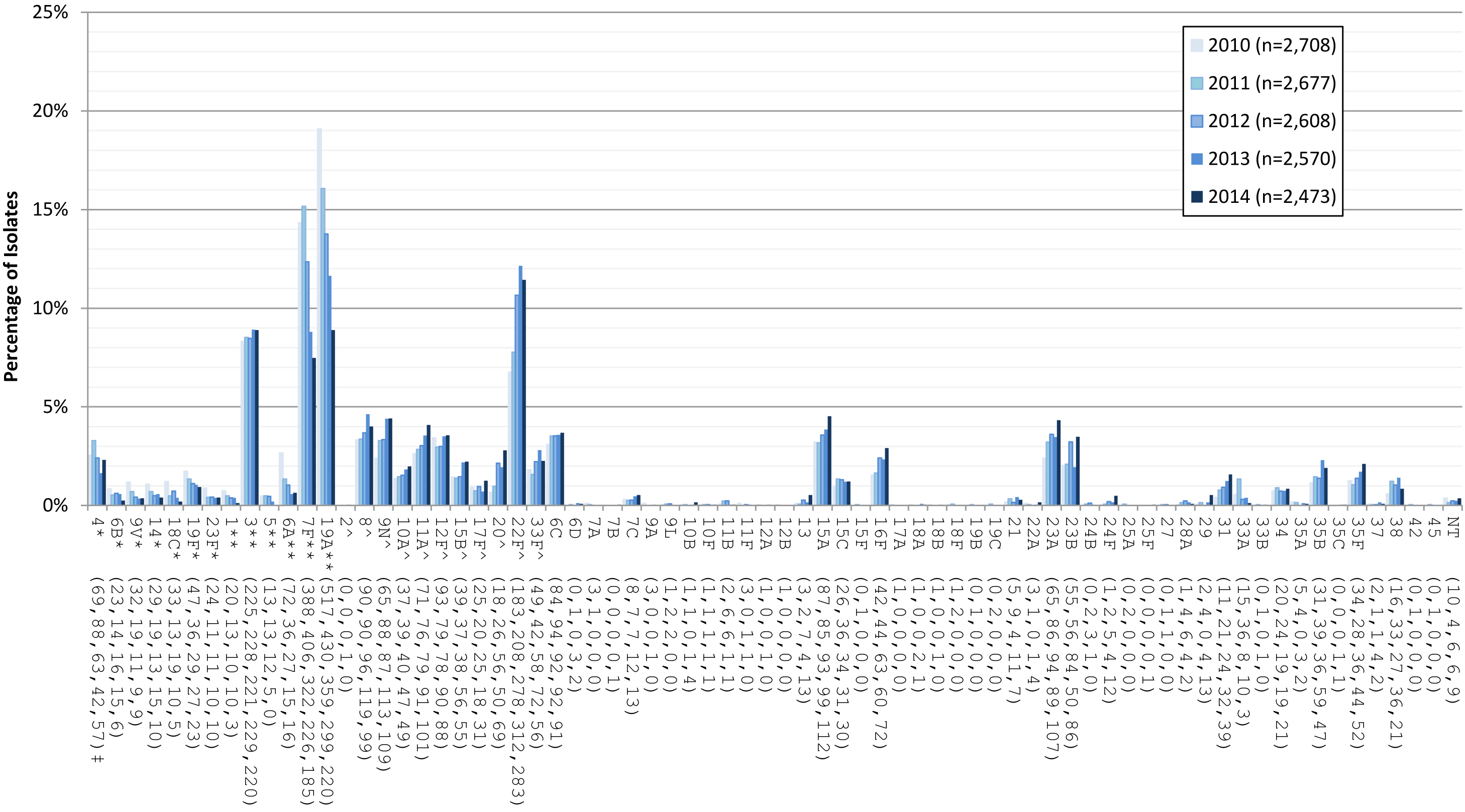
*Component of PCV7; ** Component of PCV13; ^ Component of PPV23; ‡ Number of isolates for 2010, 2011, 2012, 2013 and 2014 respectively.
Text Equivalent
| Serotype | 2010 (n=2,708) | 2011 (n=2,677) | 2012 (n=2,608) | 2013 (n=2,570) | 2014 (n=2,473) |
|---|---|---|---|---|---|
Table Figure 10 Footnotes
|
|||||
| 4Table Figure 10 Footnote 1 (69,88,63,42,57)Table Figure 10 Footnote 4 | 2.5% | 3.3% | 2.4% | 1.6% | 2.3% |
| 6BTable Figure 10 Footnote 1 (23,14,16,15,6) | 0.8% | 0.5% | 0.6% | 0.6% | 0.2% |
| 9VTable Figure 10 Footnote 1 (32,19,11,9,9) | 1.2% | 0.7% | 0.4% | 0.4% | 0.4% |
| 14Table Figure 10 Footnote 1 (29,19,13,15,10) | 1.1% | 0.7% | 0.5% | 0.6% | 0.4% |
| 18CTable Figure 10 Footnote 1 (33,13,19,10,5) | 1.2% | 0.5% | 0.7% | 0.4% | 0.2% |
| 19FTable Figure 10 Footnote 1 (47,36,29,27,23) | 1.7% | 1.3% | 1.1% | 1.1% | 0.9% |
| 23FTable Figure 10 Footnote 1 (24,11,11,10,10) | 0.9% | 0.4% | 0.4% | 0.4% | 0.4% |
| 1Table Figure 10 Footnote 2 (20,13,10,10,3) | 0.7% | 0.5% | 0.4% | 0.4% | 0.1% |
| 3Table Figure 10 Footnote 2 (225,228,221,229,220) | 8.3% | 8.5% | 8.5% | 8.9% | 8.9% |
| 5Table Figure 10 Footnote 2 (13,13,12,5,0) | 0.5% | 0.5% | 0.5% | 0.2% | 0.0% |
| 6ATable Figure 10 Footnote 2 (72,36,27,15,16) | 2.7% | 1.3% | 1.0% | 0.6% | 0.6% |
| 7FTable Figure 10 Footnote 2 (388,406,322,226,185) | 14.3% | 15.2% | 12.3% | 8.8% | 7.5% |
| 19ATable Figure 10 Footnote 2(517,430,359,299,220) | 19.1% | 16.1% | 13.8% | 11.6% | 8.9% |
| 2Table Figure 10 Footnote 3 (0,0,0,1,0) | 0.0% | 0.0% | 0.0% | 0.0% | 0.0% |
| 8Table Figure 10 Footnote 3 (90,90,96,119,99) | 3.3% | 3.4% | 3.7% | 4.6% | 4.0% |
| 9NTable Figure 10 Footnote 3 (65,88,87,113,109) | 2.4% | 3.3% | 3.3% | 4.4% | 4.4% |
| 10ATable Figure 10 Footnote 3 (37,39,40,47,49) | 1.4% | 1.5% | 1.5% | 1.8% | 2.0% |
| 11ATable Figure 10 Footnote 3 (71,76,79,91,101) | 2.6% | 2.8% | 3.0% | 3.5% | 4.1% |
| 12FTable Figure 10 Footnote 3 (93,79,78,90,88) | 3.4% | 3.0% | 3.0% | 3.5% | 3.6% |
| 15BTable Figure 10 Footnote 3 (39,37,38,56,55) | 1.4% | 1.4% | 1.5% | 2.2% | 2.2% |
| 17FTable Figure 10 Footnote 3 (25,20,25,18,31) | 0.9% | 0.7% | 1.0% | 0.7% | 1.3% |
| 20Table Figure 10 Footnote 3 (18,26,56,50,69) | 0.7% | 1.0% | 2.1% | 1.9% | 2.8% |
| 22FTable Figure 10 Footnote 3 (183,208,278,312,283) | 6.8% | 7.8% | 10.7% | 12.1% | 11.4% |
| 33FTable Figure 10 Footnote 3 (49,42,58,72,56) | 1.8% | 1.6% | 2.2% | 2.8% | 2.3% |
| 6C (84,94,92,92,91) | 3.1% | 3.5% | 3.5% | 3.6% | 3.7% |
| 6D (0,1,0,3,2) | 0.0% | 0.0% | 0.0% | 0.1% | 0.1% |
| 7A (3,1,0,0,0) | 0.1% | 0.0% | 0.0% | 0.0% | 0.0% |
| 7B (0,0,0,0,1) | 0.0% | 0.0% | 0.0% | 0.0% | 0.0% |
| 7C (8,7,7,12,13) | 0.3% | 0.3% | 0.3% | 0.5% | 0.5% |
| 9A (3,0,0,1,0) | 0.1% | 0.0% | 0.0% | 0.0% | 0.0% |
| 9L (1,2,2,0,0) | 0.0% | 0.1% | 0.1% | 0.0% | 0.0% |
| 10B (1,1,0,1,4) | 0.0% | 0.0% | 0.0% | 0.0% | 0.2% |
| 10F (1,1,1,1,1) | 0.0% | 0.0% | 0.0% | 0.0% | 0.0% |
| 11B (2,6,6,1,1) | 0.1% | 0.2% | 0.2% | 0.0% | 0.0% |
| 11F (3,0,1,1,0) | 0.1% | 0.0% | 0.0% | 0.0% | 0.0% |
| 12A (1,0,0,1,0) | 0.0% | 0.0% | 0.0% | 0.0% | 0.0% |
| 12B (1,0,0,0,0) | 0.0% | 0.0% | 0.0% | 0.0% | 0.0% |
| 13 (3,2,7,4,13) | 0.1% | 0.1% | 0.3% | 0.2% | 0.5% |
| 15A (87,85,93,99,112) | 3.2% | 3.2% | 3.6% | 3.9% | 4.5% |
| 15C (26,36,34,31,30) | 1.0% | 1.3% | 1.3% | 1.2% | 1.2% |
| 15F (0,1,0,0,0) | 0.0% | 0.0% | 0.0% | 0.0% | 0.0% |
| 16F (42,44,63,60,72) | 1.6% | 1.6% | 2.4% | 2.3% | 2.9% |
| 17A (1,0,0,0,0) | 0.0% | 0.0% | 0.0% | 0.0% | 0.0% |
| 18A (1,0,0,2,1) | 0.0% | 0.0% | 0.0% | 0.1% | 0.0% |
| 18B (1,0,0,1,0) | 0.0% | 0.0% | 0.0% | 0.0% | 0.0% |
| 18F (1,2,0,0,0) | 0.0% | 0.1% | 0.0% | 0.0% | 0.0% |
| 19B (0,1,0,0,0) | 0.0% | 0.0% | 0.0% | 0.0% | 0.0% |
| 19C (0,2,0,0,0) | 0.0% | 0.1% | 0.0% | 0.0% | 0.0% |
| 21 (5,9,4,11,7) | 0.2% | 0.3% | 0.2% | 0.4% | 0.3% |
| 22A (3,1,0,1,4) | 0.1% | 0.0% | 0.0% | 0.0% | 0.2% |
| 23A (65,86,94,89,107) | 2.4% | 3.2% | 3.6% | 3.5% | 4.3% |
| 23B (55,56,84,50,86) | 2.0% | 2.1% | 3.2% | 1.9% | 3.5% |
| 24B (0,2,3,1,0) | 0.0% | 0.1% | 0.1% | 0.0% | 0.0% |
| 24F (1,2,5,4,12) | 0.0% | 0.1% | 0.2% | 0.2% | 0.5% |
| 25A (0,2,0,0,0) | 0.0% | 0.1% | 0.0% | 0.0% | 0.0% |
| 25F (0,0,0,0,1) | 0.0% | 0.0% | 0.0% | 0.0% | 0.0% |
| 27 (0,1,1,0,0) | 0.0% | 0.0% | 0.0% | 0.0% | 0.0% |
| 28A (1,4,6,4,2) | 0.0% | 0.1% | 0.2% | 0.2% | 0.1% |
| 29 (2,4,0,4,13) | 0.1% | 0.1% | 0.0% | 0.2% | 0.5% |
| 31 (11,21,24,32,39) | 0.4% | 0.8% | 0.9% | 1.2% | 1.6% |
| 33A (15,36,8,10,3) | 0.6% | 1.3% | 0.3% | 0.4% | 0.1% |
| 33B (0,1,0,1,0) | 0.0% | 0.0% | 0.0% | 0.0% | 0.0% |
| 34 (20,24,19,19,21) | 0.7% | 0.9% | 0.7% | 0.7% | 0.8% |
| 35A (5,4,0,3,2) | 0.2% | 0.1% | 0.0% | 0.1% | 0.1% |
| 35B (31,39,36,59,47) | 1.1% | 1.5% | 1.4% | 2.3% | 1.9% |
| 35C (0,0,0,1,1) | 0.0% | 0.0% | 0.0% | 0.0% | 0.0% |
| 35F (34,28,36,44,52) | 1.3% | 1.0% | 1.4% | 1.7% | 2.1% |
| 37 (2,1,1,4,2) | 0.1% | 0.0% | 0.0% | 0.2% | 0.1% |
| 38 (16,33,27,36,21) | 0.6% | 1.2% | 1.0% | 1.4% | 0.8% |
| 42 (0,1,0,0,0) | 0.0% | 0.0% | 0.0% | 0.0% | 0.0% |
| 45 (0,1,0,0,0) | 0.0% | 0.0% | 0.0% | 0.0% | 0.0% |
| NT (10,4,6,6,9) | 0.4% | 0.1% | 0.2% | 0.2% | 0.4% |
Figure 11. Invasive S. pneumoniae serotypes in <2 year olds, 2010 – 2014
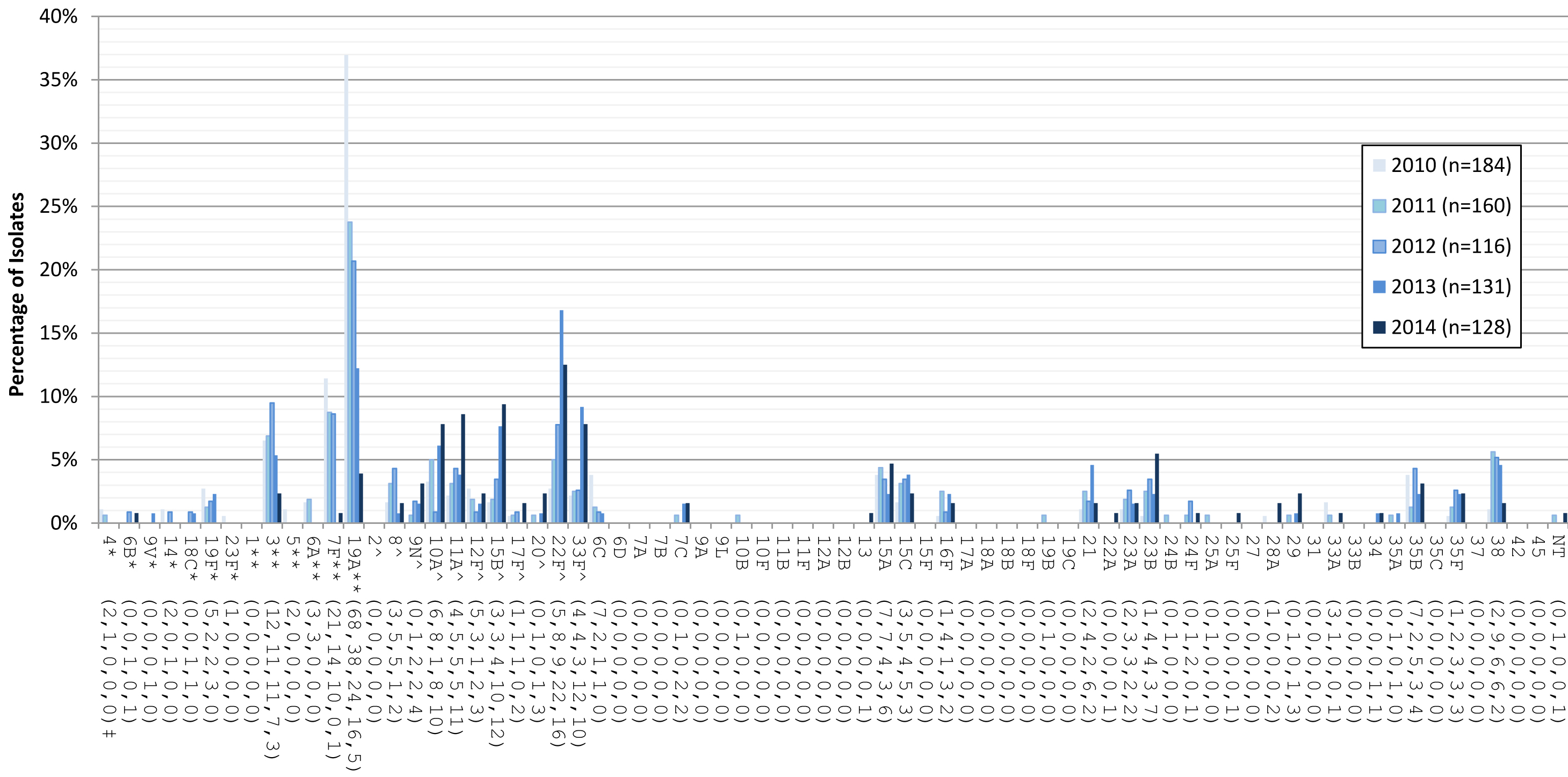
*Component of PCV7; ** Component of PCV13; ^ Component of PPV23; ‡ Number of isolates for 2010, 2011, 2012, 2013 and 2014, respectively.
Text Equivalent
| Serotype | 2010 (n=184) | 2011 (n=160) | 2012 (n=116) | 2013 (n=131) | 2014 (n=128) |
|---|---|---|---|---|---|
Table Figure 11 Footnotes
|
|||||
| 4Table Figure 11 Footnote 1 (2,1,0,0,0)Table Figure 11 Footnote 4 | 1.1% | 0.6% | 0.0% | 0.0% | 0.0% |
| 6BTable Figure 11 Footnote 1 (0,0,1,0,1) | 0.0% | 0.0% | 0.9% | 0.0% | 0.8% |
| 9VTable Figure 11 Footnote 1 (0,0,0,1,0) | 0.0% | 0.0% | 0.0% | 0.8% | 0.0% |
| 14Table Figure 11 Footnote 1 (2,0,1,0,0) | 1.1% | 0.0% | 0.9% | 0.0% | 0.0% |
| 18CTable Figure 11 Footnote 1 (0,0,1,1,0) | 0.0% | 0.0% | 0.9% | 0.8% | 0.0% |
| 19FTable Figure 11 Footnote 1 (5,2,2,3,0) | 2.7% | 1.3% | 1.7% | 2.3% | 0.0% |
| 23FTable Figure 11 Footnote 1 (1,0,0,0,0) | 0.5% | 0.0% | 0.0% | 0.0% | 0.0% |
| 1Table Figure 11 Footnote 2 (0,0,0,0,0) | 0.0% | 0.0% | 0.0% | 0.0% | 0.0% |
| 3Table Figure 11 Footnote 2 (12,11,11,7,3) | 6.5% | 6.9% | 9.5% | 5.3% | 2.3% |
| 5Table Figure 11 Footnote 2 (2,0,0,0,0) | 1.1% | 0.0% | 0.0% | 0.0% | 0.0% |
| 6ATable Figure 11 Footnote 2 (3,3,0,0,0) | 1.6% | 1.9% | 0.0% | 0.0% | 0.0% |
| 7FTable Figure 11 Footnote 2 (21,14,10,0,1) | 11.4% | 8.8% | 8.6% | 0.0% | 0.8% |
| 19ATable Figure 11 Footnote 2(68,38,24,16,5) | 37.0% | 23.8% | 20.7% | 12.2% | 3.9% |
| 2Table Figure 11 Footnote 3 (0,0,0,0,0) | 0.0% | 0.0% | 0.0% | 0.0% | 0.0% |
| 8Table Figure 11 Footnote 3 (3,5,5,1,2) | 1.6% | 3.1% | 4.3% | 0.8% | 1.6% |
| 9NTable Figure 11 Footnote 3 (0,1,2,2,4) | 0.0% | 0.6% | 1.7% | 1.5% | 3.1% |
| 10ATable Figure 11 Footnote 3 (6,8,1,8,10) | 3.3% | 5.0% | 0.9% | 6.1% | 7.8% |
| 11ATable Figure 11 Footnote 3 (4,5,5,5,11) | 2.2% | 3.1% | 4.3% | 3.8% | 8.6% |
| 12FTable Figure 11 Footnote 3 (5,3,1,2,3) | 2.7% | 1.9% | 0.9% | 1.5% | 2.3% |
| 15BTable Figure 11 Footnote 3 (3,3,4,10,12) | 1.6% | 1.9% | 3.4% | 7.6% | 9.4% |
| 17FTable Figure 11 Footnote 3 (1,1,1,0,2) | 0.5% | 0.6% | 0.9% | 0.0% | 1.6% |
| 20Table Figure 11 Footnote 3 (0,1,0,1,3) | 0.0% | 0.6% | 0.0% | 0.8% | 2.3% |
| 22FTable Figure 11 Footnote 3 (5,8,9,22,16) | 2.7% | 5.0% | 7.8% | 16.8% | 12.5% |
| 33FTable Figure 11 Footnote 3 (4,4,3,12,10) | 2.2% | 2.5% | 2.6% | 9.2% | 7.8% |
| 6C (7,2,1,1,0) | 3.8% | 1.3% | 0.9% | 0.8% | 0.0% |
| 6D (0,0,0,0,0) | 0.0% | 0.0% | 0.0% | 0.0% | 0.0% |
| 7A (0,0,0,0,0) | 0.0% | 0.0% | 0.0% | 0.0% | 0.0% |
| 7B (0,0,0,0,0) | 0.0% | 0.0% | 0.0% | 0.0% | 0.0% |
| 7C (0,1,0,2,2) | 0.0% | 0.6% | 0.0% | 1.5% | 1.6% |
| 9A (0,0,0,0,0) | 0.0% | 0.0% | 0.0% | 0.0% | 0.0% |
| 9L (0,0,0,0,0) | 0.0% | 0.0% | 0.0% | 0.0% | 0.0% |
| 10B (0,1,0,0,0) | 0.0% | 0.6% | 0.0% | 0.0% | 0.0% |
| 10F (0,0,0,0,0) | 0.0% | 0.0% | 0.0% | 0.0% | 0.0% |
| 11B (0,0,0,0,0) | 0.0% | 0.0% | 0.0% | 0.0% | 0.0% |
| 11F (0,0,0,0,0) | 0.0% | 0.0% | 0.0% | 0.0% | 0.0% |
| 12A (0,0,0,0,0) | 0.0% | 0.0% | 0.0% | 0.0% | 0.0% |
| 12B (0,0,0,0,0) | 0.0% | 0.0% | 0.0% | 0.0% | 0.0% |
| 13 (0,0,0,0,1) | 0.0% | 0.0% | 0.0% | 0.0% | 0.8% |
| 15A (7,7,4,3,6) | 3.8% | 4.4% | 3.4% | 2.3% | 4.7% |
| 15C (3,5,4,5,3) | 1.6% | 3.1% | 3.4% | 3.8% | 2.3% |
| 15F (0,0,0,0,0) | 0.0% | 0.0% | 0.0% | 0.0% | 0.0% |
| 16F (1,4,1,3,2) | 0.5% | 2.5% | 0.9% | 2.3% | 1.6% |
| 17A (0,0,0,0,0) | 0.0% | 0.0% | 0.0% | 0.0% | 0.0% |
| 18A (0,0,0,0,0) | 0.0% | 0.0% | 0.0% | 0.0% | 0.0% |
| 18B (0,0,0,0,0) | 0.0% | 0.0% | 0.0% | 0.0% | 0.0% |
| 18F (0,0,0,0,0) | 0.0% | 0.0% | 0.0% | 0.0% | 0.0% |
| 19B (0,1,0,0,0) | 0.0% | 0.6% | 0.0% | 0.0% | 0.0% |
| 19C (0,0,0,0,0) | 0.0% | 0.0% | 0.0% | 0.0% | 0.0% |
| 21 (2,4,2,6,2) | 1.1% | 2.5% | 1.7% | 4.6% | 1.6% |
| 22A (0,0,0,0,1) | 0.0% | 0.0% | 0.0% | 0.0% | 0.8% |
| 23A (2,3,3,2,2) | 1.1% | 1.9% | 2.6% | 1.5% | 1.6% |
| 23B (1,4,4,3,7) | 0.5% | 2.5% | 3.4% | 2.3% | 5.5% |
| 24B (0,1,0,0,0) | 0.0% | 0.6% | 0.0% | 0.0% | 0.0% |
| 24F (0,1,2,0,1) | 0.0% | 0.6% | 1.7% | 0.0% | 0.8% |
| 25A (0,1,0,0,0) | 0.0% | 0.6% | 0.0% | 0.0% | 0.0% |
| 25F (0,0,0,0,1) | 0.0% | 0.0% | 0.0% | 0.0% | 0.8% |
| 27 (0,0,0,0,0) | 0.0% | 0.0% | 0.0% | 0.0% | 0.0% |
| 28A (1,0,0,0,2) | 0.5% | 0.0% | 0.0% | 0.0% | 1.6% |
| 29 (0,1,0,1,3) | 0.0% | 0.6% | 0.0% | 0.8% | 2.3% |
| 31 (0,0,0,0,0) | 0.0% | 0.0% | 0.0% | 0.0% | 0.0% |
| 33A (3,1,0,0,1) | 1.6% | 0.6% | 0.0% | 0.0% | 0.8% |
| 33B (0,0,0,0,0) | 0.0% | 0.0% | 0.0% | 0.0% | 0.0% |
| 34 (0,0,0,1,1) | 0.0% | 0.0% | 0.0% | 0.8% | 0.8% |
| 35A (0,1,0,1,0) | 0.0% | 0.6% | 0.0% | 0.8% | 0.0% |
| 35B (7,2,5,3,4) | 3.8% | 1.3% | 4.3% | 2.3% | 3.1% |
| 35C (0,0,0,0,0) | 0.0% | 0.0% | 0.0% | 0.0% | 0.0% |
| 35F (1,2,3,3,3) | 0.5% | 1.3% | 2.6% | 2.3% | 2.3% |
| 37 (0,0,0,0,0) | 0.0% | 0.0% | 0.0% | 0.0% | 0.0% |
| 38 (2,9,6,6,2) | 1.1% | 5.6% | 5.2% | 4.6% | 1.6% |
| 42 (0,0,0,0,0) | 0.0% | 0.0% | 0.0% | 0.0% | 0.0% |
| 45 (0,0,0,0,0) | 0.0% | 0.0% | 0.0% | 0.0% | 0.0% |
| NT (0,1,0,0,1) | 0.0% | 0.6% | 0.0% | 0.0% | 0.8% |
Figure 12. Invasive S. pneumoniae serotypes in 2-4 year olds, 2010 – 2014
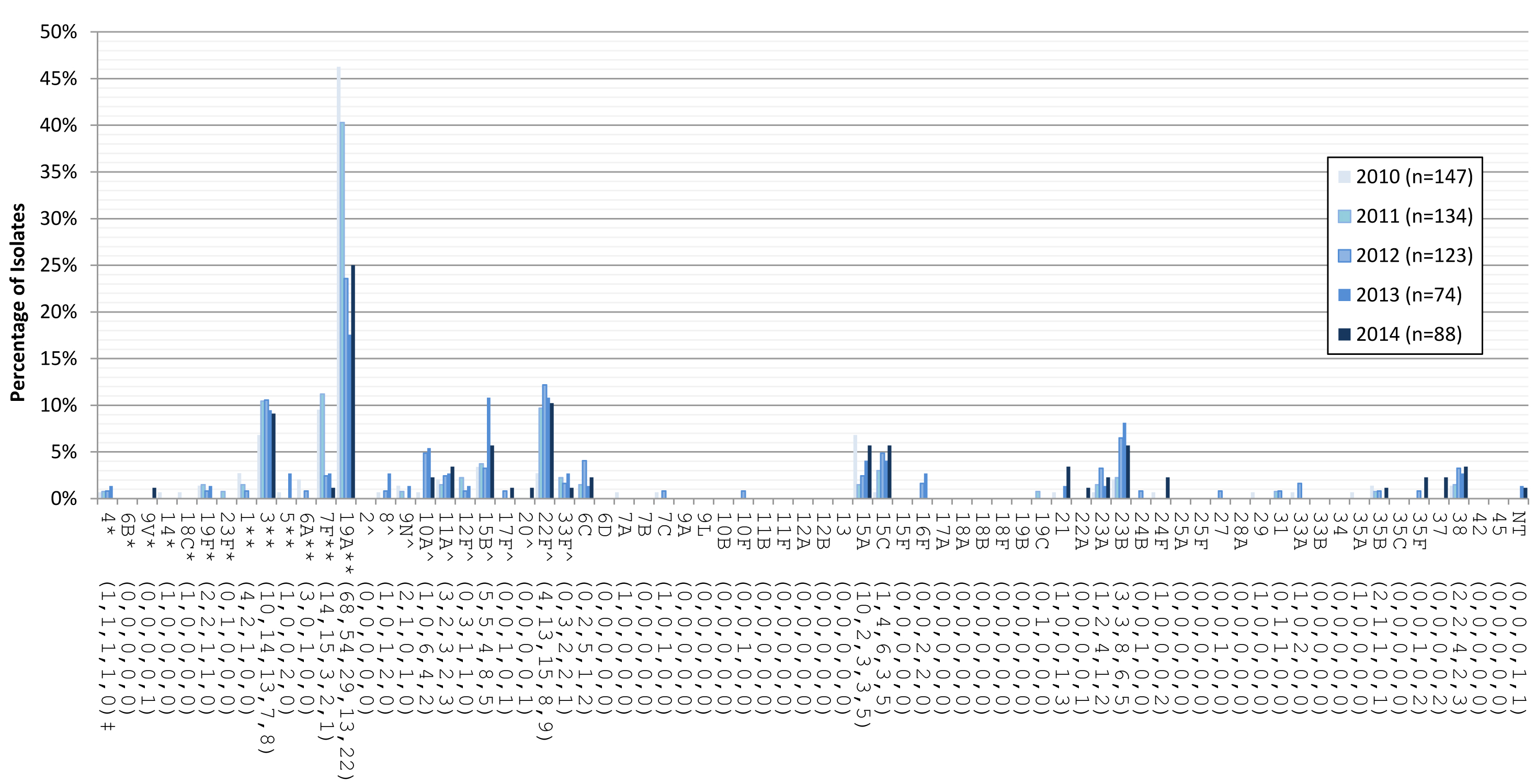
*Component of PCV7; ** Component of PCV13; ^ Component of PPV23; ‡ Number of isolates for 2010, 2011, 2012, 2013 and 2014, respectively.
Text Equivalent
| Serotype | 2010 (n=147) | 2011 (n=134) | 2012 (n=123) | 2013 (n=74) | 2014 (n=88) |
|---|---|---|---|---|---|
Table Figure 12 Footnotes
|
|||||
| 4Table Figure 12 Footnote 1 (1,1,1,1,0)Table Figure 12 Footnote 4 | 0.7% | 0.7% | 0.8% | 1.4% | 0.0% |
| 6BTable Figure 12 Footnote 1 (0,0,0,0,0) | 0.0% | 0.0% | 0.0% | 0.0% | 0.0% |
| 9VTable Figure 12 Footnote 1 (0,0,0,0,1) | 0.0% | 0.0% | 0.0% | 0.0% | 1.1% |
| 14Table Figure 12 Footnote 1 (1,0,0,0,0) | 0.7% | 0.0% | 0.0% | 0.0% | 0.0% |
| 18CTable Figure 12 Footnote 1 (1,0,0,0,0) | 0.7% | 0.0% | 0.0% | 0.0% | 0.0% |
| 19FTable Figure 12 Footnote 1 (2,2,1,1,0) | 1.4% | 1.5% | 0.8% | 1.4% | 0.0% |
| 23FTable Figure 12 Footnote 1 (0,1,0,0,0) | 0.0% | 0.7% | 0.0% | 0.0% | 0.0% |
| 1Table Figure 12 Footnote 2 (4,2,1,0,0) | 2.7% | 1.5% | 0.8% | 0.0% | 0.0% |
| 3Table Figure 12 Footnote 2 (10,14,13,7,8) | 6.8% | 10.4% | 10.6% | 9.5% | 9.1% |
| 5Table Figure 12 Footnote 2 (1,0,0,2,0) | 0.7% | 0.0% | 0.0% | 2.7% | 0.0% |
| 6ATable Figure 12 Footnote 2 (3,0,1,0,0) | 2.0% | 0.0% | 0.8% | 0.0% | 0.0% |
| 7FTable Figure 12 Footnote 2 (14,15,3,2,1) | 9.5% | 11.2% | 2.4% | 2.7% | 1.1% |
| 19ATable Figure 12 Footnote 2(68,54,29,13,22) | 46.3% | 40.3% | 23.6% | 17.6% | 25.0% |
| 2Table Figure 12 Footnote 3 (0,0,0,0,0) | 0.0% | 0.0% | 0.0% | 0.0% | 0.0% |
| 8Table Figure 12 Footnote 3 (1,0,1,2,0) | 0.7% | 0.0% | 0.8% | 2.7% | 0.0% |
| 9NTable Figure 12 Footnote 3 (2,1,0,1,0) | 1.4% | 0.7% | 0.0% | 1.4% | 0.0% |
| 10ATable Figure 12 Footnote 3 (1,0,6,4,2) | 0.7% | 0.0% | 4.9% | 5.4% | 2.3% |
| 11ATable Figure 12 Footnote 3 (3,2,3,2,3) | 2.0% | 1.5% | 2.4% | 2.7% | 3.4% |
| 12FTable Figure 12 Footnote 3 (0,3,1,1,0) | 0.0% | 2.2% | 0.8% | 1.4% | 0.0% |
| 15BTable Figure 12 Footnote 3 (5,5,4,8,5) | 3.4% | 3.7% | 3.3% | 10.8% | 5.7% |
| 17FTable Figure 12 Footnote 3 (0,0,1,0,1) | 0.0% | 0.0% | 0.8% | 0.0% | 1.1% |
| 20Table Figure 12 Footnote 3 (0,0,0,0,1) | 0.0% | 0.0% | 0.0% | 0.0% | 1.1% |
| 22FTable Figure 12 Footnote 3 (4,13,15,8,9) | 2.7% | 9.7% | 12.2% | 10.8% | 10.2% |
| 33FTable Figure 12 Footnote 3 (0,3,2,2,1) | 0.0% | 2.2% | 1.6% | 2.7% | 1.1% |
| 6C (0,2,5,1,2) | 0.0% | 1.5% | 4.1% | 1.4% | 2.3% |
| 6D (0,0,0,0,0) | 0.0% | 0.0% | 0.0% | 0.0% | 0.0% |
| 7A (1,0,0,0,0) | 0.7% | 0.0% | 0.0% | 0.0% | 0.0% |
| 7B (0,0,0,0,0) | 0.0% | 0.0% | 0.0% | 0.0% | 0.0% |
| 7C (1,0,1,0,0) | 0.7% | 0.0% | 0.8% | 0.0% | 0.0% |
| 9A (0,0,0,0,0) | 0.0% | 0.0% | 0.0% | 0.0% | 0.0% |
| 9L (0,0,0,0,0) | 0.0% | 0.0% | 0.0% | 0.0% | 0.0% |
| 10B (0,0,0,0,0) | 0.0% | 0.0% | 0.0% | 0.0% | 0.0% |
| 10F (0,0,1,0,0) | 0.0% | 0.0% | 0.8% | 0.0% | 0.0% |
| 11B (0,0,0,0,0) | 0.0% | 0.0% | 0.0% | 0.0% | 0.0% |
| 11F (0,0,0,0,0) | 0.0% | 0.0% | 0.0% | 0.0% | 0.0% |
| 12A (0,0,0,0,0) | 0.0% | 0.0% | 0.0% | 0.0% | 0.0% |
| 12B (0,0,0,0,0) | 0.0% | 0.0% | 0.0% | 0.0% | 0.0% |
| 13 (0,0,0,0,0) | 0.0% | 0.0% | 0.0% | 0.0% | 0.0% |
| 15A (10,2,3,3,5) | 6.8% | 1.5% | 2.4% | 4.1% | 5.7% |
| 15C (1,4,6,3,5) | 0.7% | 3.0% | 4.9% | 4.1% | 5.7% |
| 15F (0,0,0,0,0) | 0.0% | 0.0% | 0.0% | 0.0% | 0.0% |
| 16F (0,0,2,2,0) | 0.0% | 0.0% | 1.6% | 2.7% | 0.0% |
| 17A (0,0,0,0,0) | 0.0% | 0.0% | 0.0% | 0.0% | 0.0% |
| 18A (0,0,0,0,0) | 0.0% | 0.0% | 0.0% | 0.0% | 0.0% |
| 18B (0,0,0,0,0) | 0.0% | 0.0% | 0.0% | 0.0% | 0.0% |
| 18F (0,0,0,0,0) | 0.0% | 0.0% | 0.0% | 0.0% | 0.0% |
| 19B (0,0,0,0,0) | 0.0% | 0.0% | 0.0% | 0.0% | 0.0% |
| 19C (0,1,0,0,0) | 0.0% | 0.7% | 0.0% | 0.0% | 0.0% |
| 21 (1,0,0,1,3) | 0.7% | 0.0% | 0.0% | 1.4% | 3.4% |
| 22A (0,0,0,0,1) | 0.0% | 0.0% | 0.0% | 0.0% | 1.1% |
| 23A (1,2,4,1,2) | 0.7% | 1.5% | 3.3% | 1.4% | 2.3% |
| 23B (3,3,8,6,5) | 2.0% | 2.2% | 6.5% | 8.1% | 5.7% |
| 24B (0,0,1,0,0) | 0.0% | 0.0% | 0.8% | 0.0% | 0.0% |
| 24F (1,0,0,0,2) | 0.7% | 0.0% | 0.0% | 0.0% | 2.3% |
| 25A (0,0,0,0,0) | 0.0% | 0.0% | 0.0% | 0.0% | 0.0% |
| 25F (0,0,0,0,0) | 0.0% | 0.0% | 0.0% | 0.0% | 0.0% |
| 27 (0,0,1,0,0) | 0.0% | 0.0% | 0.8% | 0.0% | 0.0% |
| 28A (0,0,0,0,0) | 0.0% | 0.0% | 0.0% | 0.0% | 0.0% |
| 29 (1,0,0,0,0) | 0.7% | 0.0% | 0.0% | 0.0% | 0.0% |
| 31 (0,1,1,0,0) | 0.0% | 0.7% | 0.8% | 0.0% | 0.0% |
| 33A (1,0,2,0,0) | 0.7% | 0.0% | 1.6% | 0.0% | 0.0% |
| 33B (0,0,0,0,0) | 0.0% | 0.0% | 0.0% | 0.0% | 0.0% |
| 34 (0,0,0,0,0) | 0.0% | 0.0% | 0.0% | 0.0% | 0.0% |
| 35A (1,0,0,0,0) | 0.7% | 0.0% | 0.0% | 0.0% | 0.0% |
| 35B (2,1,1,0,1) | 1.4% | 0.7% | 0.8% | 0.0% | 1.1% |
| 35C (0,0,0,0,0) | 0.0% | 0.0% | 0.0% | 0.0% | 0.0% |
| 35F (0,0,1,0,2) | 0.0% | 0.0% | 0.8% | 0.0% | 2.3% |
| 37 (0,0,0,0,2) | 0.0% | 0.0% | 0.0% | 0.0% | 2.3% |
| 38 (2,2,4,2,3) | 1.4% | 1.5% | 3.3% | 2.7% | 3.4% |
| 42 (0,0,0,0,0) | 0.0% | 0.0% | 0.0% | 0.0% | 0.0% |
| 45 (0,0,0,0,0) | 0.0% | 0.0% | 0.0% | 0.0% | 0.0% |
| NT (0,0,0,1,1) | 0.0% | 0.0% | 0.0% | 1.4% | 1.1% |
Figure 13. Invasive S. pneumoniae serotypes in 5-14 year olds, 2010 - 2014
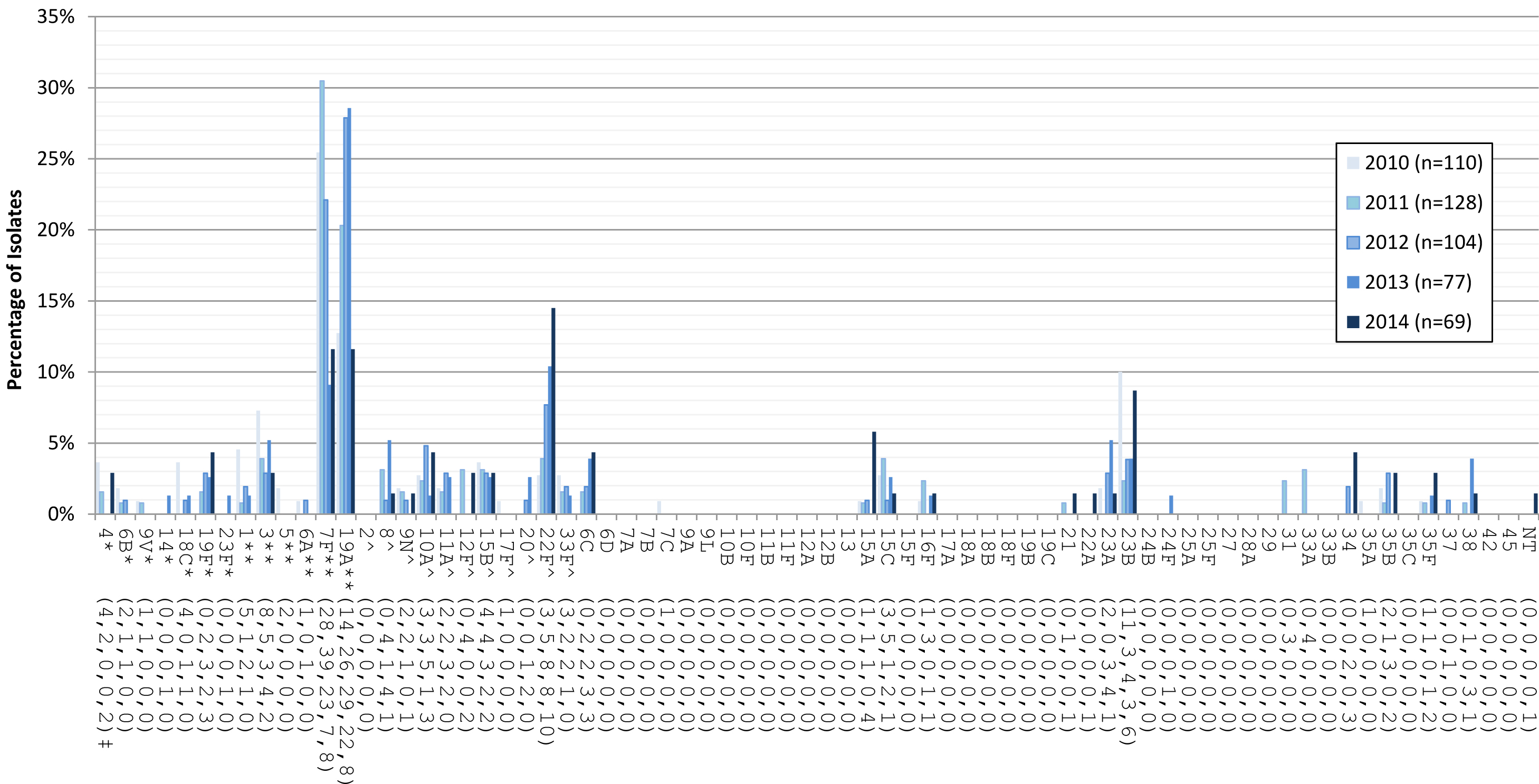
*Component of PCV7; ** Component of PCV13; ^ Component of PPV23; ‡ Number of isolates for 2010, 2011, 2012, 2013 and 2014, respectively.
Text Equivalent
| Serotype | 2010 (n=110) | 2011 (n=128) | 2012 (n=104) | 2013 (n=77) | 2014 (n=69) |
Table Figure 13 Footnotes
|
|||||
| 4Table figure 13 Footnote 1 (4,2,0,0,2)Table figure 13 Footnote 4 | 3.6% | 1.6% | 0.0% | 0.0% | 2.9% |
| 6BTable figure 13 Footnote 1 (2,1,1,0,0) | 1.8% | 0.8% | 1.0% | 0.0% | 0.0% |
| 9VTable figure 13 Footnote 1 (1,1,0,0,0) | 0.9% | 0.8% | 0.0% | 0.0% | 0.0% |
| 14Table figure 13 Footnote 1 (0,0,0,1,0) | 0.0% | 0.0% | 0.0% | 1.3% | 0.0% |
| 18CTable figure 13 Footnote 1 (4,0,1,1,0) | 3.6% | 0.0% | 1.0% | 1.3% | 0.0% |
| 19FTable figure 13 Footnote 1 (0,2,3,2,3) | 0.0% | 1.6% | 2.9% | 2.6% | 4.3% |
| 23FTable figure 13 Footnote 1 (0,0,0,1,0) | 0.0% | 0.0% | 0.0% | 1.3% | 0.0% |
| 1Table figure 13 Footnote 2 (5,1,2,1,0) | 4.5% | 0.8% | 1.9% | 1.3% | 0.0% |
| 3Table figure 13 Footnote 2 (8,5,3,4,2) | 7.3% | 3.9% | 2.9% | 5.2% | 2.9% |
| 5Table figure 13 Footnote 2 (2,0,0,0,0) | 1.8% | 0.0% | 0.0% | 0.0% | 0.0% |
| 6ATable figure 13 Footnote 2 (1,0,1,0,0) | 0.9% | 0.0% | 1.0% | 0.0% | 0.0% |
| 7FTable figure 13 Footnote 2 (28,39,23,7,8) | 25.5% | 30.5% | 22.1% | 9.1% | 11.6% |
| 19ATable figure 13 Footnote 2(14,26,29,22,8) | 12.7% | 20.3% | 27.9% | 28.6% | 11.6% |
| 2Table figure 13 Footnote 3 (0,0,0,0,0) | 0.0% | 0.0% | 0.0% | 0.0% | 0.0% |
| 8Table figure 13 Footnote 3 (0,4,1,4,1) | 0.0% | 3.1% | 1.0% | 5.2% | 1.4% |
| 9NTable figure 13 Footnote 3 (2,2,1,0,1) | 1.8% | 1.6% | 1.0% | 0.0% | 1.4% |
| 10ATable figure 13 Footnote 3 (3,3,5,1,3) | 2.7% | 2.3% | 4.8% | 1.3% | 4.3% |
| 11ATable figure 13 Footnote 3 (2,2,3,2,0) | 1.8% | 1.6% | 2.9% | 2.6% | 0.0% |
| 12FTable figure 13 Footnote 3 (0,4,0,0,2) | 0.0% | 3.1% | 0.0% | 0.0% | 2.9% |
| 15BTable figure 13 Footnote 3 (4,4,3,2,2) | 3.6% | 3.1% | 2.9% | 2.6% | 2.9% |
| 17FTable figure 13 Footnote 3 (1,0,0,0,0) | 0.9% | 0.0% | 0.0% | 0.0% | 0.0% |
| 20Table figure 13 Footnote 3 (0,0,1,2,0) | 0.0% | 0.0% | 1.0% | 2.6% | 0.0% |
| 22FTable figure 13 Footnote 3 (3,5,8,8,10) | 2.7% | 3.9% | 7.7% | 10.4% | 14.5% |
| 33FTable figure 13 Footnote 3 (3,2,2,1,0) | 2.7% | 1.6% | 1.9% | 1.3% | 0.0% |
| 6C (0,2,2,3,3) | 0.0% | 1.6% | 1.9% | 3.9% | 4.3% |
| 6D (0,0,0,0,0) | 0.0% | 0.0% | 0.0% | 0.0% | 0.0% |
| 7A (0,0,0,0,0) | 0.0% | 0.0% | 0.0% | 0.0% | 0.0% |
| 7B (0,0,0,0,0) | 0.0% | 0.0% | 0.0% | 0.0% | 0.0% |
| 7C (1,0,0,0,0) | 0.9% | 0.0% | 0.0% | 0.0% | 0.0% |
| 9A (0,0,0,0,0) | 0.0% | 0.0% | 0.0% | 0.0% | 0.0% |
| 9L (0,0,0,0,0) | 0.0% | 0.0% | 0.0% | 0.0% | 0.0% |
| 10B (0,0,0,0,0) | 0.0% | 0.0% | 0.0% | 0.0% | 0.0% |
| 10F (0,0,0,0,0) | 0.0% | 0.0% | 0.0% | 0.0% | 0.0% |
| 11B (0,0,0,0,0) | 0.0% | 0.0% | 0.0% | 0.0% | 0.0% |
| 11F (0,0,0,0,0) | 0.0% | 0.0% | 0.0% | 0.0% | 0.0% |
| 12A (0,0,0,0,0) | 0.0% | 0.0% | 0.0% | 0.0% | 0.0% |
| 12B (0,0,0,0,0) | 0.0% | 0.0% | 0.0% | 0.0% | 0.0% |
| 13 (0,0,0,0,0) | 0.0% | 0.0% | 0.0% | 0.0% | 0.0% |
| 15A (1,1,1,0,4) | 0.9% | 0.8% | 1.0% | 0.0% | 5.8% |
| 15C (3,5,1,2,1) | 2.7% | 3.9% | 1.0% | 2.6% | 1.4% |
| 15F (0,0,0,0,0) | 0.0% | 0.0% | 0.0% | 0.0% | 0.0% |
| 16F (1,3,0,1,1) | 0.9% | 2.3% | 0.0% | 1.3% | 1.4% |
| 17A (0,0,0,0,0) | 0.0% | 0.0% | 0.0% | 0.0% | 0.0% |
| 18A (0,0,0,0,0) | 0.0% | 0.0% | 0.0% | 0.0% | 0.0% |
| 18B (0,0,0,0,0) | 0.0% | 0.0% | 0.0% | 0.0% | 0.0% |
| 18F (0,0,0,0,0) | 0.0% | 0.0% | 0.0% | 0.0% | 0.0% |
| 19B (0,0,0,0,0) | 0.0% | 0.0% | 0.0% | 0.0% | 0.0% |
| 19C (0,0,0,0,0) | 0.0% | 0.0% | 0.0% | 0.0% | 0.0% |
| 21 (0,1,0,0,1) | 0.0% | 0.8% | 0.0% | 0.0% | 1.4% |
| 22A (0,0,0,0,1) | 0.0% | 0.0% | 0.0% | 0.0% | 1.4% |
| 23A (2,0,3,4,1) | 1.8% | 0.0% | 2.9% | 5.2% | 1.4% |
| 23B (11,3,4,3,6) | 10.0% | 2.3% | 3.8% | 3.9% | 8.7% |
| 24B (0,0,0,0,0) | 0.0% | 0.0% | 0.0% | 0.0% | 0.0% |
| 24F (0,0,0,1,0) | 0.0% | 0.0% | 0.0% | 1.3% | 0.0% |
| 25A (0,0,0,0,0) | 0.0% | 0.0% | 0.0% | 0.0% | 0.0% |
| 25F (0,0,0,0,0) | 0.0% | 0.0% | 0.0% | 0.0% | 0.0% |
| 27 (0,0,0,0,0) | 0.0% | 0.0% | 0.0% | 0.0% | 0.0% |
| 28A (0,0,0,0,0) | 0.0% | 0.0% | 0.0% | 0.0% | 0.0% |
| 29 (0,0,0,0,0) | 0.0% | 0.0% | 0.0% | 0.0% | 0.0% |
| 31 (0,3,0,0,0) | 0.0% | 2.3% | 0.0% | 0.0% | 0.0% |
| 33A (0,4,0,0,0) | 0.0% | 3.1% | 0.0% | 0.0% | 0.0% |
| 33B (0,0,0,0,0) | 0.0% | 0.0% | 0.0% | 0.0% | 0.0% |
| 34 (0,0,2,0,3) | 0.0% | 0.0% | 1.9% | 0.0% | 4.3% |
| 35A (1,0,0,0,0) | 0.9% | 0.0% | 0.0% | 0.0% | 0.0% |
| 35B (2,1,3,0,2) | 1.8% | 0.8% | 2.9% | 0.0% | 2.9% |
| 35C (0,0,0,0,0) | 0.0% | 0.0% | 0.0% | 0.0% | 0.0% |
| 35F (1,1,0,1,2) | 0.9% | 0.8% | 0.0% | 1.3% | 2.9% |
| 37 (0,0,1,0,0) | 0.0% | 0.0% | 1.0% | 0.0% | 0.0% |
| 38 (0,1,0,3,1) | 0.0% | 0.8% | 0.0% | 3.9% | 1.4% |
| 42 (0,0,0,0,0) | 0.0% | 0.0% | 0.0% | 0.0% | 0.0% |
| 45 (0,0,0,0,0) | 0.0% | 0.0% | 0.0% | 0.0% | 0.0% |
| NT (0,0,0,0,1) | 0.0% | 0.0% | 0.0% | 0.0% | 1.4% |
Figure 14. Invasive S. pneumoniae serotypes in 15-49 year olds, 2010 - 2014
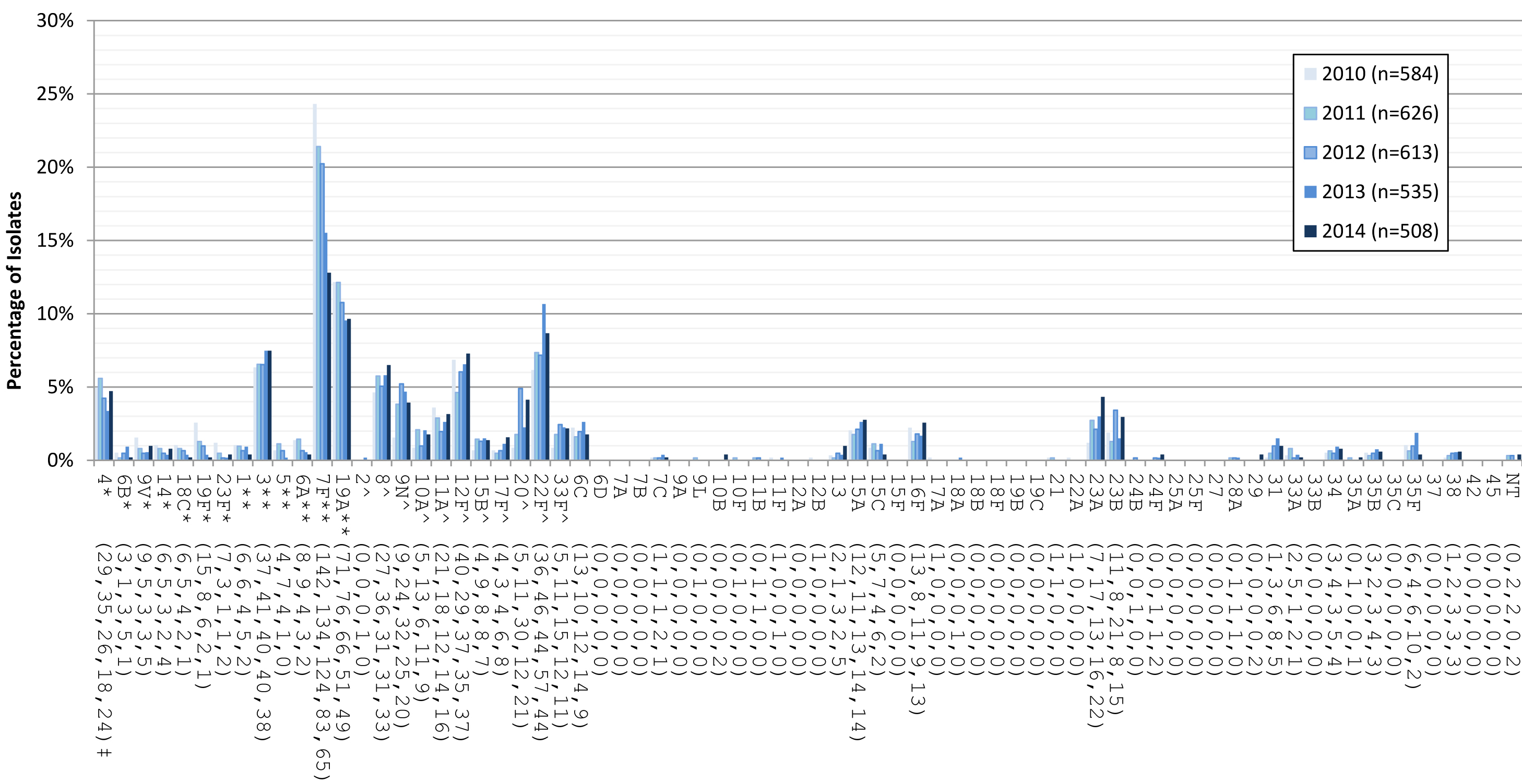
*Component of PCV7; ** Component of PCV13; ^ Component of PPV23; ‡ Number of isolates for 2010, 2011, 2012, 2013 and 2014, respectively.
Text Equivalent
| Serotype | 2010 (n=584) | 2011 (n=626) | 2012 (n=613) | 2013 (n=535) | 2014 (n=508) |
Table Figure 14 Footnotes
|
|||||
| 4Table figure 14 Footnote 1 (29,35,26,18,24)Table figure 14 Footnote 4 | 5.0% | 5.6% | 4.2% | 3.4% | 4.7% |
| 6BTable figure 14 Footnote 1 (3,1,3,5,1) | 0.5% | 0.2% | 0.5% | 0.9% | 0.2% |
| 9VTable figure 14 Footnote 1 (9,5,3,3,5) | 1.5% | 0.8% | 0.5% | 0.6% | 1.0% |
| 14Table figure 14 Footnote 1 (6,5,3,2,4) | 1.0% | 0.8% | 0.5% | 0.4% | 0.8% |
| 18CTable figure 14 Footnote 1 (6,5,4,2,1) | 1.0% | 0.8% | 0.7% | 0.4% | 0.2% |
| 19FTable figure 14 Footnote 1 (15,8,6,2,1) | 2.6% | 1.3% | 1.0% | 0.4% | 0.2% |
| 23FTable figure 14 Footnote 1 (7,3,1,1,2) | 1.2% | 0.5% | 0.2% | 0.2% | 0.4% |
| 1Table figure 14 Footnote 2 (6,6,4,5,2) | 1.0% | 1.0% | 0.7% | 0.9% | 0.4% |
| 3Table figure 14 Footnote 2 (37,41,40,40,38) | 6.3% | 6.5% | 6.5% | 7.5% | 7.5% |
| 5Table figure 14 Footnote 2 (4,7,4,1,0) | 0.7% | 1.1% | 0.7% | 0.2% | 0.0% |
| 6ATable figure 14 Footnote 2 (8,9,4,3,2) | 1.4% | 1.4% | 0.7% | 0.6% | 0.4% |
| 7FTable figure 14 Footnote 2 (142,134,124,83,65) | 24.3% | 21.4% | 20.2% | 15.5% | 12.8% |
| 19ATable figure 14 Footnote 2(71,76,66,51,49) | 12.2% | 12.1% | 10.8% | 9.5% | 9.6% |
| 2Table figure 14 Footnote 3 (0,0,0,1,0) | 0.0% | 0.0% | 0.0% | 0.2% | 0.0% |
| 8Table figure 14 Footnote 3 (27,36,31,31,33) | 4.6% | 5.8% | 5.1% | 5.8% | 6.5% |
| 9NTable figure 14 Footnote 3 (9,24,32,25,20) | 1.5% | 3.8% | 5.2% | 4.7% | 3.9% |
| 10ATable figure 14 Footnote 3 (5,13,6,11,9) | 0.9% | 2.1% | 1.0% | 2.1% | 1.8% |
| 11ATable figure 14 Footnote 3 (21,18,12,14,16) | 3.6% | 2.9% | 2.0% | 2.6% | 3.1% |
| 12FTable figure 14 Footnote 3 (40,29,37,35,37) | 6.8% | 4.6% | 6.0% | 6.5% | 7.3% |
| 15BTable figure 14 Footnote 3 (4,9,8,8,7) | 0.7% | 1.4% | 1.3% | 1.5% | 1.4% |
| 17FTable figure 14 Footnote 3 (4,3,4,6,8) | 0.7% | 0.5% | 0.7% | 1.1% | 1.6% |
| 20Table figure 14 Footnote 3 (5,11,30,12,21) | 0.9% | 1.8% | 4.9% | 2.2% | 4.1% |
| 22FTable figure 14 Footnote 3 (36,46,44,57,44) | 6.2% | 7.3% | 7.2% | 10.7% | 8.7% |
| 33FTable figure 14 Footnote 3 (5,11,15,12,11) | 0.9% | 1.8% | 2.4% | 2.2% | 2.2% |
| 6C (13,10,12,14,9) | 2.2% | 1.6% | 2.0% | 2.6% | 1.8% |
| 6D (0,0,0,0,0) | 0.0% | 0.0% | 0.0% | 0.0% | 0.0% |
| 7A (0,0,0,0,0) | 0.0% | 0.0% | 0.0% | 0.0% | 0.0% |
| 7B (0,0,0,0,0) | 0.0% | 0.0% | 0.0% | 0.0% | 0.0% |
| 7C (1,1,1,2,1) | 0.2% | 0.2% | 0.2% | 0.4% | 0.2% |
| 9A (0,0,0,0,0) | 0.0% | 0.0% | 0.0% | 0.0% | 0.0% |
| 9L (0,1,0,0,0) | 0.0% | 0.2% | 0.0% | 0.0% | 0.0% |
| 10B (0,0,0,0,2) | 0.0% | 0.0% | 0.0% | 0.0% | 0.4% |
| 10F (0,1,0,0,0) | 0.0% | 0.2% | 0.0% | 0.0% | 0.0% |
| 11B (0,1,1,0,0) | 0.0% | 0.2% | 0.2% | 0.0% | 0.0% |
| 11F (1,0,0,1,0) | 0.2% | 0.0% | 0.0% | 0.2% | 0.0% |
| 12A (0,0,0,0,0) | 0.0% | 0.0% | 0.0% | 0.0% | 0.0% |
| 12B (1,0,0,0,0) | 0.2% | 0.0% | 0.0% | 0.0% | 0.0% |
| 13 (2,1,3,2,5) | 0.3% | 0.2% | 0.5% | 0.4% | 1.0% |
| 15A (12,11,13,14,14) | 2.1% | 1.8% | 2.1% | 2.6% | 2.8% |
| 15C (5,7,4,6,2) | 0.9% | 1.1% | 0.7% | 1.1% | 0.4% |
| 15F (0,0,0,0,0) | 0.0% | 0.0% | 0.0% | 0.0% | 0.0% |
| 16F (13,8,11,9,13) | 2.2% | 1.3% | 1.8% | 1.7% | 2.6% |
| 17A (1,0,0,0,0) | 0.2% | 0.0% | 0.0% | 0.0% | 0.0% |
| 18A (0,0,0,1,0) | 0.0% | 0.0% | 0.0% | 0.2% | 0.0% |
| 18B (0,0,0,0,0) | 0.0% | 0.0% | 0.0% | 0.0% | 0.0% |
| 18F (0,0,0,0,0) | 0.0% | 0.0% | 0.0% | 0.0% | 0.0% |
| 19B (0,0,0,0,0) | 0.0% | 0.0% | 0.0% | 0.0% | 0.0% |
| 19C (0,0,0,0,0) | 0.0% | 0.0% | 0.0% | 0.0% | 0.0% |
| 21 (1,1,0,0,0) | 0.2% | 0.2% | 0.0% | 0.0% | 0.0% |
| 22A (1,0,0,0,0) | 0.2% | 0.0% | 0.0% | 0.0% | 0.0% |
| 23A (7,17,13,16,22) | 1.2% | 2.7% | 2.1% | 3.0% | 4.3% |
| 23B (11,8,21,8,15) | 1.9% | 1.3% | 3.4% | 1.5% | 3.0% |
| 24B (0,0,1,0,0) | 0.0% | 0.0% | 0.2% | 0.0% | 0.0% |
| 24F (0,0,1,1,2) | 0.0% | 0.0% | 0.2% | 0.2% | 0.4% |
| 25A (0,0,0,0,0) | 0.0% | 0.0% | 0.0% | 0.0% | 0.0% |
| 25F (0,0,0,0,0) | 0.0% | 0.0% | 0.0% | 0.0% | 0.0% |
| 27 (0,0,0,0,0) | 0.0% | 0.0% | 0.0% | 0.0% | 0.0% |
| 28A (0,1,1,1,0) | 0.0% | 0.2% | 0.2% | 0.2% | 0.0% |
| 29 (0,0,0,0,2) | 0.0% | 0.0% | 0.0% | 0.0% | 0.4% |
| 31 (1,3,6,8,5) | 0.2% | 0.5% | 1.0% | 1.5% | 1.0% |
| 33A (2,5,1,2,1) | 0.3% | 0.8% | 0.2% | 0.4% | 0.2% |
| 33B (0,0,0,0,0) | 0.0% | 0.0% | 0.0% | 0.0% | 0.0% |
| 34 (3,4,3,5,4) | 0.5% | 0.6% | 0.5% | 0.9% | 0.8% |
| 35A (0,1,0,0,1) | 0.0% | 0.2% | 0.0% | 0.0% | 0.2% |
| 35B (3,2,3,4,3) | 0.5% | 0.3% | 0.5% | 0.7% | 0.6% |
| 35C (0,0,0,0,0) | 0.0% | 0.0% | 0.0% | 0.0% | 0.0% |
| 35F (6,4,6,10,2) | 1.0% | 0.6% | 1.0% | 1.9% | 0.4% |
| 37 (0,0,0,0,0) | 0.0% | 0.0% | 0.0% | 0.0% | 0.0% |
| 38 (1,2,3,3,3) | 0.2% | 0.3% | 0.5% | 0.6% | 0.6% |
| 42 (0,0,0,0,0) | 0.0% | 0.0% | 0.0% | 0.0% | 0.0% |
| 45 (0,0,0,0,0) | 0.0% | 0.0% | 0.0% | 0.0% | 0.0% |
| NT (0,2,2,0,2) | 0.0% | 0.3% | 0.3% | 0.0% | 0.4% |
Figure 15. Invasive S. pneumoniae serotypes in 50-64 year olds, 2010 - 2014
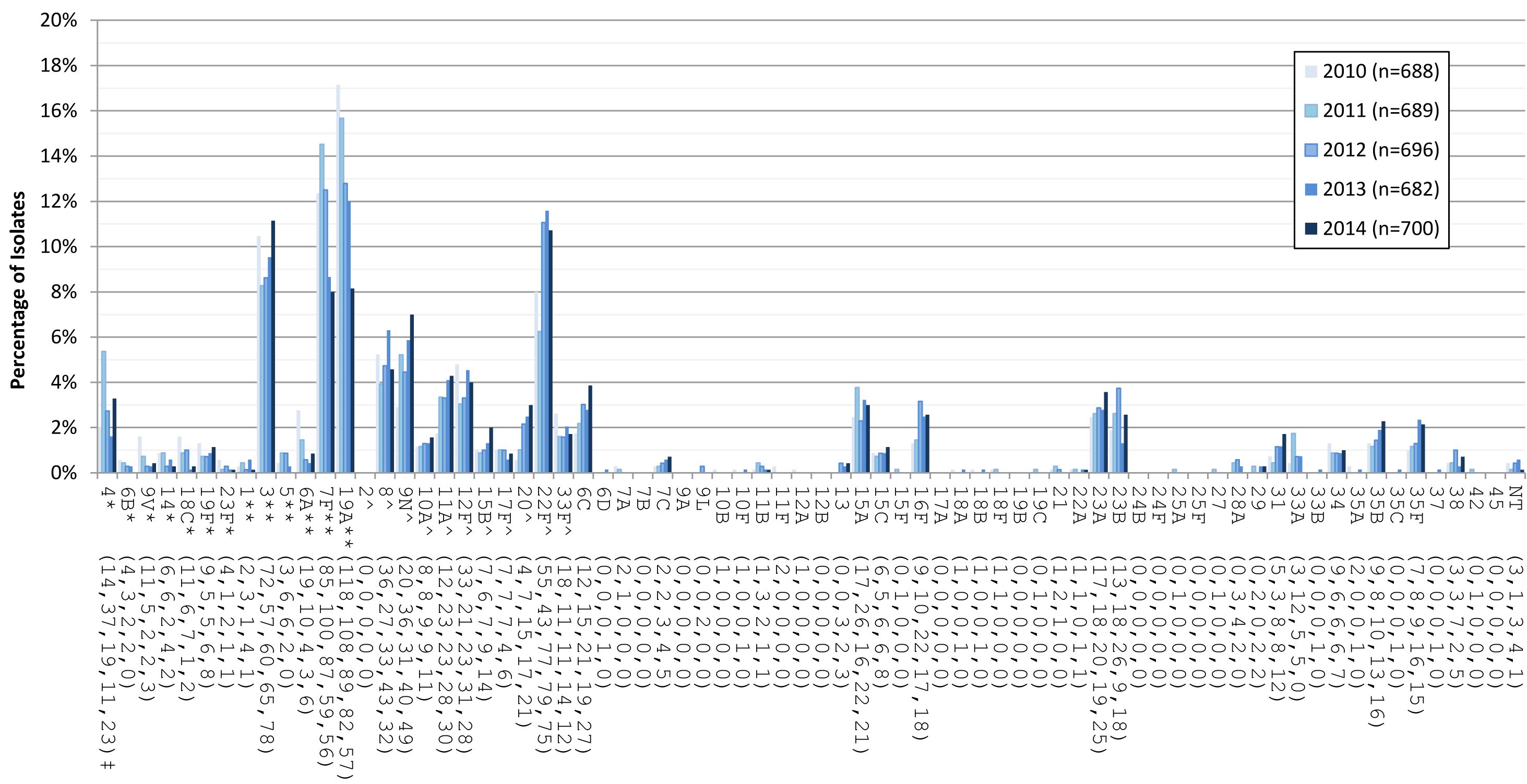
*Component of PCV7; ** Component of PCV13; ^ Component of PPV23; ‡ Number of isolates for 2010, 2011, 2012, 2013 and 2014, respectively
Text Equivalent
| Serotype | 2010 (n=688) | 2011 (n=689) | 2012 (n=696) | 2013 (n=682) | 2014 (n=700) |
|---|---|---|---|---|---|
Table Figure 15 Footnotes
|
|||||
| 4Table Figure 15 Footnote 1 (14,37,19,11,23)Table Figure 15 Footnote 4 | 2.0% | 5.4% | 2.7% | 1.6% | 3.3% |
| 6BTable Figure 15 Footnote 1 (4,3,2,2,0) | 0.6% | 0.4% | 0.3% | 0.3% | 0.0% |
| 9VTable Figure 15 Footnote 1 (11,5,2,2,3) | 1.6% | 0.7% | 0.3% | 0.3% | 0.4% |
| 14Table Figure 15 Footnote 1 (6,6,2,4,2) | 0.9% | 0.9% | 0.3% | 0.6% | 0.3% |
| 18CTable Figure 15 Footnote 1 (11,6,7,1,2) | 1.6% | 0.9% | 1.0% | 0.1% | 0.3% |
| 19FTable Figure 15 Footnote 1 (9,5,5,6,8) | 1.3% | 0.7% | 0.7% | 0.9% | 1.1% |
| 23FTable Figure 15 Footnote 1 (4,1,2,1,1) | 0.6% | 0.1% | 0.3% | 0.1% | 0.1% |
| 1Table Figure 15 Footnote 2 (2,3,1,4,1) | 0.3% | 0.4% | 0.1% | 0.6% | 0.1% |
| 3Table Figure 15 Footnote 2 (72,57,60,65,78) | 10.5% | 8.3% | 8.6% | 9.5% | 11.1% |
| 5Table Figure 15 Footnote 2 (3,6,6,2,0) | 0.4% | 0.9% | 0.9% | 0.3% | 0.0% |
| 6ATable Figure 15 Footnote 2 (19,10,4,3,6) | 2.8% | 1.5% | 0.6% | 0.4% | 0.9% |
| 7FTable Figure 15 Footnote 2 (85,100,87,59,56) | 12.4% | 14.5% | 12.5% | 8.7% | 8.0% |
| 19ATable Figure 15 Footnote 2(118,108,89,82,57) | 17.2% | 15.7% | 12.8% | 12.0% | 8.1% |
| 2Table Figure 15 Footnote 3 (0,0,0,0,0) | 0.0% | 0.0% | 0.0% | 0.0% | 0.0% |
| 8Table Figure 15 Footnote 3 (36,27,33,43,32) | 5.2% | 3.9% | 4.7% | 6.3% | 4.6% |
| 9NTable Figure 15 Footnote 3 (20,36,31,40,49) | 2.9% | 5.2% | 4.5% | 5.9% | 7.0% |
| 10ATable Figure 15 Footnote 3 (8,8,9,9,11) | 1.2% | 1.2% | 1.3% | 1.3% | 1.6% |
| 11ATable Figure 15 Footnote 3 (12,23,23,28,30) | 1.7% | 3.3% | 3.3% | 4.1% | 4.3% |
| 12FTable Figure 15 Footnote 3 (33,21,23,31,28) | 4.8% | 3.0% | 3.3% | 4.5% | 4.0% |
| 15BTable Figure 15 Footnote 3 (7,6,7,9,14) | 1.0% | 0.9% | 1.0% | 1.3% | 2.0% |
| 17FTable Figure 15 Footnote 3 (7,7,7,4,6) | 1.0% | 1.0% | 1.0% | 0.6% | 0.9% |
| 20Table Figure 15 Footnote 3 (4,7,15,17,21) | 0.6% | 1.0% | 2.2% | 2.5% | 3.0% |
| 22FTable Figure 15 Footnote 3 (55,43,77,79,75) | 8.0% | 6.2% | 11.1% | 11.6% | 10.7% |
| 33FTable Figure 15 Footnote 3 (18,11,11,14,12) | 2.6% | 1.6% | 1.6% | 2.1% | 1.7% |
| 6C (12,15,21,19,27) | 1.7% | 2.2% | 3.0% | 2.8% | 3.9% |
| 6D (0,0,0,1,0) | 0.0% | 0.0% | 0.0% | 0.1% | 0.0% |
| 7A (2,1,0,0,0) | 0.3% | 0.1% | 0.0% | 0.0% | 0.0% |
| 7B (0,0,0,0,0) | 0.0% | 0.0% | 0.0% | 0.0% | 0.0% |
| 7C (2,2,3,4,5) | 0.3% | 0.3% | 0.4% | 0.6% | 0.7% |
| 9A (0,0,0,0,0) | 0.0% | 0.0% | 0.0% | 0.0% | 0.0% |
| 9L (0,0,2,0,0) | 0.0% | 0.0% | 0.3% | 0.0% | 0.0% |
| 10B (1,0,0,0,0) | 0.1% | 0.0% | 0.0% | 0.0% | 0.0% |
| 10F (1,0,0,1,0) | 0.1% | 0.0% | 0.0% | 0.1% | 0.0% |
| 11B (1,3,2,1,1) | 0.1% | 0.4% | 0.3% | 0.1% | 0.1% |
| 11F (2,0,0,0,0) | 0.3% | 0.0% | 0.0% | 0.0% | 0.0% |
| 12A (1,0,0,0,0) | 0.1% | 0.0% | 0.0% | 0.0% | 0.0% |
| 12B (0,0,0,0,0) | 0.0% | 0.0% | 0.0% | 0.0% | 0.0% |
| 13 (0,0,3,2,3) | 0.0% | 0.0% | 0.4% | 0.3% | 0.4% |
| 15A (17,26,16,22,21) | 2.5% | 3.8% | 2.3% | 3.2% | 3.0% |
| 15C (6,5,6,6,8) | 0.9% | 0.7% | 0.9% | 0.9% | 1.1% |
| 15F (0,1,0,0,0) | 0.0% | 0.1% | 0.0% | 0.0% | 0.0% |
| 16F (9,10,22,17,18) | 1.3% | 1.5% | 3.2% | 2.5% | 2.6% |
| 17A (0,0,0,0,0) | 0.0% | 0.0% | 0.0% | 0.0% | 0.0% |
| 18A (1,0,0,1,0) | 0.1% | 0.0% | 0.0% | 0.1% | 0.0% |
| 18B (1,0,0,1,0) | 0.1% | 0.0% | 0.0% | 0.1% | 0.0% |
| 18F (1,1,0,0,0) | 0.1% | 0.1% | 0.0% | 0.0% | 0.0% |
| 19B (0,0,0,0,0) | 0.0% | 0.0% | 0.0% | 0.0% | 0.0% |
| 19C (0,1,0,0,0) | 0.0% | 0.1% | 0.0% | 0.0% | 0.0% |
| 21 (1,2,1,0,0) | 0.1% | 0.3% | 0.1% | 0.0% | 0.0% |
| 22A (1,1,0,1,1) | 0.1% | 0.1% | 0.0% | 0.1% | 0.1% |
| 23A (17,18,20,19,25) | 2.5% | 2.6% | 2.9% | 2.8% | 3.6% |
| 23B (13,18,26,9,18) | 1.9% | 2.6% | 3.7% | 1.3% | 2.6% |
| 24B (0,0,0,0,0) | 0.0% | 0.0% | 0.0% | 0.0% | 0.0% |
| 24F (0,0,0,0,0) | 0.0% | 0.0% | 0.0% | 0.0% | 0.0% |
| 25A (0,1,0,0,0) | 0.0% | 0.1% | 0.0% | 0.0% | 0.0% |
| 25F (0,0,0,0,0) | 0.0% | 0.0% | 0.0% | 0.0% | 0.0% |
| 27 (0,1,0,0,0) | 0.0% | 0.1% | 0.0% | 0.0% | 0.0% |
| 28A (0,3,4,2,0) | 0.0% | 0.4% | 0.6% | 0.3% | 0.0% |
| 29 (0,2,0,2,2) | 0.0% | 0.3% | 0.0% | 0.3% | 0.3% |
| 31 (5,3,8,8,12) | 0.7% | 0.4% | 1.1% | 1.2% | 1.7% |
| 33A (3,12,5,5,0) | 0.4% | 1.7% | 0.7% | 0.7% | 0.0% |
| 33B (0,0,0,1,0) | 0.0% | 0.0% | 0.0% | 0.1% | 0.0% |
| 34 (9,6,6,6,7) | 1.3% | 0.9% | 0.9% | 0.9% | 1.0% |
| 35A (2,0,0,1,0) | 0.3% | 0.0% | 0.0% | 0.1% | 0.0% |
| 35B (9,8,10,13,16) | 1.3% | 1.2% | 1.4% | 1.9% | 2.3% |
| 35C (0,0,0,1,0) | 0.0% | 0.0% | 0.0% | 0.1% | 0.0% |
| 35F (7,8,9,16,15) | 1.0% | 1.2% | 1.3% | 2.3% | 2.1% |
| 37 (0,0,0,1,0) | 0.0% | 0.0% | 0.0% | 0.1% | 0.0% |
| 38 (3,3,7,2,5) | 0.4% | 0.4% | 1.0% | 0.3% | 0.7% |
| 42 (0,1,0,0,0) | 0.0% | 0.1% | 0.0% | 0.0% | 0.0% |
| 45 (0,0,0,0,0) | 0.0% | 0.0% | 0.0% | 0.0% | 0.0% |
| NT (3,1,3,4,1) | 0.4% | 0.1% | 0.4% | 0.6% | 0.1% |
Figure 16. Invasive S. pneumoniae serotypes in ≥65 year olds, 2010 - 2014
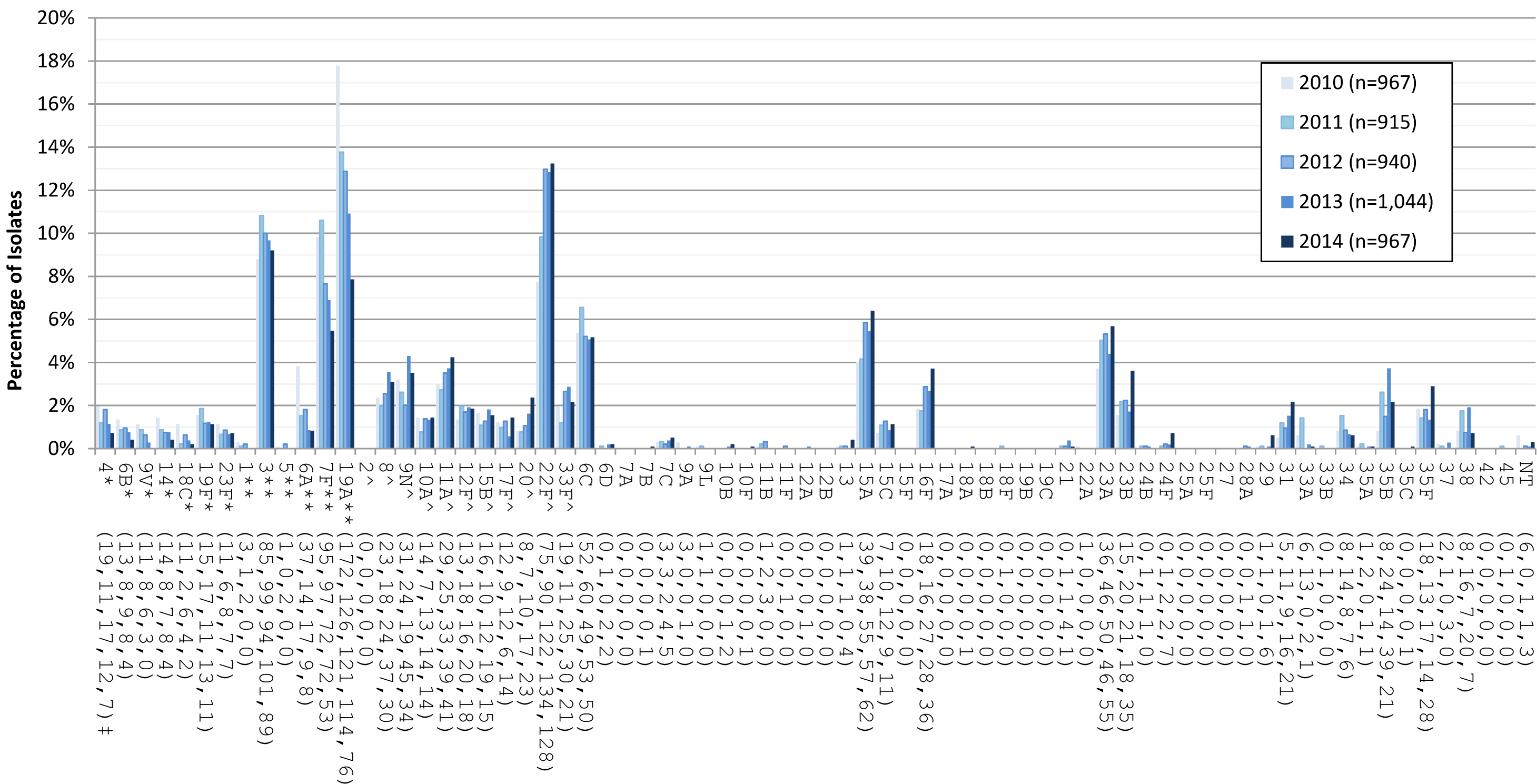
*Component of PCV7; ** Component of PCV13; ^ Component of PPV23; ‡ Number of isolates for 2010, 2011, 2012, 2013 and 2014, respectively
Text Equivalent
| Serotype | 2010 (n=967) | 2011 (n=915) | 2012 (n=940) | 2013 (n=1,044) | 2014 (n=967) |
|---|---|---|---|---|---|
Table Figure 16 Footnotes
|
|||||
| 4Table Figure 16 Footnote 1 (19,11,17,12,7)Table Figure 16 Footnote 4 | 2.0% | 1.2% | 1.8% | 1.1% | 0.7% |
| 6BTable Figure 16 Footnote 1 (13,8,9,8,4) | 1.3% | 0.9% | 1.0% | 0.8% | 0.4% |
| 9VTable Figure 16 Footnote 1 (11,8,6,3,0) | 1.1% | 0.9% | 0.6% | 0.3% | 0.0% |
| 14Table Figure 16 Footnote 1 (14,8,7,8,4) | 1.4% | 0.9% | 0.7% | 0.8% | 0.4% |
| 18CTable Figure 16 Footnote 1 (11,2,6,4,2) | 1.1% | 0.2% | 0.6% | 0.4% | 0.2% |
| 19FTable Figure 16 Footnote 1 (15,17,11,13,11) | 1.6% | 1.9% | 1.2% | 1.2% | 1.1% |
| 23FTable Figure 16 Footnote 1 (11,6,8,7,7) | 1.1% | 0.7% | 0.9% | 0.7% | 0.7% |
| 1Table Figure 16 Footnote 2 (3,1,2,0,0) | 0.3% | 0.1% | 0.2% | 0.0% | 0.0% |
| 3Table Figure 16 Footnote 2 (85,99,94,101,89) | 8.8% | 10.8% | 10.0% | 9.7% | 9.2% |
| 5Table Figure 16 Footnote 2 (1,0,2,0,0) | 0.1% | 0.0% | 0.2% | 0.0% | 0.0% |
| 6ATable Figure 16 Footnote 2 (37,14,17,9,8) | 3.8% | 1.5% | 1.8% | 0.9% | 0.8% |
| 7FTable Figure 16 Footnote 2 (95,97,72,72,53) | 9.8% | 10.6% | 7.7% | 6.9% | 5.5% |
| 19ATable Figure 16 Footnote 2(172,126,121,114,76) | 17.8% | 13.8% | 12.9% | 10.9% | 7.9% |
| 2Table Figure 16 Footnote 3 (0,0,0,0,0) | 0.0% | 0.0% | 0.0% | 0.0% | 0.0% |
| 8Table Figure 16 Footnote 3 (23,18,24,37,30) | 2.4% | 2.0% | 2.6% | 3.5% | 3.1% |
| 9NTable Figure 16 Footnote 3 (31,24,19,45,34) | 3.2% | 2.6% | 2.0% | 4.3% | 3.5% |
| 10ATable Figure 16 Footnote 3 (14,7,13,14,14) | 1.4% | 0.8% | 1.4% | 1.3% | 1.4% |
| 11ATable Figure 16 Footnote 3 (29,25,33,39,41) | 3.0% | 2.7% | 3.5% | 3.7% | 4.2% |
| 12FTable Figure 16 Footnote 3 (13,18,16,20,18) | 1.3% | 2.0% | 1.7% | 1.9% | 1.9% |
| 15BTable Figure 16 Footnote 3 (16,10,12,19,15) | 1.7% | 1.1% | 1.3% | 1.8% | 1.6% |
| 17FTable Figure 16 Footnote 3 (12,9,12,6,14) | 1.2% | 1.0% | 1.3% | 0.6% | 1.4% |
| 20Table Figure 16 Footnote 3 (8,7,10,17,23) | 0.8% | 0.8% | 1.1% | 1.6% | 2.4% |
| 22FTable Figure 16 Footnote 3 (75,90,122,134,128) | 7.8% | 9.8% | 13.0% | 12.8% | 13.2% |
| 33FTable Figure 16 Footnote 3 (19,11,25,30,21) | 2.0% | 1.2% | 2.7% | 2.9% | 2.2% |
| 6C (52,60,49,53,50) | 5.4% | 6.6% | 5.2% | 5.1% | 5.2% |
| 6D (0,1,0,2,2) | 0.0% | 0.1% | 0.0% | 0.2% | 0.2% |
| 7A (0,0,0,0,0) | 0.0% | 0.0% | 0.0% | 0.0% | 0.0% |
| 7B (0,0,0,0,1) | 0.0% | 0.0% | 0.0% | 0.0% | 0.1% |
| 7C (3,3,2,4,5) | 0.3% | 0.3% | 0.2% | 0.4% | 0.5% |
| 9A (3,0,0,1,0) | 0.3% | 0.0% | 0.0% | 0.1% | 0.0% |
| 9L (1,1,0,0,0) | 0.1% | 0.1% | 0.0% | 0.0% | 0.0% |
| 10B (0,0,0,1,2) | 0.0% | 0.0% | 0.0% | 0.1% | 0.2% |
| 10F (0,0,0,0,1) | 0.0% | 0.0% | 0.0% | 0.0% | 0.1% |
| 11B (1,2,3,0,0) | 0.1% | 0.2% | 0.3% | 0.0% | 0.0% |
| 11F (0,0,1,0,0) | 0.0% | 0.0% | 0.1% | 0.0% | 0.0% |
| 12A (0,0,0,1,0) | 0.0% | 0.0% | 0.0% | 0.1% | 0.0% |
| 12B (0,0,0,0,0) | 0.0% | 0.0% | 0.0% | 0.0% | 0.0% |
| 13 (1,1,1,0,4) | 0.1% | 0.1% | 0.1% | 0.0% | 0.4% |
| 15A (39,38,55,57,62) | 4.0% | 4.2% | 5.9% | 5.5% | 6.4% |
| 15C (7,10,12,9,11) | 0.7% | 1.1% | 1.3% | 0.9% | 1.1% |
| 15F (0,0,0,0,0) | 0.0% | 0.0% | 0.0% | 0.0% | 0.0% |
| 16F (18,16,27,28,36) | 1.9% | 1.7% | 2.9% | 2.7% | 3.7% |
| 17A (0,0,0,0,0) | 0.0% | 0.0% | 0.0% | 0.0% | 0.0% |
| 18A (0,0,0,0,1) | 0.0% | 0.0% | 0.0% | 0.0% | 0.1% |
| 18B (0,0,0,0,0) | 0.0% | 0.0% | 0.0% | 0.0% | 0.0% |
| 18F (0,1,0,0,0) | 0.0% | 0.1% | 0.0% | 0.0% | 0.0% |
| 19B (0,0,0,0,0) | 0.0% | 0.0% | 0.0% | 0.0% | 0.0% |
| 19C (0,0,0,0,0) | 0.0% | 0.0% | 0.0% | 0.0% | 0.0% |
| 21 (0,1,1,4,1) | 0.0% | 0.1% | 0.1% | 0.4% | 0.1% |
| 22A (1,0,0,0,0) | 0.1% | 0.0% | 0.0% | 0.0% | 0.0% |
| 23A (36,46,50,46,55) | 3.7% | 5.0% | 5.3% | 4.4% | 5.7% |
| 23B (15,20,21,18,35) | 1.6% | 2.2% | 2.2% | 1.7% | 3.6% |
| 24B (0,1,1,1,0) | 0.0% | 0.1% | 0.1% | 0.1% | 0.0% |
| 24F (0,1,2,2,7) | 0.0% | 0.1% | 0.2% | 0.2% | 0.7% |
| 25A (0,0,0,0,0) | 0.0% | 0.0% | 0.0% | 0.0% | 0.0% |
| 25F (0,0,0,0,0) | 0.0% | 0.0% | 0.0% | 0.0% | 0.0% |
| 27 (0,0,0,0,0) | 0.0% | 0.0% | 0.0% | 0.0% | 0.0% |
| 28A (0,0,1,1,0) | 0.0% | 0.0% | 0.1% | 0.1% | 0.0% |
| 29 (1,1,0,1,6) | 0.1% | 0.1% | 0.0% | 0.1% | 0.6% |
| 31 (5,11,9,16,21) | 0.5% | 1.2% | 1.0% | 1.5% | 2.2% |
| 33A (6,13,0,2,1) | 0.6% | 1.4% | 0.0% | 0.2% | 0.1% |
| 33B (0,1,0,0,0) | 0.0% | 0.1% | 0.0% | 0.0% | 0.0% |
| 34 (8,14,8,7,6) | 0.8% | 1.5% | 0.9% | 0.7% | 0.6% |
| 35A (1,2,0,1,1) | 0.1% | 0.2% | 0.0% | 0.1% | 0.1% |
| 35B (8,24,14,39,21) | 0.8% | 2.6% | 1.5% | 3.7% | 2.2% |
| 35C (0,0,0,0,1) | 0.0% | 0.0% | 0.0% | 0.0% | 0.1% |
| 35F (18,13,17,14,28) | 1.9% | 1.4% | 1.8% | 1.3% | 2.9% |
| 37 (2,1,0,3,0) | 0.2% | 0.1% | 0.0% | 0.3% | 0.0% |
| 38 (8,16,7,20,7) | 0.8% | 1.7% | 0.7% | 1.9% | 0.7% |
| 42 (0,0,0,0,0) | 0.0% | 0.0% | 0.0% | 0.0% | 0.0% |
| 45 (0,1,0,0,0) | 0.0% | 0.1% | 0.0% | 0.0% | 0.0% |
| NT (6,0,1,1,3) | 0.6% | 0.0% | 0.1% | 0.1% | 0.3% |
Vaccine Serotypes
Pneumococcal vaccine serotype distribution by age is represented in Table 3. PCV7 serotypes (4, 6B, 9V 14, 18C, 19F, 23F) in 2014 continue to represent a small number of isolates in the <15 year old age groups during 2014, with only 1 isolate in each of the <2 and 2-4 year olds, and 5 isolates in the 5-14 year old age groups. Overall, rates for all age groups combined have declined from 9.5% (n=257) to 4.9% (n=120, p<0.001) over the 5 year period from 2010 to 2014 (Figure 17, Table 4).
The proportion of PCV13 serotypes (1, 3, 5, 6A, 7F and 19A) in Canada has also continued to decrease in all combined age groups from 45.6% (n=1235) in 2010 to 26.0% (n=644, p<0.001) in 2014 (Figure 18, Table 5). Decreases of serotypes 6A, 7F and 19A have led to the overall decrease of PCV13 serotypes in all age groups between 2013 and 2014 (Table 5) (< 2 year olds p<0.010; 5-14 years p=0.023; 15-49 years p=0.229; 50-64 years p=0.189; ≥65 years p=0.011), except in the 2-4 year olds where a slight increase of serotype 19A has increased the overall proportion of PCV13 serotypes from 32.4% (n=24) to 35.2% (n=31, p=0.708) in this age group. Overall PCV7+PCV13 serotypes declined in all combined ages from 55.1% (n=1,492) to 30.9% (n=764, p<0.001)) from 2010 to 2014.
The proportion of isolates representing PPV23 serotypes (2, 8, 9N, 10A, 11A, 12F, 15B, 17F, 20, 22F, 33F) have continued to increase in all combined age group isolates from 24.7% (n=670) to 38.0% (n=939, p<0.001) between 2010 and 2014 (Figure 19, Table 6). The largest increase in 2014 has been observed in the <2 year old age group which increased from 2013 to 2014 from 48.1% (n=63) to 57.0% (n=73, p=0.150). A small decrease of PPV23 serotypes was seen in the 2 – 4 year old age group from 2013 to 2014 from 37.8% (n=28) to 25.0% (n=22, p=0.078). Non-vaccine serotypes have increased in all combined age groups from 20.2% (n=546) to 31.1% (n=770, p<0.001) from 2010 to 2014 (Figure 20, Table 7).
| VaccineTable 3 Footnote 1 | Age Group | ||||||
|---|---|---|---|---|---|---|---|
| <2 years | 2-4 years | 5-14 years | 15-19 years | 50-64 years | ≥65 years | All AgesTable 3 Footnote 2 | |
Table 3 Footnotes
|
|||||||
| PCV7 | 0.8% (1)Table 3 Footnote 3 | 1.1% (1) | 7.2% (5) | 7.5% (38) | 5.6% (39) | 3.6% (35) | 4.9% (120) |
| PCV13 | 7.0% (9) | 35.2% (31) | 26.1% (18) | 30.7% (156) | 28.3% (198) | 23.4% (225) | 26.0% (644) |
| PCV13 All | 7.8% (10) | 36.4% (32) | 33.3% (23) | 38.2% (194) | 33.9% (237) | 27.0% (261) | 30.9% (764) |
| PPV23 | 57.0% (73) | 25.0% (22) | 27.5% (19) | 40.6% (206) | 39.7% (278) | 35.0% (338) | 38.0% (939) |
| PPV23 All | 64.8% (83) | 61.4% (54) | 60.9% (42) | 78.3% (398) | 72.7% (509) | 61.1% (591) | 68.2% (1687) |
| NVT | 35.2% (45) | 38.6% (34) | 39.1% (27) | 21.3% (108) | 26.4% (185) | 38.1% (368) | 31.1% (770) |
| Total | (129) | (88) | (69) | (508) | (700) | (967) | (2,473) |
Figure 17. PCV7 serotypes (4, 6B, 9V, 14, 18C, 19F, 23F) by age group, 2010 – 2014
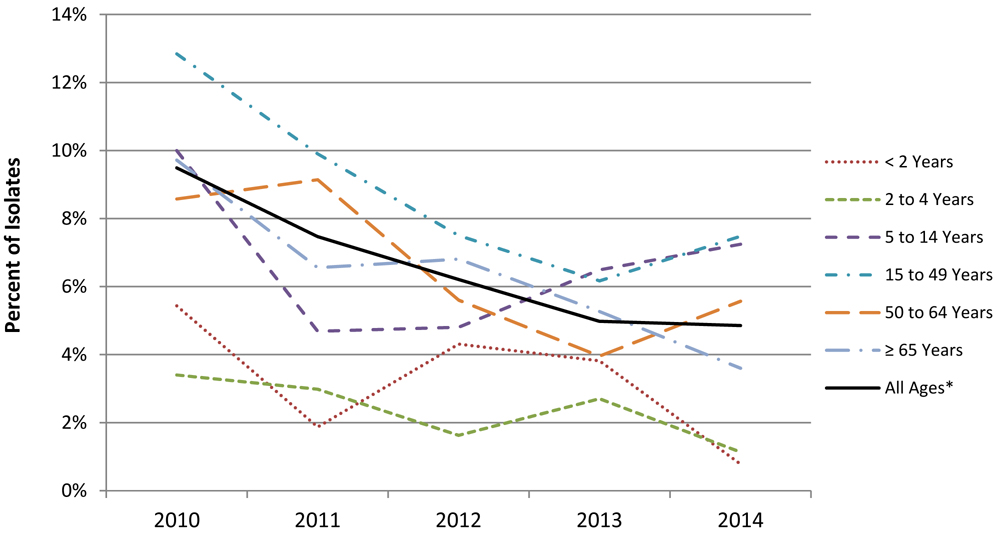
Text Equivalent
| Year | < 2 Years | 2 to 4 Years | 5 to 14 Years | 15 to 49 Years | 50 to 64 Years | ≥ 65 Years | All AgesTable Figure 17 Footnote 1 |
|---|---|---|---|---|---|---|---|
Table Figure 17 Footnotes
|
|||||||
| 2010 | 5.4% | 3.4% | 10.0% | 12.8% | 8.6% | 9.7% | 9.5% |
| 2011 | 1.9% | 3.0% | 4.7% | 9.9% | 9.1% | 6.6% | 7.5% |
| 2012 | 4.3% | 1.6% | 4.8% | 7.5% | 5.6% | 6.8% | 6.2% |
| 2013 | 3.8% | 2.7% | 6.5% | 6.2% | 4.0% | 5.3% | 5.0% |
| 2014 | 0.8% | 1.1% | 7.2% | 7.5% | 5.6% | 3.6% | 4.9% |
| Age Group (Years) | Year | ||||
|---|---|---|---|---|---|
| 2010 | 2011 | 2012 | 2013 | 2014 | |
Table 4 Footnotes
|
|||||
| <2 | 5.4% (10)Table 4 Footnote 2 | 1.9% (3) | 4.3% (5) | 3.8% (5) | 0.8% (1) |
| 2 - 4 | 3.4% (5) | 3.0% (4) | 1.6% (2) | 2.7% (2) | 1.1% (1) |
| 5 - 14 | 10.0% (11) | 4.7% (6) | 4.8% (5) | 6.5% (5) | 7.2% (5) |
| 15 - 49 | 12.8% (75) | 9.9% (62) | 7.5% (46) | 6.2% (33) | 7.5% (38) |
| 50 - 64 | 8.6% (59) | 9.1% (63) | 5.6% (39) | 4.0% (27) | 5.6% (39) |
| ≥65 | 9.7% (94) | 6.6% (60) | 6.8% (64) | 5.3% (55) | 3.6% (35) |
| All AgesTable 4 Footnote 1 | 9.5% (257) | 7.5% (200) | 6.2% (162) | 5.0% (128) | 4.9% (120) |
Figure 18. PCV13 serotypes (1, 5, 7F, 3, 6A, 19A) by age group, 2010 – 2014
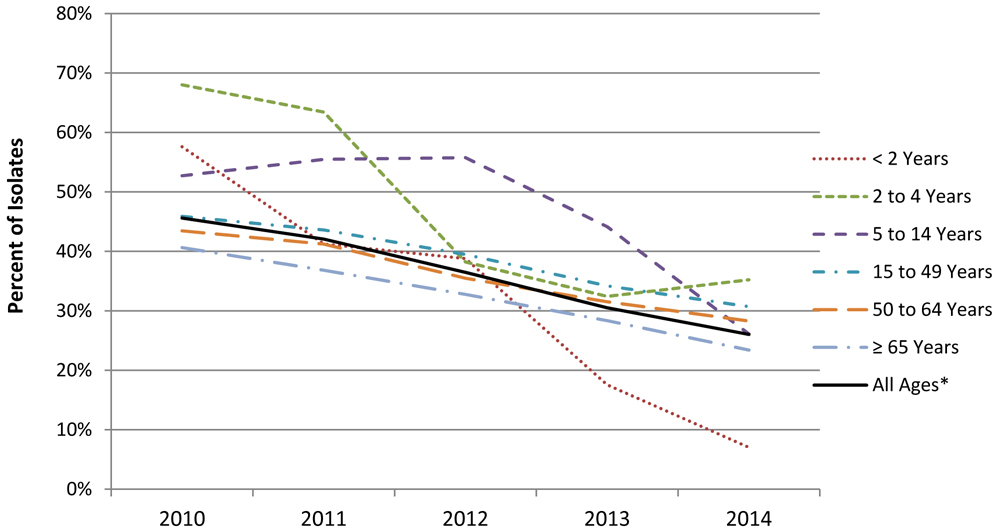
Text Equivalent
| Year | < 2 Years | 2 to 4 Years | 5 to 14 Years | 15 to 49 Years | 50 to 64 Years | ≥ 65 Years | All AgesTable figure 18 Footnote 1 |
|---|---|---|---|---|---|---|---|
Table Figure 18 Footnotes
|
|||||||
| 2010 | 57.6% | 68.0% | 52.7% | 45.9% | 43.5% | 40.6% | 45.6% |
| 2011 | 41.3% | 63.4% | 55.5% | 43.6% | 41.2% | 36.8% | 42.1% |
| 2012 | 38.8% | 38.2% | 55.8% | 39.5% | 35.5% | 32.8% | 36.5% |
| 2013 | 17.6% | 32.4% | 44.2% | 34.2% | 31.5% | 28.4% | 30.5% |
| 2014 | 7.0% | 35.2% | 26.1% | 30.7% | 28.3% | 23.4% | 26.0% |
| Age Group (Years) | Year | ||||
|---|---|---|---|---|---|
| 2010 | 2011 | 2012 | 2013 | 2014 | |
Table 5 Footnotes
|
|||||
| <2 | 57.6% (106)Table 5 Footnote 2 | 41.3% (66) | 38.8% (45) | 17.6% (23) | 7.0% (9) |
| 2 - 4 | 68.0% (100) | 63.4% (85) | 38.2% (47) | 32.4% (24) | 35.2% (31) |
| 5 - 14 | 52.7% (58) | 55.5% (71) | 55.8% (58) | 44.2% (34) | 26.1% (18) |
| 15 - 49 | 45.9% (268) | 43.6% (273) | 39.5% (242) | 34.2% (183) | 30.7% (156) |
| 50 - 64 | 43.5% (299) | 41.2% (284) | 35.5% (247) | 31.5% (215) | 28.3% (198) |
| ≥65 | 40.6% (393) | 36.8% (337) | 32.8% (308) | 28.4% (296) | 23.4% (226) |
| All AgesTable 5 Footnote 1 | 45.6% (1235) | 42.1% (1126) | 36.5% (951) | 30.5% (784) | 26.0% (644) |
Figure 19. PPV23 serotypes (2, 8, 9N, 10A, 11A, 12F, 15B, 17F, 20, 22F, 33F) by age group, 2010 – 2014
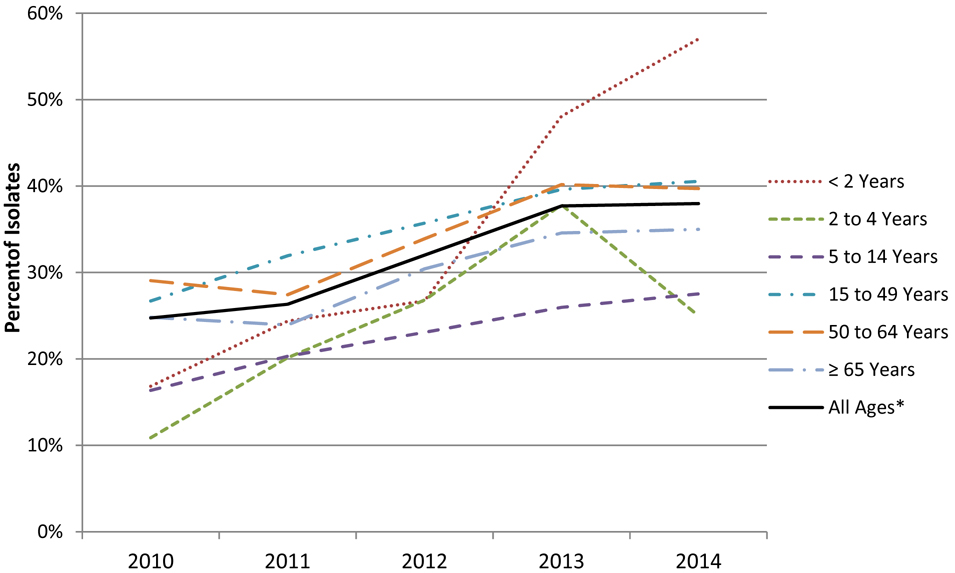
Text Equivalent
| Year | < 2 Years | 2 to 4 Years | 5 to 14 Years | 15 to 49 Years | 50 to 64 Years | ≥ 65 Years | All AgesTable Figure 19 Footnote 1 |
|---|---|---|---|---|---|---|---|
Table Figure 19 Footnotes
|
|||||||
| 2010 | 16.8% | 10.9% | 16.4% | 26.7% | 29.1% | 24.8% | 24.7% |
| 2011 | 24.4% | 20.1% | 20.3% | 31.9% | 27.4% | 23.9% | 26.3% |
| 2012 | 26.7% | 26.8% | 23.1% | 35.7% | 33.9% | 30.4% | 32.0% |
| 2013 | 48.1% | 37.8% | 26.0% | 39.6% | 40.2% | 34.6% | 37.7% |
| 2014 | 57.0% | 25.0% | 27.5% | 40.6% | 39.7% | 35.0% | 38.0% |
| Age Group (Years) | Year | ||||
|---|---|---|---|---|---|
| 2010 | 2011 | 2012 | 2013 | 2014 | |
Table 6 Footnotes
|
|||||
| <2 | 16.8% (31)Table 6 Footnote 2 | 24.4% (39) | 26.7% (31) | 48.1% (63) | 57.0% (73) |
| 2 - 4 | 10.9% (16) | 20.1% (27) | 26.8% (33) | 37.8% (28) | 25.0% (22) |
| 5 - 14 | 16.4% (18) | 20.3% (26) | 23.1% (24) | 26.0% (20) | 27.5% (19) |
| 15 - 49 | 26.7% (156) | 31.9% (200) | 35.7% (219) | 39.6% (212) | 40.6% (206) |
| 50 - 64 | 29.1% (200) | 27.4% (189) | 33.9% (236) | 40.2% (274) | 39.7% (278) |
| ≥65 | 24.8% (240) | 23.9% (219) | 30.4% (286) | 34.6% (361) | 35.0% (338) |
| All AgesTable 6 Footnote 1 | 24.7% (670) | 26.3% (705) | 32.0% (835) | 37.7% (969) | 38.0% (939) |
Figure 20. Non-vaccine serotypes by age group, 2010 – 2014
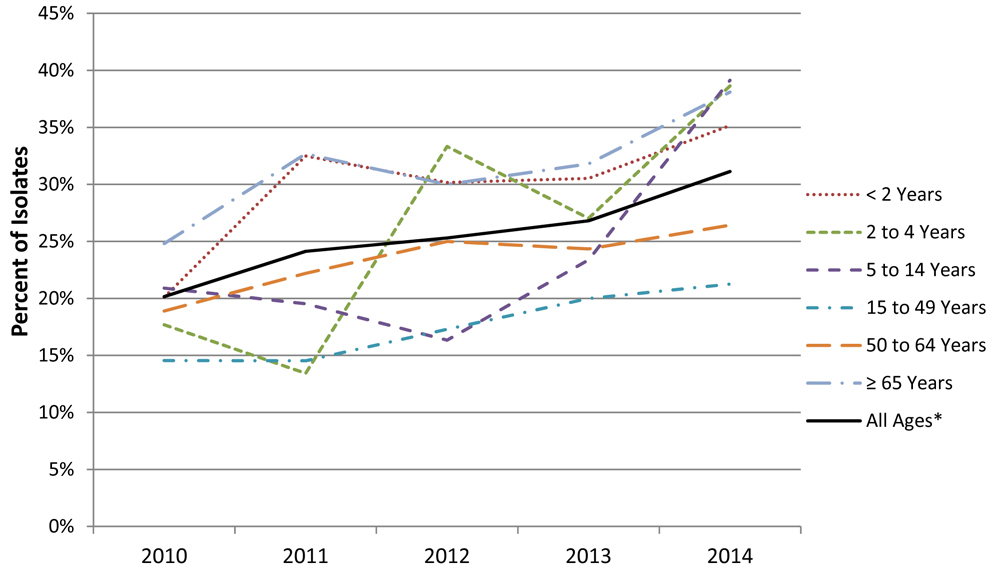
Text Equivalent
| Year | < 2 Years | 2 to 4 Years | 5 to 14 Years | 15 to 49 Years | 50 to 64 Years | ≥ 65 Years | All AgesTable Figure 20 Footnote 1 |
|---|---|---|---|---|---|---|---|
Table Figure 20 Footnotes
|
|||||||
| 2010 | 20.1% | 17.7% | 20.9% | 14.6% | 18.9% | 24.8% | 20.2% |
| 2011 | 32.5% | 13.4% | 19.5% | 14.5% | 22.2% | 32.7% | 24.1% |
| 2012 | 30.2% | 33.3% | 16.3% | 17.3% | 25.0% | 30.0% | 25.3% |
| 2013 | 30.5% | 27.0% | 23.4% | 20.0% | 24.3% | 31.8% | 26.8% |
| 2014 | 35.2% | 38.6% | 39.1% | 21.3% | 26.4% | 38.1% | 31.1% |
| Age Group (Years) | Year | ||||
|---|---|---|---|---|---|
| 2010 | 2011 | 2012 | 2013 | 2014 | |
Table 7 Footnotes
|
|||||
| <2 | 20.1% (37)Table 7 Footnote 2 | 32.5% (52) | 30.2% (35) | 30.5% (40) | 35.2% (45) |
| 2 - 4 | 17.7% (26) | 13.4% (18) | 33.3% (41) | 27.0% (20) | 38.6% (34) |
| 5 - 14 | 20.9% (23) | 19.5% (25) | 16.3% (17) | 23.4% (18) | 39.1% (27) |
| 15 - 49 | 14.6% (85) | 14.5% (91) | 17.3% (106) | 20.0% (107) | 21.3% (108) |
| 50 - 64 | 18.9% (130) | 22.2% (153) | 25.0% (174) | 24.3% (166) | 26.4% (185) |
| ≥65 | 24.8% (240) | 32.7% (299) | 30.0% (282) | 31.8% (332) | 38.1% (368) |
| All AgesTable 7 Footnote 1 | 20.2% (546) | 24.1% (646) | 25.3% (660) | 26.8% (689) | 31.1% (770) |
Antimicrobial Resistance of S. pneumoniae
As part of a joint NML/CARA program called SAVE, antimicrobial susceptibility testing was performed on 1125 S. pneumoniae isolates collected in 2014 from any age group causing IPD submitted from 8 participating jurisdictions (Saskatchewan, Manitoba, Ontario, Québec, Nova Scotia, Prince Edward Island, New Brunswick, Newfoundland and Labrador).
Over the 4 year period from 2011 to 2014 antimicrobial resistance rates among S. pneumoniae have remained relatively stable or have declined slightly. The high rate of resistance were observed to clarithromycin, declining slightly from 24.8% (n=263) to 22.0% (n=248, p=0.130) from 2013 to 2014 (Figure 21, Table 8). Lower resistance rates were seen with penicillin (meningitis breakpoints) declining steadily since 2011 from 11.9% (n=135) to 8.6% (n=97, p=0.017) in 2014, and clindamycin resistance has also declined from 7.1% (n=80) in 2011 to 4.4% (n=49, p=0.006) in 2014. Resistance to doxycycline has remained relatively stable since 2010, at 7.9% (n=89) in 2014. After increasing from 5.1% (n=58) to 7.4% (n=78, p=0.030) between 2011 and 2013, trimethoprim/sulfamethoxazole resistant S. pneumoniae has decreased to 5.8% (n=65, p=0.137) in 2014. All isolates were susceptible to ertapenem, linezolid, tigecycline and vancomycin.
Serotypes 15A, 19A, 19F and 35B generally had the highest rates of antimicrobial resistance during 2014 (Table 9). Clarithromycin resistance was associated with serotypes 19A (62.4%, n=53); 11A (27.3%, n=21); 12F (46.0%, n=23); 15A (64.0%, n=16); 22F (28.4%, n=31), 33F (77.3%, n=34) and 35B (25.0%, n=8) (Figure 22). Cefuroxime (parenteral) resistant serotypes were predominately 15A (23.1% n=6), 19A (18.8%, n=16), 19F (33.3%, n=5) and 35B (43.8%, n=14) (Figure 23); and clindamycin resistance was seen in serotypes 15A (48.0%, n=12), 19A (15.3%, n=13), 19F (33.3%, n=5), and 33F (18.2%, n=8) (Figure 24). A relatively high proportion of isolates with doxycycline resistance were seen in serotypes 3 (12.2%, n=11), 15A (68.0%, n=17), 19A (23.5%, n=20), 19F (40.0%, n=6) and 23A (43.6%, n=17) (Figure 25). Imipenem and meropenem resistance was mainly associated with serotype 19A isolates (11.8%, n=10 for each; respectively) (Figures 26, 27). Relatively high rates of resistance to penicillin (meningitis) were evident in serotypes 6C (24.3%, n=9), 15A (42.3%, n=11), 19A (22.4%, n=19), 19F (33.3%, n=5), 23A (48.7%, n=19) and 35B (46.9%, n=15) (Figure 28). Trimethoprim/sulfamethoxazole resistance was associated with serotypes 6C (18.9%, n=7), 7C (38.5%, n=5), 11A (14.3%, n=11), and 19A (20.0%, n=17) (Figure 29).
Multidrug resistance (MDR) to 3 or more classes of antimicrobials among S. pneumoniae continues to decline from 7.8% (n=88) of isolates tested in 2011 to 4.9% (n=55, p=0.004) in 2014 (Figures 30, 31 and Table 10). Serotypes with the highest rates of MDR during 2014 were 15A (53.8%, n=14), 19A (17.6%, n=15) and 19F (33.3%, n=5). The major MDR pattern among serotype 15A isolates was β-lactam-macrolide-clindamycin-tetracycline; and for serotypes 19A and 19F β-lactam-macrolide-clindamycin-tetracycline-trimethoprim/ sulfamethoxazole. Resistance to 6 classes of antimicrobials was seen in 1 isolate of serotype 6B, 4 isolates of 19A, and 1 isolate of 19F (Table 10).
Figure 21. Antimicrobial resistance of S. pneumoniae isolates, 2011 – 2014
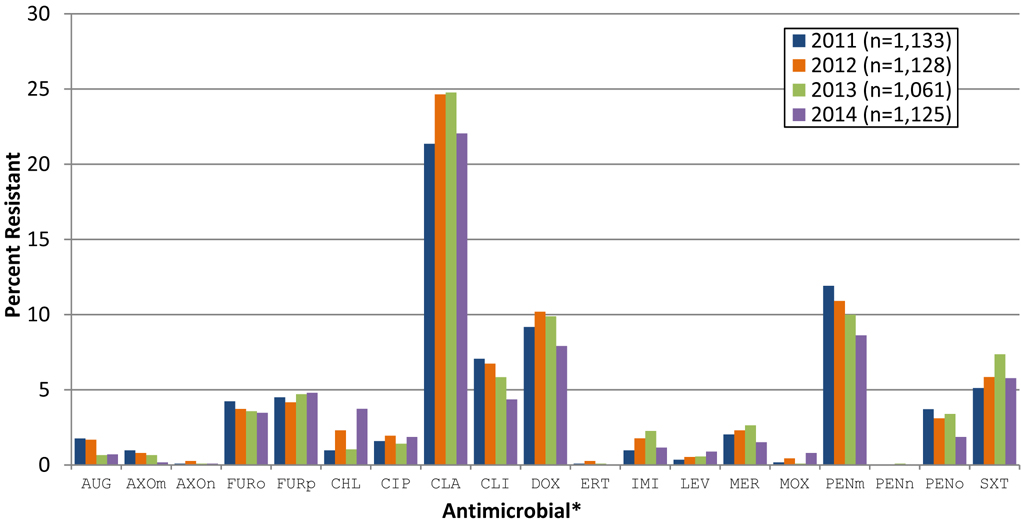
Text Equivalent
| AntimicrobialTable Figure 21 Footnote 1 | Year | |||
|---|---|---|---|---|
| 2011 | 2012 | 2013 | 2014 | |
Table Figure 21 Footnotes
|
||||
| AUG | 1.8% (20)Table Figure 21 Footnote 2 | 1.7% (19) | 0.7% (7) | 0.7% (8) |
| AXOm | 1.0% (11) | 0.8% (9) | 0.7% (7) | 0.2% (2) |
| AXOn | 0.1% (1) | 0.3% (3) | 0.1% (1) | 0.1% (1) |
| FURo | 4.2% (48) | 3.7% (42) | 3.6% (38) | 3.5% (39) |
| FURp | 4.5% (51) | 4.2% (47) | 4.7% (50) | 4.8% (54) |
| CHL | 1.0% (11) | 2.3% (26) | 1.0% (11) | 3.7% (42) |
| CIP | 1.6% (18) | 2.0% (22) | 1.4% (15) | 1.9% (21) |
| CLA | 21.4% (242) | 24.7% (278) | 24.8% (263) | 22.0% (248) |
| CLI | 7.1% (80) | 6.7% (76) | 5.8% (62) | 4.4% (49) |
| DOX | 9.2% (104) | 10.2% (115) | 9.9% (105) | 7.9% (89) |
| ERT | 0.1% (1) | 0.3% (3) | 0.1% (1) | 0.0% (0) |
| IMI | 1.0% (11) | 1.8% (20) | 2.3% (24) | 1.2% (13) |
| LEV | 0.4% (4) | 0.5% (6) | 0.6% (6) | 0.9% (10) |
| MER | 2.0% (23) | 2.3% (26) | 2.6% (28) | 1.5% (17) |
| MOX | 0.2% (2) | 0.4% (5) | 0.1% (1) | 0.8% (9) |
| PENm | 11.9% (135) | 10.9% (123) | 10.0% (106) | 8.6% (97) |
| PENn | 0.0% (0) | 0.0% (0) | 0.1% (1) | 0.0% (0) |
| PENo | 3.7% (42) | 3.1% (35) | 3.4% (36) | 1.9% (21) |
| SXT | 5.1% (58) | 5.9% (66) | 7.4% (78) | 5.8% (65) |
| Total Tested | (1,133) | (1,128) | (1,061) | (1,125) |
| AntimicrobialTable 8 Footnote 1 | Year | |||
|---|---|---|---|---|
| 2011 | 2012 | 2013 | 2014 | |
Table 8 Footnotes
|
||||
| AUG | 1.8% (20)Table 8 Footnote 2 | 1.7% (19) | 0.7% (7) | 0.7% (8) |
| AXOm | 1.0% (11) | 0.8% (9) | 0.7% (7) | 0.2% (2) |
| AXOn | 0.1% (1) | 0.3% (3) | 0.1% (1) | 0.1% (1) |
| FURo | 4.2% (48) | 3.7% (42) | 3.6% (38) | 3.5% (39) |
| FURp | 4.5% (51) | 4.2% (47) | 4.7% (50) | 4.8% (54) |
| CHL | 1.0% (11) | 2.3% (26) | 1.0% (11) | 3.7% (42) |
| CIP | 1.6% (18) | 2.0% (22) | 1.4% (15) | 1.9% (21) |
| CLA | 21.4% (242) | 24.7% (278) | 24.8% (263) | 22.0% (248) |
| CLI | 7.1% (80) | 6.7% (76) | 5.8% (62) | 4.4% (49) |
| DOX | 9.2% (104) | 10.2% (115) | 9.9% (105) | 7.9% (89) |
| ERT | 0.1% (1) | 0.3% (3) | 0.1% (1) | 0.0% (0) |
| IMI | 1.0% (11) | 1.8% (20) | 2.3% (24) | 1.2% (13) |
| LEV | 0.4% (4) | 0.5% (6) | 0.6% (6) | 0.9% (10) |
| MER | 2.0% (23) | 2.3% (26) | 2.6% (28) | 1.5% (17) |
| MOX | 0.2% (2) | 0.4% (5) | 0.1% (1) | 0.8% (9) |
| PENm | 11.9% (135) | 10.9% (123) | 10.0% (106) | 8.6% (97) |
| PENn | 0.0% (0) | 0.0% (0) | 0.1% (1) | 0.0% (0) |
| PENo | 3.7% (42) | 3.1% (35) | 3.4% (36) | 1.9% (21) |
| SXT | 5.1% (58) | 5.9% (66) | 7.4% (78) | 5.8% (65) |
| Total Tested | (1,133) | (1,128) | (1,061) | (1,125) |
| Serotype | Penicillins | Cephems | Carbapenems | Fluoro-quinolones | Other | ||||||||||||||
|---|---|---|---|---|---|---|---|---|---|---|---|---|---|---|---|---|---|---|---|
| AUGTable 9 Footnote 1 | PENm | PENn | PENo | AXOm | AXOn | FURo | FURp | ERT | IMI | MER | CIP | LEV | MOX | CLA | CLI | CHL | DOX | SXT | |
Table 9 Footnotes
|
|||||||||||||||||||
| 1 (n=2) | -Table 9 Footnote 2 | - | - | - | - | - | - | - | - | - | - | - | - | - | - | - | - | - | - |
| 3 (n=90) | - | - | - | - | - | - | - | - | - | - | - | - | - | - | 4.4Table 9 Footnote 3 | 3.3 | 12.2 | 12.2 | - |
| 4 (n=10) | - | - | - | - | - | - | - | - | - | - | - | - | - | - | 30.0 | - | - | 10.0 | - |
| 6A (n=8) | - | 37.5 | - | - | - | - | - | - | - | - | - | 12.5 | 12.5 | 12.5 | 37.5 | - | - | - | - |
| 6B (n=1) | - | 100 | - | - | - | - | - | - | - | - | - | - | - | - | 100 | 100 | 100 | 100 | 100 |
| 6C (n=37) | - | 24.3 | - | - | - | - | - | 10.8 | - | - | - | - | - | - | 16.2 | - | - | 2.7 | 18.9 |
| 6D (n=1) | - | - | - | - | - | - | - | - | - | - | - | 100 | 100 | 100 | - | - | - | - | - |
| 7B (n=1) | - | - | - | - | - | - | - | - | - | - | - | - | - | - | - | - | - | - | - |
| 7C (n=13) | - | - | - | - | - | - | - | - | - | - | - | 7.7 | - | - | - | - | - | 7.7 | 38.5 |
| 7F (n=69) | - | - | - | - | - | - | - | - | - | - | - | - | - | - | 2.9 | 1.4 | - | 4.3 | - |
| 8 (n=44) | - | - | - | - | - | - | - | - | - | - | - | - | - | - | - | - | 2.3 | 6.8 | - |
| 9N (n=50) | - | 2.0 | - | - | - | - | - | - | - | - | - | - | - | - | 10.0 | - | 2.0 | - | 2.0 |
| 9V (n=3) | - | 100 | - | 33.3 | - | - | 100 | 100 | - | - | - | - | - | - | 100 | - | - | - | 100 |
| 10A (n=36) | - | - | - | - | - | - | - | - | - | - | - | - | - | - | 19.4 | - | - | 2.8 | 2.8 |
| 10B (n=1) | - | - | - | - | - | - | - | - | - | - | - | - | - | - | - | - | - | - | - |
| 10F (n=1) | - | - | - | - | - | - | - | - | - | - | - | - | - | - | - | - | - | - | - |
| 11A (n=77) | - | 1.3 | - | 1.3 | - | - | 1.3 | 1.3 | - | - | - | 3.9 | - | - | 27.3 | 2.6 | 1.3 | 1.3 | 14.3 |
| 11B (n=2) | - | - | - | - | - | - | - | - | - | - | - | - | - | - | - | - | - | - | - |
| 12F (n=50) | - | - | - | - | - | - | - | - | - | - | - | - | - | - | 46.0 | - | - | - | - |
| 13 (n=6) | - | - | - | - | - | - | - | - | - | - | - | - | - | - | 16.7 | - | - | 16.7 | - |
| 14 (n=4) | - | - | - | - | - | - | - | - | - | - | - | - | - | - | 100 | 25.0 | - | - | - |
| 15A (n=26) | - | 42.3 | - | 7.7 | - | - | 15.4 | 23.1 | - | - | 4.0 | - | - | - | 64.0 | 48.0 | 15.4 | 68.0 | - |
| 15B (n=21) | - | - | - | - | - | - | - | - | - | - | - | - | - | - | 33.3 | - | - | - | 4.8 |
| 15C (n=9) | - | - | - | - | - | - | - | - | - | - | - | - | - | - | - | - | - | - | 11.1 |
| 16F (n=45) | - | - | - | - | - | - | - | - | - | - | - | 8.9 | 6.7 | 6.7 | - | - | - | - | 2.2 |
| 17F (n=12) | - | - | - | - | - | - | - | - | - | - | - | - | - | - | - | - | - | - | - |
| 18C (n=4) | - | - | - | - | - | - | - | - | - | - | - | - | - | - | - | - | 25.0 | - | - |
| 19A (n=85) | 7.1 | 22.4 | - | 12.9 | 1.2 | - | 16.5 | 18.8 | - | 11.8 | 11.8 | 1.2 | - | - | 62.4 | 15.3 | 4.7 | 23.5 | 20.0 |
| 19F (n=15) | 13.3 | 33.3 | - | 26.7 | 6.7 | 6.7 | 33.3 | 33.3 | - | 13.3 | 13.3 | - | - | - | 33.3 | 33.3 | 6.7 | 40.0 | 13.3 |
| 20 (n=28) | - | - | - | - | - | - | - | - | - | - | - | - | - | - | 3.6 | - | 3.6 | - | - |
| 21 (n=5) | - | - | - | - | - | - | - | - | - | - | - | - | - | - | - | - | - | - | - |
| 22A (n=2) | - | - | - | - | - | - | - | - | - | - | - | - | - | - | - | - | - | - | - |
| 22F(n=109) | - | - | - | - | - | - | - | - | - | - | - | 4.6 | 2.8 | 2.8 | 28.4 | 0.9 | 11.9 | - | 0.9 |
| 23A (n=39) | - | 48.7 | - | - | - | - | - | - | - | - | - | - | - | - | 5.1 | 2.6 | - | 43.6 | - |
| 23B (n=29) | - | 10.3 | - | - | - | - | - | - | - | - | - | - | - | - | - | - | - | 3.4 | 6.9 |
| 23F (n=3) | - | - | - | - | - | - | - | - | - | - | - | - | - | - | - | - | - | - | - |
| 24 (n=1) | - | - | - | - | - | - | - | - | - | - | - | - | - | - | - | - | - | - | - |
| 24B (n=1) | - | - | - | - | - | - | - | - | - | - | - | - | - | - | - | - | - | - | - |
| 24F (n=5) | - | 40.0 | - | - | - | - | - | - | - | - | - | - | - | - | 20.0 | 20.0 | - | 40.0 | - |
| 28A (n=1) | - | - | - | - | - | - | - | - | - | - | - | - | - | - | - | - | - | - | - |
| 29 (n=10) | - | 40.0 | - | 10.0 | - | - | 20.0 | 40.0 | - | - | 10.0 | 10.0 | 10.0 | 10.0 | 30.0 | - | - | - | 10.0 |
| 31 (n=28) | - | - | - | - | - | - | - | - | - | - | - | - | - | - | 3.6 | - | - | - | - |
| 33F (n=44) | - | - | - | - | - | - | - | - | - | - | - | 2.3 | - | - | 77.3 | 18.2 | 4.5 | 2.3 | 13.6 |
| 34 (n=12) | - | - | - | - | - | - | - | - | - | - | - | - | - | - | - | - | - | - | - |
| 35B (n=32) | - | 46.9 | - | 3.1 | - | - | 31.3 | 43.8 | - | 3.1 | 9.4 | 3.1 | 3.1 | - | 25.0 | - | 3.1 | 3.1 | 9.4 |
| 35C (n=1) | - | - | - | - | - | - | - | - | - | - | - | - | - | - | 100 | - | - | - | 100 |
| 35F (n=32) | - | - | - | - | - | - | - | - | - | - | - | 6.3 | - | - | 3.1 | - | - | - | - |
| 37 (n=2) | - | - | - | - | - | - | - | - | - | - | - | - | - | - | - | - | - | - | - |
| 38 (n=12) | - | - | - | - | - | - | - | - | - | - | - | - | - | - | - | - | - | - | - |
| NT (n=6) | - | 16.7 | - | - | - | - | - | 16.7 | - | - | - | - | - | - | 16.7 | - | - | - | - |
| All(n=1125) | 0.7 | 8.6 | 0 | 1.9 | 0.2 | 0.1 | 3.5 | 4.8 | 0 | 1.2 | 1.5 | 1.9 | 0.9 | 0.8 | 22.1 | 4.4 | 3.7 | 7.9 | 5.8 |
Figure 22. Clarithromycin resistance of S. pneumoniae serotypes collected 2011 - 2014
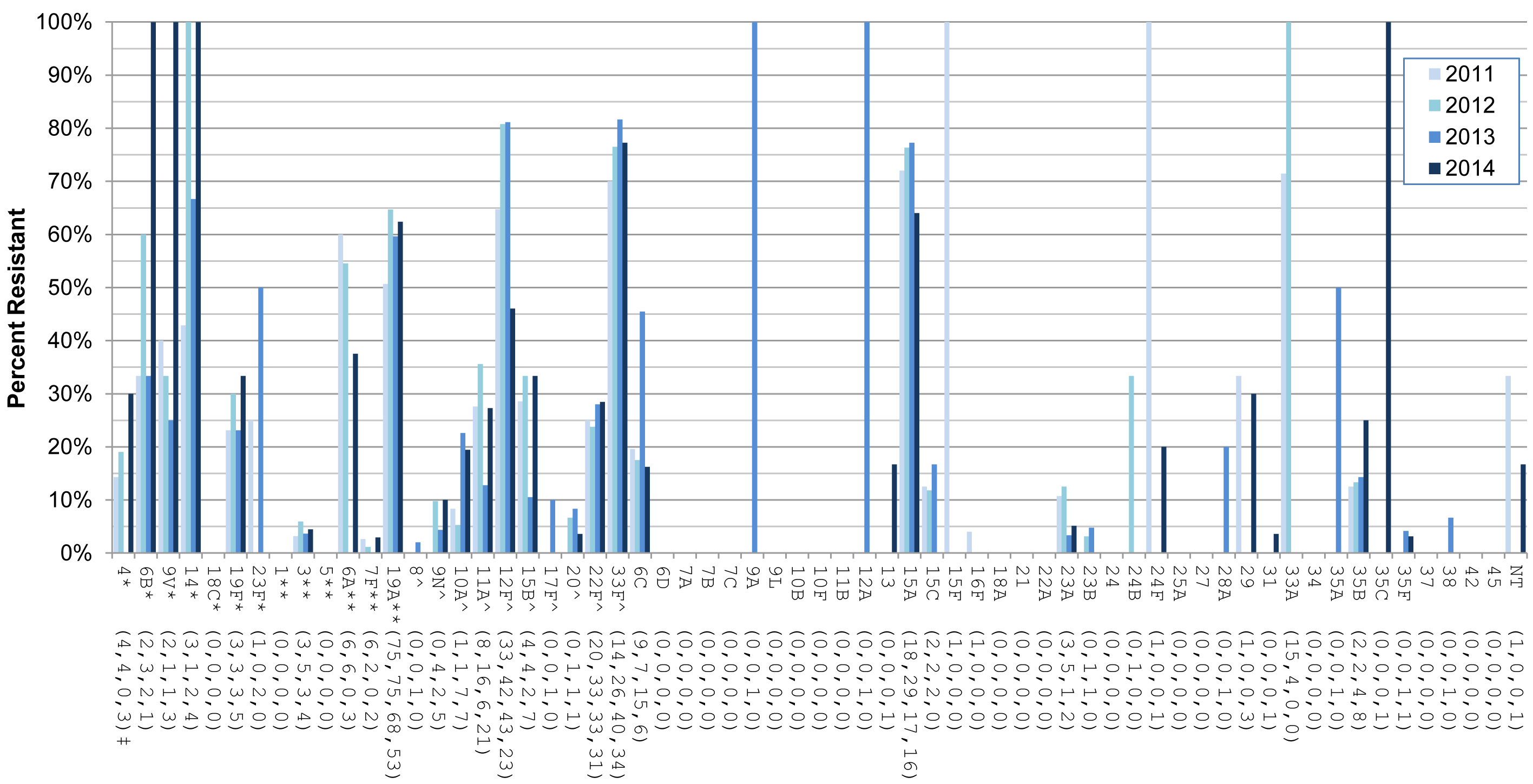
*Component of PCV7; ** Component of PCV13; ^ Component of PPV23; ‡ Number of resistant isolates for 2011, 2012, 2013 and 2014, respectively.
Text Equivalent
| Serotype | 2011 | 2012 | 2013 | 2014 |
|---|---|---|---|---|
Table Figure 22 Footnotes
|
||||
| 4Table Figure 22 Footnote 1 (4,4,0,3)Table Figure 22 Footnote 4 | 14.3% | 19.0% | 0.0% | 30.0% |
| 6BTable Figure 22 Footnote 1 (2,3,2,1) | 33.3% | 60.0% | 33.3% | 100.0% |
| 9VTable Figure 22 Footnote 1 (2,1,1,3) | 40.0% | 33.3% | 25.0% | 100.0% |
| 14Table Figure 22 Footnote 1 (3,1,2,4) | 42.9% | 100.0% | 66.7% | 100.0% |
| 18CTable Figure 22 Footnote 1 (0,0,0,0) | 0.0% | 0.0% | 0.0% | 0.0% |
| 19FTable Figure 22 Footnote 1 (3,3,3,5) | 23.1% | 30.0% | 23.1% | 33.3% |
| 23FTable Figure 22 Footnote 1 (1,0,2,0) | 25.0% | 0.0% | 50.0% | 0.0% |
| 1Table Figure 22 Footnote 2 (0,0,0,0) | 0.0% | 0.0% | 0.0% | 0.0% |
| 3Table Figure 22 Footnote 2 (3,5,3,4) | 3.2% | 6.0% | 3.7% | 4.4% |
| 5Table Figure 22 Footnote 2 (0,0,0,0) | 0.0% | 0.0% | 0.0% | 0.0% |
| 6ATable Figure 22 Footnote 2 (6,6,0,3) | 60.0% | 54.5% | 0.0% | 37.5% |
| 7FTable Figure 22 Footnote 2 (6,2,0,2) | 2.6% | 1.1% | 0.0% | 2.9% |
| 19ATable Figure 22 Footnote 2(75,75,68,53) | 50.7% | 64.7% | 59.6% | 62.4% |
| 8Table Figure 22 Footnote 3 (0,0,1,0) | 0.0% | 0.0% | 2.0% | 0.0% |
| 9NTable Figure 22 Footnote 3 (0,4,2,5) | 0.0% | 9.8% | 4.3% | 10.0% |
| 10ATable Figure 22 Footnote 3 (1,1,7,7) | 8.3% | 5.3% | 22.6% | 19.4% |
| 11ATable Figure 22 Footnote 3 (8,16,6,21) | 27.6% | 35.6% | 12.8% | 27.3% |
| 12FTable Figure 22 Footnote 3 (33,42,43,23) | 64.7% | 80.8% | 81.1% | 46.0% |
| 15BTable Figure 22 Footnote 3 (4,4,2,7) | 28.6% | 33.3% | 10.5% | 33.3% |
| 17FTable Figure 22 Footnote 3 (0,0,1,0) | 0.0% | 0.0% | 10.0% | 0.0% |
| 20Table Figure 22 Footnote 3 (0,1,1,1) | 0.0% | 6.7% | 8.3% | 3.6% |
| 22FTable Figure 22 Footnote 3 (20,33,33,31) | 25.0% | 23.7% | 28.0% | 28.4% |
| 33FTable Figure 22 Footnote 3 (14,26,40,34) | 70.0% | 76.5% | 81.6% | 77.3% |
| 6C (9,7,15,6) | 19.6% | 17.5% | 45.5% | 16.2% |
| 6D (0,0,0,0) | 0.0% | 0.0% | 0.0% | 0.0% |
| 7A (0,0,0,0) | 0.0% | 0.0% | 0.0% | 0.0% |
| 7B (0,0,0,0) | 0.0% | 0.0% | 0.0% | 0.0% |
| 7C (0,0,0,0) | 0.0% | 0.0% | 0.0% | 0.0% |
| 9A (0,0,1,0) | 0.0% | 0.0% | 100.0% | 0.0% |
| 9L (0,0,0,0) | 0.0% | 0.0% | 0.0% | 0.0% |
| 10B (0,0,0,0) | 0.0% | 0.0% | 0.0% | 0.0% |
| 10F (0,0,0,0) | 0.0% | 0.0% | 0.0% | 0.0% |
| 11B (0,0,0,0) | 0.0% | 0.0% | 0.0% | 0.0% |
| 12A (0,0,1,0) | 0.0% | 0.0% | 100.0% | 0.0% |
| 13 (0,0,0,1) | 0.0% | 0.0% | 0.0% | 16.7% |
| 15A (18,29,17,16) | 72.0% | 76.3% | 77.3% | 64.0% |
| 15C (2,2,2,0) | 12.5% | 11.8% | 16.7% | 0.0% |
| 15F (1,0,0,0) | 100.0% | 0.0% | 0.0% | 0.0% |
| 16F (1,0,0,0) | 4.0% | 0.0% | 0.0% | 0.0% |
| 18A (0,0,0,0) | 0.0% | 0.0% | 0.0% | 0.0% |
| 21 (0,0,0,0) | 0.0% | 0.0% | 0.0% | 0.0% |
| 22A (0,0,0,0) | 0.0% | 0.0% | 0.0% | 0.0% |
| 23A (3,5,1,2) | 10.7% | 12.5% | 3.3% | 5.1% |
| 23B (0,1,1,0) | 0.0% | 3.1% | 4.8% | 0.0% |
| 24 (0,0,0,0) | 0.0% | 0.0% | 0.0% | 0.0% |
| 24B (0,1,0,0) | 0.0% | 33.3% | 0.0% | 0.0% |
| 24F (1,0,0,1) | 100.0% | 0.0% | 0.0% | 20.0% |
| 25A (0,0,0,0) | 0.0% | 0.0% | 0.0% | 0.0% |
| 27 (0,0,0,0) | 0.0% | 0.0% | 0.0% | 0.0% |
| 28A (0,0,1,0) | 0.0% | 0.0% | 20.0% | 0.0% |
| 29 (1,0,0,3) | 33.3% | 0.0% | 0.0% | 30.0% |
| 31 (0,0,0,1) | 0.0% | 0.0% | 0.0% | 3.6% |
| 33A (15,4,0,0) | 71.4% | 100.0% | 0.0% | 0.0% |
| 34 (0,0,0,0) | 0.0% | 0.0% | 0.0% | 0.0% |
| 35A (0,0,1,0) | 0.0% | 0.0% | 50.0% | 0.0% |
| 35B (2,2,4,8) | 12.5% | 13.3% | 14.3% | 25.0% |
| 35C (0,0,0,1) | 0.0% | 0.0% | 0.0% | 100.0% |
| 35F (0,0,1,1) | 0.0% | 0.0% | 4.2% | 3.1% |
| 37 (0,0,0,0) | 0.0% | 0.0% | 0.0% | 0.0% |
| 38 (0,0,1,0) | 0.0% | 0.0% | 6.7% | 0.0% |
| 42 (0,0,0,0) | 0.0% | 0.0% | 0.0% | 0.0% |
| 45 (0,0,0,0) | 0.0% | 0.0% | 0.0% | 0.0% |
| NT (1,0,0,1) | 33.3% | 0.0% | 0.0% | 16.7% |
Figure 23. Cefuroxime (parenteral) resistance of S. pneumoniae serotypes collected 2011 – 2014
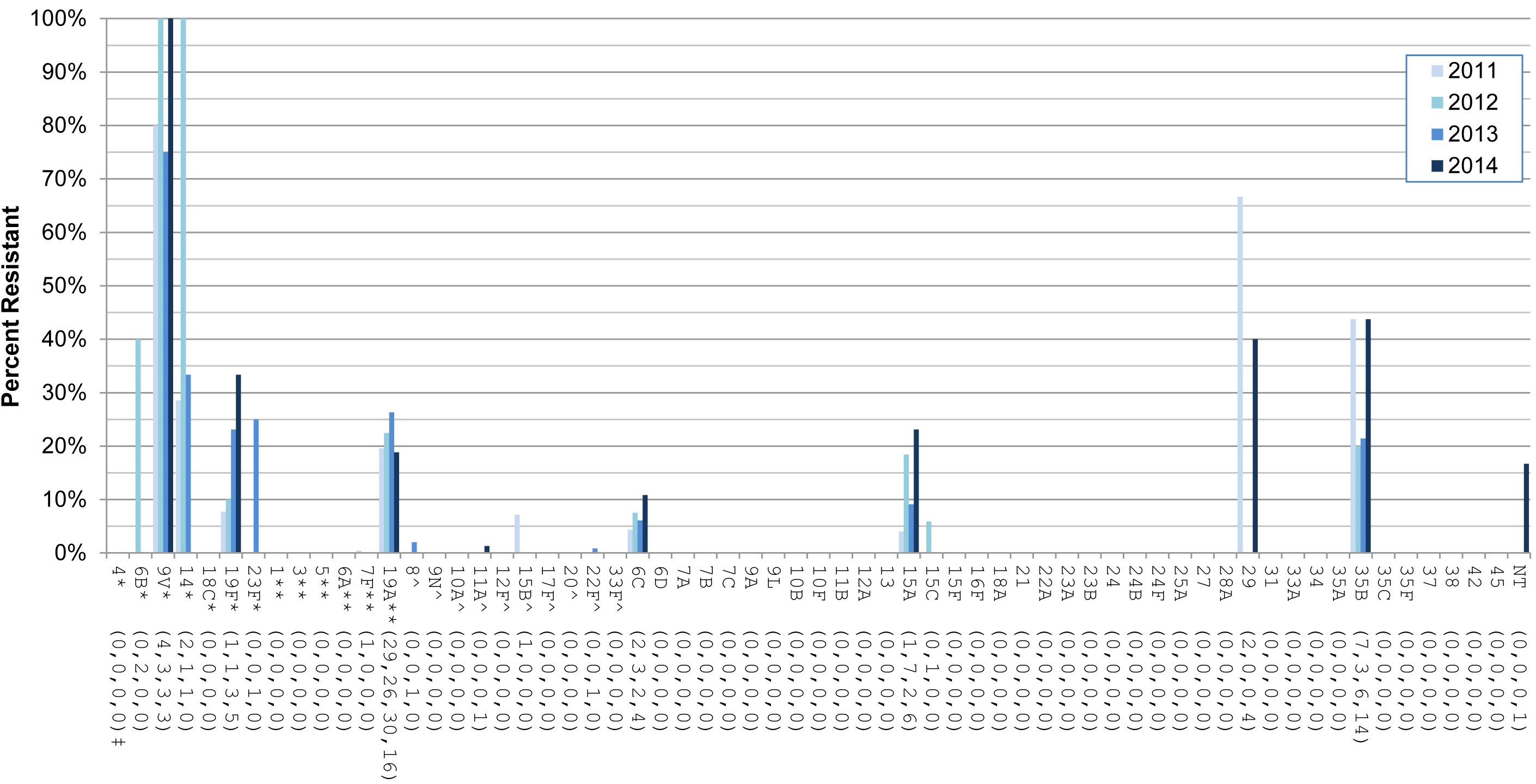
*Component of PCV7; ** Component of PCV13; ^ Component of PPV23; ‡ Number of resistant isolates for 2011, 2012, 2013 and 2014, respectively.
Text Equivalent
| Serotype | 2011 | 2012 | 2013 | 2014 |
|---|---|---|---|---|
Table Figure 23 Footnotes
|
||||
| 4Table figure 23 Footnote 1 (0,0,0,0)Table figure 23 Footnote 4 | 0.0% | 0.0% | 0.0% | 0.0% |
| 6BTable figure 23 Footnote 1 (0,2,0,0) | 0.0% | 40.0% | 0.0% | 0.0% |
| 9VTable figure 23 Footnote 1 (4,3,3,3) | 80.0% | 100.0% | 75.0% | 100.0% |
| 14Table figure 23 Footnote 1 (2,1,1,0) | 28.6% | 100.0% | 33.3% | 0.0% |
| 18CTable figure 23 Footnote 1 (0,0,0,0) | 0.0% | 0.0% | 0.0% | 0.0% |
| 19FTable figure 23 Footnote 1 (1,1,3,5) | 7.7% | 10.0% | 23.1% | 33.3% |
| 23FTable figure 23 Footnote 1 (0,0,1,0) | 0.0% | 0.0% | 25.0% | 0.0% |
| 1Table figure 23 Footnote 2 (0,0,0,0) | 0.0% | 0.0% | 0.0% | 0.0% |
| 3Table figure 23 Footnote 2 (0,0,0,0) | 0.0% | 0.0% | 0.0% | 0.0% |
| 5Table figure 23 Footnote 2 (0,0,0,0) | 0.0% | 0.0% | 0.0% | 0.0% |
| 6ATable figure 23 Footnote 2 (0,0,0,0) | 0.0% | 0.0% | 0.0% | 0.0% |
| 7FTable figure 23 Footnote 2 (1,0,0,0) | 0.4% | 0.0% | 0.0% | 0.0% |
| 19ATable figure 23 Footnote 2(29,26,30,16) | 19.6% | 22.4% | 26.3% | 18.8% |
| 8Table figure 23 Footnote 3 (0,0,1,0) | 0.0% | 0.0% | 2.0% | 0.0% |
| 9NTable figure 23 Footnote 3 (0,0,0,0) | 0.0% | 0.0% | 0.0% | 0.0% |
| 10ATable figure 23 Footnote 3 (0,0,0,0) | 0.0% | 0.0% | 0.0% | 0.0% |
| 11ATable figure 23 Footnote 3 (0,0,0,1) | 0.0% | 0.0% | 0.0% | 1.3% |
| 12FTable figure 23 Footnote 3 (0,0,0,0) | 0.0% | 0.0% | 0.0% | 0.0% |
| 15BTable figure 23 Footnote 3 (1,0,0,0) | 7.1% | 0.0% | 0.0% | 0.0% |
| 17FTable figure 23 Footnote 3 (0,0,0,0) | 0.0% | 0.0% | 0.0% | 0.0% |
| 20Table figure 23 Footnote 3 (0,0,0,0) | 0.0% | 0.0% | 0.0% | 0.0% |
| 22FTable figure 23 Footnote 3 (0,0,1,0) | 0.0% | 0.0% | 0.8% | 0.0% |
| 33FTable figure 23 Footnote 3 (0,0,0,0) | 0.0% | 0.0% | 0.0% | 0.0% |
| 6C (2,3,2,4) | 4.3% | 7.5% | 6.1% | 10.8% |
| 6D (0,0,0,0) | 0.0% | 0.0% | 0.0% | 0.0% |
| 7A (0,0,0,0) | 0.0% | 0.0% | 0.0% | 0.0% |
| 7B (0,0,0,0) | 0.0% | 0.0% | 0.0% | 0.0% |
| 7C (0,0,0,0) | 0.0% | 0.0% | 0.0% | 0.0% |
| 9A (0,0,0,0) | 0.0% | 0.0% | 0.0% | 0.0% |
| 9L (0,0,0,0) | 0.0% | 0.0% | 0.0% | 0.0% |
| 10B (0,0,0,0) | 0.0% | 0.0% | 0.0% | 0.0% |
| 10F (0,0,0,0) | 0.0% | 0.0% | 0.0% | 0.0% |
| 11B (0,0,0,0) | 0.0% | 0.0% | 0.0% | 0.0% |
| 12A (0,0,0,0) | 0.0% | 0.0% | 0.0% | 0.0% |
| 13 (0,0,0,0) | 0.0% | 0.0% | 0.0% | 0.0% |
| 15A (1,7,2,6) | 4.0% | 18.4% | 9.1% | 23.1% |
| 15C (0,1,0,0) | 0.0% | 5.9% | 0.0% | 0.0% |
| 15F (0,0,0,0) | 0.0% | 0.0% | 0.0% | 0.0% |
| 16F (0,0,0,0) | 0.0% | 0.0% | 0.0% | 0.0% |
| 18A (0,0,0,0) | 0.0% | 0.0% | 0.0% | 0.0% |
| 21 (0,0,0,0) | 0.0% | 0.0% | 0.0% | 0.0% |
| 22A (0,0,0,0) | 0.0% | 0.0% | 0.0% | 0.0% |
| 23A (0,0,0,0) | 0.0% | 0.0% | 0.0% | 0.0% |
| 23B (0,0,0,0) | 0.0% | 0.0% | 0.0% | 0.0% |
| 24 (0,0,0,0) | 0.0% | 0.0% | 0.0% | 0.0% |
| 24B (0,0,0,0) | 0.0% | 0.0% | 0.0% | 0.0% |
| 24F (0,0,0,0) | 0.0% | 0.0% | 0.0% | 0.0% |
| 25A (0,0,0,0) | 0.0% | 0.0% | 0.0% | 0.0% |
| 27 (0,0,0,0) | 0.0% | 0.0% | 0.0% | 0.0% |
| 28A (0,0,0,0) | 0.0% | 0.0% | 0.0% | 0.0% |
| 29 (2,0,0,4) | 66.7% | 0.0% | 0.0% | 40.0% |
| 31 (0,0,0,0) | 0.0% | 0.0% | 0.0% | 0.0% |
| 33A (0,0,0,0) | 0.0% | 0.0% | 0.0% | 0.0% |
| 34 (0,0,0,0) | 0.0% | 0.0% | 0.0% | 0.0% |
| 35A (0,0,0,0) | 0.0% | 0.0% | 0.0% | 0.0% |
| 35B (7,3,6,14) | 43.8% | 20.0% | 21.4% | 43.8% |
| 35C (0,0,0,0) | 0.0% | 0.0% | 0.0% | 0.0% |
| 35F (0,0,0,0) | 0.0% | 0.0% | 0.0% | 0.0% |
| 37 (0,0,0,0) | 0.0% | 0.0% | 0.0% | 0.0% |
| 38 (0,0,0,0) | 0.0% | 0.0% | 0.0% | 0.0% |
| 42 (0,0,0,0) | 0.0% | 0.0% | 0.0% | 0.0% |
| 45 (0,0,0,0) | 0.0% | 0.0% | 0.0% | 0.0% |
| NT (0,0,0,1) | 0.0% | 0.0% | 0.0% | 16.7% |
Figure 24. Clindamycin resistance of S. pneumoniae serotypes collected 2011 – 2014
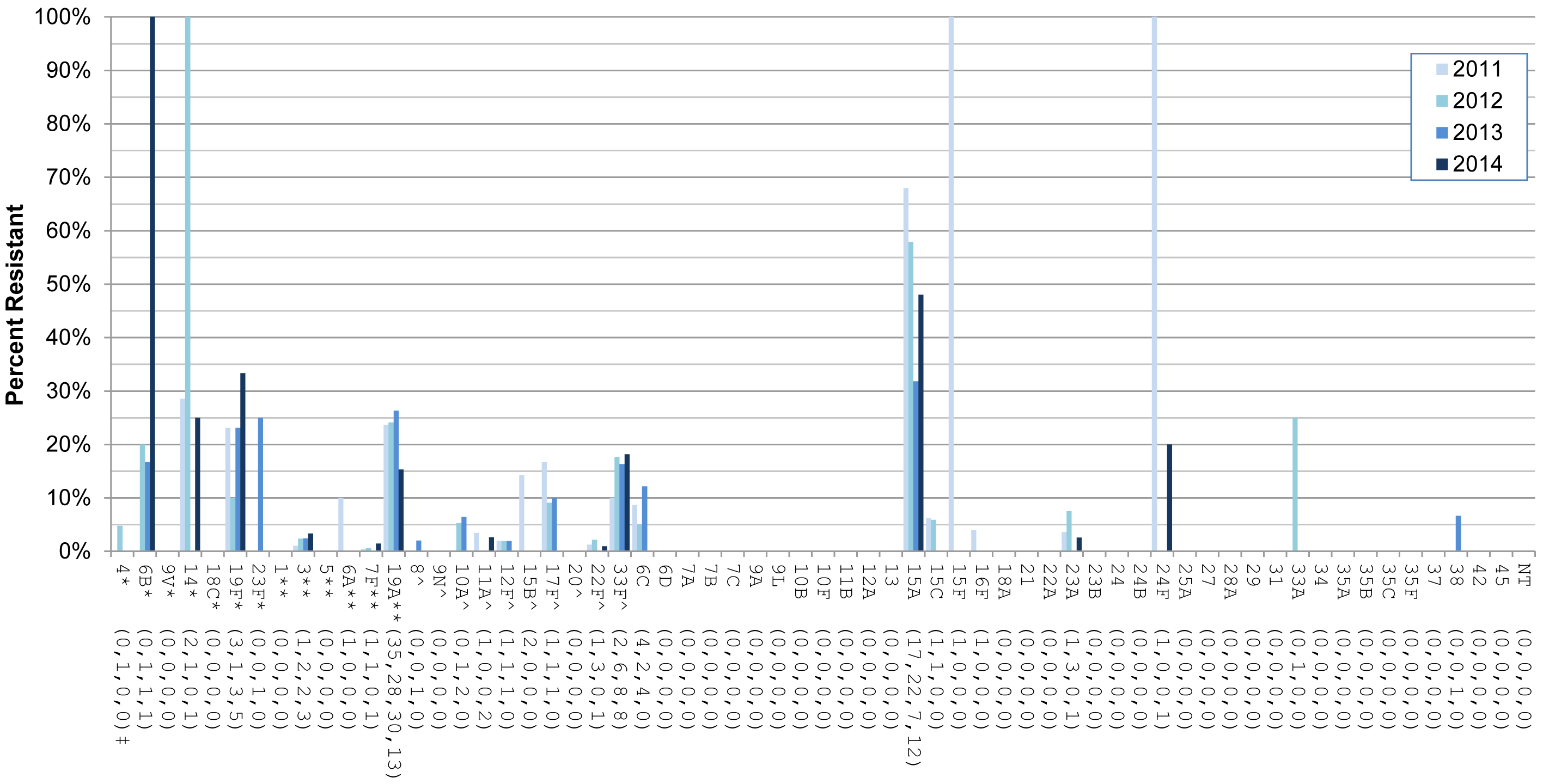
*Component of PCV7; ** Component of PCV13; ^ Component of PPV23; ‡ Number of resistant isolates for 2011, 2012, 2013 and 2014, respectively.
Text Equivalent
| Serotype | 2011 | 2012 | 2013 | 2014 |
|---|---|---|---|---|
Table Figure 24 Footnotes
|
||||
| 4Table Figure 24 Footnote 1 (0,1,0,0)Table Figure 24 Footnote 4 | 0.0% | 4.8% | 0.0% | 0.0% |
| 6BTable Figure 24 Footnote 1 (0,1,1,1) | 0.0% | 20.0% | 16.7% | 100.0% |
| 9VTable Figure 24 Footnote 1 (0,0,0,0) | 0.0% | 0.0% | 0.0% | 0.0% |
| 14Table Figure 24 Footnote 1 (2,1,0,1) | 28.6% | 100.0% | 0.0% | 25.0% |
| 18CTable Figure 24 Footnote 1 (0,0,0,0) | 0.0% | 0.0% | 0.0% | 0.0% |
| 19FTable Figure 24 Footnote 1 (3,1,3,5) | 23.1% | 10.0% | 23.1% | 33.3% |
| 23FTable Figure 24 Footnote 1 (0,0,1,0) | 0.0% | 0.0% | 25.0% | 0.0% |
| 1Table Figure 24 Footnote 2 (0,0,0,0) | 0.0% | 0.0% | 0.0% | 0.0% |
| 3Table Figure 24 Footnote 2 (1,2,2,3) | 1.1% | 2.4% | 2.4% | 3.3% |
| 5Table Figure 24 Footnote 2 (0,0,0,0) | 0.0% | 0.0% | 0.0% | 0.0% |
| 6ATable Figure 24 Footnote 2 (1,0,0,0) | 10.0% | 0.0% | 0.0% | 0.0% |
| 7FTable Figure 24 Footnote 2 (1,1,0,1) | 0.4% | 0.6% | 0.0% | 1.4% |
| 19ATable Figure 24 Footnote 2(35,28,30,13) | 23.6% | 24.1% | 26.3% | 15.3% |
| 8Table Figure 24 Footnote 3 (0,0,1,0) | 0.0% | 0.0% | 2.0% | 0.0% |
| 9NTable Figure 24 Footnote 3 (0,0,0,0) | 0.0% | 0.0% | 0.0% | 0.0% |
| 10ATable Figure 24 Footnote 3 (0,1,2,0) | 0.0% | 5.3% | 6.5% | 0.0% |
| 11ATable Figure 24 Footnote 3 (1,0,0,2) | 3.4% | 0.0% | 0.0% | 2.6% |
| 12FTable Figure 24 Footnote 3 (1,1,1,0) | 2.0% | 1.9% | 1.9% | 0.0% |
| 15BTable Figure 24 Footnote 3 (2,0,0,0) | 14.3% | 0.0% | 0.0% | 0.0% |
| 17FTable Figure 24 Footnote 3 (1,1,1,0) | 16.7% | 9.1% | 10.0% | 0.0% |
| 20Table Figure 24 Footnote 3 (0,0,0,0) | 0.0% | 0.0% | 0.0% | 0.0% |
| 22FTable Figure 24 Footnote 3 (1,3,0,1) | 1.3% | 2.2% | 0.0% | 0.9% |
| 33FTable Figure 24 Footnote 3 (2,6,8,8) | 10.0% | 17.6% | 16.3% | 18.2% |
| 6C (4,2,4,0) | 8.7% | 5.0% | 12.1% | 0.0% |
| 6D (0,0,0,0) | 0.0% | 0.0% | 0.0% | 0.0% |
| 7A (0,0,0,0) | 0.0% | 0.0% | 0.0% | 0.0% |
| 7B (0,0,0,0) | 0.0% | 0.0% | 0.0% | 0.0% |
| 7C (0,0,0,0) | 0.0% | 0.0% | 0.0% | 0.0% |
| 9A (0,0,0,0) | 0.0% | 0.0% | 0.0% | 0.0% |
| 9L (0,0,0,0) | 0.0% | 0.0% | 0.0% | 0.0% |
| 10B (0,0,0,0) | 0.0% | 0.0% | 0.0% | 0.0% |
| 10F (0,0,0,0) | 0.0% | 0.0% | 0.0% | 0.0% |
| 11B (0,0,0,0) | 0.0% | 0.0% | 0.0% | 0.0% |
| 12A (0,0,0,0) | 0.0% | 0.0% | 0.0% | 0.0% |
| 13 (0,0,0,0) | 0.0% | 0.0% | 0.0% | 0.0% |
| 15A (17,22,7,12) | 68.0% | 57.9% | 31.8% | 48.0% |
| 15C (1,1,0,0) | 6.3% | 5.9% | 0.0% | 0.0% |
| 15F (1,0,0,0) | 100.0% | 0.0% | 0.0% | 0.0% |
| 16F (1,0,0,0) | 4.0% | 0.0% | 0.0% | 0.0% |
| 18A (0,0,0,0) | 0.0% | 0.0% | 0.0% | 0.0% |
| 21 (0,0,0,0) | 0.0% | 0.0% | 0.0% | 0.0% |
| 22A (0,0,0,0) | 0.0% | 0.0% | 0.0% | 0.0% |
| 23A (1,3,0,1) | 3.6% | 7.5% | 0.0% | 2.6% |
| 23B (0,0,0,0) | 0.0% | 0.0% | 0.0% | 0.0% |
| 24 (0,0,0,0) | 0.0% | 0.0% | 0.0% | 0.0% |
| 24B (0,0,0,0) | 0.0% | 0.0% | 0.0% | 0.0% |
| 24F (1,0,0,1) | 100.0% | 0.0% | 0.0% | 20.0% |
| 25A (0,0,0,0) | 0.0% | 0.0% | 0.0% | 0.0% |
| 27 (0,0,0,0) | 0.0% | 0.0% | 0.0% | 0.0% |
| 28A (0,0,0,0) | 0.0% | 0.0% | 0.0% | 0.0% |
| 29 (0,0,0,0) | 0.0% | 0.0% | 0.0% | 0.0% |
| 31 (0,0,0,0) | 0.0% | 0.0% | 0.0% | 0.0% |
| 33A (0,1,0,0) | 0.0% | 25.0% | 0.0% | 0.0% |
| 34 (0,0,0,0) | 0.0% | 0.0% | 0.0% | 0.0% |
| 35A (0,0,0,0) | 0.0% | 0.0% | 0.0% | 0.0% |
| 35B (0,0,0,0) | 0.0% | 0.0% | 0.0% | 0.0% |
| 35C (0,0,0,0) | 0.0% | 0.0% | 0.0% | 0.0% |
| 35F (0,0,0,0) | 0.0% | 0.0% | 0.0% | 0.0% |
| 37 (0,0,0,0) | 0.0% | 0.0% | 0.0% | 0.0% |
| 38 (0,0,1,0) | 0.0% | 0.0% | 6.7% | 0.0% |
| 42 (0,0,0,0) | 0.0% | 0.0% | 0.0% | 0.0% |
| 45 (0,0,0,0) | 0.0% | 0.0% | 0.0% | 0.0% |
| NT (0,0,0,0) | 0.0% | 0.0% | 0.0% | 0.0% |
Figure 25. Doxycycline resistance of S. pneumoniae serotypes collected 2011 – 2014
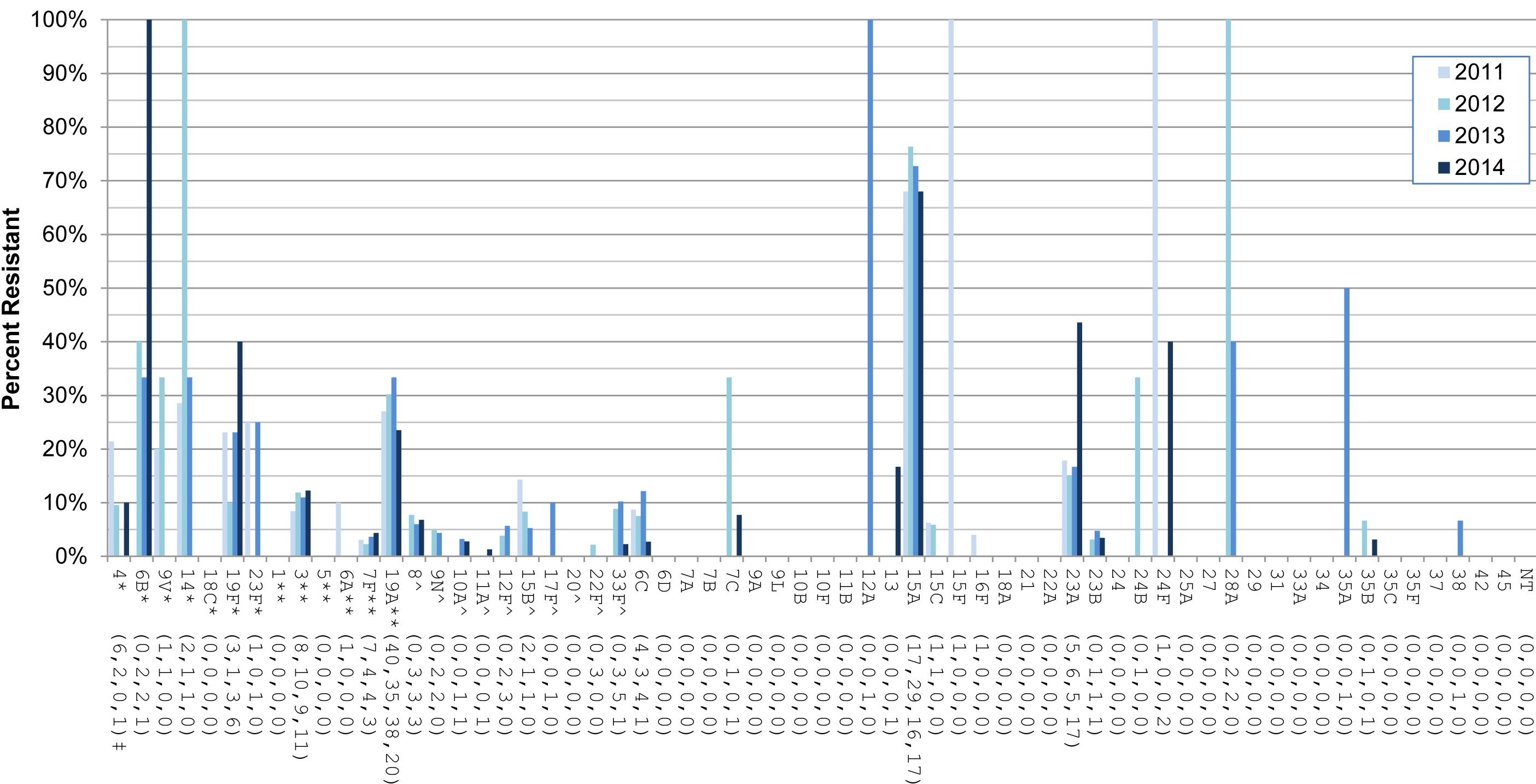
*Component of PCV7; ** Component of PCV13; ^ Component of PPV23; ‡ Number of resistant isolates for 2011, 2012, 2013 and 2014, respectively.
Text Equivalent
| Serotype | 2011 | 2012 | 2013 | 2014 |
|---|---|---|---|---|
Table Figure 25 Footnotes
|
||||
| 4Table Figure 25 Footnote 1 (6,2,0,1)Table Figure 25 Footnote 4 | 21.4% | 9.5% | 0.0% | 10.0% |
| 6BTable Figure 25 Footnote 1 (0,2,2,1) | 0.0% | 40.0% | 33.3% | 100.0% |
| 9VTable Figure 25 Footnote 1 (1,1,0,0) | 20.0% | 33.3% | 0.0% | 0.0% |
| 14Table Figure 25 Footnote 1 (2,1,1,0) | 28.6% | 100.0% | 33.3% | 0.0% |
| 18CTable Figure 25 Footnote 1 (0,0,0,0) | 0.0% | 0.0% | 0.0% | 0.0% |
| 19FTable Figure 25 Footnote 1 (3,1,3,6) | 23.1% | 10.0% | 23.1% | 40.0% |
| 23FTable Figure 25 Footnote 1 (1,0,1,0) | 25.0% | 0.0% | 25.0% | 0.0% |
| 1Table Figure 25 Footnote 2 (0,0,0,0) | 0.0% | 0.0% | 0.0% | 0.0% |
| 3Table Figure 25 Footnote 2 (8,10,9,11) | 8.4% | 11.9% | 11.0% | 12.2% |
| 5Table Figure 25 Footnote 2 (0,0,0,0) | 0.0% | 0.0% | 0.0% | 0.0% |
| 6ATable Figure 25 Footnote 2 (1,0,0,0) | 10.0% | 0.0% | 0.0% | 0.0% |
| 7FTable Figure 25 Footnote 2 (7,4,4,3) | 3.1% | 2.3% | 3.6% | 4.3% |
| 19ATable Figure 25 Footnote 2(40,35,38,20) | 27.0% | 30.2% | 33.3% | 23.5% |
| 8Table Figure 25 Footnote 3 (0,3,3,3) | 0.0% | 7.7% | 6.0% | 6.8% |
| 9NTable Figure 25 Footnote 3 (0,2,2,0) | 0.0% | 4.9% | 4.3% | 0.0% |
| 10ATable Figure 25 Footnote 3 (0,0,1,1) | 0.0% | 0.0% | 3.2% | 2.8% |
| 11ATable Figure 25 Footnote 3 (0,0,0,1) | 0.0% | 0.0% | 0.0% | 1.3% |
| 12FTable Figure 25 Footnote 3 (0,2,3,0) | 0.0% | 3.8% | 5.7% | 0.0% |
| 15BTable Figure 25 Footnote 3 (2,1,1,0) | 14.3% | 8.3% | 5.3% | 0.0% |
| 17FTable Figure 25 Footnote 3 (0,0,1,0) | 0.0% | 0.0% | 10.0% | 0.0% |
| 20Table Figure 25 Footnote 3 (0,0,0,0) | 0.0% | 0.0% | 0.0% | 0.0% |
| 22FTable Figure 25 Footnote 3 (0,3,0,0) | 0.0% | 2.2% | 0.0% | 0.0% |
| 33FTable Figure 25 Footnote 3 (0,3,5,1) | 0.0% | 8.8% | 10.2% | 2.3% |
| 6C (4,3,4,1) | 8.7% | 7.5% | 12.1% | 2.7% |
| 6D (0,0,0,0) | 0.0% | 0.0% | 0.0% | 0.0% |
| 7A (0,0,0,0) | 0.0% | 0.0% | 0.0% | 0.0% |
| 7B (0,0,0,0) | 0.0% | 0.0% | 0.0% | 0.0% |
| 7C (0,1,0,1) | 0.0% | 33.3% | 0.0% | 7.7% |
| 9A (0,0,0,0) | 0.0% | 0.0% | 0.0% | 0.0% |
| 9L (0,0,0,0) | 0.0% | 0.0% | 0.0% | 0.0% |
| 10B (0,0,0,0) | 0.0% | 0.0% | 0.0% | 0.0% |
| 10F (0,0,0,0) | 0.0% | 0.0% | 0.0% | 0.0% |
| 11B (0,0,0,0) | 0.0% | 0.0% | 0.0% | 0.0% |
| 12A (0,0,1,0) | 0.0% | 0.0% | 100.0% | 0.0% |
| 13 (0,0,0,1) | 0.0% | 0.0% | 0.0% | 16.7% |
| 15A (17,29,16,17) | 68.0% | 76.3% | 72.7% | 68.0% |
| 15C (1,1,0,0) | 6.3% | 5.9% | 0.0% | 0.0% |
| 15F (1,0,0,0) | 100.0% | 0.0% | 0.0% | 0.0% |
| 16F (1,0,0,0) | 4.0% | 0.0% | 0.0% | 0.0% |
| 18A (0,0,0,0) | 0.0% | 0.0% | 0.0% | 0.0% |
| 21 (0,0,0,0) | 0.0% | 0.0% | 0.0% | 0.0% |
| 22A (0,0,0,0) | 0.0% | 0.0% | 0.0% | 0.0% |
| 23A (5,6,5,17) | 17.9% | 15.0% | 16.7% | 43.6% |
| 23B (0,1,1,1) | 0.0% | 3.1% | 4.8% | 3.4% |
| 24 (0,0,0,0) | 0.0% | 0.0% | 0.0% | 0.0% |
| 24B (0,1,0,0) | 0.0% | 33.3% | 0.0% | 0.0% |
| 24F (1,0,0,2) | 100.0% | 0.0% | 0.0% | 40.0% |
| 25A (0,0,0,0) | 0.0% | 0.0% | 0.0% | 0.0% |
| 27 (0,0,0,0) | 0.0% | 0.0% | 0.0% | 0.0% |
| 28A (0,2,2,0) | 0.0% | 100.0% | 40.0% | 0.0% |
| 29 (0,0,0,0) | 0.0% | 0.0% | 0.0% | 0.0% |
| 31 (0,0,0,0) | 0.0% | 0.0% | 0.0% | 0.0% |
| 33A (0,0,0,0) | 0.0% | 0.0% | 0.0% | 0.0% |
| 34 (0,0,0,0) | 0.0% | 0.0% | 0.0% | 0.0% |
| 35A (0,0,1,0) | 0.0% | 0.0% | 50.0% | 0.0% |
| 35B (0,1,0,1) | 0.0% | 6.7% | 0.0% | 3.1% |
| 35C (0,0,0,0) | 0.0% | 0.0% | 0.0% | 0.0% |
| 35F (0,0,0,0) | 0.0% | 0.0% | 0.0% | 0.0% |
| 37 (0,0,0,0) | 0.0% | 0.0% | 0.0% | 0.0% |
| 38 (0,0,1,0) | 0.0% | 0.0% | 6.7% | 0.0% |
| 42 (0,0,0,0) | 0.0% | 0.0% | 0.0% | 0.0% |
| 45 (0,0,0,0) | 0.0% | 0.0% | 0.0% | 0.0% |
| NT (0,0,0,0) | 0.0% | 0.0% | 0.0% | 0.0% |
Figure 26. Imipenem resistance of S. pneumoniae serotypes collected 2011 – 2014
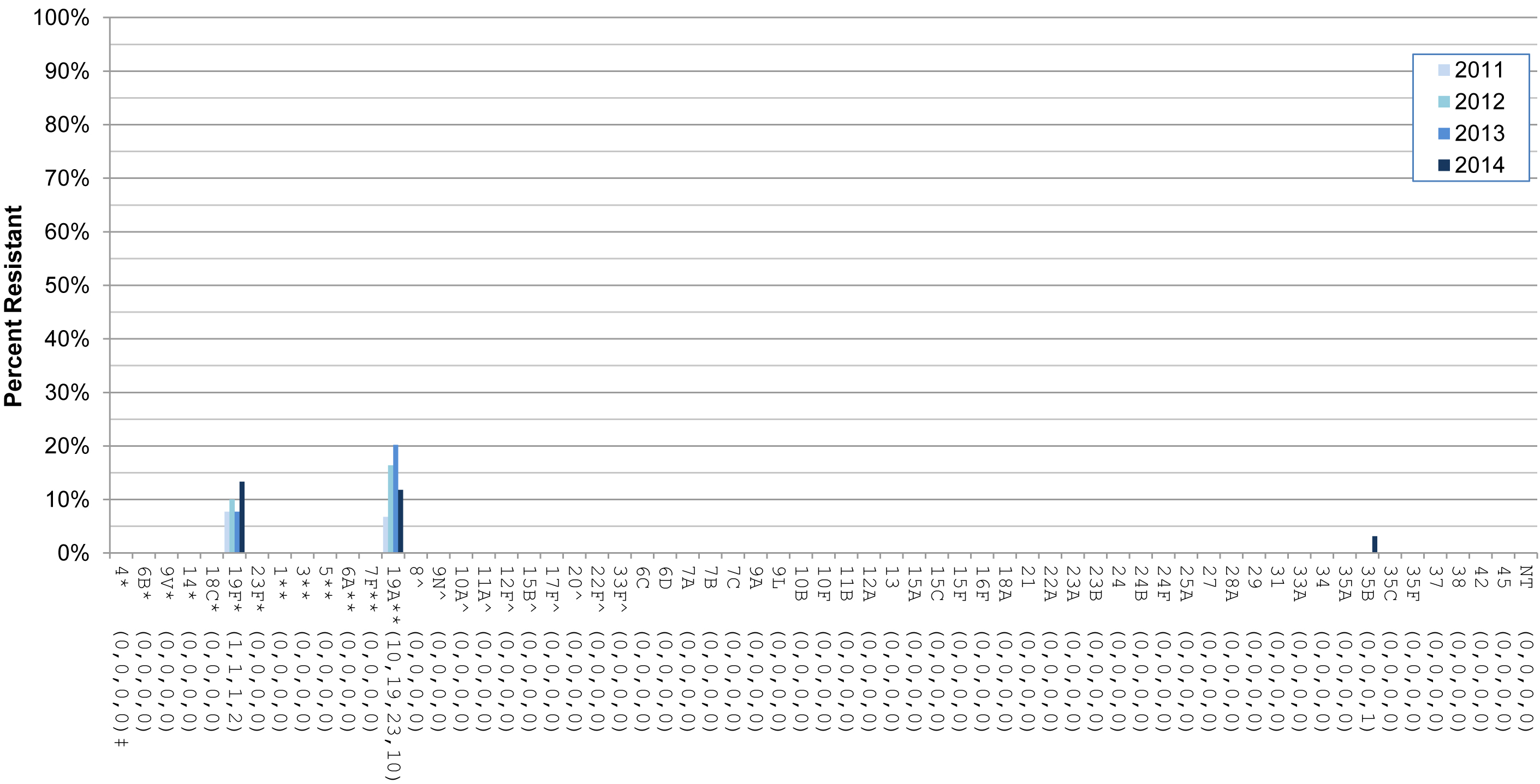
*Component of PCV7; ** Component of PCV13; ^ Component of PPV23; ‡ Number of resistant isolates for 2011, 2012, 2013 and 2014, respectively.
Text Equivalent
| Serotype | 2010 | 2011 | 2012 | 2014 |
|---|---|---|---|---|
Table Figure 26 Footnotes
|
||||
| 4Table Figure 26 Footnote 1 (0,0,0,0)Table Figure 26 Footnote 4 | 0.0% | 0.0% | 0.0% | 0.0% |
| 6BTable Figure 26 Footnote 1 (0,0,0,0) | 0.0% | 0.0% | 0.0% | 0.0% |
| 9VTable Figure 26 Footnote 1 (0,0,0,0) | 0.0% | 0.0% | 0.0% | 0.0% |
| 14Table Figure 26 Footnote 1 (0,0,0,0) | 0.0% | 0.0% | 0.0% | 0.0% |
| 18CTable Figure 26 Footnote 1 (0,0,0,0) | 0.0% | 0.0% | 0.0% | 0.0% |
| 19FTable Figure 26 Footnote 1 (1,1,1,2) | 7.7% | 10.0% | 7.7% | 13.3% |
| 23FTable Figure 26 Footnote 1 (0,0,0,0) | 0.0% | 0.0% | 0.0% | 0.0% |
| 1Table Figure 26 Footnote 2 (0,0,0,0) | 0.0% | 0.0% | 0.0% | 0.0% |
| 3Table Figure 26 Footnote 2 (0,0,0,0) | 0.0% | 0.0% | 0.0% | 0.0% |
| 5Table Figure 26 Footnote 2 (0,0,0,0) | 0.0% | 0.0% | 0.0% | 0.0% |
| 6ATable Figure 26 Footnote 2 (0,0,0,0) | 0.0% | 0.0% | 0.0% | 0.0% |
| 7FTable Figure 26 Footnote 2 (0,0,0,0) | 0.0% | 0.0% | 0.0% | 0.0% |
| 19ATable Figure 26 Footnote 2(10,19,23,10) | 6.8% | 16.4% | 20.2% | 11.8% |
| 8Table Figure 26 Footnote 3 (0,0,0,0) | 0.0% | 0.0% | 0.0% | 0.0% |
| 9NTable Figure 26 Footnote 3 (0,0,0,0) | 0.0% | 0.0% | 0.0% | 0.0% |
| 10ATable Figure 26 Footnote 3 (0,0,0,0) | 0.0% | 0.0% | 0.0% | 0.0% |
| 11ATable Figure 26 Footnote 3 (0,0,0,0) | 0.0% | 0.0% | 0.0% | 0.0% |
| 12FTable Figure 26 Footnote 3 (0,0,0,0) | 0.0% | 0.0% | 0.0% | 0.0% |
| 15BTable Figure 26 Footnote 3 (0,0,0,0) | 0.0% | 0.0% | 0.0% | 0.0% |
| 17FTable Figure 26 Footnote 3 (0,0,0,0) | 0.0% | 0.0% | 0.0% | 0.0% |
| 20Table Figure 26 Footnote 3 (0,0,0,0) | 0.0% | 0.0% | 0.0% | 0.0% |
| 22FTable Figure 26 Footnote 3 (0,0,0,0) | 0.0% | 0.0% | 0.0% | 0.0% |
| 33FTable Figure 26 Footnote 3 (0,0,0,0) | 0.0% | 0.0% | 0.0% | 0.0% |
| 6C (0,0,0,0) | 0.0% | 0.0% | 0.0% | 0.0% |
| 6D (0,0,0,0) | 0.0% | 0.0% | 0.0% | 0.0% |
| 7A (0,0,0,0) | 0.0% | 0.0% | 0.0% | 0.0% |
| 7B (0,0,0,0) | 0.0% | 0.0% | 0.0% | 0.0% |
| 7C (0,0,0,0) | 0.0% | 0.0% | 0.0% | 0.0% |
| 9A (0,0,0,0) | 0.0% | 0.0% | 0.0% | 0.0% |
| 9L (0,0,0,0) | 0.0% | 0.0% | 0.0% | 0.0% |
| 10B (0,0,0,0) | 0.0% | 0.0% | 0.0% | 0.0% |
| 10F (0,0,0,0) | 0.0% | 0.0% | 0.0% | 0.0% |
| 11B (0,0,0,0) | 0.0% | 0.0% | 0.0% | 0.0% |
| 12A (0,0,0,0) | 0.0% | 0.0% | 0.0% | 0.0% |
| 13 (0,0,0,0) | 0.0% | 0.0% | 0.0% | 0.0% |
| 15A (0,0,0,0) | 0.0% | 0.0% | 0.0% | 0.0% |
| 15C (0,0,0,0) | 0.0% | 0.0% | 0.0% | 0.0% |
| 15F (0,0,0,0) | 0.0% | 0.0% | 0.0% | 0.0% |
| 16F (0,0,0,0) | 0.0% | 0.0% | 0.0% | 0.0% |
| 18A (0,0,0,0) | 0.0% | 0.0% | 0.0% | 0.0% |
| 21 (0,0,0,0) | 0.0% | 0.0% | 0.0% | 0.0% |
| 22A (0,0,0,0) | 0.0% | 0.0% | 0.0% | 0.0% |
| 23A (0,0,0,0) | 0.0% | 0.0% | 0.0% | 0.0% |
| 23B (0,0,0,0) | 0.0% | 0.0% | 0.0% | 0.0% |
| 24 (0,0,0,0) | 0.0% | 0.0% | 0.0% | 0.0% |
| 24B (0,0,0,0) | 0.0% | 0.0% | 0.0% | 0.0% |
| 24F (0,0,0,0) | 0.0% | 0.0% | 0.0% | 0.0% |
| 25A (0,0,0,0) | 0.0% | 0.0% | 0.0% | 0.0% |
| 27 (0,0,0,0) | 0.0% | 0.0% | 0.0% | 0.0% |
| 28A (0,0,0,0) | 0.0% | 0.0% | 0.0% | 0.0% |
| 29 (0,0,0,0) | 0.0% | 0.0% | 0.0% | 0.0% |
| 31 (0,0,0,0) | 0.0% | 0.0% | 0.0% | 0.0% |
| 33A (0,0,0,0) | 0.0% | 0.0% | 0.0% | 0.0% |
| 34 (0,0,0,0) | 0.0% | 0.0% | 0.0% | 0.0% |
| 35A (0,0,0,0) | 0.0% | 0.0% | 0.0% | 0.0% |
| 35B (0,0,0,1) | 0.0% | 0.0% | 0.0% | 3.1% |
| 35C (0,0,0,0) | 0.0% | 0.0% | 0.0% | 0.0% |
| 35F (0,0,0,0) | 0.0% | 0.0% | 0.0% | 0.0% |
| 37 (0,0,0,0) | 0.0% | 0.0% | 0.0% | 0.0% |
| 38 (0,0,0,0) | 0.0% | 0.0% | 0.0% | 0.0% |
| 42 (0,0,0,0) | 0.0% | 0.0% | 0.0% | 0.0% |
| 45 (0,0,0,0) | 0.0% | 0.0% | 0.0% | 0.0% |
| NT (0,0,0,0) | 0.0% | 0.0% | 0.0% | 0.0% |
Figure 27. Meropenem resistance of S. pneumoniae serotypes collected 2011 – 2014
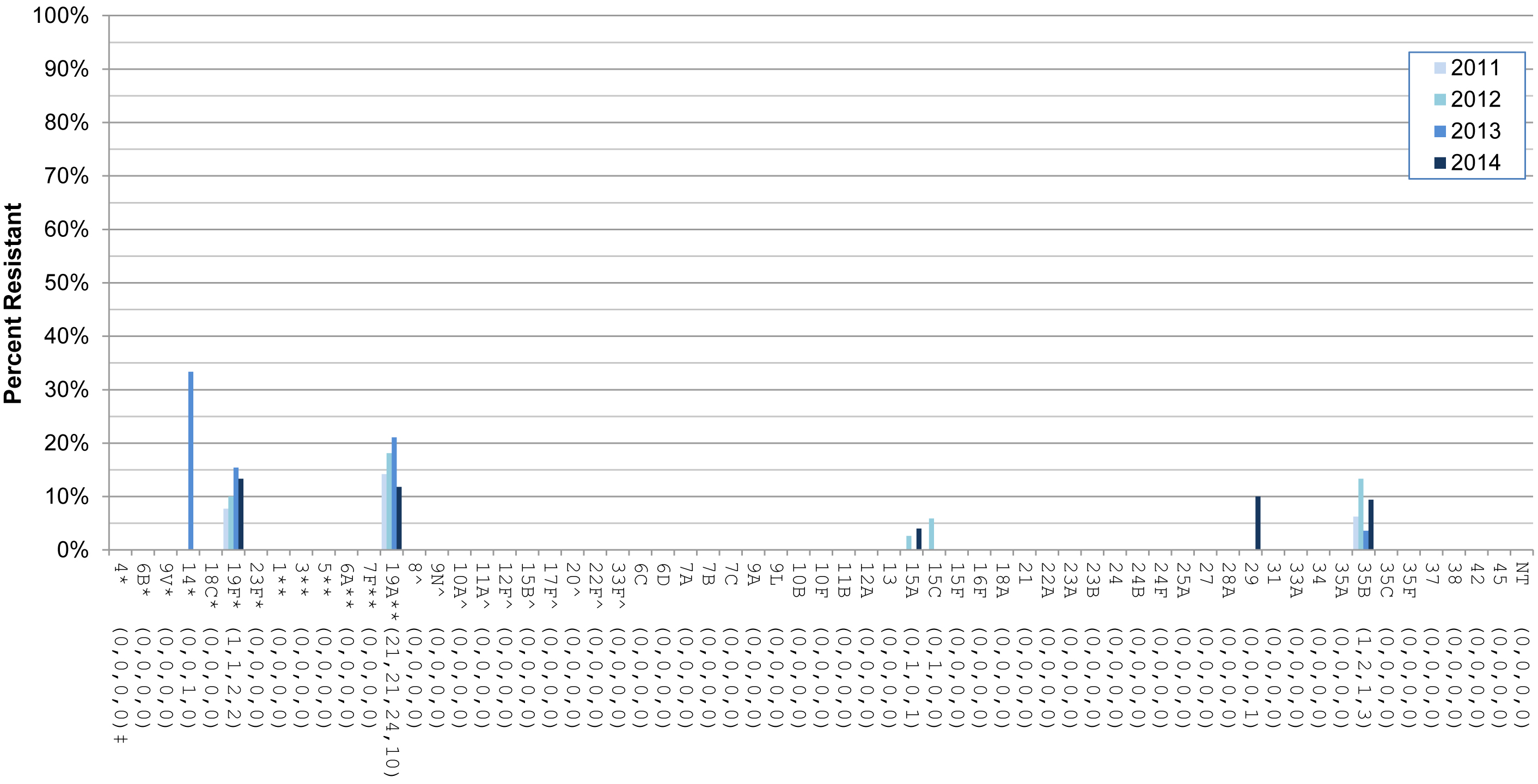
*Component of PCV7; ** Component of PCV13; ^ Component of PPV23; ‡ Number of resistant isolates for 2011, 2012, 2013 and 2014, respectively.
Text Equivalent
| Serotype | 2011 | 2012 | 2013 | 2014 |
|---|---|---|---|---|
Table Figure 27 Footnotes
|
||||
| 4Table Figure 27 Footnote 1 (0,0,0,0)Table Figure 27 Footnote 4 | 0.0% | 0.0% | 0.0% | 0.0% |
| 6BTable Figure 27 Footnote 1 (0,0,0,0) | 0.0% | 0.0% | 0.0% | 0.0% |
| 9VTable Figure 27 Footnote 1 (0,0,0,0) | 0.0% | 0.0% | 0.0% | 0.0% |
| 14Table Figure 27 Footnote 1 (0,0,1,0) | 0.0% | 0.0% | 33.3% | 0.0% |
| 18CTable Figure 27 Footnote 1 (0,0,0,0) | 0.0% | 0.0% | 0.0% | 0.0% |
| 19FTable Figure 27 Footnote 1 (1,1,2,2) | 7.7% | 10.0% | 15.4% | 13.3% |
| 23FTable Figure 27 Footnote 1 (0,0,0,0) | 0.0% | 0.0% | 0.0% | 0.0% |
| 1Table Figure 27 Footnote 2 (0,0,0,0) | 0.0% | 0.0% | 0.0% | 0.0% |
| 3Table Figure 27 Footnote 2 (0,0,0,0) | 0.0% | 0.0% | 0.0% | 0.0% |
| 5Table Figure 27 Footnote 2 (0,0,0,0) | 0.0% | 0.0% | 0.0% | 0.0% |
| 6ATable Figure 27 Footnote 2 (0,0,0,0) | 0.0% | 0.0% | 0.0% | 0.0% |
| 7FTable Figure 27 Footnote 2 (0,0,0,0) | 0.0% | 0.0% | 0.0% | 0.0% |
| 19ATable Figure 27 Footnote 2(21,21,24,10) | 14.2% | 18.1% | 21.1% | 11.8% |
| 8Table Figure 27 Footnote 3 (0,0,0,0) | 0.0% | 0.0% | 0.0% | 0.0% |
| 9NTable Figure 27 Footnote 3 (0,0,0,0) | 0.0% | 0.0% | 0.0% | 0.0% |
| 10ATable Figure 27 Footnote 3 (0,0,0,0) | 0.0% | 0.0% | 0.0% | 0.0% |
| 11ATable Figure 27 Footnote 3 (0,0,0,0) | 0.0% | 0.0% | 0.0% | 0.0% |
| 12FTable Figure 27 Footnote 3 (0,0,0,0) | 0.0% | 0.0% | 0.0% | 0.0% |
| 15BTable Figure 27 Footnote 3 (0,0,0,0) | 0.0% | 0.0% | 0.0% | 0.0% |
| 17FTable Figure 27 Footnote 3 (0,0,0,0) | 0.0% | 0.0% | 0.0% | 0.0% |
| 20Table Figure 27 Footnote 3 (0,0,0,0) | 0.0% | 0.0% | 0.0% | 0.0% |
| 22FTable Figure 27 Footnote 3 (0,0,0,0) | 0.0% | 0.0% | 0.0% | 0.0% |
| 33FTable Figure 27 Footnote 3 (0,0,0,0) | 0.0% | 0.0% | 0.0% | 0.0% |
| 6C (0,0,0,0) | 0.0% | 0.0% | 0.0% | 0.0% |
| 6D (0,0,0,0) | 0.0% | 0.0% | 0.0% | 0.0% |
| 7A (0,0,0,0) | 0.0% | 0.0% | 0.0% | 0.0% |
| 7B (0,0,0,0) | 0.0% | 0.0% | 0.0% | 0.0% |
| 7C (0,0,0,0) | 0.0% | 0.0% | 0.0% | 0.0% |
| 9A (0,0,0,0) | 0.0% | 0.0% | 0.0% | 0.0% |
| 9L (0,0,0,0) | 0.0% | 0.0% | 0.0% | 0.0% |
| 10B (0,0,0,0) | 0.0% | 0.0% | 0.0% | 0.0% |
| 10F (0,0,0,0) | 0.0% | 0.0% | 0.0% | 0.0% |
| 11B (0,0,0,0) | 0.0% | 0.0% | 0.0% | 0.0% |
| 12A (0,0,0,0) | 0.0% | 0.0% | 0.0% | 0.0% |
| 13 (0,0,0,0) | 0.0% | 0.0% | 0.0% | 0.0% |
| 15A (0,1,0,1) | 0.0% | 2.6% | 0.0% | 4.0% |
| 15C (0,1,0,0) | 0.0% | 5.9% | 0.0% | 0.0% |
| 15F (0,0,0,0) | 0.0% | 0.0% | 0.0% | 0.0% |
| 16F (0,0,0,0) | 0.0% | 0.0% | 0.0% | 0.0% |
| 18A (0,0,0,0) | 0.0% | 0.0% | 0.0% | 0.0% |
| 21 (0,0,0,0) | 0.0% | 0.0% | 0.0% | 0.0% |
| 22A (0,0,0,0) | 0.0% | 0.0% | 0.0% | 0.0% |
| 23A (0,0,0,0) | 0.0% | 0.0% | 0.0% | 0.0% |
| 23B (0,0,0,0) | 0.0% | 0.0% | 0.0% | 0.0% |
| 24 (0,0,0,0) | 0.0% | 0.0% | 0.0% | 0.0% |
| 24B (0,0,0,0) | 0.0% | 0.0% | 0.0% | 0.0% |
| 24F (0,0,0,0) | 0.0% | 0.0% | 0.0% | 0.0% |
| 25A (0,0,0,0) | 0.0% | 0.0% | 0.0% | 0.0% |
| 27 (0,0,0,0) | 0.0% | 0.0% | 0.0% | 0.0% |
| 28A (0,0,0,0) | 0.0% | 0.0% | 0.0% | 0.0% |
| 29 (0,0,0,1) | 0.0% | 0.0% | 0.0% | 10.0% |
| 31 (0,0,0,0) | 0.0% | 0.0% | 0.0% | 0.0% |
| 33A (0,0,0,0) | 0.0% | 0.0% | 0.0% | 0.0% |
| 34 (0,0,0,0) | 0.0% | 0.0% | 0.0% | 0.0% |
| 35A (0,0,0,0) | 0.0% | 0.0% | 0.0% | 0.0% |
| 35B (1,2,1,3) | 6.3% | 13.3% | 3.6% | 9.4% |
| 35C (0,0,0,0) | 0.0% | 0.0% | 0.0% | 0.0% |
| 35F (0,0,0,0) | 0.0% | 0.0% | 0.0% | 0.0% |
| 37 (0,0,0,0) | 0.0% | 0.0% | 0.0% | 0.0% |
| 38 (0,0,0,0) | 0.0% | 0.0% | 0.0% | 0.0% |
| 42 (0,0,0,0) | 0.0% | 0.0% | 0.0% | 0.0% |
| 45 (0,0,0,0) | 0.0% | 0.0% | 0.0% | 0.0% |
| NT (0,0,0,0) | 0.0% | 0.0% | 0.0% | 0.0% |
Figure 28. Penicillin resistance (meningitis breakpoints) of S. pneumoniae serotypes collected 2011 – 2014
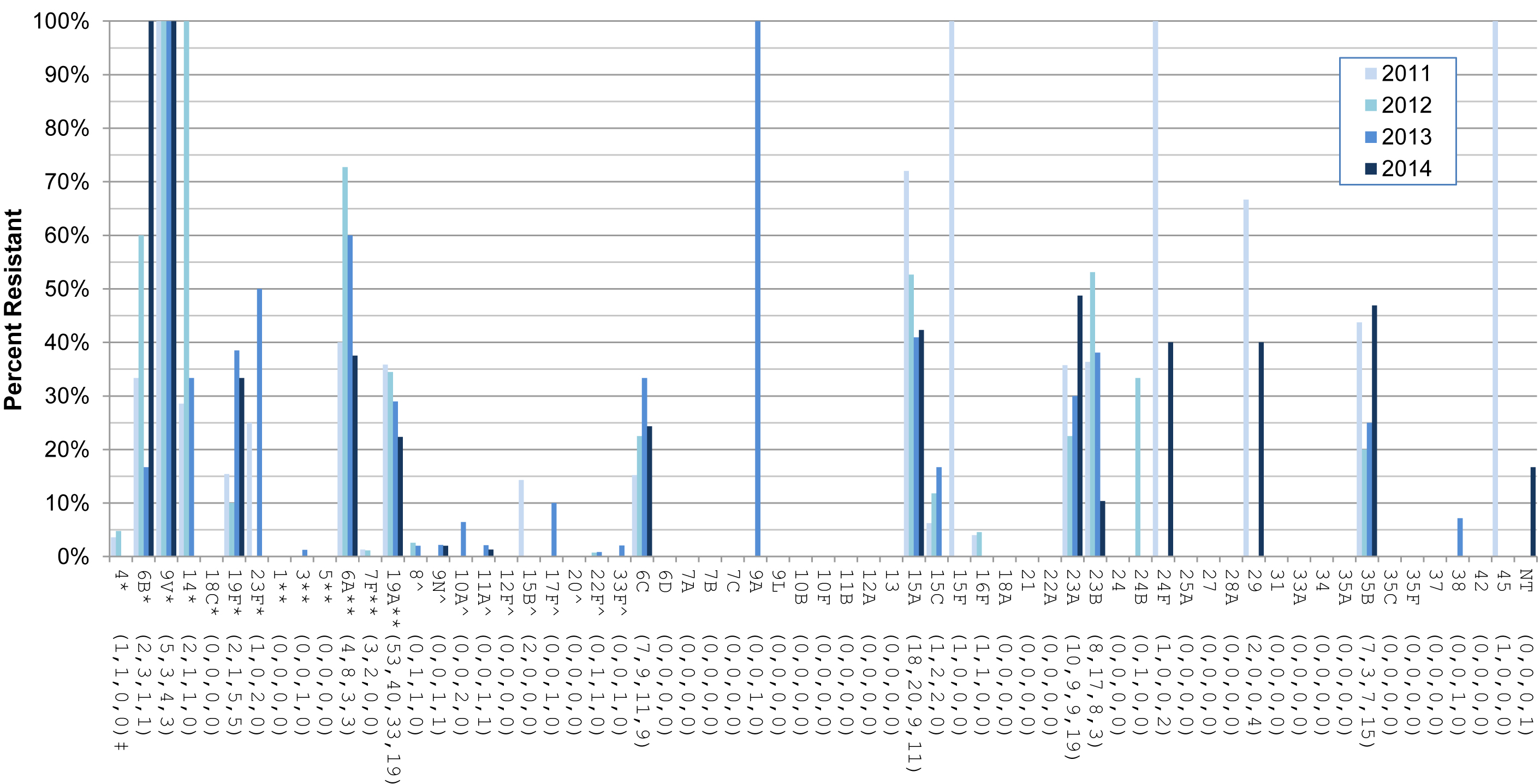
*Component of PCV7; ** Component of PCV13; ^ Component of PPV23; ‡ Number of resistant isolates for 2011, 2012, 2013 and 2014, respectively.
Text Equivalent
| Serotype | 2011 | 2012 | 2013 | 2014 |
|---|---|---|---|---|
Table Figure 28 Footnotes
|
||||
| 4Table Figure 28 Footnote 1 (1,1,0,0)Table Figure 28 Footnote 4 | 3.6% | 4.8% | 0.0% | 0.0% |
| 6BTable Figure 28 Footnote 1 (2,3,1,1) | 33.3% | 60.0% | 16.7% | 100.0% |
| 9VTable Figure 28 Footnote 1 (5,3,4,3) | 100.0% | 100.0% | 100.0% | 100.0% |
| 14Table Figure 28 Footnote 1 (2,1,1,0) | 28.6% | 100.0% | 33.3% | 0.0% |
| 18CTable Figure 28 Footnote 1 (0,0,0,0) | 0.0% | 0.0% | 0.0% | 0.0% |
| 19FTable Figure 28 Footnote 1 (2,1,5,5) | 15.4% | 10.0% | 38.5% | 33.3% |
| 23FTable Figure 28 Footnote 1 (1,0,2,0) | 25.0% | 0.0% | 50.0% | 0.0% |
| 1Table Figure 28 Footnote 2 (0,0,0,0) | 0.0% | 0.0% | 0.0% | 0.0% |
| 3Table Figure 28 Footnote 2 (0,0,1,0) | 0.0% | 0.0% | 1.2% | 0.0% |
| 5Table Figure 28 Footnote 2 (0,0,0,0) | 0.0% | 0.0% | 0.0% | 0.0% |
| 6ATable Figure 28 Footnote 2 (4,8,3,3) | 40.0% | 72.7% | 60.0% | 37.5% |
| 7FTable Figure 28 Footnote 2 (3,2,0,0) | 1.3% | 1.1% | 0.0% | 0.0% |
| 19ATable Figure 28 Footnote 2(53,40,33,19) | 35.8% | 34.5% | 28.9% | 22.4% |
| 8Table Figure 28 Footnote 3 (0,1,1,0) | 0.0% | 2.6% | 2.0% | 0.0% |
| 9NTable Figure 28 Footnote 3 (0,0,1,1) | 0.0% | 0.0% | 2.2% | 2.0% |
| 10ATable Figure 28 Footnote 3 (0,0,2,0) | 0.0% | 0.0% | 6.5% | 0.0% |
| 11ATable Figure 28 Footnote 3 (0,0,1,1) | 0.0% | 0.0% | 2.1% | 1.3% |
| 12FTable Figure 28 Footnote 3 (0,0,0,0) | 0.0% | 0.0% | 0.0% | 0.0% |
| 15BTable Figure 28 Footnote 3 (2,0,0,0) | 14.3% | 0.0% | 0.0% | 0.0% |
| 17FTable Figure 28 Footnote 3 (0,0,1,0) | 0.0% | 0.0% | 10.0% | 0.0% |
| 20Table Figure 28 Footnote 3 (0,0,0,0) | 0.0% | 0.0% | 0.0% | 0.0% |
| 22FTable Figure 28 Footnote 3 (0,1,1,0) | 0.0% | 0.7% | 0.8% | 0.0% |
| 33FTable Figure 28 Footnote 3 (0,0,1,0) | 0.0% | 0.0% | 2.0% | 0.0% |
| 6C (7,9,11,9) | 15.2% | 22.5% | 33.3% | 24.3% |
| 6D (0,0,0,0) | 0.0% | 0.0% | 0.0% | 0.0% |
| 7A (0,0,0,0) | 0.0% | 0.0% | 0.0% | 0.0% |
| 7B (0,0,0,0) | 0.0% | 0.0% | 0.0% | 0.0% |
| 7C (0,0,0,0) | 0.0% | 0.0% | 0.0% | 0.0% |
| 9A (0,0,1,0) | 0.0% | 0.0% | 100.0% | 0.0% |
| 9L (0,0,0,0) | 0.0% | 0.0% | 0.0% | 0.0% |
| 10B (0,0,0,0) | 0.0% | 0.0% | 0.0% | 0.0% |
| 10F (0,0,0,0) | 0.0% | 0.0% | 0.0% | 0.0% |
| 11B (0,0,0,0) | 0.0% | 0.0% | 0.0% | 0.0% |
| 12A (0,0,0,0) | 0.0% | 0.0% | 0.0% | 0.0% |
| 13 (0,0,0,0) | 0.0% | 0.0% | 0.0% | 0.0% |
| 15A (18,20,9,11) | 72.0% | 52.6% | 40.9% | 42.3% |
| 15C (1,2,2,0) | 6.3% | 11.8% | 16.7% | 0.0% |
| 15F (1,0,0,0) | 100.0% | 0.0% | 0.0% | 0.0% |
| 16F (1,1,0,0) | 4.0% | 4.5% | 0.0% | 0.0% |
| 18A (0,0,0,0) | 0.0% | 0.0% | 0.0% | 0.0% |
| 21 (0,0,0,0) | 0.0% | 0.0% | 0.0% | 0.0% |
| 22A (0,0,0,0) | 0.0% | 0.0% | 0.0% | 0.0% |
| 23A (10,9,9,19) | 35.7% | 22.5% | 30.0% | 48.7% |
| 23B (8,17,8,3) | 36.4% | 53.1% | 38.1% | 10.3% |
| 24 (0,0,0,0) | 0.0% | 0.0% | 0.0% | 0.0% |
| 24B (0,1,0,0) | 0.0% | 33.3% | 0.0% | 0.0% |
| 24F (1,0,0,2) | 100.0% | 0.0% | 0.0% | 40.0% |
| 25A (0,0,0,0) | 0.0% | 0.0% | 0.0% | 0.0% |
| 27 (0,0,0,0) | 0.0% | 0.0% | 0.0% | 0.0% |
| 28A (0,0,0,0) | 0.0% | 0.0% | 0.0% | 0.0% |
| 29 (2,0,0,4) | 66.7% | 0.0% | 0.0% | 40.0% |
| 31 (0,0,0,0) | 0.0% | 0.0% | 0.0% | 0.0% |
| 33A (0,0,0,0) | 0.0% | 0.0% | 0.0% | 0.0% |
| 34 (0,0,0,0) | 0.0% | 0.0% | 0.0% | 0.0% |
| 35A (0,0,0,0) | 0.0% | 0.0% | 0.0% | 0.0% |
| 35B (7,3,7,15) | 43.8% | 20.0% | 25.0% | 46.9% |
| 35C (0,0,0,0) | 0.0% | 0.0% | 0.0% | 0.0% |
| 35F (0,0,0,0) | 0.0% | 0.0% | 0.0% | 0.0% |
| 37 (0,0,0,0) | 0.0% | 0.0% | 0.0% | 0.0% |
| 38 (0,0,1,0) | 0.0% | 0.0% | 7.1% | 0.0% |
| 42 (0,0,0,0) | 0.0% | 0.0% | 0.0% | 0.0% |
| 45 (1,0,0,0) | 100.0% | 0.0% | 0.0% | 0.0% |
| NT (0,0,0,1) | 0.0% | 0.0% | 0.0% | 16.7% |
Figure 29. Trimethoprim/Sulfamethoxazole resistance of S. pneumoniae serotypes collected 2011 – 2014
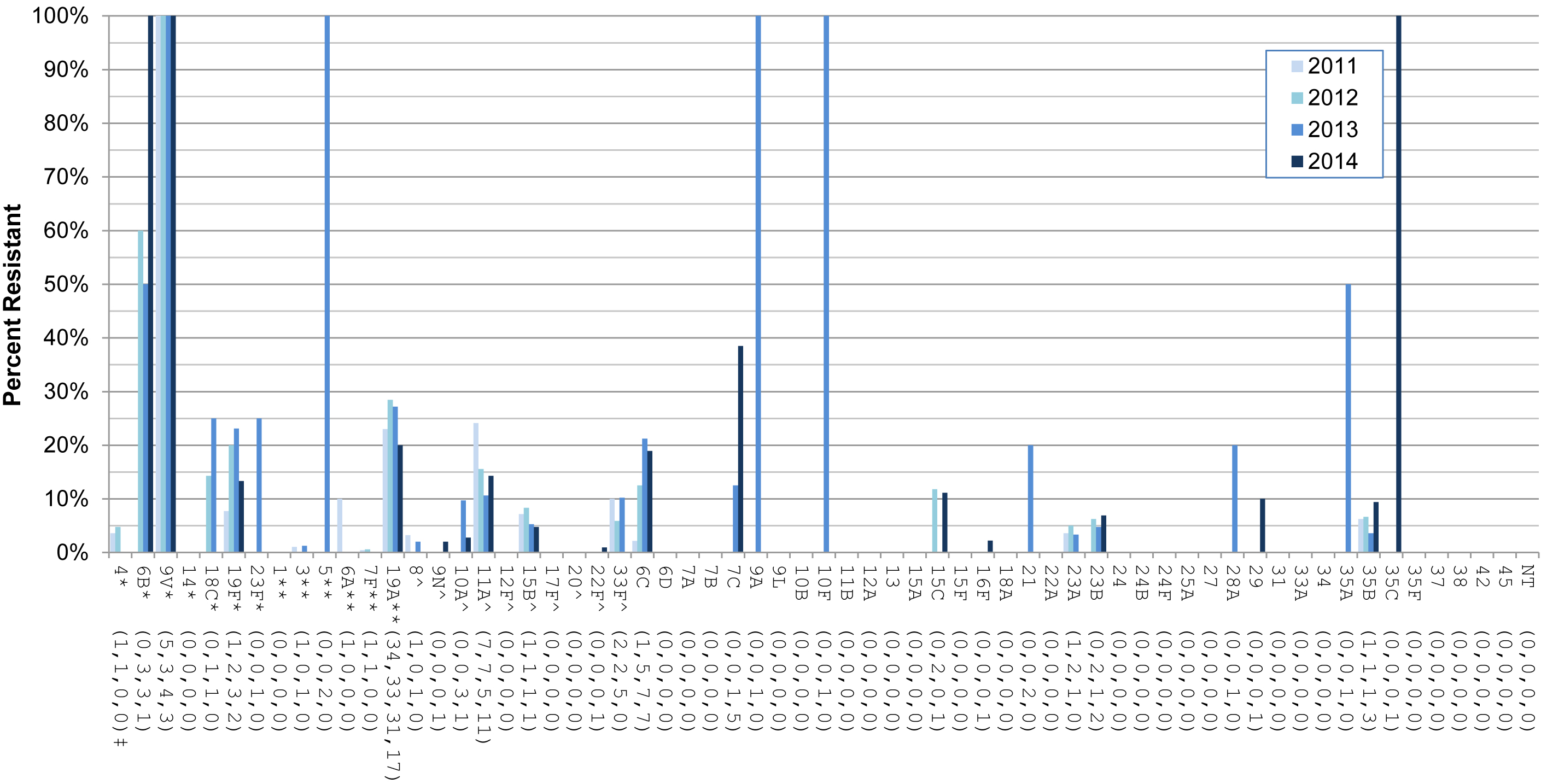
*Component of PCV7; ** Component of PCV13; ^ Component of PPV23; ‡ Number of resistant isolates for 2011, 2012, 2013 and 2014, respectively.
Text Equivalent
| Serotype | 2011 | 2012 | 2013 | 2014 |
|---|---|---|---|---|
Table Figure Footnotes
|
||||
| 4Table Figure 29 Footnote 1 (1,1,0,0)Table Figure 29 Footnote 4 | 3.6% | 4.8% | 0.0% | 0.0% |
| 6BTable Figure 29 Footnote 1 (0,3,3,1) | 0.0% | 60.0% | 50.0% | 100.0% |
| 9VTable Figure 29 Footnote 1 (5,3,4,3) | 100.0% | 100.0% | 100.0% | 100.0% |
| 14Table Figure 29 Footnote 1 (0,0,0,0) | 0.0% | 0.0% | 0.0% | 0.0% |
| 18CTable Figure 29 Footnote 1 (0,1,1,0) | 0.0% | 14.3% | 25.0% | 0.0% |
| 19FTable Figure 29 Footnote 1 (1,2,3,2) | 7.7% | 20.0% | 23.1% | 13.3% |
| 23FTable Figure 29 Footnote 1 (0,0,1,0) | 0.0% | 0.0% | 25.0% | 0.0% |
| 1Table Figure 29 Footnote 2 (0,0,0,0) | 0.0% | 0.0% | 0.0% | 0.0% |
| 3Table Figure 29 Footnote 2 (1,0,1,0) | 1.1% | 0.0% | 1.2% | 0.0% |
| 5Table Figure 29 Footnote 2 (0,0,2,0) | 0.0% | 0.0% | 100.0% | 0.0% |
| 6ATable Figure 29 Footnote 2 (1,0,0,0) | 10.0% | 0.0% | 0.0% | 0.0% |
| 7FTable Figure 29 Footnote 2 (1,1,0,0) | 0.4% | 0.6% | 0.0% | 0.0% |
| 19ATable Figure 29 Footnote 2(34,33,31,17) | 23.0% | 28.4% | 27.2% | 20.0% |
| 8Table Figure 29 Footnote 3 (1,0,1,0) | 3.2% | 0.0% | 2.0% | 0.0% |
| 9NTable Figure 29 Footnote 3 (0,0,0,1) | 0.0% | 0.0% | 0.0% | 2.0% |
| 10ATable Figure 29 Footnote 3 (0,0,3,1) | 0.0% | 0.0% | 9.7% | 2.8% |
| 11ATable Figure 29 Footnote 3 (7,7,5,11) | 24.1% | 15.6% | 10.6% | 14.3% |
| 12FTable Figure 29 Footnote 3 (0,0,0,0) | 0.0% | 0.0% | 0.0% | 0.0% |
| 15BTable Figure 29 Footnote 3 (1,1,1,1) | 7.1% | 8.3% | 5.3% | 4.8% |
| 17FTable Figure 29 Footnote 3 (0,0,0,0) | 0.0% | 0.0% | 0.0% | 0.0% |
| 20Table Figure 29 Footnote 3 (0,0,0,0) | 0.0% | 0.0% | 0.0% | 0.0% |
| 22FTable Figure 29 Footnote 3 (0,0,0,1) | 0.0% | 0.0% | 0.0% | 0.9% |
| 33FTable Figure 29 Footnote 3 (2,2,5,0) | 10.0% | 5.9% | 10.2% | 0.0% |
| 6C (1,5,7,7) | 2.2% | 12.5% | 21.2% | 18.9% |
| 6D (0,0,0,0) | 0.0% | 0.0% | 0.0% | 0.0% |
| 7A (0,0,0,0) | 0.0% | 0.0% | 0.0% | 0.0% |
| 7B (0,0,0,0) | 0.0% | 0.0% | 0.0% | 0.0% |
| 7C (0,0,1,5) | 0.0% | 0.0% | 12.5% | 38.5% |
| 9A (0,0,1,0) | 0.0% | 0.0% | 100.0% | 0.0% |
| 9L (0,0,0,0) | 0.0% | 0.0% | 0.0% | 0.0% |
| 10B (0,0,0,0) | 0.0% | 0.0% | 0.0% | 0.0% |
| 10F (0,0,1,0) | 0.0% | 0.0% | 100.0% | 0.0% |
| 11B (0,0,0,0) | 0.0% | 0.0% | 0.0% | 0.0% |
| 12A (0,0,0,0) | 0.0% | 0.0% | 0.0% | 0.0% |
| 13 (0,0,0,0) | 0.0% | 0.0% | 0.0% | 0.0% |
| 15A (0,0,0,0) | 0.0% | 0.0% | 0.0% | 0.0% |
| 15C (0,2,0,1) | 0.0% | 11.8% | 0.0% | 11.1% |
| 15F (0,0,0,0) | 0.0% | 0.0% | 0.0% | 0.0% |
| 16F (0,0,0,1) | 0.0% | 0.0% | 0.0% | 2.2% |
| 18A (0,0,0,0) | 0.0% | 0.0% | 0.0% | 0.0% |
| 21 (0,0,2,0) | 0.0% | 0.0% | 20.0% | 0.0% |
| 22A (0,0,0,0) | 0.0% | 0.0% | 0.0% | 0.0% |
| 23A (1,2,1,0) | 3.6% | 5.0% | 3.3% | 0.0% |
| 23B (0,2,1,2) | 0.0% | 6.3% | 4.8% | 6.9% |
| 24 (0,0,0,0) | 0.0% | 0.0% | 0.0% | 0.0% |
| 24B (0,0,0,0) | 0.0% | 0.0% | 0.0% | 0.0% |
| 24F (0,0,0,0) | 0.0% | 0.0% | 0.0% | 0.0% |
| 25A (0,0,0,0) | 0.0% | 0.0% | 0.0% | 0.0% |
| 27 (0,0,0,0) | 0.0% | 0.0% | 0.0% | 0.0% |
| 28A (0,0,1,0) | 0.0% | 0.0% | 20.0% | 0.0% |
| 29 (0,0,0,1) | 0.0% | 0.0% | 0.0% | 10.0% |
| 31 (0,0,0,0) | 0.0% | 0.0% | 0.0% | 0.0% |
| 33A (0,0,0,0) | 0.0% | 0.0% | 0.0% | 0.0% |
| 34 (0,0,0,0) | 0.0% | 0.0% | 0.0% | 0.0% |
| 35A (0,0,1,0) | 0.0% | 0.0% | 50.0% | 0.0% |
| 35B (1,1,1,3) | 6.3% | 6.7% | 3.6% | 9.4% |
| 35C (0,0,0,1) | 0.0% | 0.0% | 0.0% | 100.0% |
| 35F (0,0,0,0) | 0.0% | 0.0% | 0.0% | 0.0% |
| 37 (0,0,0,0) | 0.0% | 0.0% | 0.0% | 0.0% |
| 38 (0,0,0,0) | 0.0% | 0.0% | 0.0% | 0.0% |
| 42 (0,0,0,0) | 0.0% | 0.0% | 0.0% | 0.0% |
| 45 (0,0,0,0) | 0.0% | 0.0% | 0.0% | 0.0% |
| NT (0,0,0,0) | 0.0% | 0.0% | 0.0% | 0.0% |
Figure 30. Multi-drug resistance of S. pneumoniae serotypes, 2014
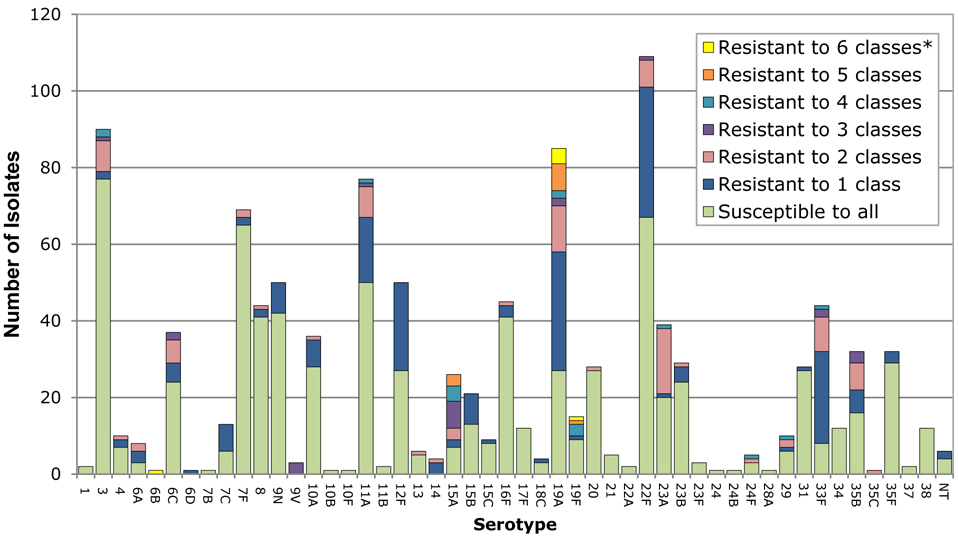
*Antimicrobial classes include: β-lactams (amoxicillin/clavulanic acid, penicillin using meninigitis breakpoints, ceftriaxone using meningitis breakpoints, cefuroxime using parenteral breakpoint, ertapenem, imipenem and meropenem); macrolides (clarithromycin); fluoroquinolones (levofloxacin and moxifloxacin); tetracyclines (doxycycline); folate pathway inhibitors (trimethoprim-sulfamethoxazole); phenicols (chloramphenicol); lincosamides (clindamycin); oxazolidinones (linezolid).
Text Equivalent
| Serotype | Susceptible to all | Resistant to 1 class | Resistant to 2 classes | Resistant to 3 classes | Resistant to 4 classes | Resistant to 5 classes | Resistant to 6 classesTable Figure 30 Footnote 1 |
|---|---|---|---|---|---|---|---|
Table Figure 30 Footnotes
|
|||||||
| 1 | 2 | ||||||
| 3 | 77 | 2 | 8 | 1 | 2 | ||
| 4 | 7 | 2 | 1 | ||||
| 6A | 3 | 3 | 2 | ||||
| 6B | 1 | ||||||
| 6C | 24 | 5 | 6 | 2 | |||
| 6D | 1 | ||||||
| 7B | 1 | ||||||
| 7C | 6 | 7 | |||||
| 7F | 65 | 2 | 2 | ||||
| 8 | 41 | 2 | 1 | ||||
| 9N | 42 | 8 | |||||
| 9V | 3 | ||||||
| 10A | 28 | 7 | 1 | ||||
| 10B | 1 | ||||||
| 10F | 1 | ||||||
| 11A | 50 | 17 | 8 | 1 | 1 | ||
| 11B | 2 | ||||||
| 12F | 27 | 23 | |||||
| 13 | 5 | 1 | |||||
| 14 | 3 | 1 | |||||
| 15A | 7 | 2 | 3 | 7 | 4 | 3 | |
| 15B | 13 | 8 | |||||
| 15C | 8 | 1 | |||||
| 16F | 41 | 3 | 1 | ||||
| 17F | 12 | ||||||
| 18C | 3 | 1 | |||||
| 19A | 27 | 31 | 12 | 2 | 2 | 7 | 4 |
| 19F | 9 | 1 | 3 | 1 | 1 | ||
| 20 | 27 | 1 | |||||
| 21 | 5 | ||||||
| 22A | 2 | ||||||
| 22F | 67 | 34 | 7 | 1 | |||
| 23A | 20 | 1 | 17 | 1 | |||
| 23B | 24 | 4 | 1 | ||||
| 23F | 3 | ||||||
| 24 | 1 | ||||||
| 24B | 1 | ||||||
| 24F | 3 | 1 | 1 | ||||
| 28A | 1 | ||||||
| 29 | 6 | 1 | 2 | 1 | |||
| 31 | 27 | 1 | |||||
| 33F | 8 | 24 | 9 | 2 | 1 | ||
| 34 | 12 | ||||||
| 35B | 16 | 6 | 7 | 3 | |||
| 35C | 1 | ||||||
| 35F | 29 | 3 | |||||
| 37 | 2 | ||||||
| 38 | 12 | ||||||
| NT | 4 | 2 | |||||
Figure 31. Multi-drug resistance of S. pneumoniae, 2011 - 2014
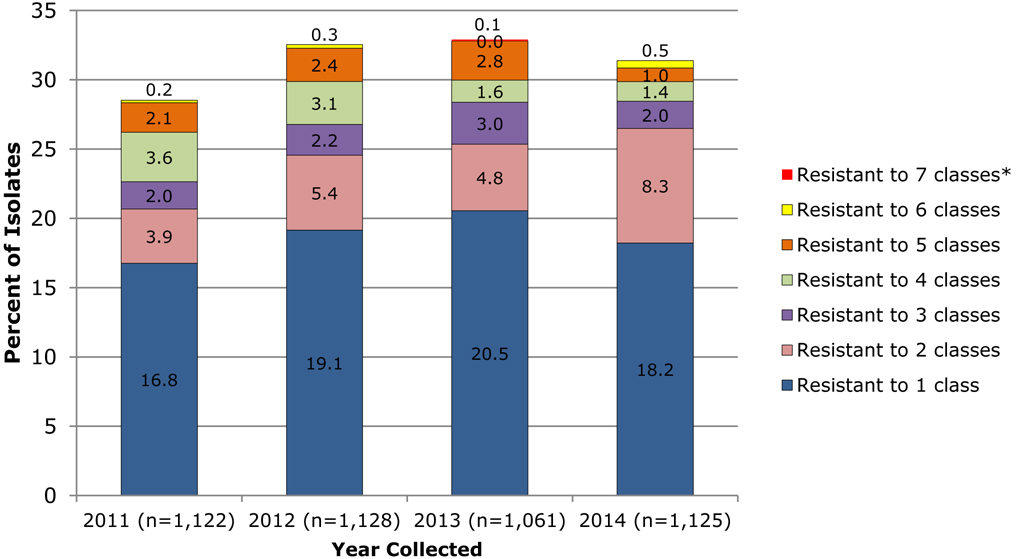
*Antimicrobial classes include: β-lactams (amoxicillin/clavulanic acid, penicillin using meninigitis breakpoints, ceftriaxone using meningitis breakpoints, cefuroxime using parenteral breakpoint, ertapenem, imipenem and meropenem); macrolides (clarithromycin); fluoroquinolones (levofloxacin and moxifloxacin); tetracyclines (doxycycline); folate pathway inhibitors (trimethoprim-sulfamethoxazole); phenicols (chloramphenicol); lincosamides (clindamycin); oxazolidinones (linezolid).
Text Equivalent
| Year | Resistant to 1 class | Resistant to 2 classes | Resistant to 3 classes | Resistant to 4 classes | Resistant to 5 classes | Resistant to 6 classes | Resistant to 7 classesTable Figure 31 Footnote 1 |
|---|---|---|---|---|---|---|---|
Table Figure 31 Footnotes
|
|||||||
| 2011 (n=1,122) | 16.8% | 3.9% | 2.0% | 3.6% | 2.1% | 0.2% | 0.0% |
| 2012 (n=1,128) | 19.1% | 5.4% | 2.2% | 3.1% | 2.4% | 0.3% | 0.0% |
| 2013 (n=1,061) | 20.5% | 4.8% | 3.0% | 1.6% | 2.8% | 0.0% | 0.1% |
| 2014 (n=1,125) | 18.2% | 8.3% | 2.0% | 1.4% | 1.0% | 0.5% | 0.0% |
| Multidrug Resistance Profile | |||||||||||||||||||||||||||||||||||
|---|---|---|---|---|---|---|---|---|---|---|---|---|---|---|---|---|---|---|---|---|---|---|---|---|---|---|---|---|---|---|---|---|---|---|---|
Table 10 Footnotes
|
|||||||||||||||||||||||||||||||||||
| BLATable 10 Footnote 1 | - | + | + | + | + | + | + | + | + | + | + | + | + | - | + | + | - | - | - | - | - | - | - | - | - | - | - | - | - | - | - | - | - | - | |
| FQN | - | - | + | - | - | - | + | - | - | - | - | - | - | - | - | - | + | - | - | + | - | - | + | + | - | - | - | - | + | - | - | - | - | - | |
| MAC | - | - | - | + | + | + | + | + | + | + | - | - | - | - | + | + | - | + | + | + | + | - | - | - | + | + | + | + | + | + | + | - | - | - | |
| CLI | - | - | - | - | + | + | - | - | - | - | - | - | - | - | + | + | - | - | + | + | + | - | - | - | - | + | + | + | - | - | - | - | - | - | |
| TET | - | - | - | - | + | + | - | - | + | + | - | + | + | - | + | + | - | - | - | - | + | + | - | - | - | - | + | + | - | - | + | - | + | + | |
| SXT | - | - | - | - | - | + | + | + | - | + | + | - | + | - | - | + | - | - | - | - | - | - | - | + | - | - | - | + | - | + | - | + | - | + | |
| CHL | - | - | - | - | - | - | - | - | - | - | - | - | - | + | + | + | + | + | + | + | + | + | - | - | - | - | - | - | - | - | - | - | - | - | |
| STTable 10 Footnote 2 | Number of Isolates | Total | |||||||||||||||||||||||||||||||||
| 1 | 2 | 2 | |||||||||||||||||||||||||||||||||
| 3 | 77 | 1 | 2 | 8 | 1 | 1 | 90 | ||||||||||||||||||||||||||||
| 4 | 7 | 2 | 1 | 10 | |||||||||||||||||||||||||||||||
| 6A | 3 | 1 | 2 | 1 | 1 | 8 | |||||||||||||||||||||||||||||
| 6B | 1 | 1 | |||||||||||||||||||||||||||||||||
| 6C | 24 | 2 | 2 | 2 | 3 | 2 | 1 | 1 | 37 | ||||||||||||||||||||||||||
| 6D | 1 | 1 | |||||||||||||||||||||||||||||||||
| 7B | 1 | 1 | |||||||||||||||||||||||||||||||||
| 7C | 6 | 1 | 5 | 1 | 13 | ||||||||||||||||||||||||||||||
| 7F | 65 | 1 | 1 | 2 | 69 | ||||||||||||||||||||||||||||||
| 8 | 41 | 1 | 2 | 44 | |||||||||||||||||||||||||||||||
| 9N | 42 | 1 | 1 | 5 | 1 | 50 | |||||||||||||||||||||||||||||
| 9V | 3 | 3 | |||||||||||||||||||||||||||||||||
| 10A | 28 | 7 | 1 | 36 | |||||||||||||||||||||||||||||||
| 10B | 1 | 1 | |||||||||||||||||||||||||||||||||
| 10F | 1 | 1 | |||||||||||||||||||||||||||||||||
| 11A | 50 | 1 | 1 | 2 | 12 | 1 | 1 | 6 | 3 | 77 | |||||||||||||||||||||||||
| 11B | 2 | 2 | |||||||||||||||||||||||||||||||||
| 12F | 27 | 23 | 50 | ||||||||||||||||||||||||||||||||
| 13 | 5 | 1 | 6 | ||||||||||||||||||||||||||||||||
| 14 | 3 | 1 | 4 | ||||||||||||||||||||||||||||||||
| 15A | 7 | 1 | 4 | 2 | 1 | 1 | 3 | 5 | 2 | 26 | |||||||||||||||||||||||||
| 15B | 13 | 7 | 1 | 21 | |||||||||||||||||||||||||||||||
| 15C | 8 | 1 | 9 | ||||||||||||||||||||||||||||||||
| 16F | 41 | 3 | 1 | 45 | |||||||||||||||||||||||||||||||
| 17F | 12 | 12 | |||||||||||||||||||||||||||||||||
| 18C | 3 | 1 | 4 | ||||||||||||||||||||||||||||||||
| 19A | 27 | 3 | 1 | 7 | 1 | 1 | 2 | 1 | 4 | 1 | 29 | 1 | 1 | 5 | 1 | 85 | |||||||||||||||||||
| 19F | 9 | 3 | 1 | 1 | 1 | 15 | |||||||||||||||||||||||||||||
| 20 | 27 | 1 | 28 | ||||||||||||||||||||||||||||||||
| 21 | 5 | 5 | |||||||||||||||||||||||||||||||||
| 22A | 2 | 2 | |||||||||||||||||||||||||||||||||
| 22F | 67 | 6 | 1 | 5 | 1 | 4 | 24 | 1 | 109 | ||||||||||||||||||||||||||
| 23A | 20 | 1 | 1 | 1 | 16 | 39 | |||||||||||||||||||||||||||||
| 23B | 24 | 3 | 1 | 1 | 29 | ||||||||||||||||||||||||||||||
| 23F | 3 | 3 | |||||||||||||||||||||||||||||||||
| 24 | 1 | 1 | |||||||||||||||||||||||||||||||||
| 24B | 1 | 1 | |||||||||||||||||||||||||||||||||
| 24F | 3 | 1 | 1 | 5 | |||||||||||||||||||||||||||||||
| 28A | 1 | 1 | |||||||||||||||||||||||||||||||||
| 29 | 6 | 1 | 2 | 1 | 10 | ||||||||||||||||||||||||||||||
| 31 | 27 | 1 | 28 | ||||||||||||||||||||||||||||||||
| 33F | 8 | 1 | 1 | 22 | 5 | 1 | 4 | 2 | 44 | ||||||||||||||||||||||||||
| 34 | 12 | 12 | |||||||||||||||||||||||||||||||||
| 35B | 16 | 5 | 1 | 5 | 2 | 1 | 1 | 1 | 32 | ||||||||||||||||||||||||||
| 35C | 1 | 1 | |||||||||||||||||||||||||||||||||
| 35F | 29 | 2 | 1 | 32 | |||||||||||||||||||||||||||||||
| 37 | 2 | 2 | |||||||||||||||||||||||||||||||||
| 38 | 12 | 12 | |||||||||||||||||||||||||||||||||
| NT | 4 | 1 | 1 | 6 | |||||||||||||||||||||||||||||||
| All | 772 | 16 | 1 | 15 | 10 | 8 | 1 | 7 | 4 | 1 | 7 | 18 | 1 | 11 | 3 | 6 | 1 | 6 | 3 | 1 | 2 | 9 | 15 | 1 | 141 | 8 | 7 | 1 | 1 | 13 | 10 | 16 | 6 | 3 | 1125 |
Streptococcus pyogenes (Group A Streptococcus)
Overall incidence of invasive GAS cases in Canada has increased significantly (p<0.001) from 2009 to 2014. The average annual rate of 4.5 cases per 100,000 population (range: 4.0-4.9) (Table 11). The average annual incidence rate per 100,000 population was highest in infants <1 year of age (9.2 cases, range: 8.2-9.7), followed by the 60+ age group (7.3 cases, range: 6.8-7.8), and lowest among the 10-24 age groups (Figure 32, Table 11).
Figure 32. Annual incidence of invasive S. pyogenes cases in Canada, by age group, 2009 – 2014
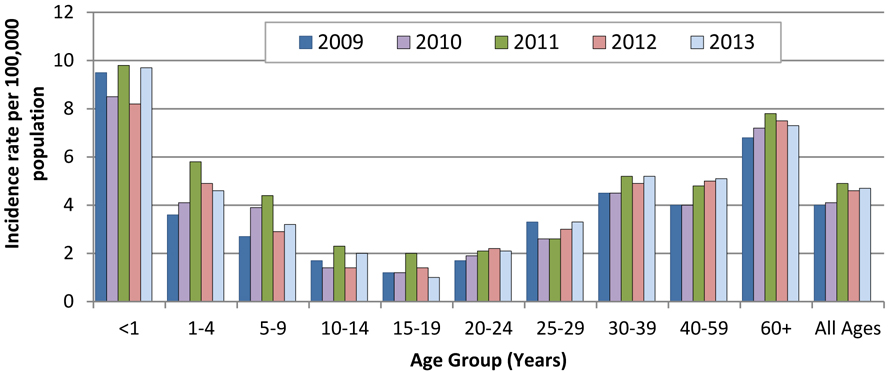
Text Equivalent
| Age Group | 2009 | 2010 | 2011 | 2012 | 2013 | 2014 |
|---|---|---|---|---|---|---|
| <1 | 9.5 | 8.5 | 9.8 | 8.2 | 9.7 | |
| 1-4 | 3.6 | 4.1 | 5.8 | 4.9 | 4.6 | |
| 5-9 | 2.7 | 3.9 | 4.4 | 2.9 | 3.2 | |
| 10-14 | 1.7 | 1.4 | 2.3 | 1.4 | 2 | |
| 15-19 | 1.2 | 1.2 | 2 | 1.4 | 1 | |
| 20-24 | 1.7 | 1.9 | 2.1 | 2.2 | 2.1 | |
| 25-29 | 3.3 | 2.6 | 2.6 | 3 | 3.3 | |
| 30-39 | 4.5 | 4.5 | 5.2 | 4.9 | 5.2 | |
| 40-59 | 4 | 4 | 4.8 | 5 | 5.1 | |
| 60+ | 6.8 | 7.2 | 7.8 | 7.5 | 7.3 | |
| All Ages | 4 | 4.1 | 4.9 | 4.6 | 4.7 |
| Year | Age Group (Years) | ||||||||||
|---|---|---|---|---|---|---|---|---|---|---|---|
| <1 | 1-4 | 5-9 | 10-14 | 15-19 | 20-24 | 25-29 | 30-39 | 40-59 | 60+ | All Ages | |
| 2009 | 9.5 | 3.6 | 2.7 | 1.7 | 1.2 | 1.7 | 3.3 | 4.5 | 4 | 6.8 | 4 |
| 2010 | 8.5 | 4.1 | 3.9 | 1.4 | 1.2 | 1.9 | 2.6 | 4.5 | 4 | 7.2 | 4.1 |
| 2011 | 9.8 | 5.8 | 4.4 | 2.3 | 2 | 2.1 | 2.6 | 5.2 | 4.8 | 7.8 | 4.9 |
| 2012 | 8.2 | 4.9 | 2.9 | 1.4 | 1.4 | 2.2 | 3 | 4.9 | 5 | 7.5 | 4.6 |
| 2013 | 9.7 | 4.6 | 3.2 | 2 | 1 | 2.1 | 3.3 | 5.2 | 5.1 | 7.3 | 4.7 |
| 2014 | |||||||||||
In 2014, of the 1,457 Streptococcus pyogenes isolates tested at the NML by emm typing, 159 (11.0%) were isolated from children <15 years of age; 1,449 (89.0%) from adults ≥15 years of age; and no age was available for 8 isolates. Isolates from male patients represented 53.0% (n=766) of the 1,444 isolates for which gender information was available (Table 12).
There were no major differences observed in the relative proportions of clinical isolation sites between adults and children other than slightly more CSF and pleural fluid isolations sites observed among child isolates (1.3%, n=2; and 3.8%, n=6; respectively) than in the adults (0.5%, n=6; and 1.4%, n=18; respectively) (Figures 33-34).
Regionally, emm1 represented a greater proportion of isolates in Central Canada (33.2%, n=324) than in Western (15.0%, n=64) or Eastern (24.5%, n=13) regions; whereas emm89 was more prevalent in Eastern regions (17.0%, n=9). Emm types associated with Western regions included emm41 (n=14), emm53 (n=30), and emm80 (n=28); those predominantly in Central Canada include emm6 (n=47), emm29 (n=66) and emm91 (n=10); and in Eastern regions emm4 (n=8), emm93 (n=1) and emm94 (n=2) and emm114 (n=1) (Figure 35).
Proportions of individual emm types have remained relatively stable since 2010, with emm1 continuing to be the most prevalent in Canada during 2014 accounting for 36.5% (n=58) of isolates collected from children <15 years of age and 26.4% (n=341) of isolates from those ≥15 years of age (Figures 36-37). In children <15 years of age, emm types 4, 6 and 12 were next most prevalent accounting for 11.9% (n=19), 12.6% (n=20) and 10.7% (n=17), respectively; and in adults ≥15 years of age emm types 89, 28, and 12 were next most predominant with 10.4% (n=134), 6.4% (n=82) and 6.0% (n=78), respectively.
| Province | Age Group (Years) | Not Given | Total | |||||
|---|---|---|---|---|---|---|---|---|
| < 2 | 2 – 4 | 5 – 14 | 15 – 49 | 50 – 64 | ≥ 65 | |||
| British Columbia | 3 | 3 | 4 | 72 | 48 | 30 | 1 | 161 |
| Saskatchewan | 2 | 5 | 9 | 65 | 28 | 29 | - | 138 |
| Manitoba | 7 | 3 | 5 | 53 | 27 | 28 | 1 | 124 |
| Ontario | 18 | 21 | 28 | 201 | 130 | 214 | 6 | 618 |
| Québec | 13 | 13 | 20 | 136 | 76 | 101 | - | 359 |
| New Brunswick | - | - | 1 | 10 | 5 | 5 | - | 21 |
| Nova Scotia | - | 1 | 1 | 7 | 2 | 8 | - | 19 |
| Prince Edward Island | - | - | - | 1 | 1 | - | - | 2 |
| Newfoundland and Labrador | - | - | 2 | 2 | 4 | 3 | - | 11 |
| Yukon Territories | - | - | - | - | 1 | 1 | - | 2 |
| Northwest Territories | - | - | - | 1 | - | - | - | 1 |
| Nunavut | - | - | - | - | - | 1 | - | 1 |
| Canada | 43 | 46 | 70 | 548 | 322 | 420 | 8 | 1,457 |
Figure 33a. Clinical isolation sites of S. pyogenes from children <15 years of age (N=159)
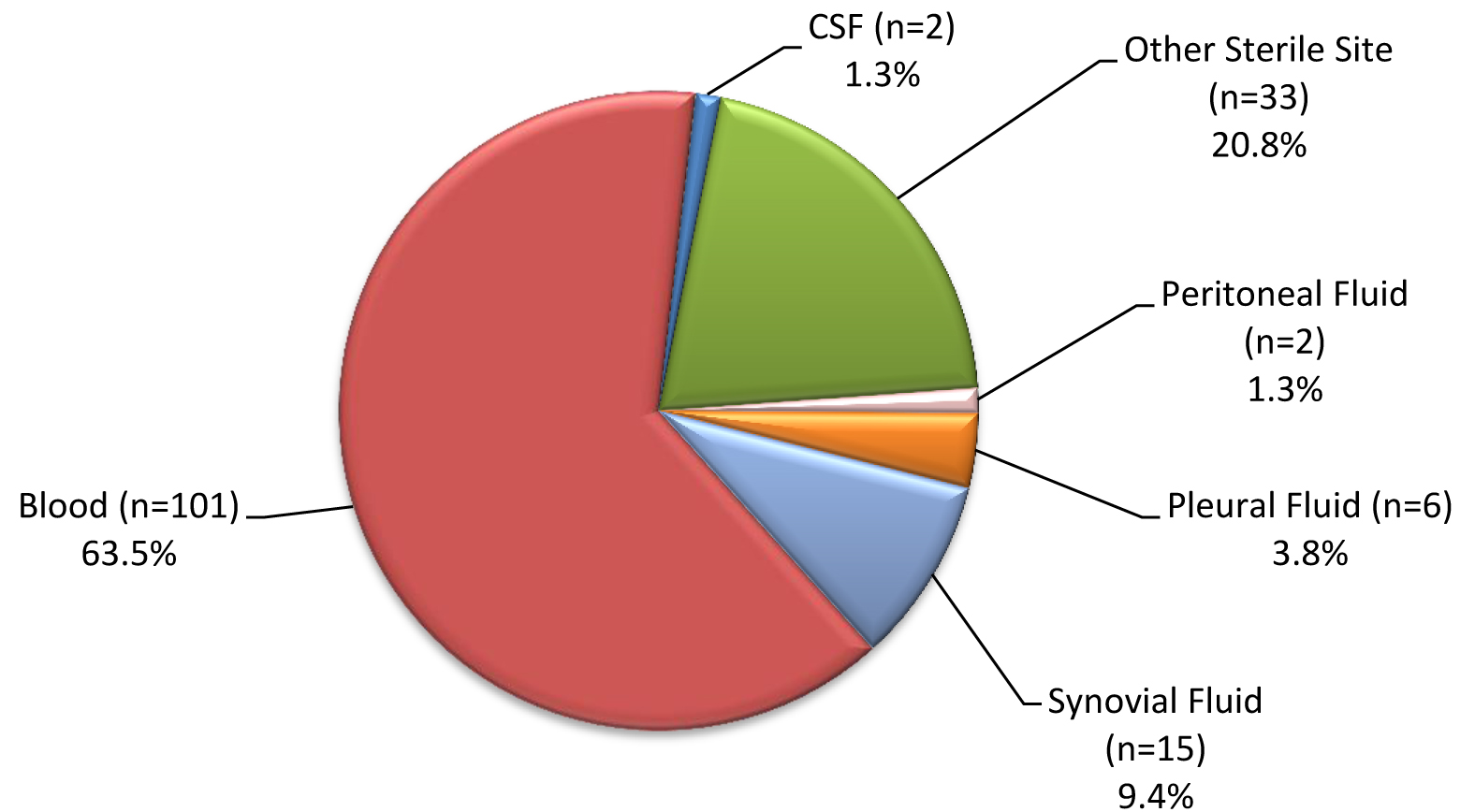
Text Equivalent
| Clinical Isolation site | Percentage |
|---|---|
| Blood (n=101) | 63.5% |
| CSF (n=2) | 1.3% |
| Other Sterile Site (n=33) | 20.8% |
| Peritoneal Fluid (n=2) | 1.3% |
| Pleural Fluid (n=6) | 3.8% |
| Synovial Fluid (n=15) | 9.4% |
Other sterile sites include: deep tissue, biopsy and surgical samples, bone, mastoid and any clinical sources associated with necrotizing fasciitis. Patient age was not available for 8 isolates.
Figure 33b. Clinical isolation sites of S. pyogenes from adults ≥15 years of age (N=1,290)
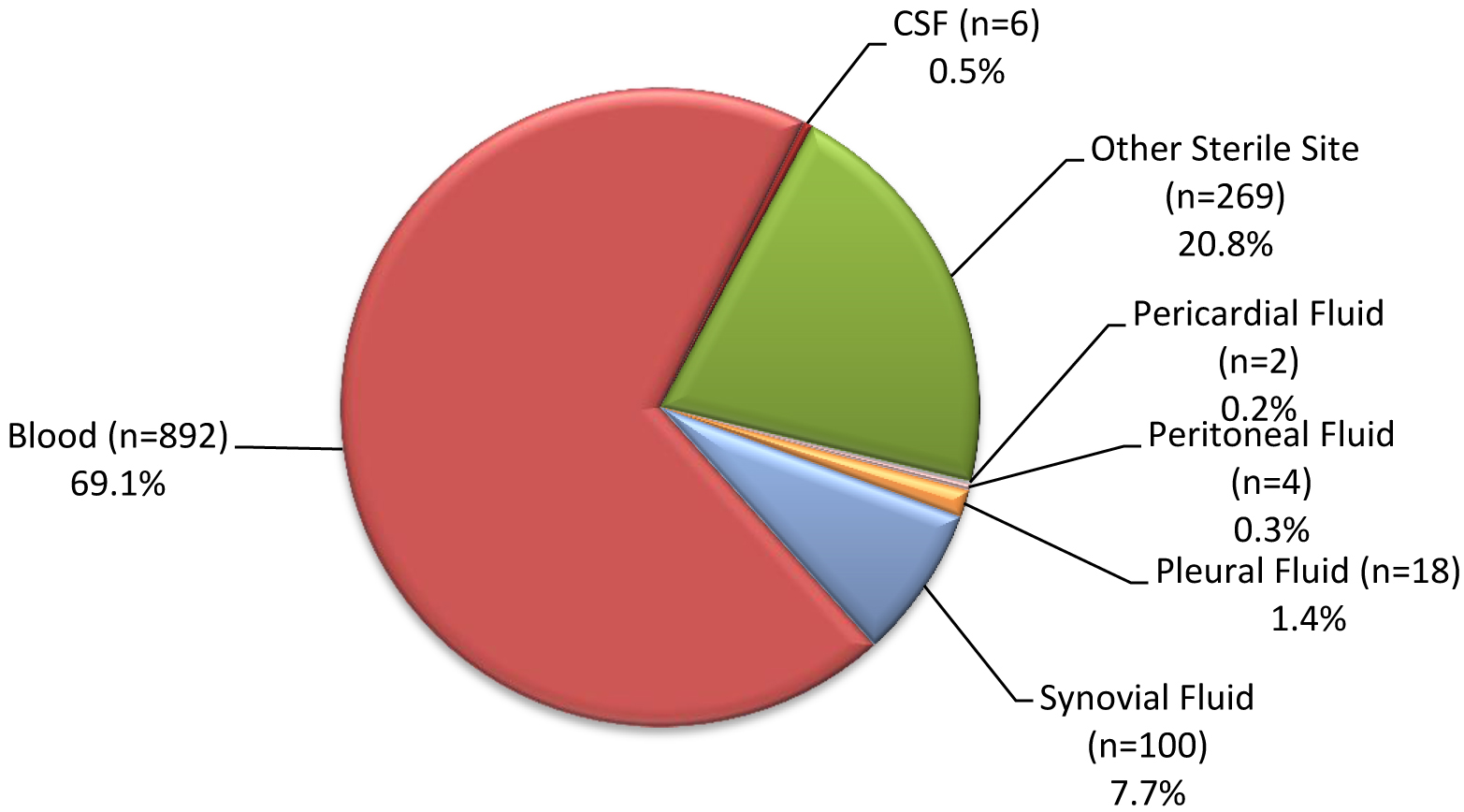
Other sterile sites include: deep tissue, biopsy and surgical samples, bone, mastoid and any clinical sources associated with necrotizing fasciitis. Patient age was not available for 8 isolates.
Text Equivalent
| Clinical Isolation site | Percentage |
|---|---|
| Blood (n=892) | 69.1% |
| CSF (n=6) | 0.5% |
| Other Sterile Site (n=269) | 20.8% |
| Peritoneal Fluid (n=4) | 0.3% |
| Pleural Fluid (n=18) | 1.4% |
| Synovial Fluid (n=100) | 7.7% |
Other sterile sites include: deep tissue, biopsy and surgical samples, bone, mastoid and any clinical sources associated with necrotizing fasciitis. Patient age was not available for 8 isolates.
Figure 34a. Invasive S. pyogenes emm types from blood, 2014
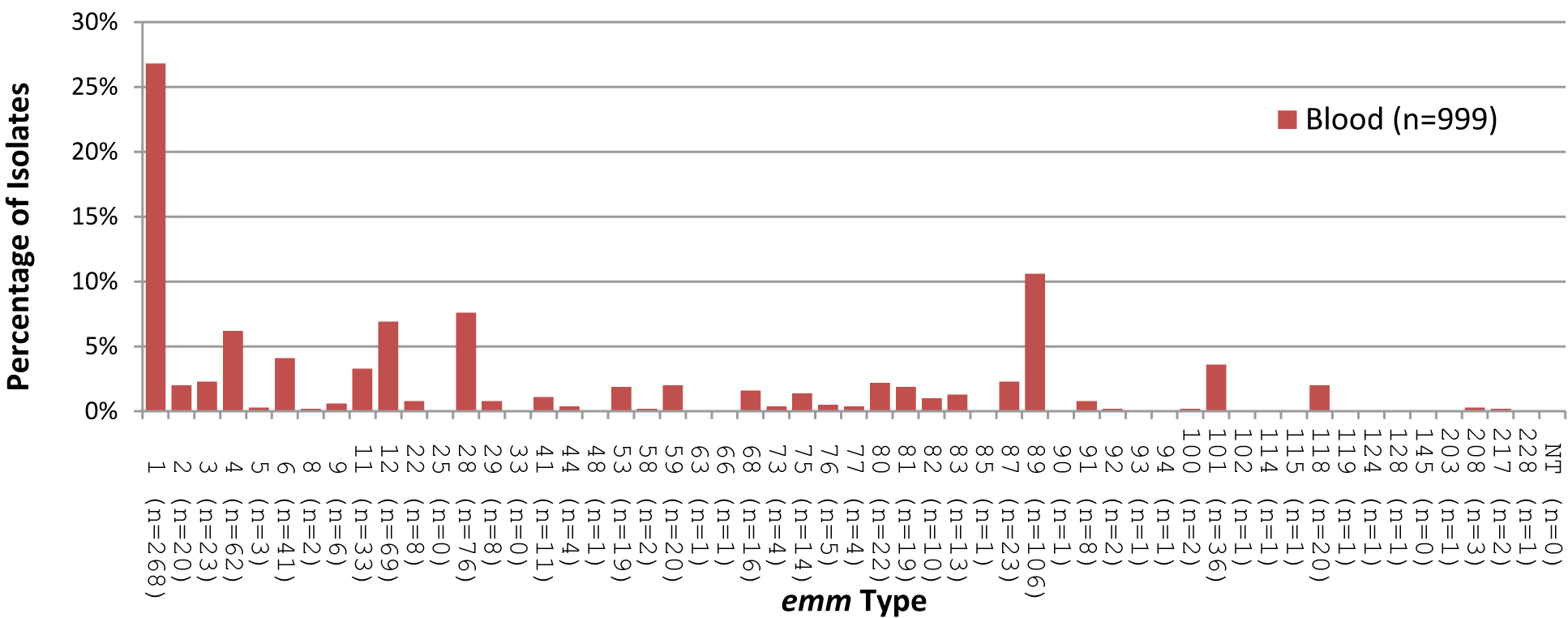
Text Equivalent
| Serotype | Blood (n=999) |
|---|---|
| 1 (n=268) | 26.83% |
| 2 (n=20) | 2.00% |
| 3 (n=23) | 2.30% |
| 4 (n=62) | 6.21% |
| 5 (n=3) | 0.30% |
| 6 (n=41) | 4.10% |
| 8 (n=2) | 0.20% |
| 9 (n=6) | 0.60% |
| 11 (n=33) | 3.30% |
| 12 (n=69) | 6.91% |
| 22 (n=8) | 0.80% |
| 25 (n=0) | 0.00% |
| 28 (n=76) | 7.61% |
| 29 (n=8) | 0.80% |
| 33 (n=0) | 0.00% |
| 41 (n=11) | 1.10% |
| 44 (n=4) | 0.40% |
| 48 (n=1) | 0.10% |
| 53 (n=19) | 1.90% |
| 58 (n=2) | 0.20% |
| 59 (n=20) | 2.00% |
| 63 (n=1) | 0.10% |
| 66 (n=1) | 0.10% |
| 68 (n=16) | 1.60% |
| 73 (n=4) | 0.40% |
| 75 (n=14) | 1.40% |
| 76 (n=5) | 0.50% |
| 77 (n=4) | 0.40% |
| 80 (n=22) | 2.20% |
| 81 (n=19) | 1.90% |
| 82 (n=10) | 1.00% |
| 83 (n=13) | 1.30% |
| 85 (n=1) | 0.10% |
| 87 (n=23) | 2.30% |
| 89 (n=106) | 10.61% |
| 90 (n=1) | 0.10% |
| 91 (n=8) | 0.80% |
| 92 (n=2) | 0.20% |
| 93 (n=1) | 0.10% |
| 94 (n=1) | 0.10% |
| 100 (n=2) | 0.20% |
| 101 (n=36) | 3.60% |
| 102 (n=1) | 0.10% |
| 114 (n=1) | 0.10% |
| 115 (n=1) | 0.10% |
| 118 (n=20) | 2.00% |
| 119 (n=1) | 0.10% |
| 124 (n=1) | 0.10% |
| 128 (n=1) | 0.10% |
| 145 (n=0) | 0.00% |
| 203 (n=1) | 0.10% |
| 208 (n=3) | 0.30% |
| 217 (n=2) | 0.20% |
| 228 (n=1) | 0.10% |
| NT (n=0) | 0.00% |
Figure 34b. Invasive S. pyogenes emm types from synovial fluid, 2014
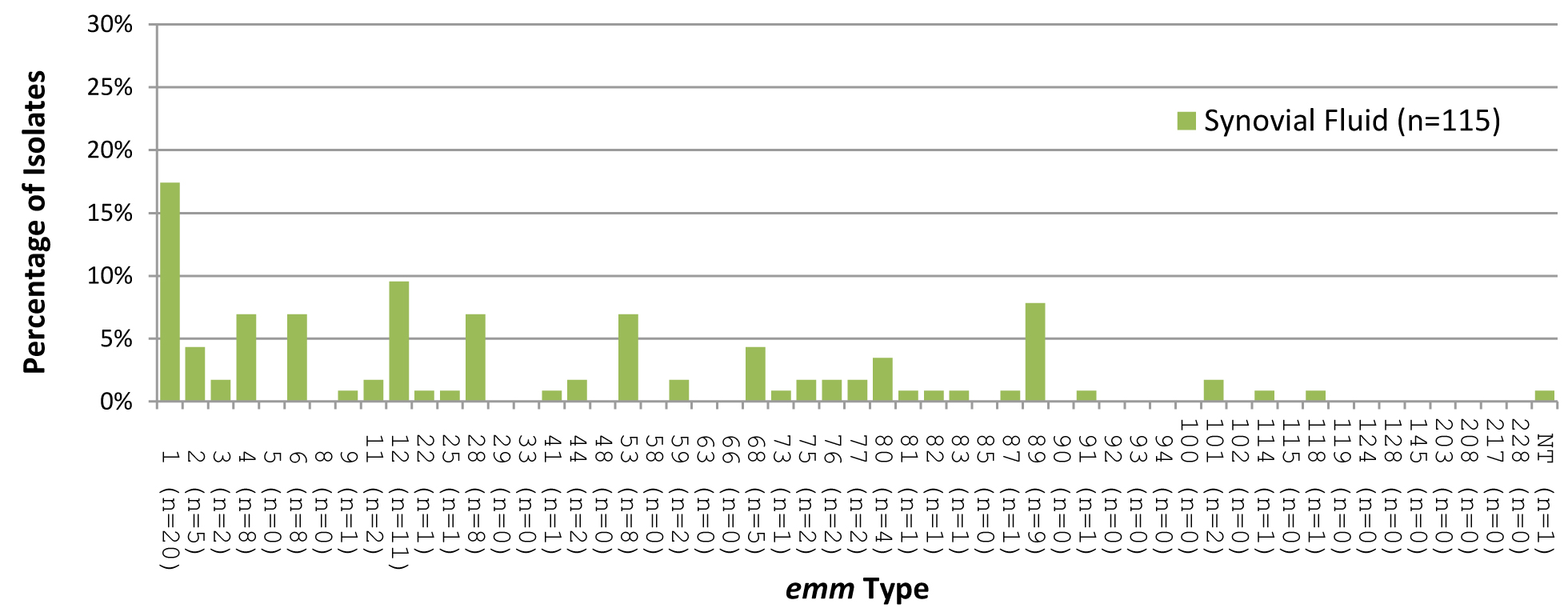
Text Equivalent
| Serotype | Synovial Fluid (n=115) |
|---|---|
| 1 (n=20) | 17.39% |
| 2 (n=5) | 4.35% |
| 3 (n=2) | 1.74% |
| 4 (n=8) | 6.96% |
| 5 (n=0) | 0.00% |
| 6 (n=8) | 6.96% |
| 8 (n=0) | 0.00% |
| 9 (n=1) | 0.87% |
| 11 (n=2) | 1.74% |
| 12 (n=11) | 9.57% |
| 22 (n=1) | 0.87% |
| 25 (n=1) | 0.87% |
| 28 (n=8) | 6.96% |
| 29 (n=0) | 0.00% |
| 33 (n=0) | 0.00% |
| 41 (n=1) | 0.87% |
| 44 (n=2) | 1.74% |
| 48 (n=0) | 0.00% |
| 53 (n=8) | 6.96% |
| 58 (n=0) | 0.00% |
| 59 (n=2) | 1.74% |
| 63 (n=0) | 0.00% |
| 66 (n=0) | 0.00% |
| 68 (n=5) | 4.35% |
| 73 (n=1) | 0.87% |
| 75 (n=2) | 1.74% |
| 76 (n=2) | 1.74% |
| 77 (n=2) | 1.74% |
| 80 (n=4) | 3.48% |
| 81 (n=1) | 0.87% |
| 82 (n=1) | 0.87% |
| 83 (n=1) | 0.87% |
| 85 (n=0) | 0.00% |
| 87 (n=1) | 0.87% |
| 89 (n=9) | 7.83% |
| 90 (n=0) | 0.00% |
| 91 (n=1) | 0.87% |
| 92 (n=0) | 0.00% |
| 93 (n=0) | 0.00% |
| 94 (n=0) | 0.00% |
| 100 (n=0) | 0.00% |
| 101 (n=2) | 1.74% |
| 102 (n=0) | 0.00% |
| 114 (n=1) | 0.87% |
| 115 (n=0) | 0.00% |
| 118 (n=1) | 0.87% |
| 119 (n=0) | 0.00% |
| 124 (n=0) | 0.00% |
| 128 (n=0) | 0.00% |
| 145 (n=0) | 0.00% |
| 203 (n=0) | 0.00% |
| 208 (n=0) | 0.00% |
| 217 (n=0) | 0.00% |
| 228 (n=0) | 0.00% |
| NT (n=1) | 0.87% |
Figure 34c. Invasive S. pyogenes emm types from other clinical sources, 2014
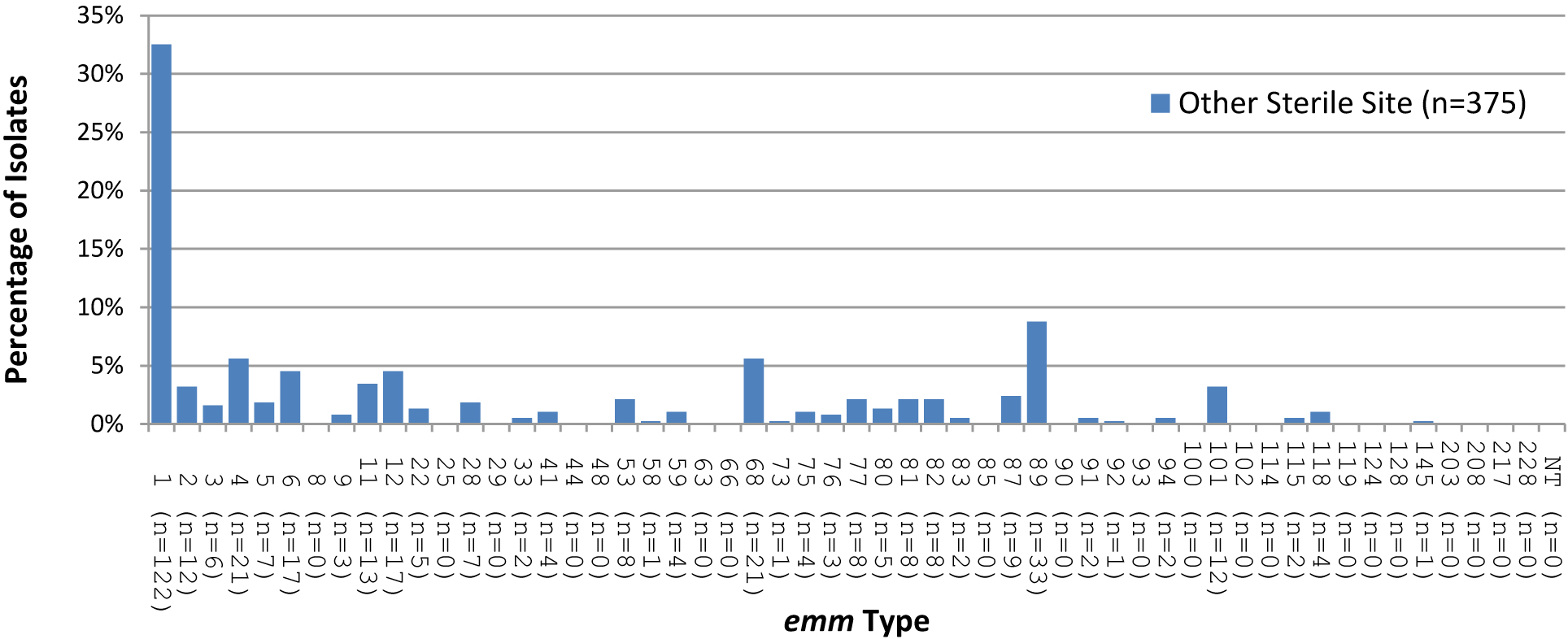
Other sterile sites include: CSF, pericardial fluid, peritoneal fluid, deep tissue, biopsy and surgical samples, bone, mastoid and any clinical sources associated with necrotizing fasciitis.
Text Equivalent
| Serotype | Other Sterile Site (n=375) |
|---|---|
| Other sterile sites include: CSF, pericardial fluid, peritoneal fluid, deep tissue, biopsy and surgical samples, bone, mastoid and any clinical sources associated with necrotizing fasciitis. | |
| 1 (n=122) | 32.53% |
| 2 (n=12) | 3.20% |
| 3 (n=6) | 1.60% |
| 4 (n=21) | 5.60% |
| 5 (n=7) | 1.87% |
| 6 (n=17) | 4.53% |
| 8 (n=0) | 0.00% |
| 9 (n=3) | 0.80% |
| 11 (n=13) | 3.47% |
| 12 (n=17) | 4.53% |
| 22 (n=5) | 1.33% |
| 25 (n=0) | 0.00% |
| 28 (n=7) | 1.87% |
| 29 (n=0) | 0.00% |
| 33 (n=2) | 0.53% |
| 41 (n=4) | 1.07% |
| 44 (n=0) | 0.00% |
| 48 (n=0) | 0.00% |
| 53 (n=8) | 2.13% |
| 58 (n=1) | 0.27% |
| 59 (n=4) | 1.07% |
| 63 (n=0) | 0.00% |
| 66 (n=0) | 0.00% |
| 68 (n=21) | 5.60% |
| 73 (n=1) | 0.27% |
| 75 (n=4) | 1.07% |
| 76 (n=3) | 0.80% |
| 77 (n=8) | 2.13% |
| 80 (n=5) | 1.33% |
| 81 (n=8) | 2.13% |
| 82 (n=8) | 2.13% |
| 83 (n=2) | 0.53% |
| 85 (n=0) | 0.00% |
| 87 (n=9) | 2.40% |
| 89 (n=33) | 8.80% |
| 90 (n=0) | 0.00% |
| 91 (n=2) | 0.53% |
| 92 (n=1) | 0.27% |
| 93 (n=0) | 0.00% |
| 94 (n=2) | 0.53% |
| 100 (n=0) | 0.00% |
| 101 (n=12) | 3.20% |
| 102 (n=0) | 0.00% |
| 114 (n=0) | 0.00% |
| 115 (n=2) | 0.53% |
| 118 (n=4) | 1.07% |
| 119 (n=0) | 0.00% |
| 124 (n=0) | 0.00% |
| 128 (n=0) | 0.00% |
| 145 (n=1) | 0.27% |
| 203 (n=0) | 0.00% |
| 208 (n=0) | 0.00% |
| 217 (n=0) | 0.00% |
| 228 (n=0) | 0.00% |
| NT (n=0) | 0.00% |
Figure 35. Regional Distribution of Invasive S. pyogenes emm Types, 2014
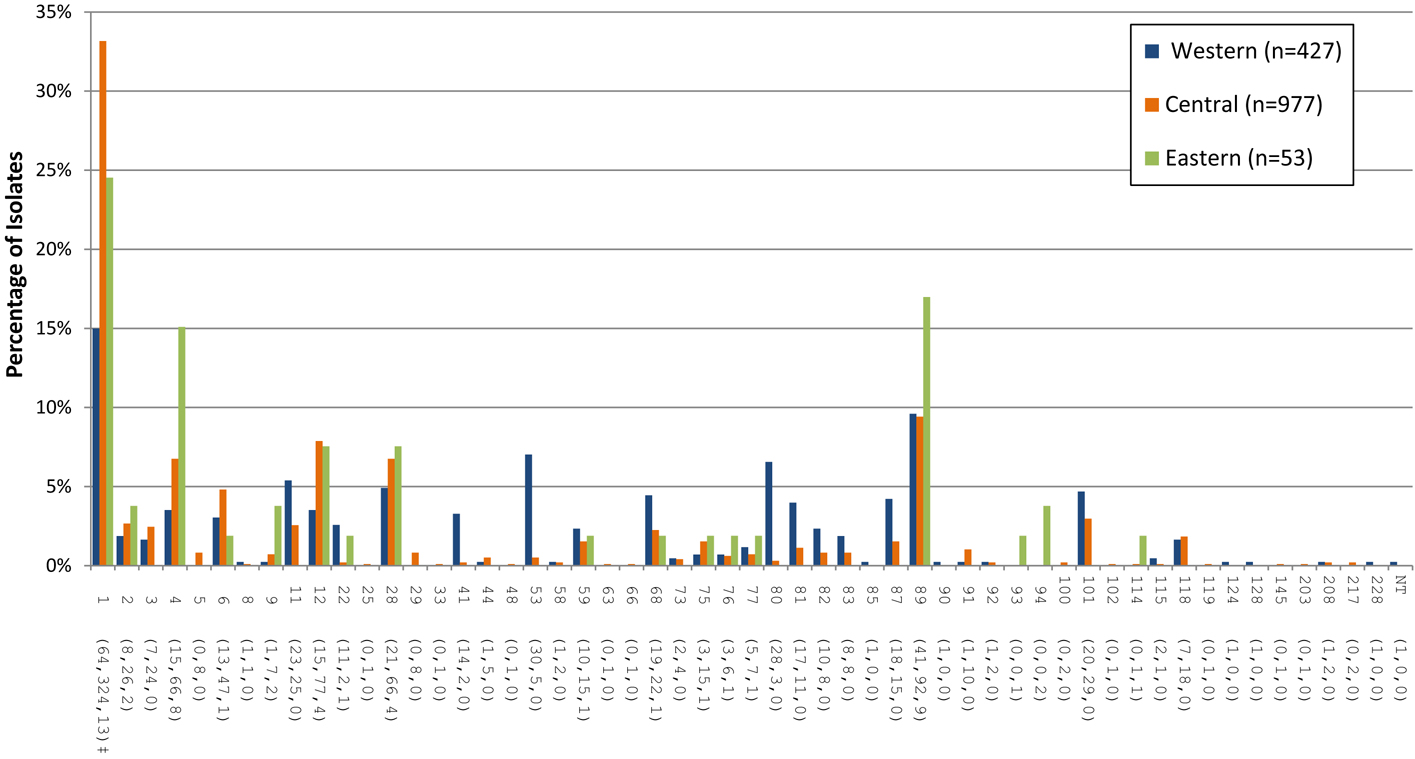
‡ Number of resistant isolates for Western, Central and Eastern regions, respectively.
Text Equivalent
| emm Type | Western (n=427) | Central (n=977) | Eastern (n=53) |
|---|---|---|---|
Table Figure 35 Footnotes
|
|||
| 1 (64,324,13)Table Figure 35 Footnote 1 | 15.0% | 33.2% | 24.5% |
| 2 (8,26,2) | 1.9% | 2.7% | 3.8% |
| 3 (7,24,0) | 1.6% | 2.5% | 0.0% |
| 4 (15,66,8) | 3.5% | 6.8% | 15.1% |
| 5 (0,8,0) | 0.0% | 0.8% | 0.0% |
| 6 (13,47,1) | 3.0% | 4.8% | 1.9% |
| 8 (1,1,0) | 0.2% | 0.1% | 0.0% |
| 9 (1,7,2) | 0.2% | 0.7% | 3.8% |
| 11 (23,25,0) | 5.4% | 2.6% | 0.0% |
| 12 (15,77,4) | 3.5% | 7.9% | 7.5% |
| 22 (11,2,1) | 2.6% | 0.2% | 1.9% |
| 25 (0,1,0) | 0.0% | 0.1% | 0.0% |
| 28 (21,66,4) | 4.9% | 6.8% | 7.5% |
| 29 (0,8,0) | 0.0% | 0.8% | 0.0% |
| 33 (0,1,0) | 0.0% | 0.1% | 0.0% |
| 41 (14,2,0) | 3.3% | 0.2% | 0.0% |
| 44 (1,5,0) | 0.2% | 0.5% | 0.0% |
| 48 (0,1,0) | 0.0% | 0.1% | 0.0% |
| 53 (30,5,0) | 7.0% | 0.5% | 0.0% |
| 58 (1,2,0) | 0.2% | 0.2% | 0.0% |
| 59 (10,15,1) | 2.3% | 1.5% | 1.9% |
| 63 (0,1,0) | 0.0% | 0.1% | 0.0% |
| 66 (0,1,0) | 0.0% | 0.1% | 0.0% |
| 68 (19,22,1) | 4.4% | 2.3% | 1.9% |
| 73 (2,4,0) | 0.5% | 0.4% | 0.0% |
| 75 (3,15,1) | 0.7% | 1.5% | 1.9% |
| 76 (3,6,1) | 0.7% | 0.6% | 1.9% |
| 77 (5,7,1) | 1.2% | 0.7% | 1.9% |
| 80 (28,3,0) | 6.6% | 0.3% | 0.0% |
| 81 (17,11,0) | 4.0% | 1.1% | 0.0% |
| 82 (10,8,0) | 2.3% | 0.8% | 0.0% |
| 83 (8,8,0) | 1.9% | 0.8% | 0.0% |
| 85 (1,0,0) | 0.2% | 0.0% | 0.0% |
| 87 (18,15,0) | 4.2% | 1.5% | 0.0% |
| 89 (41,92,9) | 9.6% | 9.4% | 17.0% |
| 90 (1,0,0) | 0.2% | 0.0% | 0.0% |
| 91 (1,10,0) | 0.2% | 1.0% | 0.0% |
| 92 (1,2,0) | 0.2% | 0.2% | 0.0% |
| 93 (0,0,1) | 0.0% | 0.0% | 1.9% |
| 94 (0,0,2) | 0.0% | 0.0% | 3.8% |
| 100 (0,2,0) | 0.0% | 0.2% | 0.0% |
| 101 (20,29,0) | 4.7% | 3.0% | 0.0% |
| 102 (0,1,0) | 0.0% | 0.1% | 0.0% |
| 114 (0,1,1) | 0.0% | 0.1% | 1.9% |
| 115 (2,1,0) | 0.5% | 0.1% | 0.0% |
| 118 (7,18,0) | 1.6% | 1.8% | 0.0% |
| 119 (0,1,0) | 0.0% | 0.1% | 0.0% |
| 124 (1,0,0) | 0.2% | 0.0% | 0.0% |
| 128 (1,0,0) | 0.2% | 0.0% | 0.0% |
| 145 (0,1,0) | 0.0% | 0.1% | 0.0% |
| 203 (0,1,0) | 0.0% | 0.1% | 0.0% |
| 208 (1,2,0) | 0.2% | 0.2% | 0.0% |
| 217 (0,2,0) | 0.0% | 0.2% | 0.0% |
| 228 (1,0,0) | 0.2% | 0.0% | 0.0% |
| NT (1,0,0) | 0.2% | 0.0% | 0.0% |
Figure 36. Invasive S. pyogenes emm types in all combined age groups, 2010 – 2014
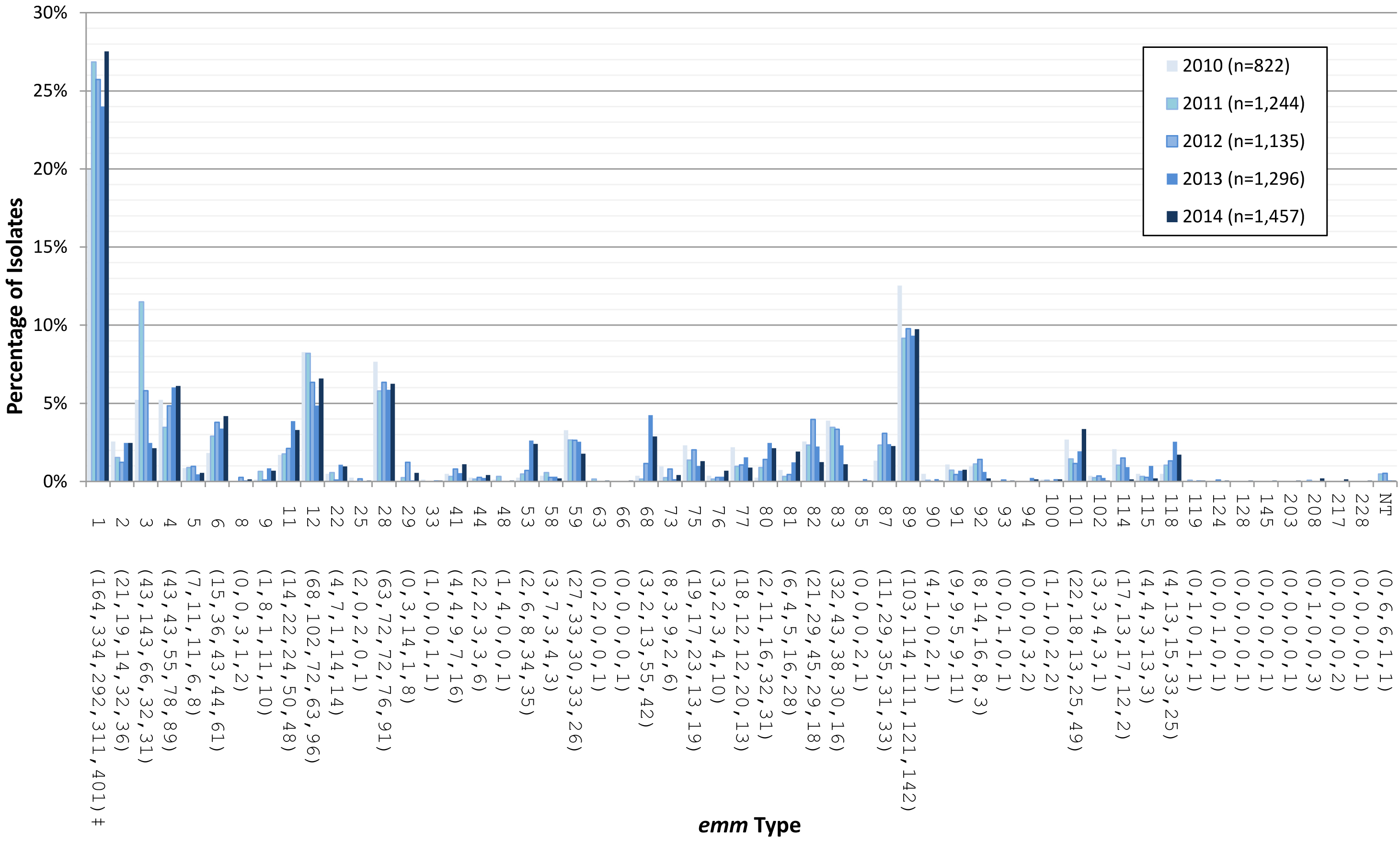
‡ Number of resistant isolates for 2010, 2011, 2012, 2013 and 2014, respectively.
Text Equivalent
| emm | 2010 (n=822) | 2011 (n=1,244) | 2012 (n=1,135) | 2013 (n=1,296) | 2014 (n=1,457) |
|---|---|---|---|---|---|
Footnotes
|
|||||
| 1 (164,334,292,311,401)Table Figure 36 Footnote 1 | 20.0% | 26.8% | 25.7% | 24.0% | 27.5% |
| 2 (21,19,14,32,36) | 2.6% | 1.5% | 1.2% | 2.5% | 2.5% |
| 3 (43,143,66,32,31) | 5.2% | 11.5% | 5.8% | 2.5% | 2.1% |
| 4 (43,43,55,78,89) | 5.2% | 3.5% | 4.8% | 6.0% | 6.1% |
| 5 (7,11,11,6,8) | 0.9% | 0.9% | 1.0% | 0.5% | 0.5% |
| 6 (15,36,43,44,61) | 1.8% | 2.9% | 3.8% | 3.4% | 4.2% |
| 8 (0,0,3,1,2) | 0.0% | 0.0% | 0.3% | 0.1% | 0.1% |
| 9 (1,8,1,11,10) | 0.1% | 0.6% | 0.1% | 0.8% | 0.7% |
| 11 (14,22,24,50,48) | 1.7% | 1.8% | 2.1% | 3.9% | 3.3% |
| 12 (68,102,72,63,96) | 8.3% | 8.2% | 6.3% | 4.9% | 6.6% |
| 22 (4,7,1,14,14) | 0.5% | 0.6% | 0.1% | 1.1% | 1.0% |
| 25 (2,0,2,0,1) | 0.2% | 0.0% | 0.2% | 0.0% | 0.1% |
| 28 (63,72,72,76,91) | 7.7% | 5.8% | 6.3% | 5.9% | 6.2% |
| 29 (0,3,14,1,8) | 0.0% | 0.2% | 1.2% | 0.1% | 0.5% |
| 33 (1,0,0,1,1) | 0.1% | 0.0% | 0.0% | 0.1% | 0.1% |
| 41 (4,4,9,7,16) | 0.5% | 0.3% | 0.8% | 0.5% | 1.1% |
| 44 (2,2,3,3,6) | 0.2% | 0.2% | 0.3% | 0.2% | 0.4% |
| 48 (1,4,0,0,1) | 0.1% | 0.3% | 0.0% | 0.0% | 0.1% |
| 53 (2,6,8,34,35) | 0.2% | 0.5% | 0.7% | 2.6% | 2.4% |
| 58 (3,7,3,4,3) | 0.4% | 0.6% | 0.3% | 0.3% | 0.2% |
| 59 (27,33,30,33,26) | 3.3% | 2.7% | 2.6% | 2.5% | 1.8% |
| 63 (0,2,0,0,1) | 0.0% | 0.2% | 0.0% | 0.0% | 0.1% |
| 66 (0,0,0,0,1) | 0.0% | 0.0% | 0.0% | 0.0% | 0.1% |
| 68 (3,2,13,55,42) | 0.4% | 0.2% | 1.1% | 4.2% | 2.9% |
| 73 (8,3,9,2,6) | 1.0% | 0.2% | 0.8% | 0.2% | 0.4% |
| 75 (19,17,23,13,19) | 2.3% | 1.4% | 2.0% | 1.0% | 1.3% |
| 76 (3,2,3,4,10) | 0.4% | 0.2% | 0.3% | 0.3% | 0.7% |
| 77 (18,12,12,20,13) | 2.2% | 1.0% | 1.1% | 1.5% | 0.9% |
| 80 (2,11,16,32,31) | 0.2% | 0.9% | 1.4% | 2.5% | 2.1% |
| 81 (6,4,5,16,28) | 0.7% | 0.3% | 0.4% | 1.2% | 1.9% |
| 82 (21,29,45,29,18) | 2.6% | 2.3% | 4.0% | 2.2% | 1.2% |
| 83 (32,43,38,30,16) | 3.9% | 3.5% | 3.3% | 2.3% | 1.1% |
| 85 (0,0,0,2,1) | 0.0% | 0.0% | 0.0% | 0.2% | 0.1% |
| 87 (11,29,35,31,33) | 1.3% | 2.3% | 3.1% | 2.4% | 2.3% |
| 89 (103,114,111,121,142) | 12.5% | 9.2% | 9.8% | 9.3% | 9.7% |
| 90 (4,1,0,2,1) | 0.5% | 0.1% | 0.0% | 0.2% | 0.1% |
| 91 (9,9,5,9,11) | 1.1% | 0.7% | 0.4% | 0.7% | 0.8% |
| 92 (8,14,16,8,3) | 1.0% | 1.1% | 1.4% | 0.6% | 0.2% |
| 93 (0,0,1,0,1) | 0.0% | 0.0% | 0.1% | 0.0% | 0.1% |
| 94 (0,0,0,3,2) | 0.0% | 0.0% | 0.0% | 0.2% | 0.1% |
| 100 (1,1,0,2,2) | 0.1% | 0.1% | 0.0% | 0.2% | 0.1% |
| 101 (22,18,13,25,49) | 2.7% | 1.4% | 1.1% | 1.9% | 3.4% |
| 102 (3,3,4,3,1) | 0.4% | 0.2% | 0.4% | 0.2% | 0.1% |
| 114 (17,13,17,12,2) | 2.1% | 1.0% | 1.5% | 0.9% | 0.1% |
| 115 (4,4,3,13,3) | 0.5% | 0.3% | 0.3% | 1.0% | 0.2% |
| 118 (4,13,15,33,25) | 0.5% | 1.0% | 1.3% | 2.5% | 1.7% |
| 119 (0,1,0,1,1) | 0.0% | 0.1% | 0.0% | 0.1% | 0.1% |
| 124 (0,0,1,0,1) | 0.0% | 0.0% | 0.1% | 0.0% | 0.1% |
| 128 (0,0,0,0,1) | 0.0% | 0.0% | 0.0% | 0.0% | 0.1% |
| 145 (0,0,0,0,1) | 0.0% | 0.0% | 0.0% | 0.0% | 0.1% |
| 203 (0,0,0,0,1) | 0.0% | 0.0% | 0.0% | 0.0% | 0.1% |
| 208 (0,1,0,0,3) | 0.0% | 0.1% | 0.0% | 0.0% | 0.2% |
| 217 (0,0,0,0,2) | 0.0% | 0.0% | 0.0% | 0.0% | 0.1% |
| 228 (0,0,0,0,1) | 0.0% | 0.0% | 0.0% | 0.0% | 0.1% |
| NT (0,6,6,1,1) | 0.0% | 0.5% | 0.5% | 0.1% | 0.1% |
Figure 37a. Invasive S. pyogenes emm types in children <15 years of age, 2010 – 2014
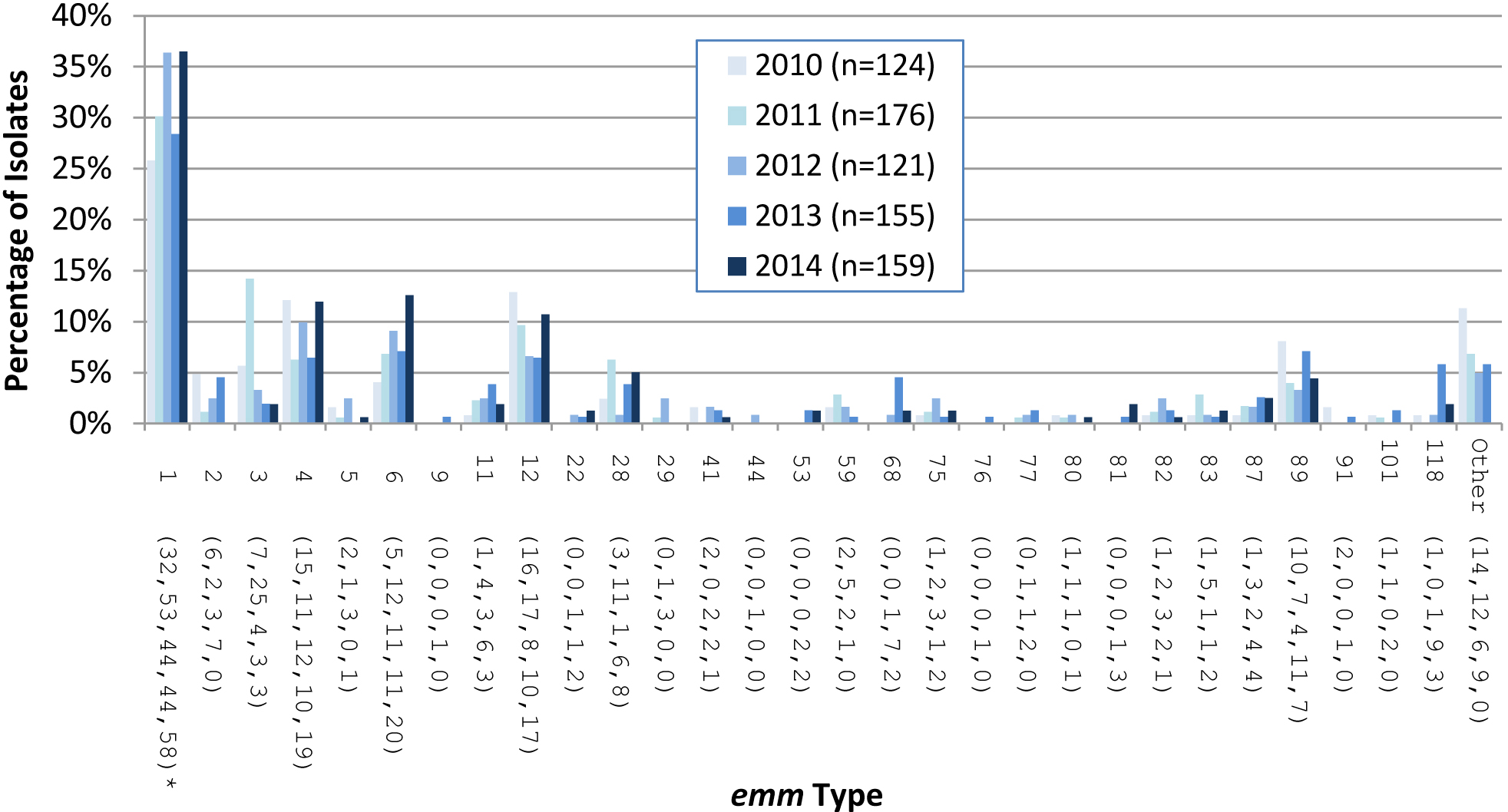
Text Equivalent
| emm | 2010 (n=124) | 2011 (n=176) | 2012 (n=121) | 2013 (n=155) | 2014 (n=159) |
|---|---|---|---|---|---|
Table Figure 37a Footnotes
|
|||||
| 1 (32,53,44,44,58)Table Figure 37a Footnote 1 | 25.8% | 30.1% | 36.4% | 28.4% | 36.5% |
| 2 (6,2,3,7,0) | 4.8% | 1.1% | 2.5% | 4.5% | 0.0% |
| 3 (7,25,4,3,3) | 5.6% | 14.2% | 3.3% | 1.9% | 1.9% |
| 4 (15,11,12,10,19) | 12.1% | 6.3% | 9.9% | 6.5% | 11.9% |
| 5 (2,1,3,0,1) | 1.6% | 0.6% | 2.5% | 0.0% | 0.6% |
| 6 (5,12,11,11,20) | 4.0% | 6.8% | 9.1% | 7.1% | 12.6% |
| 9 (0,0,0,1,0) | 0.0% | 0.0% | 0.0% | 0.6% | 0.0% |
| 11 (1,4,3,6,3) | 0.8% | 2.3% | 2.5% | 3.9% | 1.9% |
| 12 (16,17,8,10,17) | 12.9% | 9.7% | 6.6% | 6.5% | 10.7% |
| 22 (0,0,1,1,2) | 0.0% | 0.0% | 0.8% | 0.6% | 1.3% |
| 28 (3,11,1,6,8) | 2.4% | 6.3% | 0.8% | 3.9% | 5.0% |
| 29 (0,1,3,0,0) | 0.0% | 0.6% | 2.5% | 0.0% | 0.0% |
| 41 (2,0,2,2,1) | 1.6% | 0.0% | 1.7% | 1.3% | 0.6% |
| 44 (0,0,1,0,0) | 0.0% | 0.0% | 0.8% | 0.0% | 0.0% |
| 53 (0,0,0,2,2) | 0.0% | 0.0% | 0.0% | 1.3% | 1.3% |
| 59 (2,5,2,1,0) | 1.6% | 2.8% | 1.7% | 0.6% | 0.0% |
| 68 (0,0,1,7,2) | 0.0% | 0.0% | 0.8% | 4.5% | 1.3% |
| 75 (1,2,3,1,2) | 0.8% | 1.1% | 2.5% | 0.6% | 1.3% |
| 76 (0,0,0,1,0) | 0.0% | 0.0% | 0.0% | 0.6% | 0.0% |
| 77 (0,1,1,2,0) | 0.0% | 0.6% | 0.8% | 1.3% | 0.0% |
| 80 (1,1,1,0,1) | 0.8% | 0.6% | 0.8% | 0.0% | 0.6% |
| 81 (0,0,0,1,3) | 0.0% | 0.0% | 0.0% | 0.6% | 1.9% |
| 82 (1,2,3,2,1) | 0.8% | 1.1% | 2.5% | 1.3% | 0.6% |
| 83 (1,5,1,1,2) | 0.8% | 2.8% | 0.8% | 0.6% | 1.3% |
| 87 (1,3,2,4,4) | 0.8% | 1.7% | 1.7% | 2.6% | 2.5% |
| 89 (10,7,4,11,7) | 8.1% | 4.0% | 3.3% | 7.1% | 4.4% |
| 91 (2,0,0,1,0) | 1.6% | 0.0% | 0.0% | 0.6% | 0.0% |
| 101 (1,1,0,2,0) | 0.8% | 0.6% | 0.0% | 1.3% | 0.0% |
| 118 (1,0,1,9,3) | 0.8% | 0.0% | 0.8% | 5.8% | 1.9% |
| Other (14,12,6,9,0) | 11.3% | 6.8% | 5.0% | 5.8% | 0.0% |
Figure 37b. Invasive S. pyogenes emm types in adults ≥15 years of age, 2010 – 2014
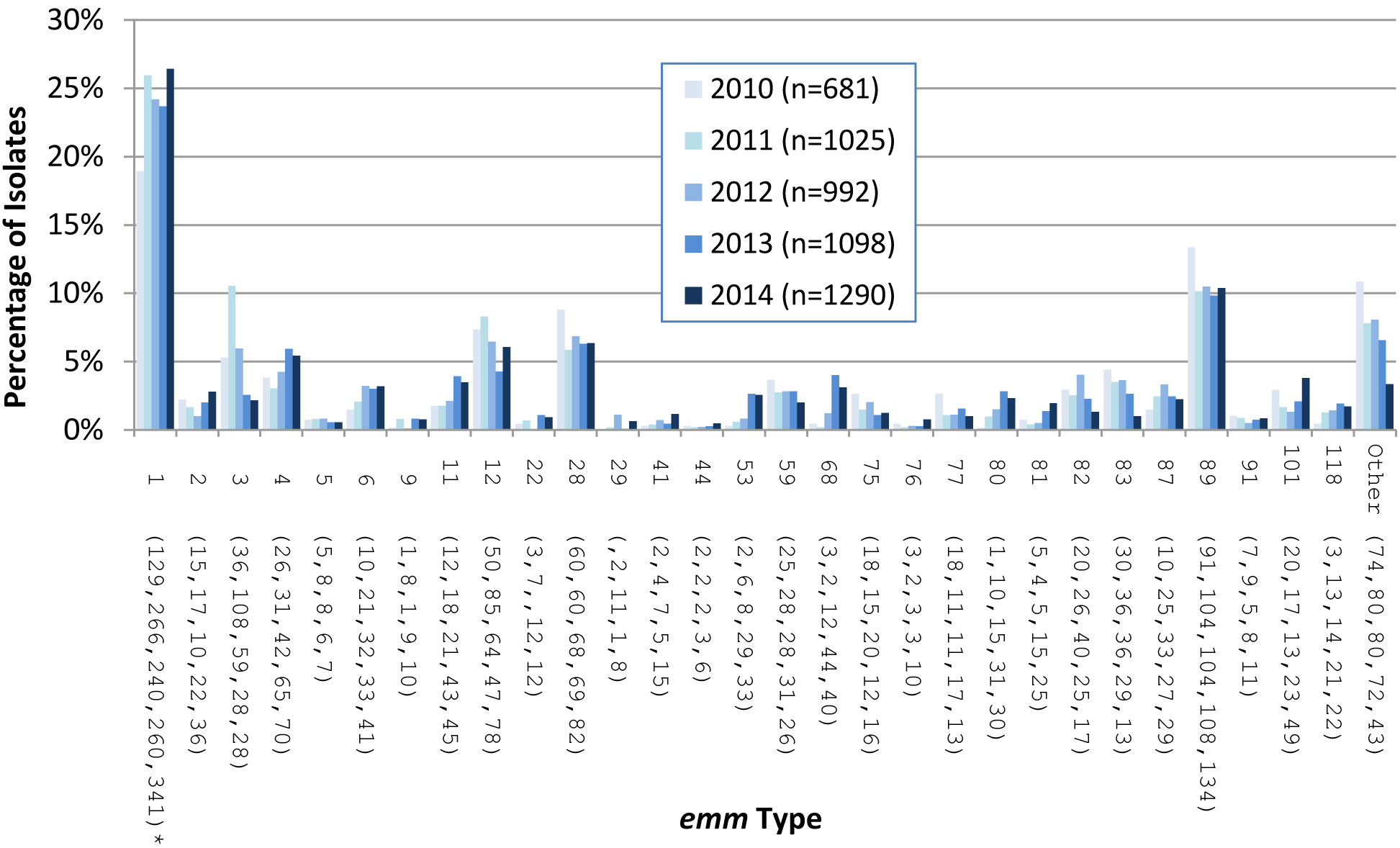
*Number of isolates in 2010, 2011, 2012, 2013 and 2014, respectively.
Text Equivalent
| emm | 2010 (n=681) | 2011 (n=1,025) | 2012 (n=992) | 2013 (n=1,098) | 2014 (n=1,290) |
|---|---|---|---|---|---|
Table Figure 37b Footnotes
|
|||||
| 1 (129,266,240,260,341)Table Figure 37b Footnote 1 | 18.9% | 26.0% | 24.2% | 23.7% | 26.4% |
| 2 (15,17,10,22,36) | 2.2% | 1.7% | 1.0% | 2.0% | 2.8% |
| 3 (36,108,59,28,28) | 5.3% | 10.5% | 5.9% | 2.6% | 2.2% |
| 4 (26,31,42,65,70) | 3.8% | 3.0% | 4.2% | 5.9% | 5.4% |
| 5 (5,8,8,6,7) | 0.7% | 0.8% | 0.8% | 0.5% | 0.5% |
| 6 (10,21,32,33,41) | 1.5% | 2.0% | 3.2% | 3.0% | 3.2% |
| 9 (1,8,1,9,10) | 0.1% | 0.8% | 0.1% | 0.8% | 0.8% |
| 11 (12,18,21,43,45) | 1.8% | 1.8% | 2.1% | 3.9% | 3.5% |
| 12 (50,85,64,47,78) | 7.3% | 8.3% | 6.5% | 4.3% | 6.0% |
| 22 (3,7,,12,12) | 0.4% | 0.7% | 0.0% | 1.1% | 0.9% |
| 28 (60,60,68,69,82) | 8.8% | 5.9% | 6.9% | 6.3% | 6.4% |
| 29 (,2,11,1,8) | 0.0% | 0.2% | 1.1% | 0.1% | 0.6% |
| 41 (2,4,7,5,15) | 0.3% | 0.4% | 0.7% | 0.5% | 1.2% |
| 44 (2,2,2,3,6) | 0.3% | 0.2% | 0.2% | 0.3% | 0.5% |
| 53 (2,6,8,29,33) | 0.3% | 0.6% | 0.8% | 2.6% | 2.6% |
| 59 (25,28,28,31,26) | 3.7% | 2.7% | 2.8% | 2.8% | 2.0% |
| 68 (3,2,12,44,40) | 0.4% | 0.2% | 1.2% | 4.0% | 3.1% |
| 75 (18,15,20,12,16) | 2.6% | 1.5% | 2.0% | 1.1% | 1.2% |
| 76 (3,2,3,3,10) | 0.4% | 0.2% | 0.3% | 0.3% | 0.8% |
| 77 (18,11,11,17,13) | 2.6% | 1.1% | 1.1% | 1.5% | 1.0% |
| 80 (1,10,15,31,30) | 0.1% | 1.0% | 1.5% | 2.8% | 2.3% |
| 81 (5,4,5,15,25) | 0.7% | 0.4% | 0.5% | 1.4% | 1.9% |
| 82 (20,26,40,25,17) | 2.9% | 2.5% | 4.0% | 2.3% | 1.3% |
| 83 (30,36,36,29,13) | 4.4% | 3.5% | 3.6% | 2.6% | 1.0% |
| 87 (10,25,33,27,29) | 1.5% | 2.4% | 3.3% | 2.5% | 2.2% |
| 89 (91,104,104,108,134) | 13.4% | 10.1% | 10.5% | 9.8% | 10.4% |
| 91 (7,9,5,8,11) | 1.0% | 0.9% | 0.5% | 0.7% | 0.9% |
| 101 (20,17,13,23,49) | 2.9% | 1.7% | 1.3% | 2.1% | 3.8% |
| 118 (3,13,14,21,22) | 0.4% | 1.3% | 1.4% | 1.9% | 1.7% |
| Other (74,80,80,72,43) | 10.9% | 7.8% | 8.1% | 6.6% | 3.3% |
Antimicrobial Resistance of S. pyogenes
Of the 1,443 invasive S. pyogenes isolates tested by disc diffusion in 2014, only 2 isolates were non-susceptible to chloramphenicol (1 resistant emm92 and 1 intermediate emm82), down from 36 (9.4%) in 2010.
Erythromycin resistance has continued to decrease from 14.4% (n=55) to 6.9% (n=100, p<0.001) from 2010 to 2014; whereas resistance to clindamycin has remained relatively unchanged at 2.8% (n=40) in 2014 (Figure 38, Table 13). Relatively high macrolide (erythromycin) resistance was observed among emm9 (60.0%, n=6), emm11 (81.8%, n=27), emm76 (90.0%, n=9), emm77 (38.5%, n=5), and emm83 (31.3%, n=5) (Figure 39). Induced resistance to clindamycin was observed in a further 3.7% (n=53) of the isolates. No resistance was observed to penicillin or vancomycin.
Figure 38. Antimicrobial resistance of invasive S. pyogenes (GAS) 2010 - 2014
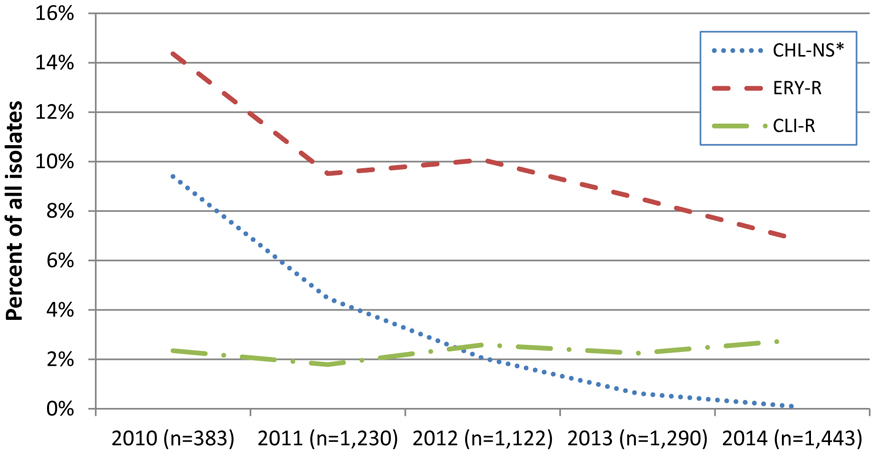
Text Equivalent
| Year | CHL-NS | ERY-R | CLI-R |
|---|---|---|---|
| CHL-NS = Chloramphenicol non susceptible (resistant or intermediate); ERY-R = Erythromycin resistant; CLI-R = constitutively clindamycin resistant. | |||
| 2010 (n=383) | 9.4% | 14.4% | 2.3% |
| 2011 (n=1230) | 4.5% | 9.5% | 1.8% |
| 2012 (n=1122) | 2.0% | 10.1% | 2.6% |
| 2013 (n=1290) | 0.6% | 8.5% | 2.2% |
| 2014 (n=1443) | 0.1% | 6.9% | 2.8% |
| Antimicrobial | Year | ||||
|---|---|---|---|---|---|
| 2010 | 2011 | 2012 | 2013 | 2014 | |
Table 13 Footnotes
|
|||||
| CHL-NSTable 13 Footnote 1 | 9.4% (36) | 4.5% (55) | 2.0% (23) | 0.6% (8) | 0.1% (2) |
| ERY-R | 14.4% (55) | 9.5% (117) | 10.1% (113) | 8.5% (110) | 6.9% (100) |
| CLI-R | 2.3% (9) | 1.8% (22) | 2.6% (29) | 2.2% (29) | 2.8% (40) |
| Total Tested | (383) | (1,230) | (1,122) | (1,290) | (1,443) |
Figure 39. Macrolide resistance of S. pyogenes emm types, 2014
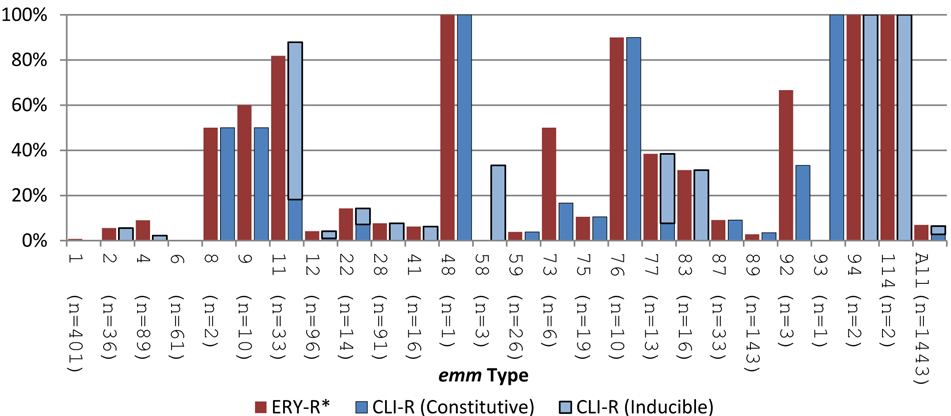
*ERY-R = Erythromycin resistant; CLI-R = clindamycin resistant. (Constitutive or Inducible)
Text Equivalent
| emm | ERY-R | CLI-R (Constitutive) | CLI-R (Inducible) |
|---|---|---|---|
| 1 (n=401) | 0.7% | 0.2% | 0.0% |
| 2 (n=36) | 5.6% | 0.0% | 5.6% |
| 4 (n=89) | 9.0% | 0.0% | 2.2% |
| 6 (n=61) | 0.0% | 0.0% | 0.0% |
| 8 (n=2) | 50.0% | 50.0% | 0.0% |
| 9 (n=10) | 60.0% | 50.0% | 0.0% |
| 11 (n=33) | 81.8% | 18.2% | 69.7% |
| 12 (n=96) | 4.2% | 1.0% | 3.1% |
| 22 (n=14) | 14.3% | 7.1% | 7.1% |
| 28 (n=91) | 7.7% | 0.0% | 7.7% |
| 41 (n=16) | 6.3% | 0.0% | 6.3% |
| 48 (n=1) | 100.0% | 100.0% | 0.0% |
| 58 (n=3) | 0.0% | 0.0% | 33.3% |
| 59 (n=26) | 3.8% | 3.8% | 0.0% |
| 73 (n=6) | 50.0% | 16.7% | 0.0% |
| 75 (n=19) | 10.5% | 10.5% | 0.0% |
| 76 (n=10) | 90.0% | 90.0% | 0.0% |
| 77 (n=13) | 38.5% | 7.7% | 30.8% |
| 83 (n=16) | 31.3% | 0.0% | 31.3% |
| 87 (n=33) | 9.1% | 9.1% | 0.0% |
| 89 (n=143) | 2.8% | 3.5% | 0.0% |
| 92 (n=3) | 66.7% | 33.3% | 0.0% |
| 93 (n=1) | 0.0% | 100.0% | 0.0% |
| 94 (n=2) | 100.0% | 0.0% | 100.0% |
| 114(n=2) | 100.0% | 0.0% | 100.0% |
| All(n=1443) | 6.9% | 2.8% | 3.7% |
Invasive Streptococcus agalactiae
(Group B Streptococcus)
Of the 249 Streptococcus agalactiae isolates tested at the NML during 2014, 7 cultures (2.8%) were early onset isolates from infants <8 days old; 7 cultures (2.8%) were late onset from infants 8-31 days old; 10 cultures (4.0%) were from children 1 month to 14 years old, 111 (44.6%) were from adults 15-64 years old, and 103 (41.4%) were from seniors ≥65 years of age, and no age was available for 11 isolates (Table 14). Isolates from male patients accounted for 54.4% (n=111) of the 204 isolates for which gender information was available.
Serotype V was most prevalent overall representing 23.3% (n=58) of all isolates tested in 2014 (Table 14), an increase from 19.8% (n=85, p=0.286) in 2013 (Figure 40, Table 15). An increase of serotype IV was also seen from 9.1% (n=39) to 17.7% (n=44, p=0.001) from 2013 to 2014.
The majority of GBS were isolated from blood, representing 60.2% (n=150) of all isolates, followed by synovial fluid with 25.7% (n=64) of the isolates. Serotype III accounted for 24.0% (n=36) of blood and 20.8% (n=5) of the synovial fluid isolates; whereas serotype V accounted for the majority of synovial fluid (41.7%, n=10) and serotype IV was most predominant from of other sterile site isolates (32.8%, n=21) (Figure 41, Table 16).
| Serotype | Age GroupTable 14 Footnote 1 | Not Given | Total | ||||
|---|---|---|---|---|---|---|---|
| Infant Early Onset |
Infant Late Onset |
Child | Adult | Senior | |||
Table 14 Footnotes
|
|||||||
| Ia | 14.3% (1)Table 14 Footnote 2 | 14.3% (1) | - | 12.6% (14) | 14.6% (15) | 9.1% (1) | 12.7% (32) |
| Ib | 14.3% (1) | - | 20.0% (2) | 14.4% (16) | 17.5% (18) | - | 14.7% (37) |
| II | - | - | - | 9.9% (11) | 4.9% (5) | 9.1% (1) | 6.8% (17) |
| III | 57.1% (4) | 57.1% (4) | 60.0% (6) | 14.4% (16) | 15.5% (16) | 63.6% (7) | 21.1% (53) |
| IV | 14.3% (1) | 14.3% (1) | 10.0% (1) | 23.4% (26) | 14.6% (15) | - | 17.5% (44) |
| V | - | 14.3% (1) | 10.0% (1) | 22.5% (25) | 28.2% (29) | 18.2% (2) | 23.1% (58) |
| VI | - | - | - | 2.7% (3) | - | - | 1.2% (3) |
| VIII | - | - | - | - | 1.0% (1) | - | 0.4% (1) |
| IX | - | - | - | - | 1.0% (1) | - | 0.4% (1) |
| NT | - | - | - | - | 2.9% (3) | - | 1.2% (3) |
| Total | (7) | (7) | (10) | (111) | (103) | (11) | (249) |
Figure 40. Invasive S. agalactiae serotypes, 2010 to 2014
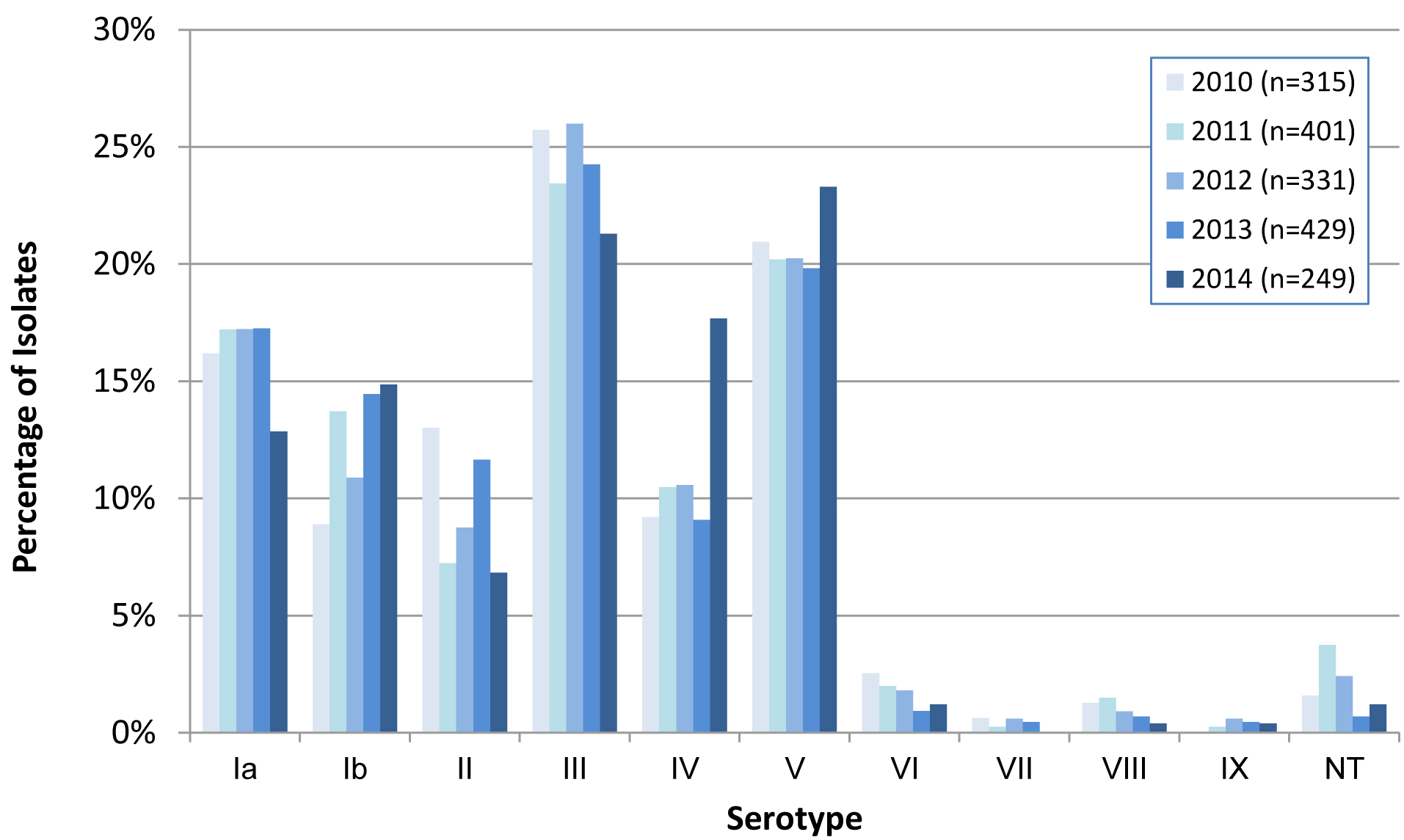
Text Equivalent
| Serotype | Year | ||||
|---|---|---|---|---|---|
| 2010 | 2011 | 2012 | 2013 | 2014 | |
Table Figure 40 Footnotes
|
|||||
| Ia | 16.2% (51)Table Figure 40 Footnote 1 | 17.2% (69) | 17.2% (57) | 17.2% (74) | 12.9% (32) |
| Ib | 8.9% (28) | 13.7% (55) | 10.9% (36) | 14.5% (62) | 14.9% (37) |
| II | 13.0% (41) | 7.2% (29) | 8.8% (29) | 11.7% (50) | 6.8% (17) |
| III | 25.7% (81) | 23.4% (94) | 26.0% (86) | 24.2% (104) | 21.3% (53) |
| IV | 9.2% (29) | 10.5% (42) | 10.6% (35) | 9.1% (39) | 17.7% (44) |
| V | 21.0% (66) | 20.2% (81) | 20.2% (67) | 19.8% (85) | 23.3% (58) |
| VI | 2.5% (8) | 2.0% (8) | 1.8% (6) | 0.9% (4) | 1.2% (3) |
| VII | 0.6% (2) | 0.2% (1) | 0.6% (2) | 0.5% (2) | 0.0% (0) |
| VIII | 1.3% (4) | 1.5% (6) | 0.9% (3) | 0.7% (3) | 0.4% (1) |
| IX | 0.0% (0) | 0.2% (1) | 0.6% (2) | 0.5% (2) | 0.4% (1) |
| NT | 1.6% (5) | 3.7% (15) | 2.4% (8) | 0.7% (3) | 1.2% (3) |
| All | (315) | (401) | (331) | (429) | (249) |
| Serotype | Year | ||||
|---|---|---|---|---|---|
| 2010 | 2011 | 2012 | 2013 | 2014 | |
Table 15 Footnotes
|
|||||
| Ia | 16.2% (51)Table 15 Footnote 1 | 17.2% (69) | 17.2% (57) | 17.2% (74) | 12.9% (32) |
| Ib | 8.9% (28) | 13.7% (55) | 10.9% (36) | 14.5% (62) | 14.9% (37) |
| II | 13.0% (41) | 7.2% (29) | 8.8% (29) | 11.7% (50) | 6.8% (17) |
| III | 25.7% (81) | 23.4% (94) | 26.0% (86) | 24.2% (104) | 21.3% (53) |
| IV | 9.2% (29) | 10.5% (42) | 10.6% (35) | 9.1% (39) | 17.7% (44) |
| V | 21.0% (66) | 20.2% (81) | 20.2% (67) | 19.8% (85) | 23.3% (58) |
| VI | 2.5% (8) | 2.0% (8) | 1.8% (6) | 0.9% (4) | 1.2% (3) |
| VII | 0.6% (2) | 0.2% (1) | 0.6% (2) | 0.5% (2) | 0.0% (0) |
| VIII | 1.3% (4) | 1.5% (6) | 0.9% (3) | 0.7% (3) | 0.4% (1) |
| IX | 0.0% (0) | 0.2% (1) | 0.6% (2) | 0.5% (2) | 0.4% (1) |
| NT | 1.6% (5) | 3.7% (15) | 2.4% (8) | 0.7% (3) | 1.2% (3) |
| All | (315) | (401) | (331) | (429) | (249) |
Figure 41. Invasive S. agalactiae serotypes by clinical isolation site, 2014
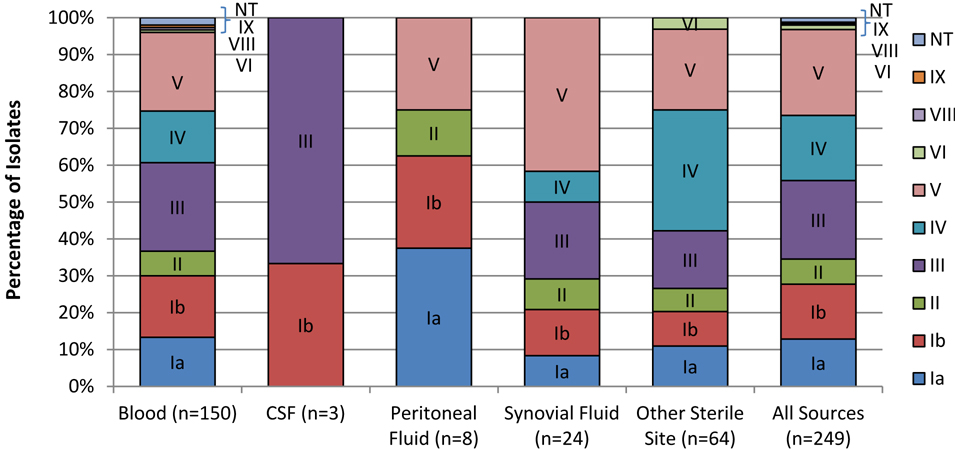
Text Equivalent
| Serotype | Blood (n=150) | CSF (n=3) | Peritoneal Fluid (n=8) | Synovial Fluid (n=24) | Other Sterile Sites (n=64) | All Sources (n=249) |
|---|---|---|---|---|---|---|
| Ia | 13.3% | 0.0% | 37.5% | 8.3% | 10.9% | 12.9% |
| Ib | 16.7% | 33.3% | 25.0% | 12.5% | 9.4% | 14.9% |
| II | 6.7% | 0.0% | 12.5% | 8.3% | 6.3% | 6.8% |
| III | 24.0% | 66.7% | 0.0% | 20.8% | 15.6% | 21.3% |
| IV | 14.0% | 0.0% | 0.0% | 8.3% | 32.8% | 17.7% |
| V | 21.3% | 0.0% | 25.0% | 41.7% | 21.9% | 23.3% |
| VI | 0.7% | 0.0% | 0.0% | 0.0% | 3.1% | 1.2% |
| VIII | 0.7% | 0.0% | 0.0% | 0.0% | 0.0% | 0.4% |
| IX | 0.7% | 0.0% | 0.0% | 0.0% | 0.0% | 0.4% |
| NT | 2.0% | 0.0% | 0.0% | 0.0% | 0.0% | 1.2% |
| Serotype | Isolation Site | Total | ||||
|---|---|---|---|---|---|---|
| Blood | CSF | Peritoneal Fluid | Synovial Fluid | Other Sterile Site | ||
| Ia | 13.3% (20) | - | 37.5% (3) | 8.3% (2) | 10.9% (7) | 12.9% (32) |
| Ib | 16.7% (25) | 33.3% (1) | 25.0% (2) | 12.5% (3) | 9.4% (6) | 14.9% (37) |
| II | 6.7% (10) | - | 12.5% (1) | 8.3% (2) | 6.3% (4) | 6.8% (17) |
| III | 24.0% (36) | 66.7% (2) | - | 20.8% (5) | 15.6% (10) | 21.3% (53) |
| IV | 14.0% (21) | - | - | 8.3% (2) | 32.8% (21) | 17.7% (44) |
| V | 21.3% (32) | - | 25.0% (2) | 41.7% (10) | 21.9% (14) | 23.3% (58) |
| VI | 0.7% (1) | - | - | - | 3.1% (2) | 1.2% (3) |
| VIII | 0.7% (1) | - | - | - | - | 0.4% (1) |
| IX | 0.7% (1) | - | - | - | - | 0.4% (1) |
| NT | 2.0% (3) | - | - | - | - | 1.2% (3) |
| Total | 60.2% (150) | 1.2% (3) | 3.2% (8) | 9.6% (24) | 25.7% (64) | (249) |
Antimicrobial Resistance of Streptococcus agalactiae
Of the 249 invasive S. agalactiae isolates tested by disc diffusion in 2014, one isolate was resistant to chloramphenicol (serotype V). Erythromycin and clindamycin resistance has remained relatively stable accounting for 49.4% (n=123) and 27.3% (121) of the isolates tested in 2014 (Figure 42, Table 17).
Relatively high macrolide (erythromycin) resistance was observed among serotypes Ia (50%, n=16), II (58.8%, n=10), III (49.1%, n=26), IV (77.3%, n=34), and V (41.4%, n=24) (Figure 43).
Figure 42. Antimicrobial resistance of invasive S. agalactiae, 2010 – 2014
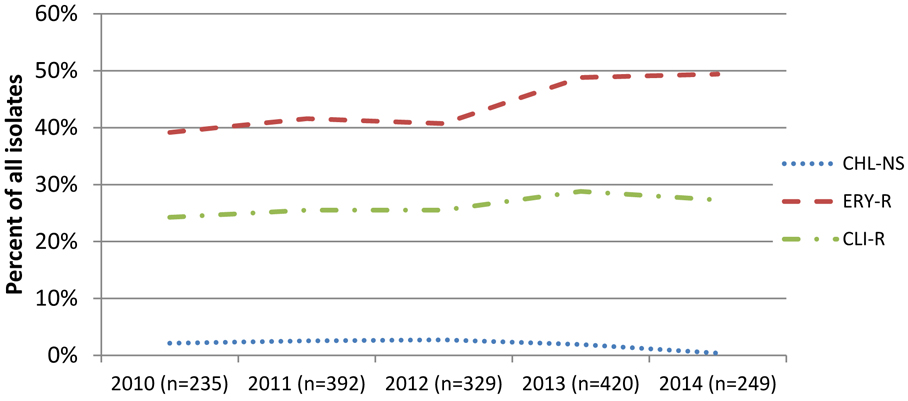
Text Equivalent
| Year | CHL-NS | ERY-R | CLI-R |
|---|---|---|---|
| CHL-NS = Chloramphenicol non susceptible (resistant or intermediate); ERY-R = Erythromycin resistant; CLI-R = constitutively clindamycin resistant. | |||
| 2010 (n=235) | 2.1% | 39.1% | 24.3% |
| 2011 (n=392) | 2.6% | 41.6% | 25.5% |
| 2012 (n=329) | 2.7% | 40.7% | 25.5% |
| 2013 (n=420) | 1.9% | 48.8% | 28.8% |
| 2014 (n=249) | 0.4% | 49.4% | 27.3% |
| Antimicrobial | Year | ||||
|---|---|---|---|---|---|
| 2010 | 2011 | 2012 | 2013 | 2014 | |
Table 17 Footnotes
|
|||||
| CHL-NSTable 17 Footnote 1 | 2.1% (5) | 2.6% (10) | 2.7% (9) | 1.9% (8) | 0.4% (1) |
| ERY-R | 39.1% (92) | 41.6% (163) | 40.7% (134) | 48.8% (205) | 49.4% (123) |
| CLI-R | 24.3% (57) | 25.5% (100) | 25.5% (84) | 28.8% (121) | 27.3% (68) |
| Total Tested | (235) | (392) | (329) | (420) | (249) |
Figure 43. Macrolide resistance of S. agalactiae serotypes, 2014
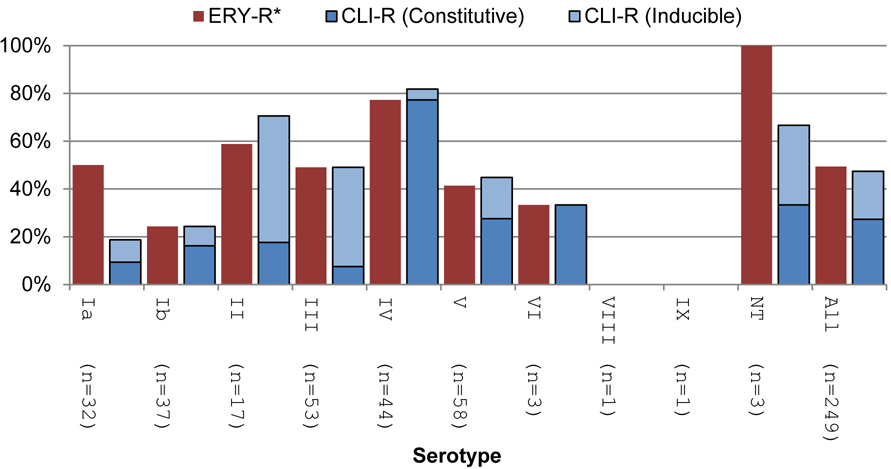
*ERY-R = Erythromycin resistant; CLI-R = clindamycin resistant. (Constitutive or Inducible)
Text Equivalent
| Serotype | ERY-RTable Figure 43 Footnote 1 | CLI-R (Constitutive) | CLI-R (Inducible) |
|---|---|---|---|
Table Figure 43 Footnotes
|
|||
| Ia (n=32) | 50.0% | 9.4% | 9.4% |
| Ib (n=37) | 24.3% | 16.2% | 8.1% |
| II (n=17) | 58.8% | 17.6% | 52.9% |
| III (n=53) | 49.1% | 7.5% | 41.5% |
| IV (n=44) | 77.3% | 77.3% | 4.5% |
| V (n=58) | 41.4% | 27.6% | 17.2% |
| VI (n=3) | 33.3% | 33.3% | 0.0% |
| VIII (n=1) | 0.0% | 0.0% | 0.0% |
| IX (n=1) | 0.0% | 0.0% | 0.0% |
| NT (n=3) | 100.0% | 33.3% | 33.3% |
| All (n=249) | 49.4% | 27.3% | 20.1% |
Conclusion
The proportion of PCV7 serotypes among S. pneumoniae in Canada remains low in 2014 and continuing decreases in the predominant PCV13 serotypes 7F and 19A have been observed. The decrease of PCV13 serotypes, in addition to continuing decreases in incidence of disease in children, provides evidence of the impact of the PCV13 vaccination programs in Canada. Continued vigilance however, is required to recognize possible increases in other non-PCV13 serotypes circulating in Canada, such as serotypes 22F, 23A, 23B and 15A. Although a component of the PCV13 vaccine, serotype 3 has not decreased at the rate of other constituent serotypes, raising concerns of the virulence, the immunogenicity of this serotype and the efficacy of this component of the vaccine. The continued monitoring of the relative frequency of serotypes circulating in Canada will help inform and guide the development and composition of new vaccines which will lower the total burden of disease.
Antimicrobial resistance among isolates of S. pneumoniae is generally declining, mainly due to the decline of highly resistant serotype 19A, but resistance to penicillins, macrolides, tetracyclines, sulfonamides and fluoroquinolones and multi-drug resistance is still common. Current antimicrobial resistance levels in Canada are relatively low, however monitoring the antimicrobial susceptibility patterns of the common S. pneumoniae serotypes is essential to guide empiric and directed treatments.
S. pyogenes emm1 and emm89 continue to be the dominate strains in Canada, whereas annual variability of the other emm types continue. Antimicrobial resistance in Group A Streptococcus has declined since 2010, however, due to the severity, high risk of infection and heightened public awareness of Group A Streptococci, the continued monitoring and surveillance of circulating serotypes and antimicrobial resistance levels are important to help identify outbreaks of disease and to inform and guide public health interventions.
S. agalactiae serotypes V, III and IV are the predominate strains in Canada, and macrolide resistance is stabilized in 2014. Group B Streptococci cause severe outcomes in neonatal groups; however there is an increasing burden of disease among adults. Monitoring shifts in the distribution of serotypes, levels of antimicrobial resistance as well as collecting additional enhanced epidemiological information, is important to help identify potential risk factors, spread of invasive strains, and to raise awareness of future prevention and treatment options.
Appendix
| Age group | Total number of isolates serotyped | Total number of illnesses reported to CNDSSTable A Footnote 2 | Percent serotyped |
|---|---|---|---|
Table A Footnotes
|
|||
| <1 years | 61 | 65 | 93.8% |
| 1 - 4 years | 151 | 170 | 88.8% |
| 5 – 39 years | 335 | 425 | 78.8% |
| 40 – 59 years | 666 | 872 | 76.4% |
| ≥60 years | 1,212 | 1,625 | 75.8% |
| All Ages | 2,438Table A Footnote 1 | 3,157 | 74.6% |
| Age group | Total number of isolates tested | Total number of illnesses reported to CNDSSTable B Footnote 2 | Percent serotyped |
|---|---|---|---|
Table B Footnotes
|
|||
| <1 years | 21 | Available Feb. 2016 | |
| 1 - 4 years | 68 | ||
| 5 – 39 years | 417 | ||
| 40 – 59 years | 413 | ||
| ≥60 years | 530 | ||
| All Ages | 1,457Table B Footnote 1 | ||
References
- Austrian R. The Quellung reaction, a neglected microbiological technique. 1976. Mt. Sinai J. Med. 43:699–709.
- Bettinger JA, Scheifele DA, Kellner JD, et al. 2010. The effect of routine vaccination on invasive pneumococcal infections in Canadian children, Immunization Monitoring Program, Active 2000–2007. Vaccine 28:2130–2136.
- Bjornson G, Scheifele DW, Bettinger J, et al. 2007. Effectiveness of Pneumococcal Conjugate Vaccine in Greater Vancouver, Canada: 2004-2005. Ped.Inf.Dis.J. 26(6):540-542.
- Bruce, MG, Deeks SL, Zulz T, et al. 2008. International Circumpolar Surveillance System for Invasive Pneumococcal Disease, 1999-2005. Emerging.Infect.Dis. 14(1):25-33.
- Case Definitions for Communicable Diseases under National Surveillance - 2009. 2009. CCDR: 35s2. Available: http://www.phac-aspc.gc.ca/publicat/ccdr-rmtc/09vol35/35s2/Pneumoco-eng.php
- Clinical Laboratory Standards Institute (CLSI). 2008. Interpretative Criteria for Identification of Bacteria and Fungi by DNA Target Sequencing, Approved Guideline. MM18-A; 28(12):21-24.
- Clinical Laboratory Standards Institute (CLSI). January 2015. Performance Standards for Antimicrobial Susceptibility Testing; Twenty-Fifth Informational Supplement. M100-S25.
- Cunningham MW. 2000 (July). Pathogenesis of Group A Streptococcal Infections. Clin. Micro. Rev. 470-511.
- Demczuk WHB, Martin I, Griffith A, et al. 2012. Serotype distribution of invasive Streptococcus pneumoniae in Canada during the introduction of the 13-valent pneumococcal conjugate vaccine, 2010. Can.J.Microbiol. 58:1008-1017.
- Demczuk WHB, Martin I, Griffith A, et al. 2013. Serotype distribution of invasive Streptococcus pneumoniae in Canada after the introduction of the 13-valent pneumococcal conjugate vaccine, 2010-2012. Can. J. Microbiol. 59:778-788.
- Deng X, Church D, Vanderkooi OG, et al. 2013. Streptococcus pneumoniae infection: a Canadian perspective. Expert Rev. Anti Infect. Ther. 11(8):781-791.
- De Wals P, Lefebvre B, Defay F, et al. 2012. Invasive pneumococcal diseases in birth cohorts vaccinated with PCV-7 and/or PHiD-CV in the province of Quebec, Canada. Vaccine 30:6416-6420.
- Drancourt M, Roux V, Fournier PE, Raoult D. 2004 (February). rpoB gene sequence-based identification of aerobic gram-positive cocci of the genera Streptococcus, Enterococcus, Gemella, Abiotrophia and Granulicatella. J. Clin. Micro. 42(2):497-504.
- European Committee on Antimicrobial Susceptibility Testing (EUCAST). 2015. Clinical Breakpoint Table. Version 5.0. Available: http://www.eucast.org/clinical_breakpoints/
- Kellner, JD, Sheifele, D, Vanderkooi, OG, et al. 2008. Effects of Routine Infant Vaccination with the 7-Valent Pneumococcal Conjugate Vaccine on Nasopharyngeal Colonization with Streptococcus pneumoniae in Children in Calgary, Canada. The Ped. Infect. Dis. Journal. 27(6):526-532.
- CLSI JD, Vanderkooi OG, MacDonald J, Church DL, Tyrrell GJ, Scheifele DW. 2009 (July). Changing epidemiology of invasive pneumococcal disease in Canada, 1998-2007: update from the Calgary-area Streptococcus pneumoniae research (CASPER) study. Clin Infect Dis. 49(2):205-12.
- Lamangni, TL, Keshishian C, Efstratiou A, et al. 2013. Emerging Trends in the Epidemiology of Invasive Group B Streptococcal Disease in England and Wales, 1991 – 2010. Clin Inf Dis 2013;57(5):682-8.
- Lim, GH, Wormsbecker, AE, McGeer A, et al. 2013. Have changing pneumococcal vaccination programmes impacted disease in Ontario? Vaccine 31:2680-2685.
- Lovgren M, Spika JS, Talbot JA. 1998. Invasive Streptococcus pneumoniae infections: serotype distribution and antimicrobial resistance in Canada, 1992-1995. Can.Med.Assoc.J. 158(3):327-331.
- Marchessault V, editor. 2002. Canadian Immunization Guide. 6th ed. Ottawa: Canadian
Medical Association. - Merck & Co. Inc., Whitehouse Station, NJ 08889, USA. Pneumovax ® 23 (Pneumococcal vaccine polyvalent).
- McIntosh ED, Reinert RR. 2011 (Jan). Global prevailing and emerging pediatric pneumococcal serotypes. Expert Rev Vaccines. 10(1):109-29.
- Minnesota Department of Health, Infectious Disease Epidemiology, Prevention and Control Division. Available: http://www.helath.state.nm.us/divs/idepc/dtopics/invbacterial/sterile.html
- National Advisory Committee on Immunization (NACI). 2010 (November). An Advisory Committee Statement (ACS), Update on the Use of Conjugate Pneumococcal Vaccines in Childhood. CCDR 36(ACS-12):1-21.
- Public Health Agency of Canada. 2013. Publicly funded Immunization Programs in Canada - Routine Schedule for Infants and Children including special programs and catch-up programs (as of March 2013) [online]. Available from http://www.phac-aspc.gc.ca/im/ptimprog-progimpt/table-1-eng.php [Accessed 2013-10-17].
- Public Health Agency of Canada.2014. Notifiable Diseases On-Line. http://dsol-smed.phac-aspc.gc.ca/dsol-smed/ndis/charts.php?c=pl Accessed: 04 Sept 2014.
Robinson KA, Baughman W, Rothrock G, Barrett NL, Pass M, Lexau C, et al. 2001 (April).
Epidemiology of invasive Streptococcus pneumoniae infections in the United States, 1995–1998: opportunities for prevention in the conjugate vaccine era. JAMA. 285(13):1729–35. - Schuchat A, Robinson K, Wenger JD, Harrison LH, Farley M, Reingold AL, et al. 1997.
Bacterial meningitis in the United States in 1995. Active Surveillance Team. N Engl J Med;337(October (14)):970–6. - Schwartz B, Facklam RR, Breiman RF. 1990. Changing epidemiology of group A streptococcal infection in the USA. Lancet 336:1167-1171.
- Scott JA, Hall AJ, Dagan R, Dixon JM, Eykyn SJ, Fenoll A, et al. 1996 (June). Serogroup-specific epidemiology of Streptococcus pneumoniae: associations with age, sex, and geography in 7,000 episodes of invasive disease. Clin Infect Dis. 22(6):973–81.
- Shahidi N, Dhaliwa J, Tyrrell G, et al. 2008. Trends in incidence of invasive pneumococcal disease following introduction of the universal infant immunization program in British Columbia, 2001 – 2006. BC Medical Journal 50(1):18-21.
- Siljander T, Lyytikäinen O, Vähäkuopus S, et al. 2010. Epidemiology, outcome and emm types of invasive group A streptococcal infections in Finland. Eur J Clin Microbiol Infect Dis; 29:1229-1235.
- Spellerberg B, Brandt C. Streptococcus. In: Murray PR, Baron EL, Jorgensen JH, Landry ML, Pfaller MA. editors. 2007. Manual of Clinical Microbiology. 9th ed. Washington: American Society for Microbiology; p. 412-429.
- Tyrrell GJ, Lovgren M, Chui N, et al. 2009. Serotypes and antimicrobial susceptibilities of invasive Streptococcus pneumoniae pre- and post-seven valent pneumococcal conjugate vaccine introduction in Alberta, Canada 2000-2006. Vaccine; 27:3553-3560.
- Weinberger DM, Malley R, Lipsitch M. 2011 (April). Serotype replacement in disease after pneumococcal vaccination. The Lancet, Available online ISSN 0140-6736, DOI: 10.1016/S0140-6736(10)62225-8. (http://www.sciencedirect.com/science/article/B6T1B-52M217X-4/2/f3141605bd8e55b78bbc1df8f2dd8677)
Page details
- Date modified: